Travel Guide Argentina
Book your individual trip , stress-free with local travel experts
- roughguides.com
- South America
- Travel guide
- Itineraries
- Local Experts
- Travel Advice
Plan your tailor-made trip with a local expert
Book securely with money-back guarantee
Travel stress-free with local assistance and 24/7 support
Annie, Canada
What a great trip! It was so easy to communicate, got all the answers to my many questions. What a trip! Argentina wasn't on my bucket list, now I NEED to ...
Travel to Argentina and you’ll be rewarded with natural wonders and one of the world’s most stylish capital cities, Buenos Aires . Stretching from the Tropic of Capricorn towards the tip of Antarctica, Argentina encompasses a staggering diversity of terrains. You’ll find everything from lush wetlands to the end-of-the-world archipelago of Tierra del Fuego. Its most emblematic landscapes are the flatlands of the Pampas and the dramatic steppe of Patagonia. Read our guide to Argentina for everything you need to know before you go.

Argentina travel facts
Where to go in argentina, best time to go to argentina.
- How to get to Argentina
How to get around in Argentina
Best places to visit in argentina, argentina travel itineraries, argentine culture, activities in argentina.
Size: Argentina is the world’s eighth-largest country by area.
Population: With a population of around 45 million Argentina is one of the least densely populated countries on the planet.
Origins: Some 97 percent of Argentines are of European origin, largely of Spanish or Italian descent.
Exports: Best known for its beef, Argentina is also a leading producer of wine, wheat, fruits and vegetables.
Nobel Prizes: Argentines have twice been awarded the Nobel Peace Prize. Carlos de Saavedra Lamas, in 1936, for his peace efforts in South America, and Adolfo Pérez Esquivel, in 1980, for his defence of human rights.
Ancient history: The remains of the largest-known dinosaur – the Patagotitan mayorum , were discovered by chance by a farm worker in Patagonia in 2008.
Movies: Argentina has a vibrant film industry and has twice carried off an Oscar for best foreign language film. La historia oficial (The Official Story) won in 1985 and El secreto de sus ojos (The Secret in Their Eyes) in 2010.

Typical colorful houses and facades in the famous La Boca district in Buenos Aires, Argentina © Peter Zaharov/Shutterstock
Argentina has many beautiful sights: the waterfalls of Iguazú; the spectacular Glaciar Perito Moreno; whale-watching off Península Valdés; the handsome lakes and mountains around Bariloche. If you’re planning to travel to Argentina, bear in mind the long distances between key destinations – it’s a huge country.

Many of Argentina’s most rewarding destinations are also its least well known. These include the Ibera Wetlands (Esteros del Iberá), a huge network of lagoons offering close-up encounters with cormorants and caymans. Likewise the Antofagasta de la Sierra, a remote village set amid frozen lakes mottled pink with flamingos; or Laguna Diamante, a high-altitude lake backed by a volcano. Climate and distance mean it’s more sensible and rewarding to concentrate on one or two sections of the country when planning your travel.
Buenos Aires
Buenos Aires is likely to be your point of entry, as it has the country’s main international airport, Ezeiza. It is an exciting, vibrant city, with an intriguing blend of European architecture and a local flair. You can round off a day’s sightseeing with a tango show, dinner at one of the dozens of fabulous restaurants, or a hedonistic night out.
The Litoral
Due north lies the Litoral , bordering Uruguay, Brazil and Paraguay. Here you’ll find the Iguazú falls.
Quebrada de Humahuaca
A highlight in the country’s landlocked northwest is the Quebrada de Humahuaca, a fabulous gorge lined with rainbow-hued rocks. Nearby, in the Valles Calchaquíes, a chain of stunningly scenic valleys, high-altitude vineyards produce the delightfully flowery torrontés wine.
Sprawling across Argentina’s broad midriff are the Pampas, arguably the country’s most archetypal landscape. This subtly beautiful scenery is punctuated by small towns, the occasional ranch and countless clumps of pampas grass (cortaderas). The Pampas are grazed by millions of cattle and planted with huge soya and wheat fields.
They are also where you’ll glimpse traditional gaucho culture, most famously in the charming pueblo of San Antonio de Areco. Here, too, are some of the classiest estancias, offering a combination of hedonistic luxury and horseback adventures.
Central Sierras and Cordoba
As you head further west, the Central Sierras loom: the mild climate and beautiful scenery of these ancient highlands have attracted holiday-makers since the late nineteenth century. Within reach is Córdoba , the country’s colonial-era second city.
Keep going west and you’ll get to the Cuyo, with the highest Andean peaks as a snow-capped backdrop; here you can discover one of Argentina’s most enjoyable cities, the regional capital of Mendoza , also the country’s wine capital.
Argentina is home the lion’s share of the wild, sparsely populated expanses of Patagonia (the rest belongs to Chile). It also possesses y the most populous half of the remote archipelago of Tierra del Fuego . These are lands of arid steppe hemmed by the southern leg of the Andes – a row of majestic volcanoes and craggy peaks interspersed by deep glacial lakes . For many people, Patagonia is the first page they turn to in any guide to Argentina.
On the Atlantic side of Patagonia, Península Valdés is a must-see for its world-class marine fauna, including southern right whales, elephant seals and orcas. You may like to trace the region’s associations with Darwin and his captain Fitz Roy in the choppy Beagle Channel off Ushuaia. You could track down the legacy of Butch Cassidy, who lived near Cholila, or of the Welsh settlers whose influence can still be felt in communities like Gaiman, Trelew and – further inland – Trevelin.

Ushuaia Harbor, Tierra del Fuego, Argentina © artincamera/Shutterstock
Discover more places in Argentina

- The Litoral and the Gran Chaco Travel Guide
- Mendoza and El Cuyo Travel Guide
- The Northwest Travel Guide
- Patagonia Travel Guide
- Tierra del Fuego Travel Guide
In this section of our Argentina travel guide we’ll look at the best times to visit.
Spring is perhaps the best time to go to Argentina. The weather in Argentina in spring (Sep-Nov) is perfect almost everywhere, although icy weather is still possible in the far south.
Summer (Dec–Feb) is the only time you can climb the highest Andean peaks, such as Aconcagua. It's also the most reliable time of year to head for Tierra del Fuego, though it can snow there at any time. Buenos Aires is usually hot and sticky in December and January. You should also avoid parts of the north, as temperatures can be scorching and roads flooded by heavy storms.
Autumn (March and April) is a great time to visit Argentina – particularly Mendoza and San Juan provinces for the wine harvests. Visit Patagonia and Tierra del Fuego to see the beech groves as their leaves change colour.
The winter months of June, July and August are obviously the time to head for the Andean ski resorts. Blizzards can cut off towns in Patagonia in winter, and many places in the region close from April to October. Temperatures in the north of the country should be pleasant at this time of year, though Buenos Aires can be bleak in July and August.
A final point to bear in mind when it comes to Argentina travel: many locals take their holidays in January, around Easter and in July. Transport and accommodation can get booked up fast and rates can double. Read more about the best time to visit Argentina .
Though some people travel to Argentina overland, the majority of people arrive via Buenos Aires’ international airport, Ezeiza.
In general, airfares to the country tend to be quite high, but they do vary depending on the route and the season. The highest fares for travel to Argentina are between December and February, around Easter and in July and August. You’ll get the best prices during low season: March to June and September to November. Note also that flying at weekends means higher prices.
Flights from the UK and Ireland
Several airlines travel to Argentina from the UK. British Airways and budget airline Norwegian are the only airlines that fly direct from London. Iberia via Madrid skimps on creature comforts but is often cheap.
There are no direct flights from Ireland to Argentina. If you’re trying to keep costs down, consider flying to London with an economy airline and making a connection. Or, you can fly direct to New York or Miami and catch an onward flight from there.
Some routes allow you to take stopovers on the way – sometimes for free. Potential stopovers include Bogotá, Rio and São Paulo in South America; Boston, Chicago, Dallas, Houston, Miami, Newark, Los Angeles and Washington DC in the US; and Frankfurt, Madrid, Milan, Paris and Rome in Europe.
Flights from the US and Canada
Several airlines, including American Airlines, United and Aerolíneas Argentina, offer daily non-stop flights from the US to Buenos Aires. Flying times to Buenos Aires are around 11 hours from New York and Chicago, and nine from Miami.
There’s less choice if you’re planning to travel to Argentina from Canada, with Air Canada offering the only flight into the country – from Toronto via Santiago de Chile. Consider looking for connecting flights with a US carrier.
Flights from Australia, New Zealand and South Africa
The best flight deal to Argentina from Australia and New Zealand is offered by Air New Zealand. In Australia, flights to Argentina leave from Sydney or occasionally Melbourne. There are no direct flights from New Zealand, so you will need to connect elsewhere.
Flights from South Africa to Argentina leave from Cape Town and Johannesburg and usually go via São Paulo; Airfares depend on both the season and duration of stay.
This section of our Argentina travel guide will help you plan your travel around the country.
Getting around Argentina takes longer than you might think; distances are huge, and you are likely to spend a considerable part of your budget on travel. Ground transport (mostly by bus) will give a true impression of the scale of the country and a chance to see the landscape. If you’re planning to cover big distances when you travel in Argentina – especially around Patagonia – domestic flights can save a day or more. The inter-city bus network is extensive but services in remote areas can be poor; in these places, it is worth considering car rental. Train services are run-down and limited and not generally a viable method of traveling in Argentina.
Seven Patagonian lakes – their sparkling waters emerald, ultramarine, cobalt, turquoise, cerulean, sapphire and indigo – linked by a rugged mountain road: a magical route best explored in a 4WD.
Known simply as the Cataratas, the world’s most awe-inspiring set of waterfalls is set among dense jungle, home to brightly coloured birds and butterflies.
The undisputed highlight of La Rioja Province is a World Heritage Site dominated by giant cliffs of deep pink sandstone. Once home to dinosaurs, it’s now the protected habitat of condors, guanacos and foxes.
A visit to one of the world’s few advancing glaciers is a treat for the eyes and the ears; count the impossibly varied shades of blue as you listen to a chorus of cracks, thuds and whines.
The shimmering lagoons of these vital wetlands attract myriad birds, from tiny hummingbirds to majestic herons.
A prehistoric mural, an early finger-printing exercise or ancient graffiti? Whatever it is, this delicate tableau of many hands is one of the continent’s most enchanting archaeological sites.
The prestigious resting place of Argentina’s great and good – even Evita sneaked in – this cemetery is one of the world’s most exclusive patches of real estate.
Take a stroll down the cobbled streets of this bohemian barrio full of tango bars and antique shops, talented street performers and decaying grandeur.
Despite frigid temperatures and extreme altitude – 6,959m – the highest peak outside the Himalayas can be climbed with the right preparation and a knowledgeable guide, making for a world-class mountaineering experience.
Rugged gauchos, nodding pampas grass and herds of cattle are the famous inhabitants of Argentina’s most archetypal landscape.
Whitewashed settlements nestled against polychrome mountains, dazzling salt flats, lush valleys and cactus forests, windswept steppe and deep gorges – some of the planet’s most incredible scenery.
Once Argentina’s most feared penal colony, now the world’s southernmost city, Ushuaia sits proudly on the Beagle Channel, backed by serrated peaks and within striking distance of Tierra del Fuego National Park.
Take a boat or paddle a kayak around the swampy islets and muddy creeks of Tigre. This subtropical town on the capital’s doorstep acts as a gateway to the continent’s second-largest river system.
The world’s biggest dinosaurs once roamed Neuquén Province. Nothing will convey their immensity more than standing underneath their skeletons or seeing their giant footprints in the rock.
Perhaps the most beautiful city in Argentina, Salta La Linda (Salta the Fair) boasts well-preserved colonial architecture, a backdrop of soaring peaks and some wonderful places to sleep and eat.

Mountain Plateau La Puna, Northern Argentina © Galyna Andrushenko/Shutterstock
We’ve expanded our Argentina travel guide to include the following itineraries. They will take you to every corner of the country – and you’ll learn plenty about Argentina no matter which one you choose. You’re unlikely to complete the list, but it will give you a flavour of travel in Argentina and what we can plan and book for you with our Tailor-Made Trips service www.roughguides.com/trips .
Tailor-made travel itineraries for Argentina, created by local experts

10 days / from 2650 USD
The Great Lakes and Glaciers of Argentina
Experience the great outdoors, Argentina-style! Marvel at jaw-droppingly beautiful Patagonian landscapes, walk the shores of deep-blue lakes guarded by snow-capped mountains at Bariloche, explore the stunning Perito Moreno Glacier – experience all of this, and much more, with this unique trip!

13 days / from 3180 USD
From Chile to Argentina, across the Andean Lakes
Travel from Chile to Argentina across the stunning Andean Lakes, also known as the Lakes District. Beginning in Santiago, you will travel to Puerto Varas, in Chile, and then across the lakes to Bariloche, Argentina, taking in the stunning mountain scenery, before ending your trip in Buenos Aires.

14 days / from 1933 USD
An adventure across three countries: Brazil, Argentina & Uruguay
A trip filled with history, culture and nature spread out over three beautiful and unique countries, Brazil, Argentina and Uruguay. Visit some of the most stunning sites, like the Sugar Loaf Mountain, Iguazu Falls and UNESCO World Heritage site Colonia del Sacramento, during this 14-day trip.
Argentina Itinerary 1: Wonders of Nature
Much of Argentina’s nature highlights are in Patagonia, but there are unmissable sights further north, too, if you can spare a month or so.
Watch whales, seals and sea lions basking in the cool waters off this peninsula in northern Patagonia .
The biggest colony of Magellanic penguins in South America is a delightful sight, and the trip there will likely take you past guanacos, armadillos and more.
Situated on the Beagle Channel, teeming with birds, sea lions and king crabs, Ushuaia provides a base for exploring nearby Tierra del Fuego national park.
One of Argentina’s most visited sights. Watch enormous chunks of blue ice calve off the city-sized glacier or don crampons to walk on top of it.
The northern section of Los Glaciares national park provides some of the country’s best trekking, among jagged peaks and turquoise lakes.
Up in the dry northwest, the multicoloured hues of the Humahuaca make it the pick of the region’s sights.
The enormous Iguazú waterfalls on the Argentina-Brazil border, set in subtropical rainforest, make a steamy, stunning contrast to the icy southern sights.
An enchanting, little-visited ecosystem in Corrientes Province whose marshes are filled with an array of wildlife.
A surprisingly verdant river community, just outside Buenos Aires. It makes for a gentle but impressive end to a tour of Argentina’s natural highlights.
Argentina Itinerary 2: Ruta 40
Like Route 66 in the US, Argentina’s Ruta 40 has earned legendary status, inspiring songs, books and of course road trips. It’s the country’s longest highway, running from Patagonia to Bolivia. Count on six weeks if you want to take in all 5224km of “la Cuarenta”.
Ruta 40 starts here, by the Strait of Magellan. It’s a zigzagging route through windswept Patagonian steppe.
Just off the Ruta 40, in the Patagonia wilderness, this World Heritage Site is one of South America’s finest examples of ancient rock art.
This picturesque city is the gateway to the Nahuel Huapi park and Argentina’s Lake District, home to pristine alpine-like scenery, dramatic mountain lakes and ancient trees.
A remote land of rosy lava, ebony gorges, deep karstic caves and flamingo-flecked lagoons in Mendoza Province.
Often inaccessible, this lagoon rewards the adventurous. Enjoy a picnic on the banks of a crystalline brook as you admire the silhouette of Volcán Maipo.
The road in La Rioja Province winds through polychrome mountains that contrast with the verdant vegetation along the riverbanks below.
Stop off at this Catamarca highland village for a top-notch poncho – methods of weaving have been maintained since pre-Hispanic times.
Ringed by mountains, this area of snow-white salt flats is a good place to spot llamas and vicuñas.
Argentina Itinerary 3: Wine and Dine
Travel to Argentina, and you can find excellent-quality food and drink anywhere. Beef plays a part, of course, but there’s more to the country’s culinary offering. Allow two to three weeks for this foodie guide to Argentina.
The country’s capital has the most cosmopolitan selection of restaurants – including its famous puertas cerradas – with inventive cooking at reasonable prices.
Stay on an estancia to enjoy the best barbecued beef you’ll taste anywhere, right in the fertile heartland where it comes from.
- Mendoza Spend your days – and nights if you wish – at a bodega, tasting fine malbec wines with the snow-streaked Andes as a backdrop.
A good place to try the distinctive northwestern cuisine, including the classic empanada, a pasty filled with meat or vegetables, or locro stew.
Vibrant and stylish Rosario overlooks the Río Paraná and is an excellent place to dine on the local river fish, such as dorado, boga and surubí .
The capital of Argentine Tierra del Fuego is the best place to sample centolla (king crab), plucked fresh from the Beagle Channel.

Cathedral in Cordoba, Argentina © diegorayaces/Shutterstock
Travel advice for Argentina
From travel safety to visa requirements, discover the best tips for traveling to Argentina
- Eating and drinking in Argentina
- Getting around Argentina: Transportation Tips
- Travel Tips Argentina for planning and on the go
- Best time to visit Argentina
Our travel tips for Argentina will help you enjoy a stress-free trip to the country.
Accommodation in Argentina
Accommodation in Argentina runs the gamut from campsites and youth hostels to fabulously luxurious estancias (ranches) and opulent hotels offering every conceivable amenity. Between these two extremes you’ll find a whole variety of establishments, including charming old colonial houses with balconies and dark and seedy hotels that lack so much as a window. Informal room rental is also common in towns with seasonal influxes of tourists but too few hotels to cope.
In terms of newspaper circulation, Argentina is Latin America’s most literate nation, and it has a diverse and generally high-quality press. Its television programming is a rather chaotic amalgam of light-entertainment shows and sports, and its radio services tend to fall into one of two categories: urban mainstream commercial channels or amateur ones designed to serve the needs of local rural communities.
Economy and exchange rates
The economic situation in Argentina has been volatile in recent years, and it is advisable to check the latest before you travel. Note that hotels and other types of commerce, especially at the luxury end of the market, often quote prices in US dollars rather than Argentine pesos.
Costs and Money
Notes come in 5, 10, 20, 50, 100, 200, 500 and 1000 denominations, while 1 and 2 peso coins and 50, 25, 10 and 5 (rare) centavo coins are in circulation. Ask for small denomination notes when exchanging if possible, break bigger ones up at places where they obviously have plenty of change (busy shops, supermarkets and post offices).
Travel to Argentina doesn’t raise any major health worries. Make sure you have the standard vaccinations or updates – tetanus, polio, typhoid and hepatitis A. There have been outbreaks of dengue fever in the far north; other mosquito-related illnesses to be aware of are yellow fever, malaria and (in the far north) zika.
The tap water in Argentina is generally safe to drink, if sometimes heavily chlorinated, but you may prefer to err on the side of caution in rural areas. Mineral water is good and widely available.
Altitude ( puna ) sickness is a condition encountered at anything over 2,000m, but most serious at altitudes of 4,000m and above. It’s a common ailment for travellers entering high altitude areas of the country. Mild symptoms can include headaches, nausea, dizziness or insomnia. However, more severe symptoms can arise, in which case you should seek medical advice. Read more about altitude sickness in Argentina .
It is a good idea to take out an insurance policy before travelling. In Argentina, insurance is more important to cover theft or loss of belongings and repatriation than medical treatment – the country has a state medical system that is free for emergencies.
LGBTQ travellers in Argentina
Thanks to progress in recent years, including the equal marriage law passed in 2010, the attitude in Argentina towards LGBTQ people is quite open. Violent manifestations of homophobia are rare. However, rural areas of the country still do their best to act as if homosexuality doesn’t exist, so it’s best to act a little more discreetly there.
Travel visa requirements for Argentina
Citizens of the US, Canada, Australia, the UK, Ireland, New Zealand and most European countries do not need a visa for trips to Argentina of up to ninety days. All visitors need a valid passport. At international airports you will have your thumbprint and photo digitally recorded on arrival.
If you are planning to travel to Argentina alone with a child you must obtain a notarized document certifying both parents’ permission for the child to travel (check with the embassy). When leaving the country, you must obtain an exit stamp.
Travel safety in Argentina
With the effects of economic crises in 2001 and 2009 still lingering and poverty at 25 percent, Argentina has lost its reputation as a totally safe destination. However, any concerns you have should be kept in perspective. For the majority of those who travel to Argentina, the chance of falling victim to crime remains small. Most of the more violent crime (concentrated in the big cities) tends to be directed at wealthy locals rather than foreign visitors.
In Buenos Aires, the vast majority of visitors have no problems. Follow the basic rules and only carry only what you need for that day, and conceal valuable items such as cameras and jewellery. Always be cautious when withdrawing cash from ATMs. Remember that pickpockets most commonly hang around subte (subway) stations and bus terminals (particularly Retiro in the capital), and on crowded trains and buses.
Car theft is a common occurrence; if you are renting a car, check the insurance will cover you, and always park in a car park or where someone will keep an eye on it. When driving in the city, keep windows closed and doors locked.
Drug use, particularly of marijuana and cocaine, is fairly common among the younger generation, but the penalties for using either are stiff. We strongly advise against buying or using them – quite apart from the risks inherent in the substances themselves, doing so may bring you into contact with some very dangerous people.
If you are unlucky enough to be the victim of a robbery ( asalto ) or lose anything of value, you will need to make a report at the nearest police station for insurance purposes. Check that the police add the date and an official stamp ( sello ).
Argentina’s mores reflect its European ancestry. Apart from getting used to the late dining hours, most travellers from the West will have little trouble fitting in.
One area of etiquette that will probably be new to you is the very Argentine custom of drinking mate. Mate comes with its own set of rules, but foreigners will be given lots of leeway here, as in other areas of social custom – a faux pas is more likely to cause amusement than offence.
Sexual harassment and discrimination
Women planning on travelling alone to the country can do so with confidence. Some machista attitudes do persist but few people will find it strange that you are travelling unaccompanied.
When greeting people or taking your leave, it is normal to kiss everyone present on the cheek (just once, always the right cheek). Shaking hands tends to be the preserve of very formal situations, though some Argentines may offer a hand rather than a cheek if they know you’re foreign.
Tipping is not widespread in Argentina, with a couple of exceptions. It’s normal to give hairdressers and beauticians a five to ten percent tip and you should add a gratuity of ten percent to restaurant bills if service is not included.
The bulk of Argentina’s festivals are found in the Northwest, owing to its attachment to tradition and high proportion of ethnic communities. Pre-Columbian revivals, Catholic and secular celebrations are observed. On the whole, holidays such as Christmas and Easter are more religious, family-focused occasions than they are in Europe and the US. Although some European traditions – such as eating chocolate eggs at Easter – are starting to take off, the festivals are generally a lot less commercial.
When shopping in Argentina there’s no real tradition of haggling, although you can always try it when buying pricey artwork or antiques. Expensive services such as excursions and car rental are also obvious candidates for bargaining, while hotel rates can be beaten down off-season, late at night or if you’re paying in cash ( en efectivo ).
Argentines suffer an incurable addiction to sport, and you’ll hear informed and spirited debate in bars on subjects as diverse as tennis, rugby, basketball and the uniquely Argentine equestrian sport of pato .
Outdoor activities
Argentina is a highly exciting destination for outdoors enthusiasts: world-class fly-fishing, horseriding, trekking and rock-climbing opportunities abound. In addition there’s white-water rafting, skiing, ice climbing and even expeditions onto the Southern Patagonian Ice Cap.
Top image: Fitz Roy, Argentina © Dmitry Pichugin/Shutterstock
Criollo culture
Most closely translated as “creole”, criollo refers to a way of life born in the Americas, but with Old World roots. In Argentina, it is a byword for that which is absolutely Argentine – the culture of the countryside and the gaucho. Key aspects of this include the food – asado barbecues, of course, but also maize-based stews like locro ; clothing – such as baggy riding trousers called bombachas and the espadrille-like alpargatas ; horses – be they for rounding up cattle or playing polo; and a decidedly anti-authoritarian streak in the national character. Even the wealthiest city-dweller is usually keen to prove that he or she is fundamentally a criollo , never happier than when sipping a mate by the fire.
Tango, Argentina’s blues
Tango is not only a dance, or even an art form, it is a powerful symbol, closely associated with Argentina around the world. Essentially and intrinsically linked to Buenos Aires and its multicultural history, it nonetheless has ardent fans all around the country. Rosario and, to a lesser extent, Córdoba, the country’s two biggest cities after the capital, have a strong tango culture, complete with milongas (tango dance halls) and shops to buy the right garb and footwear. And don’t be surprised to find villagers in some remote hamlet, hundreds of miles from Buenos Aires, listening to a scratchy recording of Carlos Gardel – the 1930s heart-throb still regarded as the best tango singer. Some experts argue that tango’s success can be put down to its perfect representation of the Argentine psyche: a unique blend of nostalgia, resignation and heartbroken passion.
The Rough Guides to Argentina and related travel guides
In-depth, easy-to-use travel guides filled with expert advice.

Find even more inspiration here

Planning your own trip? Prepare for your trip
Use Rough Guides' trusted partners for great rates

written by Andy Turner
updated 26.04.2021
Ready to travel and discover Argentina?
Get support from our local experts for stress-free planning & worry-free travels.
- Travel advice

Explore Argentina 2024
So you want to travel to Argentina? You’re in the right place! You’ll find everything you need to know to travel to Argentina in 2024 including itineraries, insider tips from a local who knows, and everything you need to know before you board your flight.
Explore Argentina by Region
Argentina is officially broken down into 6 touristic regions.
Click on any of the 6 below to read my travel guides for each.
Buenos Aires
The northeast, the northwest, argentina facts at a glance.
- Where is Argentina? Argentina is in South America in what’s referred to as the Southern Cone (the bottom cone/half of the continent).
- Size: 2.79 square kilometers, it is the second largest country in South America (after Brazil) and the 8th largest in the world
- Capital : Buenos Aires, also referred to as Capital Federal and CABA
- Population : 45.81 million, a third of which live in the capital city Buenos Aires
- Language: Spanish
- Currency: the Argentinian Peso, ARS, denoted with a dollar sign ($). Money is complicated in Argentina, read my Money in Argentina guide for more
- Emergency Numbers: 911 for the police, 107 for medical emergencies
Argentina Travel Guide & FAQ’s
Below is a long list of frequently asked questions to help you get started planning your trip to Argentina. I link relevant blog posts throughout to give you even more information.
Read through from start to finish or click below to jump straight to your question:
- When to visit Argentina?
- How much time should be spend here?
- What to pack?
- How can I get a SIM card?
- Do I need travel insurance?
- What are the best airlines in Argentina?
How to get around Argentina?
- What to eat in Argentina beyond the steak?
- Tipping in Argentina, what’s normal?
- Is Argentina safe to visit?
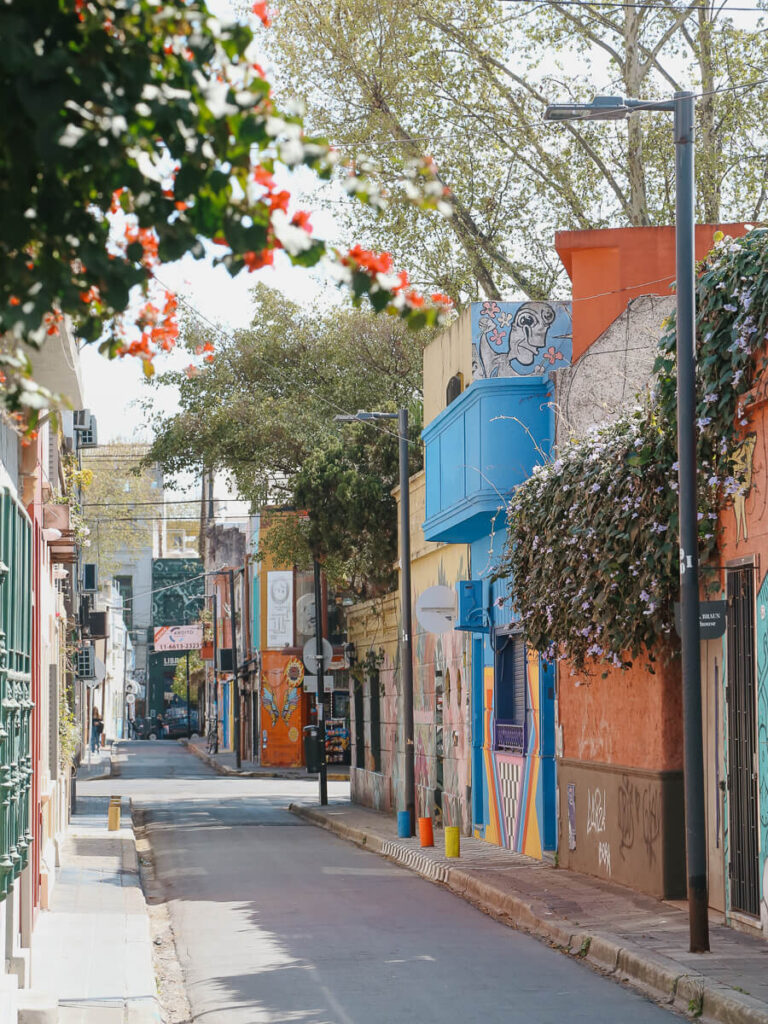
When to Visit Argentina?
First, it’s important to remember that being in the southern hemisphere means that the seasons are flipped from the north.
Summer is December-February and winter is from June-August.
Read in more detail:
- Best Time to Visit Argentina: A More Complete Guide
- Winter in Argentina: Where to Go
Like most places, spring and fall are the best times of the year to visit Argentina.
Temperatures are mild and being shoulder/low season you’ll have better prices and less crowds in most places from Iguazu to Patagonia and Buenos Aires.
Summer is peak season across the country. Argentines take their holidays in January. Popular destinations are packed and prices are at their highest. If traveling in January and February, book accommodations and rental cars well in advance.
Winter can be a great time to visit as well, in case you’re needing to travel during the northern summer holidays. Locations like Iguazu and the Northwest will have milder temps. Patagonia will be perfect for winter sports.
How long do you need in Argentina?
First, there is no such thing as too much time in Argentina.
This isn’t a country where you can get by with a day or two in each city, you’ll be too rushed.
See fewer places and see them well.
I recommend spending at least 10 days to two weeks in Argentina, minimum. If you have the luxury of more time, take it.
With a week or less, see Buenos Aires + one destination.
Read my post about 10 days in Argentina , it features 7 sample itineraries for you to personalize and build off of.
Things to keep in mind? A lot of domestic flights can require an inconvenient layover in Buenos Aires which adds time, time you won’t have if you’re on a tight schedule.
So, in short, come for as long as your schedule allows and choose destinations with flights and time requirements that realistically fit into that timeframe.
Don’t have a lot of time? Iguazu only needs a couple of days. Mendoza can be done in a few days, as well.
Have more time? Patagonia and Salta and Jujuy in the Northwest are wonderful to explore when you have more days to spare.
And Buenos Aires? Spend 3 days here, minimum (read my 3 days in Buenos Aires itinerary ). 5 if you want to add in day trips. You won’t be bored with at least a week here.
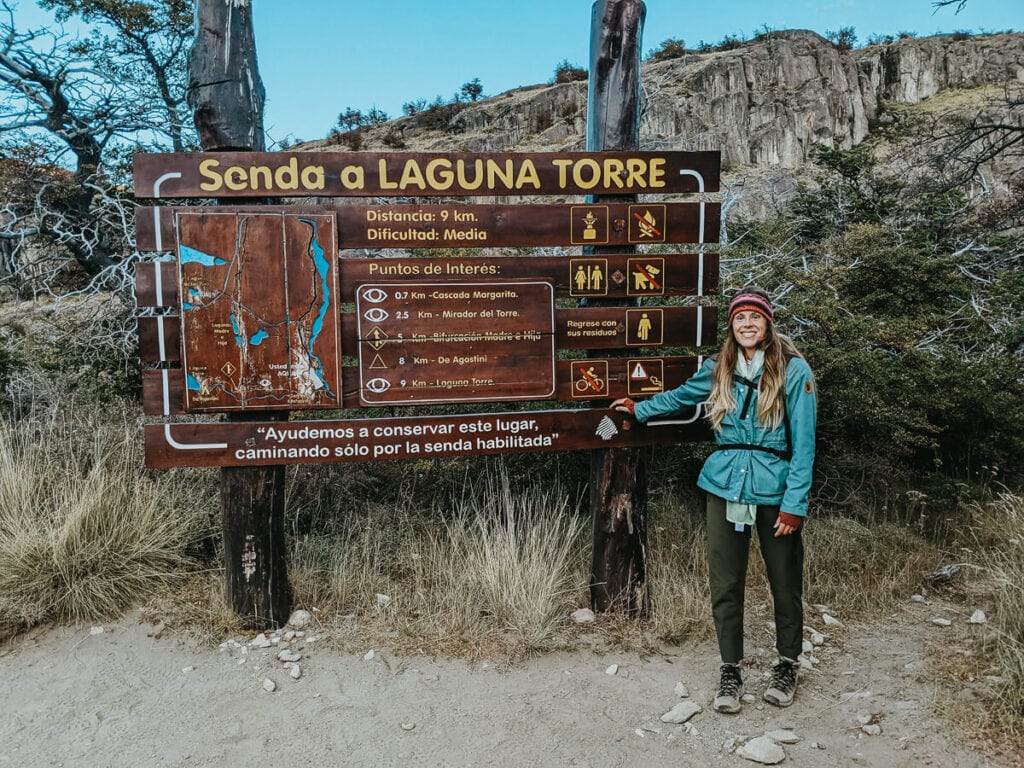
What to Pack for Argentina?
When packing for Argentina, bring layers and pack according to where you’re going.
Fashion here, even in Buenos Aires, is a stylish casual. You’ll be fine with jeans/shorts, t-shirts, and sneakers. Avoid high heels due to the cobblestones (a wedge will be much more comfortable). For a nice dinner or tango show, a light dress or button up for men is fine (no need for a tie or jacket).
In Patagonia, pack layers. You could experience any season at any time of the year. We’ve seen snow in summer in Ushuaia and needed shorts in early Spring in Bariloche. Pack layers to be prepared for anything.
The Patagonian wind is also infamous. Pack a windbreaker and scarf at any time of the year.
In Iguazu you’ll want light clothing for the heat and quick dry clothes in case you get drenched by the falls. Pack shoes with traction (I like my Teva sandals for this) for the pathways.
For hiking in the south, hiking shoes are good enough in El Chalten (especially in summer and spring when you’ll be hot on the trail). Waterproof boots are a good idea in Ushuaia where it can be very, very muddy. I recommend hiking poles to save your knees on the way down.
Read More: My Complete Argentina Packing Guide
How to get a SIM card in Argentina
The three main phone companies in Argentina are Personal, Movistar, and Claro.
It’s most convenient to pick one up in Ezeiza (the international airport) on arrival. Personal has a stand in arrivals outside of customs (land side). You’ll need your passport to set up your new SIM card.
Using a local SIM is ideal if you’ll be in Argentina for a longer trip as data here is very cheap.
Alternatively, you can use an eSIM that you purchase and set up before arriving. This removes any hassle of having to set up a new SIM on arrival. For this I recommend Airolo .
For both options you will need to have your phone unlocked by your provider before leaving home.
Beyond The Blog: Facebook & Consultations
I have a wealth of information on this blog, but if you either can’t find your specific destination or question answered anywhere on this site, I’ve got even more resources for you:
- Join Argentina Travel Tips , a Facebook group I run alongside this blog. It is a constantly growing community of 12,000 fellow travelers. Search the group for already existing threads and ask your questions to get advice from people who have been there.
- Book a private consultation with me , I offer personal video calls to help readers work out the kinks on their itineraries, give advice on where to eat and what to do, think of me as your friend in Argentina!
Do you need travel insurance in Argentina?
While travel insurance is not a legal requirement to travel to Argentina, it is always a good idea to travel insured.
You never know what might happen abroad and travel insurance covers everything from medical bills to lost luggage to (in the absolute worst case of all worst case scenarios) repatriation of your body.
For less than $50 dollars it can save you literally thousands.
I recommend SafetyWing for travel insurance, it’s very affordable and easy to set up.
Airlines & Domestic Flights in Argentina
There are 3 airlines operating domestic flights in Argentina: Aerolineas Argentinas, FlyBondi, and Jetsmart.
The latter two are budget airlines so take into account additionals like checked baggage fees, etc. when comparing costs.
When looking for flights, be flexible when working through your itinerary.
First see what direct flights are possible. Iguazu to Mendoza or Salta is common, for example. Mendoza to Bariloche, as well, but perhaps not all 7 days of the week.
Bariloche to El Calafate has a direct flight only in high season (summer), other times of the year will require you to backtrack to Buenos Aires for a layover.
All of this takes time and planning.
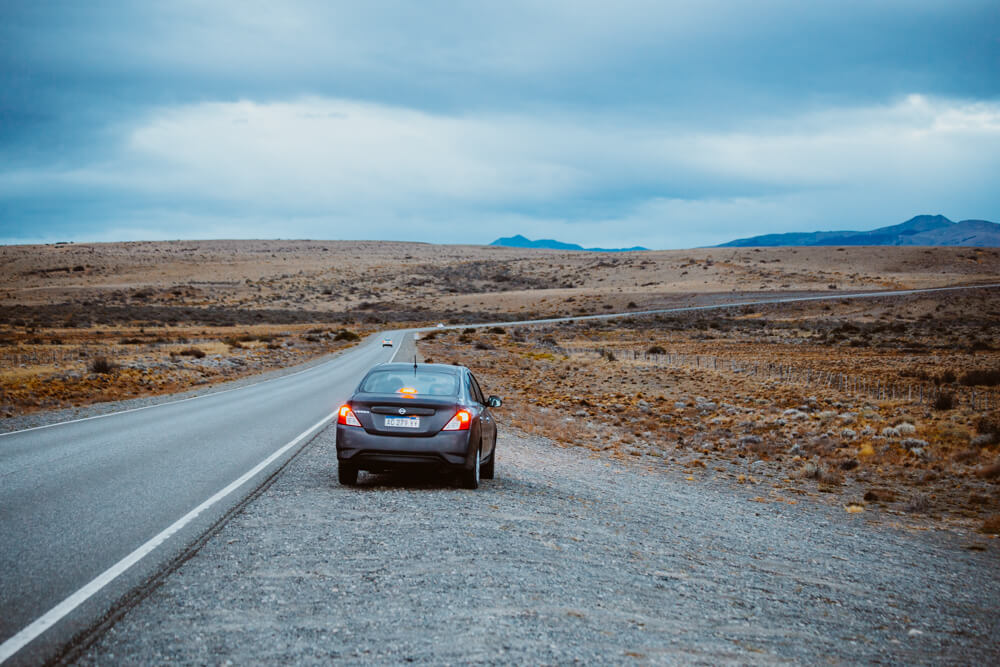
Argentina is a large country and getting around it is no small feat. Here’s how to get from A to B:
- FLY | The easiest and often the cheapest, book a flight to cover the long distances between destinations.
- LONG DISTANCE BUS | Bus travel is very common in Argentina, check Central de Pasajes and Plataforma 10 for routes and prices. Book full cama/cama suite seats for lie flat seating, fundamental to survive the 10-24 hours long trips.
- ROAD TRIP | I LOVE a road trip in Argentina, as this country’s beauty lies in the countryside far from the cities. Just know that with distances being so large it can be cost prohibitive or flat out not allowed by the agency to rent a car in one destination and return it to another one far away.
- READ: All about driving in Argentina
- READ: Iconic Argentina Road Trips
- HITCHHIKE | Hitchhiking in Argentina is very common, read more here . Be prepared for long waits, though, as you can be waiting for hours to be picked up on isolated desert highways.
- TAXIS | Taxis are very affordable across the country. Remis services (private cars with set rates instead of meters) are very common and trustworthy. Ask your hotel/Airbnb for a local remis company they recommend.
- RIDE SHARES | Ride sharing apps are popular in Buenos Aires. Cabify is my favorite as it’s legal. Uber and Didi are both here as well but never fully legalized their presence. Uber is also in the city of Mendoza.
- PUBLIC TRANSPORTATION | Public transport is great throughout all major cities. Buenos Aires has a well connected subway (SUBTE) system, buses, and trains. Bariloche is easy to navigate by bus, as well as Mendoza.
- TRAINS | Travel by train isn’t common in Argentina but is possible for a few select destinations, read about train travel in Argentina to learn more.
SUBE CARDS | To use public transportation in Argentina, you’ll need a SUBE card. You cannot pay with cash. You can buy your SUBE in most Subte/train stations and some kioskos. Check major subte stations for the best chance of finding one .
Eating in Argentina: What to Expect?
Is there more to Argentina than just the red meat and red wine?
Oh you bet your hat there is (although both of those things are pretty spectacular).
Lamb in Patagonia, king crab in Ushuaia, and surprisingly tender llama in Jujuy, there is a lot to try here.
Italians heavily influenced Argentine cuisine as well, so look for fresh homemade pasta and incredible ice cream just about everywhere you look.
Read all of my food guides to eat well in Argentina:
- What to eat in Argentina
- 11 Things to eat in Buenos Aires
- The Best Food Tours in Buenos Aires
- A Gluttonous Guide to Argentine Ice Cream
- All About Meat: A Steak Guide
- Traditional Argentina Desserts for the Sweet Tooth Among Us
- Cheers, Traditional Argentine Drinks
Tipping in Argentina
In restaurants and cafes tipping 10% is the norm.
Leave your tip in cash as you can’t add it onto your credit card bill like you would in the US.
I’ve been asked if its better to tip in dollars, but for small amounts like your tip for dinner I’d leave pesos.
You’ll see cubierto on some bills. This is a fee charged by some restaurants as a cover charge and it is supposed to cover bread, water, and the like. Your waiter does not receive any of this money and it does not take the place of your tip.
Tipping for large events like a day with a private fishing guide or driver can require a larger tip (assuming you had a wonderful experience!). In these situations you can leave 20-30% to thank your guide for their time and expertise. If it’s a large amount, dollars are acceptable and welcome for this.
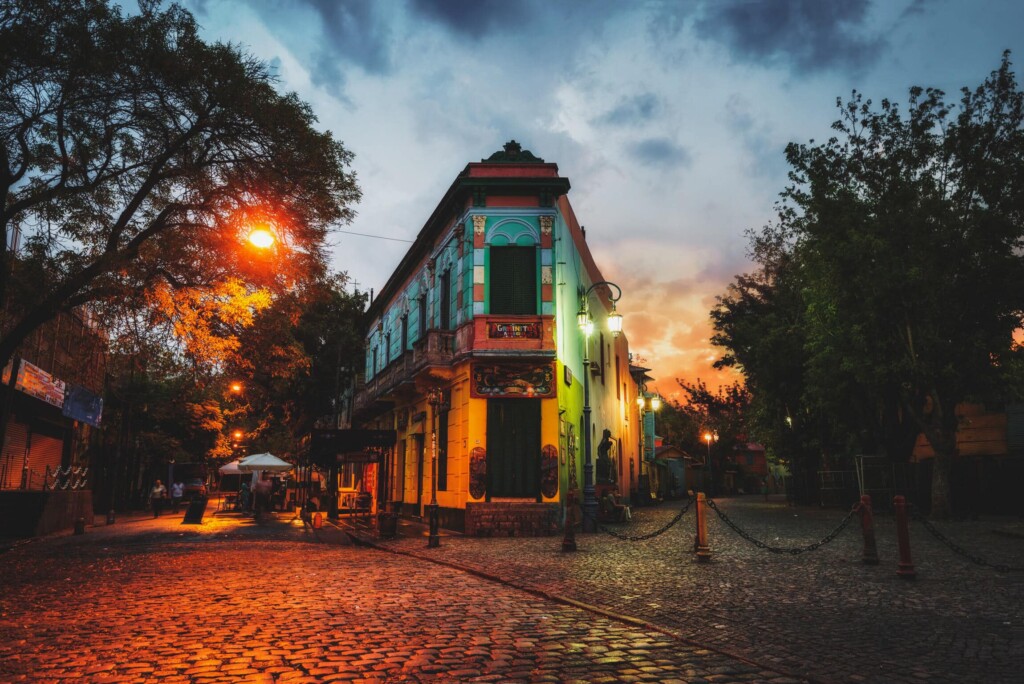
Is Argentina Safe?
Overall, Argentina is a very safe country. After over 13 years of living here I have never had any issues.
Buenos Aires is a large, metropolitan city and you should treat it like any other large city.
While in Buenos Aires (and same with Mendoza, Rosario, Cordoba), be careful of pickpockets, petty crime, and minor tourist scams (like you’ll encounter in most areas of the world).
I have a full article about safety in Buenos Aires for more information.
Once you leave Buenos Aires, it is mainly rural landscapes and small cities. People are familiar and helpful.
Argentina Safety Tips:
- Protests are common and a part of everyday life in Argentina. In general, they are non-violent and nothing to worry about but, in an abundance of caution, stay on the outskirts in case you need to make a quick exit if things get rough.
- Small towns are very safe. You may not find much English spoken but you will find people eager to help. Still, take care not to leave your belongings unattended.
- Driving is safe in Argentine but distances are long. Make sure you have a spare tire and know how to change it if going on a long road trip.
- Hitchhiking is common with backpackers but use your best judgment here. In many rural areas of Argentina, phone signal is spotty or non-existent and you won’t even be able to call for help. Avoid putting yourself in a car with strangers, especially if you’re traveling alone.
Argentina Travel Resources
- TRAVEL INSURANCE | It is always a good idea to travel insured. It protects you in so many cases, like lost luggage and trip cancellations, medical emergencies and evacuations. It’s very affordable with the potential to save you thousands in the case of an emergency. I recommend SafetyWing .
- PHONE PLAN | These days, traveling with data is essential. Especially in Argentina where everything is managed on Instagram and WhatsApp. I recommend this E-SIM card . It’s hassle-free and affordable, for more read how to get an Argentina sim card.
- ACCOMMODATION IN ARGENTINA | booking.com is the most common hotel site used in Argentina and it’s where you’ll find the most options.
- RENTAL CARS | I love to travel Argentina via road trip, I’ve always used rentalcars.com, now they are operating under the umbrella of B ooking.com’s car rental system.
- BUS TICKETS | Check Busbud for long distance bus routes and tickets.
- VPN | If you’ll be using a public WiFi connection and want to secure your data, I highly recommend using a VPN, I personally use and have had a good experience with ExpressVPN . I also use it to access Hulu and American Netflix from Argentina.
- FLIGHTS | Always check Google Flights and Skyscanner for flights to and within Argentina. Aerolineas Argentina is the local airline with the most routes. FlyBondi and Jetsmart are two budget airlines with dirt-cheap prices (but expect to pay for every add-on like luggage).
- BOOK A CONSULTATION | I offer one-on-one travel consultations to help you plan your trip to Argentina. Pick my brain to get a local’s insight. Click here for more information .
Affiliate Disclosure
This website contains affiliate links and Sol Salute may receive a commission for purchases made through these links, at no extra cost to you. As an Amazon Associate, I earn from qualifying purchases. Read more.
About Me Work With Me Contact Me Privacy Policy
Argentina Travel Guide Buenos Aires Guide Patagonia Guide Food & Drink Culture
Travel Better
Travel Consultations Join the FB Group Travel Gear Live Abroad Yoga
Follow Along on Social Media
Copyright 2017-2024 Sol Salute. All Rights Reserved.
- Argentina Travel Guide
- Argentina Travel Tips
- Argentina News
- Argentina Gallery
Log in with user name:
Log in with social media:
Get FREE email communications from Fodor's Travel, covering must-see travel destinations, expert trip planning advice, and travel inspiration to fuel your passion.
Travel Tips
- South America
Argentina TRAVEL GUIDE
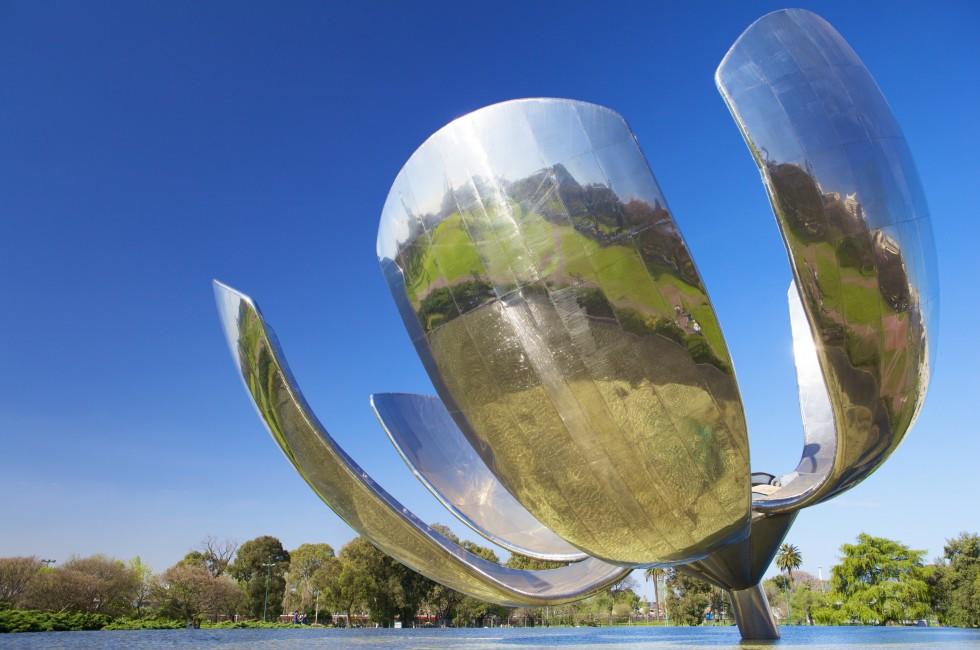
Fodor's Essential Argentina: with the Wine Country, Uruguay & Chilean Patagonia Whether you want to dance the tango in Buenos Aires, sip wine in Mendoza, or explore the...
Argentina's magnificent landscapes create memorable backdrops for amazing experiences. Wine lovers can sample world-class Malbecs at Mendoza's high-altitude vineyards with Andes Mountain views; adventure seekers revel in the colorful canyons of the Northwest; and nature lovers marvel at the thundering torrents of Iguazú Falls. In Patagonia, top-notch outdoor activities beckon, from scaling translucent glaciers to spotting penguins and whales. Urban adventures also await in Buenos Aires, with its thriving foodie scene, chic shopping districts, and vibrant nightlife.
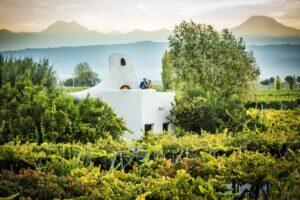
FODOR'S FINEST
The best hotels in south america & the caribbean.
- Cavas Wine Lodge Mendoza, Argentina
Find a Hotel
Top destinations.
- Parks & Preserves
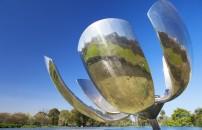
Buenos Aires
Glamorous and gritty, Buenos Aires is two cities in one. What makes Argentina's capital so fascinating is its dual heritage—part European, part Latin American. Plaza...
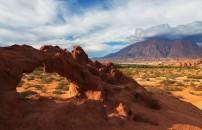
The Northwest
This region flourished under the Inca, then attracted treasure-seeking Spaniards during colonial times; now it’s luring an international contingent of tourists—and rightly so. The Northwest...
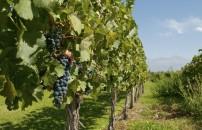
Wine Regions
Exceptional wine, top-quality cuisine, exhilarating outdoor activities, and the skyscraping Andes framing almost every view: it’s easy to see why people come here, and why...
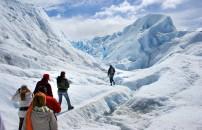
Patagonia is a wild and rugged land filled with breathtaking landscapes and eye-catching wildlife. There are few other places in the world where you can...
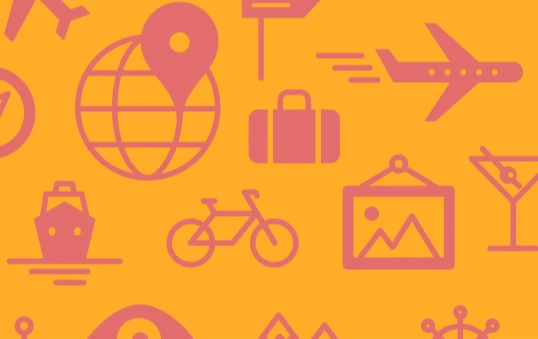
Side Trips from Buenos Aires
To hear porteños (inhabitants of Buenos Aires) talk of their city, you'd think Argentina stops where Buenos Aires ends. Not far beyond it, however, the...
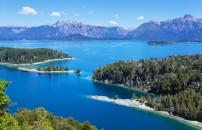
The Lake District
The northern Lake District has become Patagonia’s most popular tourist region. Spread over three states and encompassing more than a million hectares (2½ million acres)...
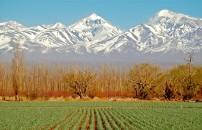
- Mendoza City
Mendoza’s streets are shaded from the summer sun by a canopy of poplars, elms, and sycamores. Water runs along its sidewalks in acéquias, disappears at...
- El Calafate, El Chaltén, and Parque Nacional los Glaciares
Founded in 1927 as a frontier town, El Calafate is the base for excursions to the Parque Nacional Los Glaciares, which was created in 1937...
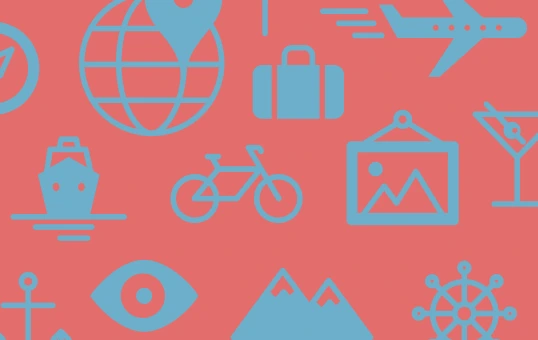
- Buenos Aires Province
Plains fan out where the city of Buenos Aires ends: this is the beginning of the pampas, which derive their name from the native Quechua...
It's not just "Salta" to most Argentineans, but "Salta la Linda" ("Salta the Beautiful"). That nickname is actually redundant: "Salta" already comes from an indigenous...
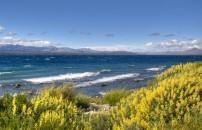
Bariloche is the gateway to all the recreational and scenic splendors of the northern Lake District and the headquarters for Parque Nacional Nahuel Huapi. Although...
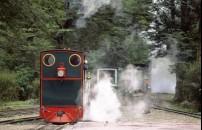
- Ushuaia and Tierra del Fuego
At 55 degrees latitude south, Ushuaia (pronounced oo-swy-ah) is closer to the South Pole than to Argentina's northern border with Bolivia. It is the capital...
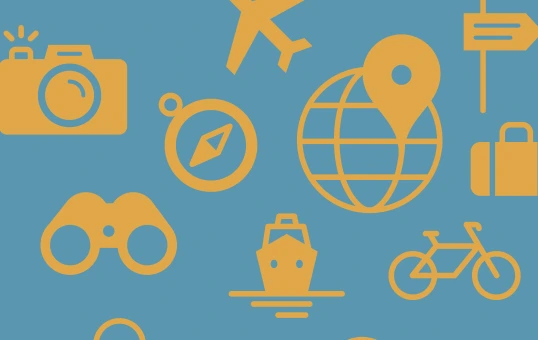
- Puerto Madryn and Península Valdés
Approaching from Ruta 3, it's hard to believe that the horizon line of buildings perched just beyond the windswept dunes and badlands is the most...
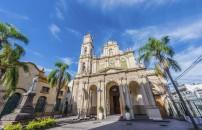
- San Salvador de Jujuy
Founded by Spaniards in 1593, San Salvador de Jujuy (known as Jujuy to most Argentineans and as "S.S. de Jujuy" on signs) is a compact...
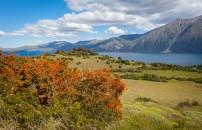
- San Martin de los Andes
Surrounded by lakes, dense forests, and mountains, San Martín de los Andes lies in a natural basin at the foot of Lago Lácar. It's a...
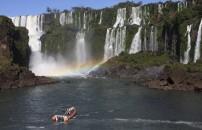
- Iguazu Falls
Iguazú consists of some 275 separate waterfalls—in the rainy season there are as many as 350—that plunge more than 200 feet onto the rocks below...
Easygoing San Juan makes a good base if you want to combine active pursuits (a good selection of which can be found in and around...
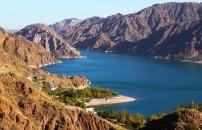
San Rafael (population 175,000) is the second largest city in Mendoza. Wide avenues lined with leafy sycamores and tall poplars fed by streetside canals give...

Thanks to a microclimate and fertile soil, Cafayate and the surrounding area is one of Argentina's booming wine regions. The town itself is civilized and...
- Lujan de Cuyo
Bordering both banks of the Mendoza River, Luján de Cuyo is known as the home of Malbec because it was here that the variety first...
- Trelew, Gaiman, and Punta Tombo
Trelew (pronounced Tre-leh-ew) is a commercial, industrial, and service hub that contains the region's main airport. Its biggest attractions are its paleontology museum (with the...
Founded in 1600 and witness to many battles during the War of Independence, Tilcara is on the eastern side of the Río Grande at its...
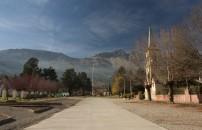
El Bolsón ("the purse") lies in a valley enclosed on either side by the jagged peaks of two mountain ranges. You catch your first glimpse...
Tupungato is a sleepy agricultural town most of the year. During harvest (February and March), though, the roads in and around it overflow with carts...
At the crossroads of three important routes—Ruta Nacional 7 from Mendoza across the Andes, Ruta 57 from Mendoza via Villavicencio, and Ruta 39 from San...
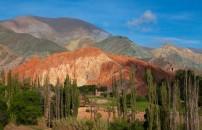
Nestled in the shadow of craggy rocks and multicolored, cactus-studded hills—with the occasional low-flying cloud floating by—the colonial village of Purmamarca is one of the...
Twice the size of Tupungato, Tunuyán makes a good base for touring the Valle de Uco wineries. Downtown consists of two traffic circles on either...
- Tafi del Valle
- Villa La Angostura
Sitting on a narrow angostura (isthmus) on the northern shore of Lake Nahuel Huapi, Villa La Angostura was once a mere hamlet. But, having benefited...
Lying south and slightly east of Mendoza City, Maipú—the province’s oldest wine region—is spread over the districts of General Gutierrez, Coquimbito, and Cruz de Piedra...
- Parque Nacional Nahuel Huapi
Created in 1934, Parque Nacional Nahuel Huapi is the oldest national park in Argentina. It’s also one of the largest, encompassing more than 7,050 square...
Humahuaca—at an altitude of 2,957 meters (9,700 feet)—is the gateway to the Puna. Its narrow stone streets hark back to pre-Hispanic civilizations, when aboriginals fought...
This small colonial village on Ruta 40 is fast becoming a base for exploring the north of Calchaqui Valley. Cachi itself has a charming church...
- Peninsula Valdes
The biggest attraction in Península Valdés is the ballena franca (southern right whale) population, which feeds, mates, and gives birth here. The protected mammals attract...
- Los Esteros del Ibera
After driving or riding for hours along the empty coastal road (or via Ruta Provincial 30 from Ruta 3), the tiny town of Camarones—a collection...
- Sarmiento and the Bosque Petrificado
Built in a fertile valley formed by the Río Senguer and its two interconnected lakes, Lago Musters and Lago Colhué Huapi, the Sarmiento area is...
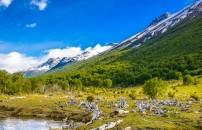
- Parque Nacional Tierra del Fuego
This park is one of the main reasons that travelers make a trip to the tip of Argentina. Its deep forests, glistening lakes, and wind-whipped...
Beyond the streets of Barreal, hiding in the shade of sauce llorones (weeping willows) and alamos, lie apple orchards, vineyards, and fields of mint, lavender...
- Villa Traful
If there were a prize for the most beautiful lake in the region, Lago Traful would win for its clarity, serenity, and wild surroundings. Small...
The most Welsh of the Atlantic Patagonian settlements, sleepy Gaiman (pronounced Guy-mon) is far more charming than nearby Trelew and Rawson. A small museum lovingly...
Las Leñas is the largest ski area served by lifts in the Western Hemisphere—bigger than Whistler/Blackcomb in British Columbia, and larger than Vail and Snowbird...
Molinos, a village with about 5,000 inhabitants, has a photogenic 17th-century church and a small vicuña-breeding farm (vicuñas are similar to llamas but their fur...
- Parque Nacional Lago Puelo
Parque Nacional Lago Puelo is one of the smallest national parks in the southern Andes and one of the warmest spots in the region. The...
- Comodoro Rivadavia
Argentina's answer to Houston, Comodoro Rivadavía is the town that oil built. Unlike Houston, however, there's not much here apart from oil drilling. Argentina's first...
Founded in 1985, El Chaltén is Argentina's newest town, and it's growing at an astounding rate. Originally just a few shacks and lodges built near...
- Bahia Bustamante
Spending time in Bahía Bustamante is like having your own private Península Valdés. In 1953 it was founded by Lorenzo Soriano, who searched the Patagonian...
- Parque Nacional Lanin
The dramatically beautiful Parque Nacional Lanín contains 35 mountain lakes, countless rivers, ancient forests, and the Volcán Lanín. Tucked into the folds of the Andes...
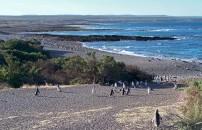
- Punta Tombo
This protected area is home to one of the world's biggest colonies of Magellenic penguins; they come for the season to lay eggs and feed...
- The Atlantic Coast
All Destinations Expand All Collapse All
- Costanera Norte
- Las Cañitas
- Puerto Madero
Top Experiences
- Things to Do
- Restaurants
- Need to Know
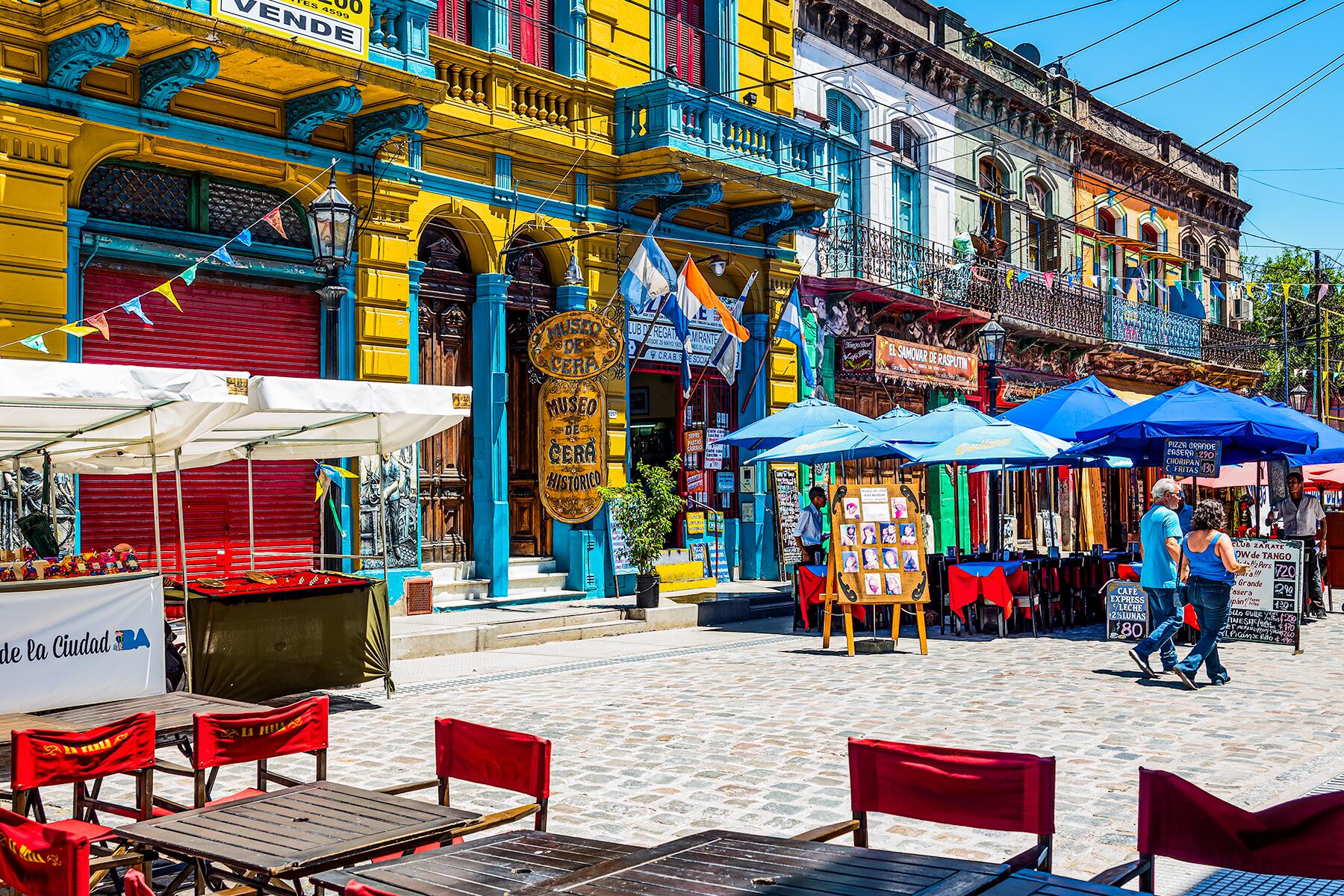
The 25 Best Things to Do in Argentina
Heather Jasper
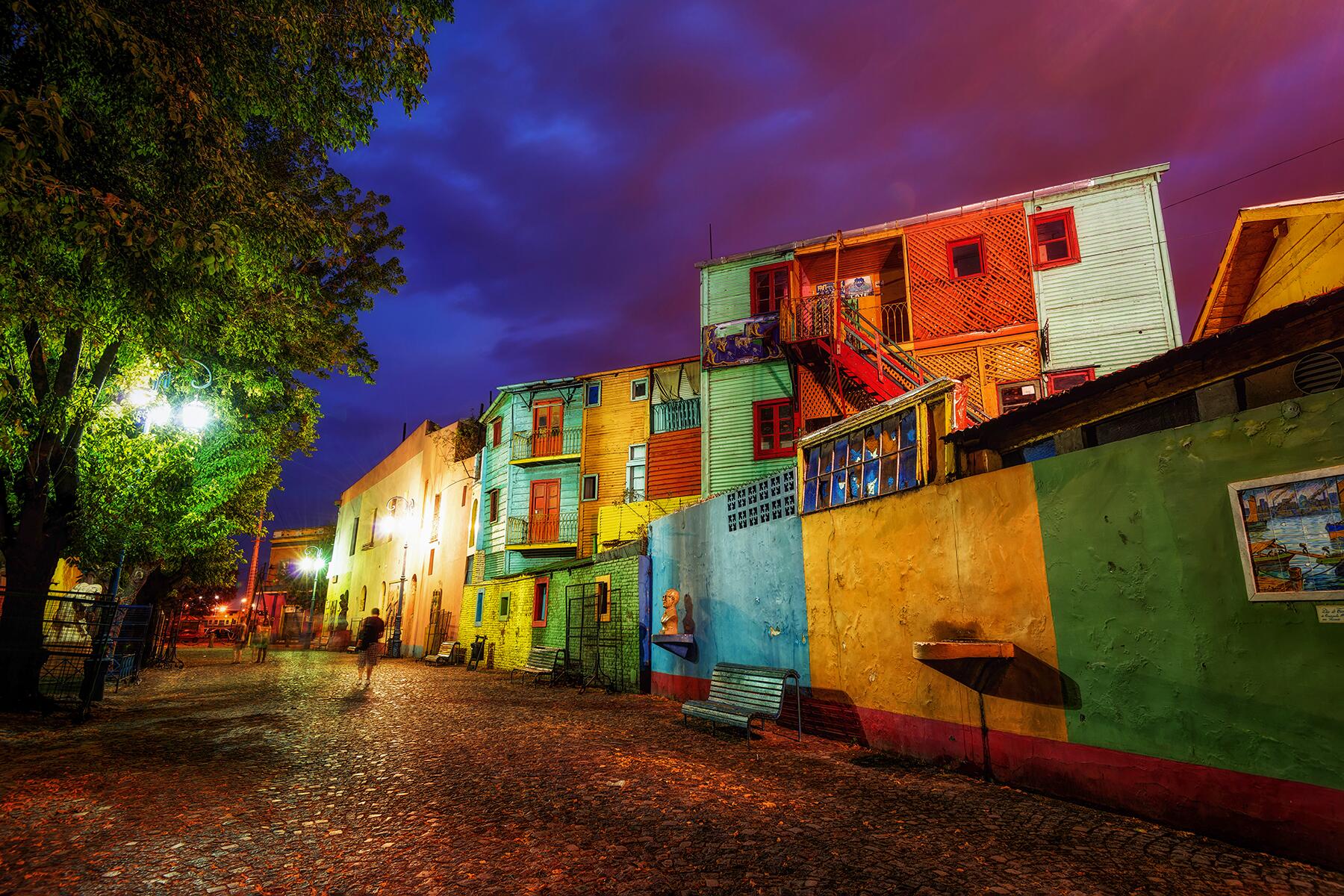
Hotels & Lodging
You Shouldn’t Book an Airbnb in Argentina
Greyson Ferguson
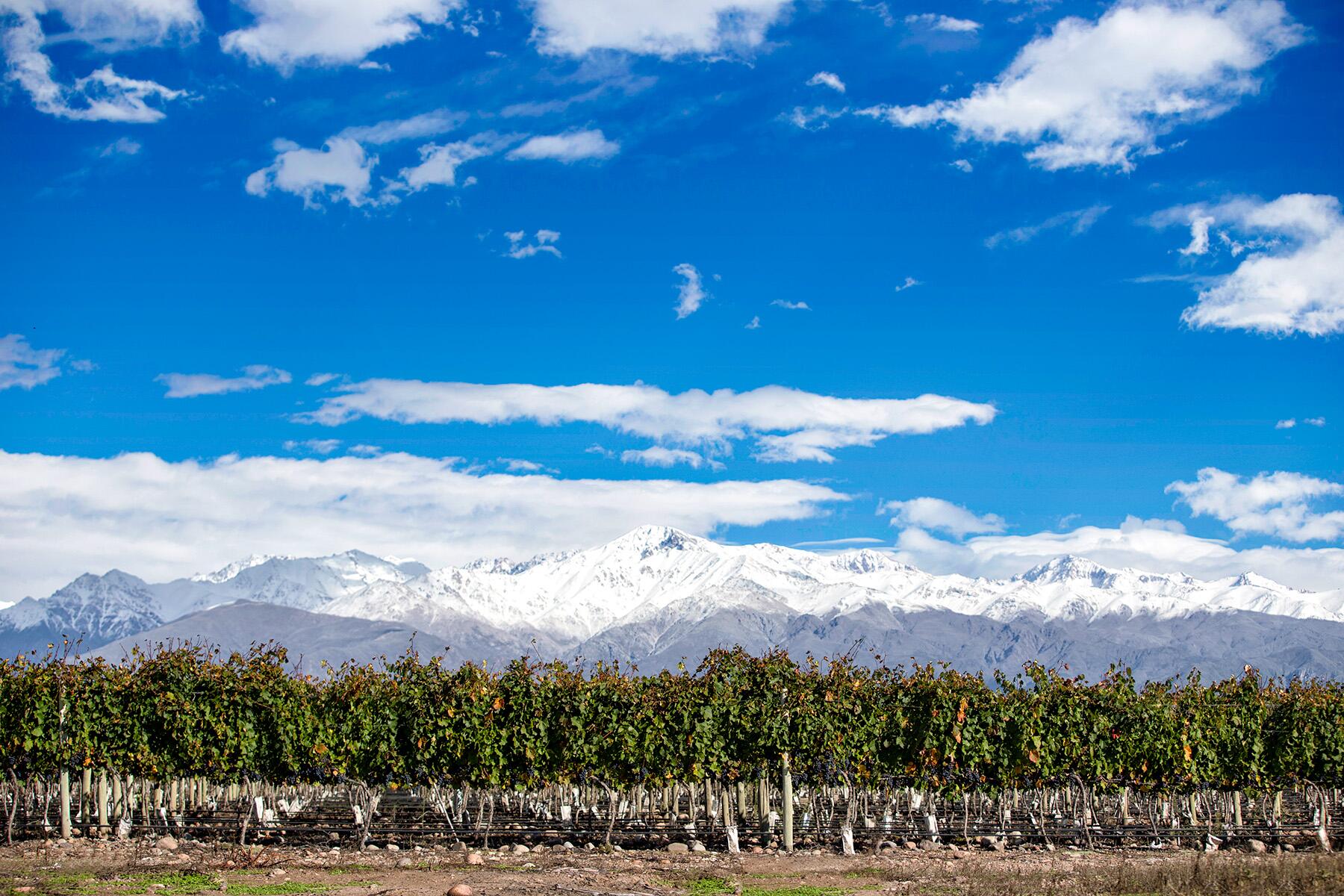
White Malbec Is the New White Wine You’ve Never Heard Of
Leila Najafi
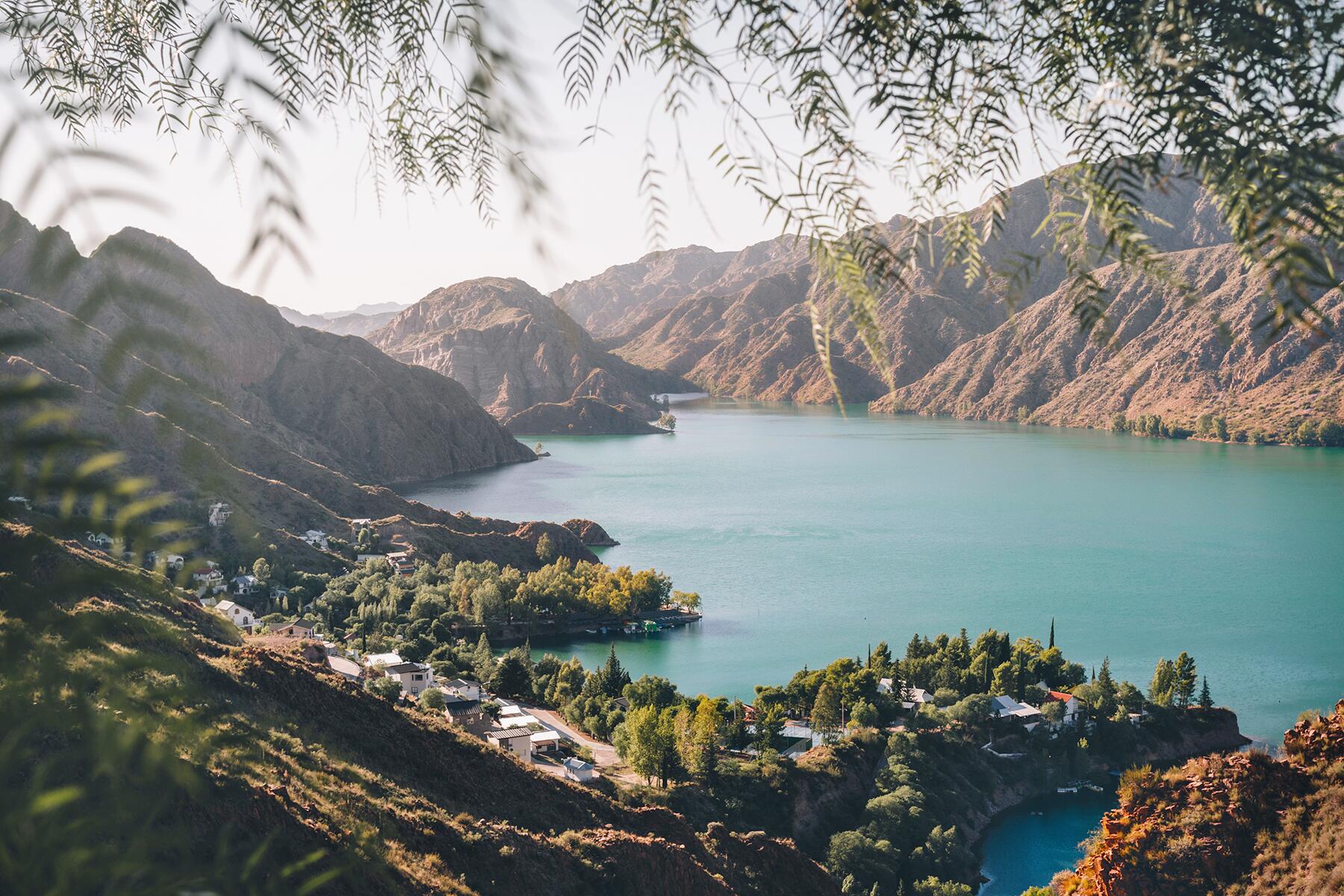
Considering a Trip to South America? Here’s How to Get a Bonus Vacation En Route
Angelique Kennedy-Chavannes
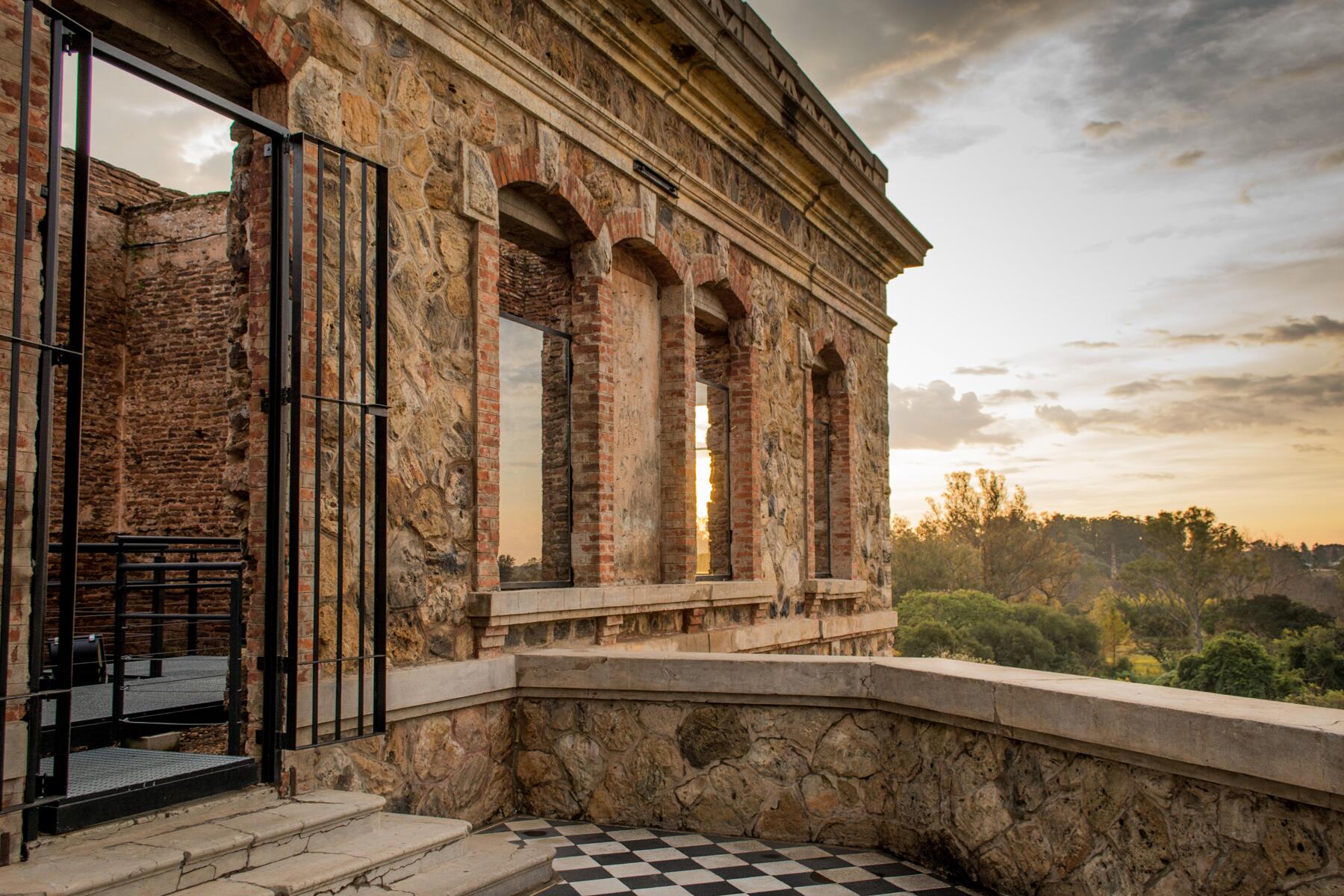
An Unexpected Destination Inspired a Beloved Children’s Book
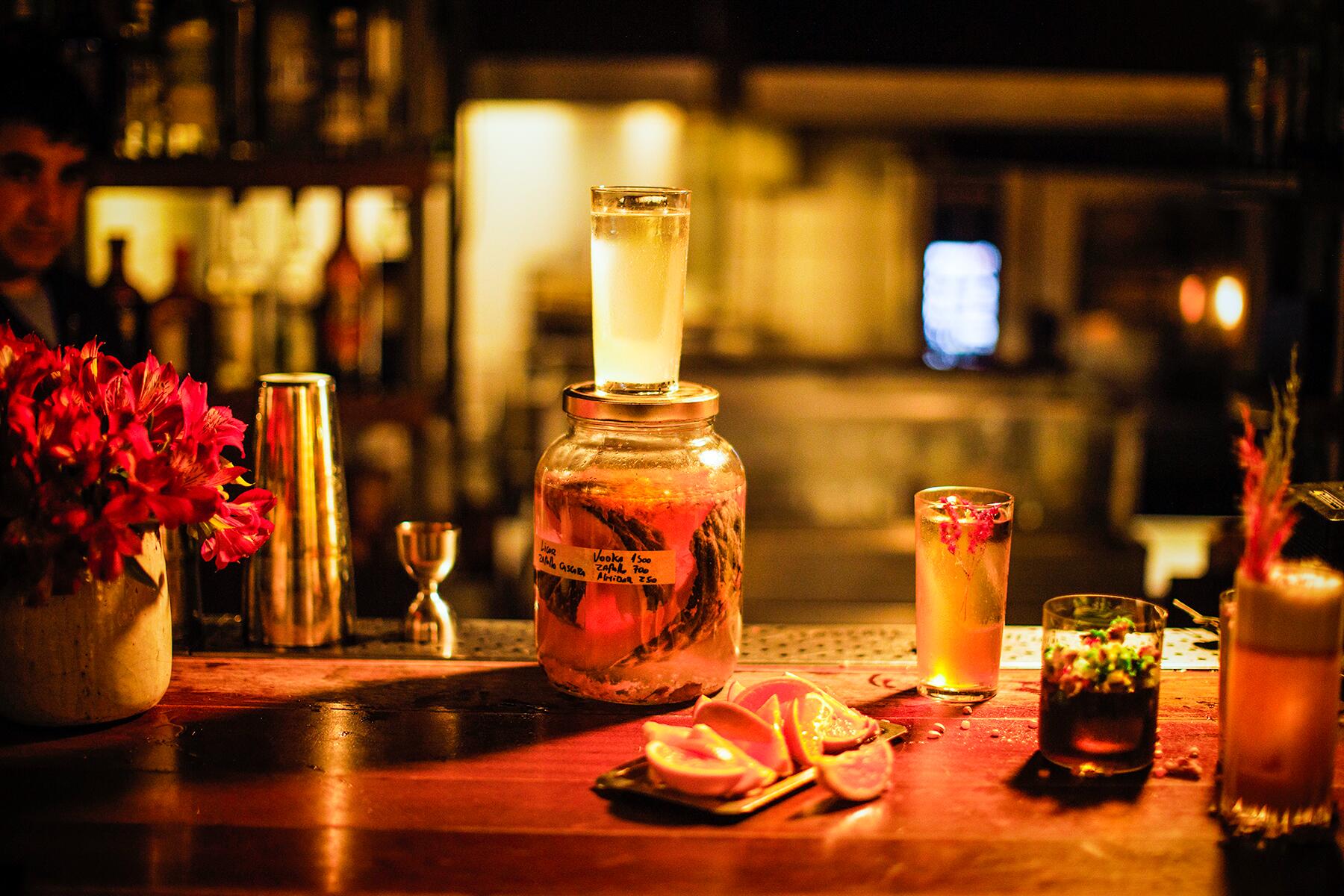
Bar Crawl Through Buenos Aires’ Dazzling Speakeasies
Jamie Valentino
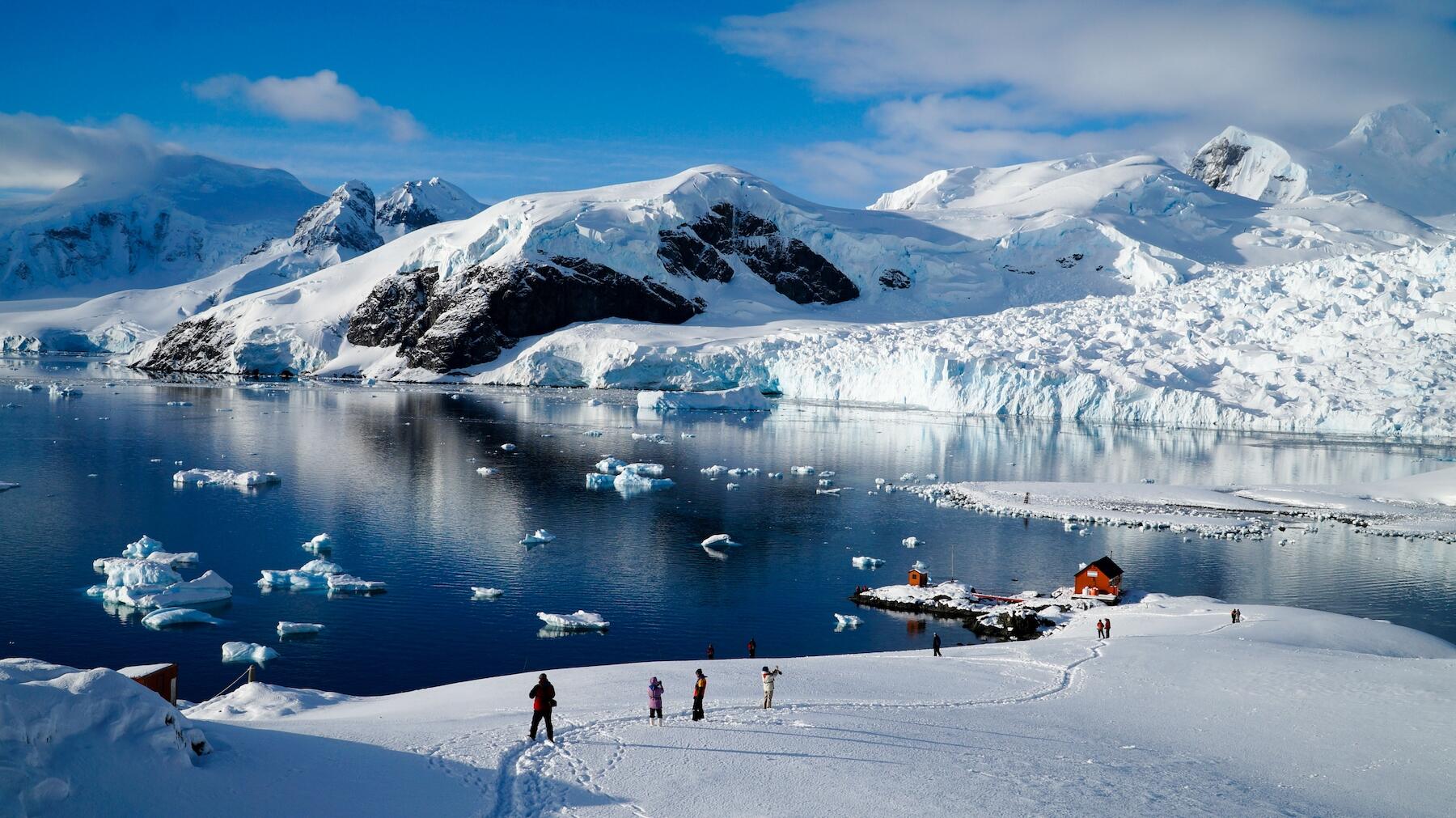
Cruises & Crossings
How to Trick Your Boyfriend Into Going to Antarctica
Kay Kingsman
Recent Forum Posts
Flying this week adv fr 15 day (approx) argentina brazil itinerary in april please, mendoza to salta hire car share argentina, argentina and on to antarctica dec 2023, 4-week argentina and chile itinerary feedback, see all posts.
Our worldwide travel correspondents bring you the best and most up-to-date coverage of over 7,500 global destinations.
- Destinations
- Advertising
- Fodor’s Travel Use of this site indicates your consent to the Terms of Use. Copyright © 2024 by MH Sub I, LLC dba Internet Brands. Fodor’s is a registered trademark of MH Sub I, LLC dba Internet Brands. All rights reserved.
Thank you for your interest!
Nomadic Matt's Travel Site
Travel Better, Cheaper, Longer
Argentina Travel Guide
Last Updated: April 29, 2024
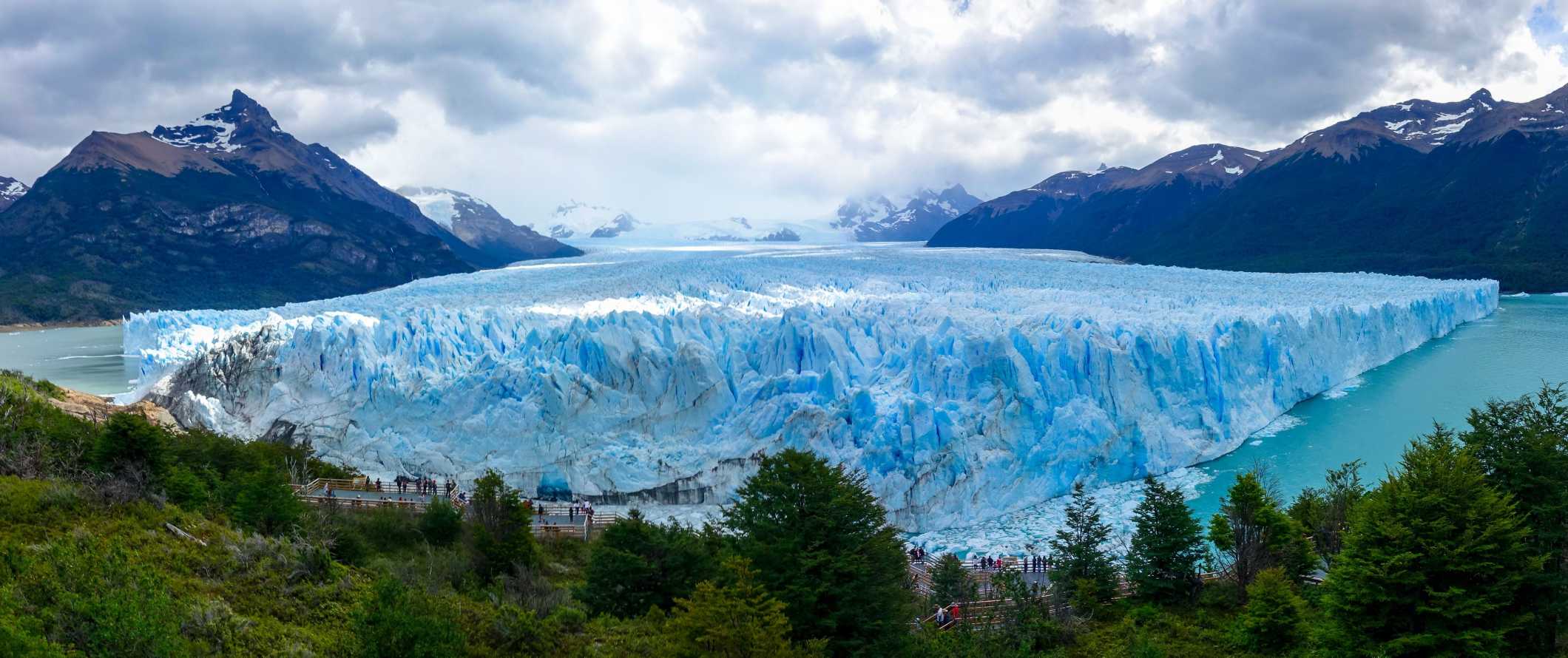
Argentina is one of the most popular countries to visit in South America. Whether you’re backpacking the entire country or just visiting on a short holiday looking to drink wine, eat steak, and do some hiking, Argentina will not disappoint you. I love the place to death.
From the relaxed café culture of Buenos Aires to the natural beauty of the massive Iguazu Waterfalls, the stunning Perito Moreno glacier to the charming vineyards of Mendoza , Argentina is a wonderfully beautiful country with world-class landscapes to match the delicious steaks, award-winning wine, and lively and welcoming people you’ll find here.
Argentina blew away all of my expectations.
This travel guide to Argentina can help you plan your trip, stay safe, stay on a budget, and ensure you make the most of your visit here.
Note : Argentina suffers from incredible inflation and prices vary widely and increase without notice. The prices here might be accurate as of the day we publish but could be dramatically different by the time you get there. Keep that in mind as you plan your expenses.
Table of Contents
- Things to See and Do
- Typical Costs
- Suggested Budget
- Money-Saving Tips
- Where to Stay
- How to Get Around
- How to Stay Safe
- Best Places to Book Your Trip
- Related Blogs on Argentina
Click Here for City Guides
Top 5 things to see and do in argentina.
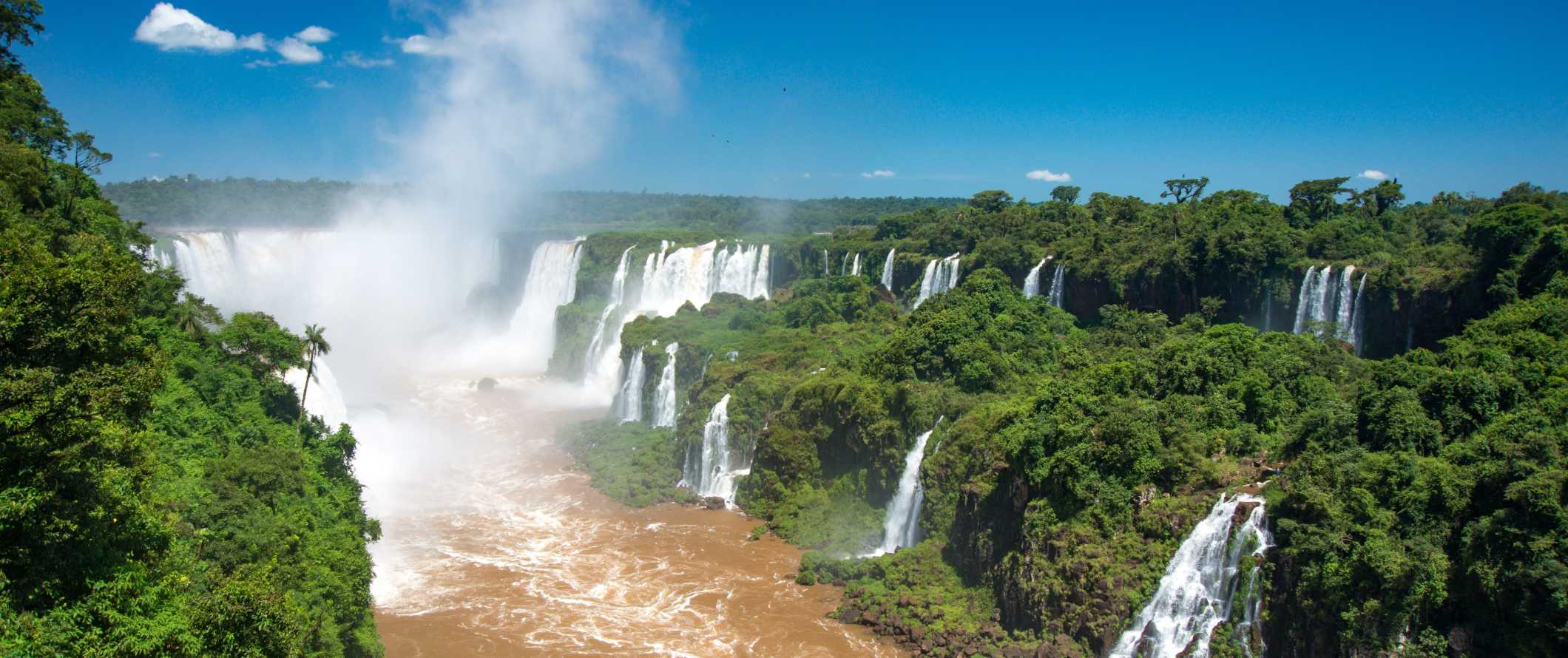
1. Enjoy the culture of Buenos Aires
Nicknamed the “Paris of South America,” Buenos Aires is an amazing and fun city with a lot of culture, fantastic nightlife, food, and shopping. Stay in the trendy Palermo neighborhood and walk the tree-lined streets, visit the Museum of Latin American Art in Buenos Aires (aka MALBA), and explore Palermo Soho which has a more youthful vibe and is crammed with cool shops and boutiques.
Additionally, on the southern border of Palermo is La Recoleta Cemetery, one of the most atmospheric graveyards on the planet and home to several famous Argentines, including Eva Peron, several past presidents, patriots, poets, and other VIPs of Argentine history. El Museo Nacional de Bellas Artes, the National Museum of Fine Arts, is nearby as well. Opened in 1895, the museum houses works by Goya, Monet, Rubens, Rembrandt, Van Gogh, and many other masters.
2. Marvel at Iguazu Falls
With 450,000 cubic feet of water thundering down the 275 cascades every second, it’s easy to see why this massive waterfall is so popular. The water plunges below in a powerful and sensational flurry of white water and mist with rainbows stretching above it all. The uneven cascades are also some of the tallest in the world, as they measure between 62-85 meters (210-269 feet). A sturdy wooden walkway allows visitors to wander out to get a closer, face-to-face look at the falling water. Some might remember the falls played a supporting role in the films Indian Jones and the Kingdom of the Crystal Skull, Captain America: Civil War, and The Mission, among many others.
You can find several types of guided trips leaving from Buenos Aires or just go on the local bus yourself. Stay in Argentina and get drenched on a boat ride around the falls or spring for a tour that includes Brazil on the opposite shore. The view from Brazil is arguably better, since you’re on a narrow ridge surrounded by the falls in Argentina. The entry fee for Iguazú Falls National Park on the Argentine side is 20,000 ARS.
3. Wander Salta
Located in the northwest of the country, Salta is a small city with outstanding museums, plaza-side cafes, and a lively folk music tradition. The colonial architecture of the city is well preserved here too. The most popular museum is Museo de Arqueología de Alta Montaña (MAAM), opened in 2004 for the mummies of three children sacrificed by the Inca and discovered in 1999. Don’t miss the Teleférico San Bernardo, a cable car that glides through the air to a hilltop with a gorgeous view of the whole city. A round-trip ticket for San Bernardo is 8,000 ARS.
4. Learn the tango
Argentina is famous for its national dance, the tango. You’re bound to run into it everywhere you go with people quite literally practicing in the streets. Throughout the country there are studios that offer lessons if you want to learn and free public places to watch the locals dance away. In Buenos Aires, splurge on a tango show at the historic Teatro Tabarís or Gala Tango. A more budget option is the outdoor shows in Plaza Dorrego, where the best dancers can be found every Sunday afternoon.
5. Explore Mendoza
Other things to see and do in argentina, 1. take the train to the clouds.
Sure, it’s a train built for tourists and super overpriced, but taking this train through the clouds and lush forest is so breathtaking I don’t mind. This is a 400-kilometer (250-mile), 16-hour round trip into the Andes from the town of San Antonio de los Cobres. You can buy the train ticket with the bus ride between Salta and San Antonio de los Cobres included, or via just the train. Consider buying just the train ticket so you can spend a little time checking out the Andean culture (and llamas) in San Antonio. As the train climbs to 4,200 meters (13,779 feet), you’ll be rewarded with spectacular views overlooking mountains, forests, and valleys. It only operates seasonally and on specific days of the week, so be sure to check the schedule before you go. The website only shows prices once you pick a date for the reservation.
2. Climb Cerro Aconcagua
At almost 7,000 meters tall (23,000 feet), Cerro Aconcagua is not only the country’s highest mountain but also the highest in the Western Hemisphere. This climb isn’t for the faint-hearted as it’s estimated to take a couple of weeks to acclimatize to the altitude and reach the summit. However, it’s a challenging hike, not a technical climb. Many hikers set their sights on part of the mountain, without risking the dangers of oxygen deprivation near the summit. If you love a challenge and are a practiced hiker, it’s an adventure worth considering! Due to the instability of the peso, many trekking companies post prices in USD. Guided summit hikes cost around $5,000 USD while an 8-day trek around the mountain (not to the summit but around the various camps) costs around $2,000 USD. The most popular option is a 4-day hike around the mountain, which costs $700 USD per person. Not into hiking? Nearby Los Horcones Lake is only 2,900 meters (9,514 feet) above sea level and a popular fishing destination.
3. Explore Valle de la Luna
Translated as “Valley of the Moon,” this dramatic landscape dates to the Triassic period. Winds and rain have carved the rocks into strange formations that give this place the look of a lunar landscape. Despite the arid conditions, the area is great for wildlife spotting as it’s home to foxes, owls, armadillos, condors, and guanacos. A wild cousin of the llama, guanacos will give your landscape photos a decidedly South American flair. The unique geological formations and fossil beds have earned its status as a UNESCO World Heritage Site. Don’t miss the Museo de Sitio William Sill, built over impressive dinosaur fossils where you can watch archeologists at work.
The best way to explore the park is via a rental car. Once you have that, you can take the 25-mile circuit tour, stopping at five different points along the way, each one offering stunning sights and views of the park. The circuit should take approximately three hours. There are also hikes through the park. One of the most popular is the trek up to Cerro Morado, the tallest mountain in the park at nearly 1,900 meters (6,000 feet). The walk takes about three hours and, once at the top, offers wow-inducing views of the natural landscape below. Admission to the park is 5,000 ARS.
4. Hike on Perito Moreno Glacier
Located within the expansive Los Glaciares National Park is the impressive Perito Moreno glacier. At almost 4,570 meters (15,000 feet) wide and 61 meters (200 feet) tall, it’s one of the coolest sights I’ve ever seen. You can hike on the glacier (which is an epic experience) or walk on the metal platforms constructed a stone’s throw from the massive wall of ice. You’ll need a licensed guide, ropes, and crampons to hike on the glacier but you can take the bus from El Calafate and do the platform walk on your own. Boat rides to Perito Moreno get you even closer and can include other nearby glaciers like Spegazzini and Upsala. Depending on the season, a full-day tour including a boat ride costs around 99,000 ARS. Austral summer, from December to February, has higher prices.
5. Day trip to San Rafael
Located a few hours from Mendoza, this tiny little town is a wonderful place to see wineries. Try the local Malbecs and other reds that go perfectly with an Argentine asado. Like Mendoza, this is a great place to go on a bike ride through the picturesque vineyards. Don’t miss out on the nearby stunning Atuel Canyon, where you can go whitewater rafting in the summer. San Rafael is a charming little place to relax and slow down to enjoy the local pace of life. A bus from Mendoza to San Rafael costs 2,500 ARS for a one-way ticket.
6. Visit Ushuaia
Ushuaia is the most southerly city in the world and the largest city in Tierra del Fuego. This is a very popular town for travelers coming to the end of their South American journey, or for those traveling to Antarctica. This is the launch point for all Antarctica cruises, as the continent is only 1,100 kilometers (680 miles) away. Plan at least three days here to go hiking in the national park, walk among the penguins on Hammer Island, and try one of the local tea houses. The most popular is La Cabaña, at the foot of the Martial Glacier ski resort. If you’re there in winter, visit one of the three local ski resorts or go on a dog-sledding tour. Overall, it’s an adventure travel hub that deserves a few days before or after your other adventures.
7. Go whale watching
From June to December, whale watching season in Patagonia is at its peak as the whales make their way to the coast to mate. Whale watching is an expensive excursion, but it’s well worth it during migration time as you’re guaranteed to spot a few whales. The Valdes Peninsula is the best place to go on a tour. Only six companies are allowed to operate here so as not to disturb and overwhelm the whales. Expect to see orca, humpback, southern right whales, and blue whales. This is a remote area of Patagonia and the best place to stay nearby is Puerto Madryn. Due to the instability of the Argentine peso, most tour agencies post prices in US dollars. A full day wildlife and whale watching tour costs $145 USD.
8. Discover Quebrada de Humahuaca
The Quebrada de Humahuaca is a 155-kilometer-long (96 mile) valley carved out by the Rio Grande. The deep valley is covered in unique rock formations and has been populated for at least 10,000 years, making the area rich in ancient Incan history and culture. Visit the ancient Inca ruins at Tilcara and see just how much Andean culture still permeates the area. Explore the colonial streets and architecture of the tiny town of Humahuaca, with its bright orange mountain backdrop or walk around behind the mountain on an easy one-hour hike to see dramatic red and purple cliffs.
9. Visit Cajon del Azul
Located in El Bolson, a bohemian town near the Andes Mountains, The Blue Canyon boasts beautiful translucent turquoise waters flanked by rustic suspension bridges, alcoves, and cliffs. It’s a little more deserted than other nature reserves in Argentina, though it’s growing in popularity amongst climbers and fly fishers. If you go, it’s worth spending at least a few days in this area taking advantage of all the outdoor activities.
If you want to hike, there are a myriad of trails you can take, all of varying degrees of difficulty and length. The trails also have the most amount of refugios, or huts, than anywhere else in South America. This means you can plan a single-day trek or a multi-day hike, going from one hut to another for several days until you want to trek back to El Bolson. Before you head out on a hike, though, make sure you stop into the Mountaineering Information Office, or Oficina de Informes de Montañas, to get information about the hike you’re doing. It’s the best way to prepare for a trek here. There’s also a Tourist Information Office that should be helpful too.
10. See Casa Rosada
Dominating the Plaza de Mayo in Buenos Aires is Casa Rosada, the Office of the President and arguably the city’s most notable landmark. The distinctive pink color is said to be due to the mixing of cows’ blood into the paint, to preserve the building. First Lady and labor activist Eva Perón (aka Evita) famously addressed crowds of workers from the building’s balcony (there’s a 1996 film starring Madonna based on her life).
Easily accessible on the city’s Subte metro system, the area around the Casa Rosada is worth visiting for its colonial architecture and famed masterpiece mural by Mexican artist David Alfaro Siquieros in the Casa Rosada Museum. There are, in all, 11,000 pieces of art in the museum. Admission is free but you must register and pick a time and date for your visit.
11. Stroll La Recoleta Cemetery
It might seem a bit morbid to visit a cemetery for pleasure, but Recoleta is one of the city’s most visited attractions. The cemetery is the final resting place of many of the city’s most notable citizens, including Eva Perón and the Paz family. Also worth seeing is the tomb of Rufina Cambaceres, who was tragically buried alive according to legends. It’s open daily from 8am-6pm. Afterwards, walk along Calle Vicente Lopez on the southwest side of the cemetery. It has become one of the hotspots in Buenos Aires for micro-breweries and is a great place to rest your feet after all the walking through the cemetery.
12. Discover San Ignacio Miní
Located in San Ignacio, these 17th-century mission ruins are the most complete in Argentina, with a significant amount of carved ornamentation still visible. Constructed in the Spanish Baroque style and heavily influenced by indigenous designs, the ruins are a beautiful and distinctive reddish color. The visitor center has a lot of background information on the fascinating history of the old mission, and the ruins have interactive panels for more information as well. San Ignacio is the perfect place to stop on your way to or from Iguazú, which is only four hours away. The town is on the Paraná River, near Posadas, where you can easily hop the border to Encarnación in Paraguay. Admission is 1,000 ARS.
13. Take a dip in the Termas de Colón
Located north of Buenos Aires not far from the border with Uruguay, the hot springs here have been a hot secret with in-the-know Porteños (people from BA), for many years. There are 10 different pools to choose from, each one a different temperature and health benefits. If you have kids the Termas de Colón also features kiddie pools and various water slides. The drive from Buenos Aires takes about four hours, making this either a very long day trip or a multi-day trip to the north to relax in the charming town of Colón.
14. Attend a fútbol match at La Bombonera
Visiting the legendary soccer stadium of Boca Junior, one of Buenos Aires’ two professional teams, in the La Boca district is a local experience you won’t want to miss. If they’re playing cross-town rivals, River Plate, even better, but if you’re in town during the soccer season, go to see La Boca playing any team. It’s a lively and sometimes crazy experience. Expect to spend a couple hundred dollars on tickets if you want to see a match. There are also tours of the stadium available too, though those also aren’t cheap at around 82,000 ARS.
15. Browse for books at a world-class bookstore
In Buenos Aires’ Barrio Norte, you’ll find El Ateneo Grand Splendid. Housed in an old theater from 1919, this bookshop has plenty of remnants left over from its days in the performing arts, such as murals on the walls and ceilings, and even balconies. The books on the shelves are mostly in Spanish, though there’s a small English-language section. That said, shopping for a good read here is not really the point. Just stroll around and admire the high ceilings and ornate design of the place. It’s one of the most beautiful bookstores in the world.
For more information on specific cities in Argentina, check out these guides:
- Mendoza Travel Guide
- Buenos Aires Travel Guide
Argentina Travel Costs

Accommodation – Hostels are widespread throughout the country. Expect to pay 15,000-30,000 ARS for a 6-8-bed dorm room in Buenos Aires, depending on the neighborhood. In smaller towns like Mendoza, expect to pay 8,000-20,000 ARS depending on amenities. Private rooms in a hostel with a shared bath are generally double the price of dorm rooms, costing 20,000-50,000 ARS per night.
Free Wi-Fi is standard and most hostels also have self-catering facilities.
Hotels cost 40,000-60,000 ARS and always include free Wi-Fi, though other perks are generally pretty limited. At a two- or three-star hotel in Argentina you can expect TV (sometimes with international channels), daily housekeeping, bathroom toiletries, and, in some cases, an in-house restaurant, to varying degrees of quality.
Airbnb no longer posts prices in Argentine pesos, but averages $20-$50 USD per night for a private room and $30-$80 for an entire apartment.
Camping is widespread all around the country (including the world-famous Patagonia region), especially near the national parks. Expect to pay around 12,000 ARS for a basic plot for two without electricity.
Food – Argentine food is a mix of Mediterranean influences: first from Spanish colonizers, and later European immigrants in the 19th and 20th centuries, especially from Italy and Spain. Empanadas, pizza, polenta, and pasta all heavily feature in Argentine cuisine.
Argentines are famous for their asado (barbeque) and tremendous consumption of beef, especially steak and ribs. Tomatoes, onions, lettuce, eggplants, squashes, and zucchini are the most common vegetables. Dulce de leche , a caramel sauce made from condensed milk, is a popular sweet.
Yerba mate is the favorite national drink. It’s a caffeinated herbal drink that is prepared in a traditional gourd. It is consumed in social settings by passing around the gourd and its accompanying metal straw.
Overall, food is fairly expensive in Argentina, especially in popular resort and outdoor adventure towns. Take advantage of eating breakfast and lunch specials to get the most out of your money. Breakfast deals go for 1,000-2,000 and usually consist of a coffee and two media lunas, which are like a bready croissant.
Lunch specials vary greatly but are generally around 3,500-4,000 ARS. Meals at a cheap cafe begin at around 2,000-3,000 ARS for a light lunch of a sandwich or salad.
In terms of street food, empanada, choripán (sausage on bread) stands, and local hole-in-the-wall burger and pizza shops are economical and tasty. Empanadas go for around 700 ARS each, choripán for 1000 ARS, and fast food pizza or burgers for around 1500-2000 ARS. Fast food (think Mcdonald’s) is around 2,000 ARS for a combo meal.
In major cities, a dish at a Chinese takeout restaurant is around 8,000 ARS, while a dish at a sit-down Indian restaurant is around 8,000-12,000.
At a nice traditional Argentinian steakhouse, expect to pay 20,000-25,000 ARS for a good steak and wine. At more casual restaurants, steaks cost around 10,000-15,000 ARS, while vegetable-based pasta dishes cost 7,000-8,000 ARS.
In terms of drinks, beer is around 3,000 ARS while a glass of wine is also 3,000 ARS. A cocktail is around 4,000-5,000 ARS and a cappuccino is 3,000 ARS.
If you’re going to grocery shop, expect to spend about 25,000-35,000 ARS per week for groceries, including bottles of wine. This gets you basic staples like rice, beans, pasta, seasonal produce, and some meat.
Backpacking Argentina Suggested Budgets
On a backpacker’s budget, expect to spend at least 31,500 ARS per day. On this suggested budget, you’re staying in a hostel dorm, eating out at the cheap food stalls, cooking most of your meals, using public transportation, limiting your drinking, and doing mostly free activities like hiking and taking free walking tours.
On a mid-range budget of at least 70,000 ARS per day, you can stay in an Airbnb, hotel, or private hostel room, enjoy a few drinks and eat out more, take the occasional taxi, and do whatever tours and activities you want, such as wine tours and dance lessons.
On an upscale budget of at least 135,000 ARS per day, you can stay in a hotel, eat out for all your meals, drink more, go hiking in Patagonia, fly between cities, and do whatever else you want to do. This is just the ground floor for luxury though. The sky is the limit!
You can use the chart below to get an idea of how much you need to budget daily, depending on your travel style. Keep in mind these are daily averages — some days you’ll spend more, some days you’ll spend less (you might spend less every day). We just want to give you a general idea of how to make your budget. Prices are in ARS.
Argentina Travel Guide: Money-Saving Tips
While Argentina’s hyperinflation works in most travelers’ favor, it makes certain things in this country more expensive. Tours, food, and alcohol add up quite a bit. There’s a lot of price instability in the country. Here are a few hacks to cut down your costs and not let inflation ruin your fun:
- Use discount cards – Student and teacher discounts can get you incredible savings. You can also use the La Nacion Club and La Nacion Premium Club Cards, associated with La Nacion Newspaper, for discounts. Every week, the La Nacion Club Card website lists participating establishments that give discounts to cardmembers. This is good for travelers spending a long time in the country as you have to sign up for the newspaper.
- Hitchhike – While not common in the north of the country, if you’re in Patagonia, you’ll see many locals and tourists alike hitchhiking, as long-distance buses in that part of the country can be very expensive and infrequent. It’s simply more convenient to hitchhike. This common way to get around is highly recommended.
- Travel off-season – March-June and September-November are the low season when you can find cheaper accommodations and enjoy fewer crowds at attractions.
- Find the cheap eats – Empanada, choripán (sausage on bread) stands, and local hole-in-the-wall burger and pizza shops are your best options for cheap eats. It’s not the healthiest food, but it’s economical and tasty!
- Rent a bike – You can rent bicycles from hostels and rental shops for around 12,00 ARS per day in most major cities. This is especially useful when you’re in Mendoza’s wine country and you’re trying to get from winery to winery.
- Bring a tent – As you start to travel south to Patagonia, accommodation costs get expensive. Hostels are often 20,000 ARS or more a night here (as opposed to as cheap as 10,000 ARS a night in Buenos Aires). Look for camping opportunities as often as possible. When you aren’t in the national parks (where you can obviously camp), many hostels let you pitch your tent for a small fee.
- Stick to wine – 2,000 ARS bottles of wine in the supermarket is a phenomenal deal. Grab a bottle, drink it up. It’s really good too!
- Pack a water bottle – The tap water here is generally safe to drink so bring a water bottle with a filter to save money and reduce your single-use plastic usage. My preferred bottle is LifeStraw as it has a built-in filter to ensure your water is always clean and safe.
- Explore the outdoors – Hiking is free, and throughout the country, you’ll find plenty of opportunities to enjoy this and other outdoor activities since Argentina is blessed with many city parks and nature reserves where you can spend the day wandering around and relaxing. (And, of course, there are a plethora of national parks where you can do multi-day treks!).
- Don’t fly domestically – Thanks to a tax on foreigners, airfare in Argentina for non-residents is quite expensive. Unless you are in a rush, don’t fly. Take the overnight buses. It’s slower but affordable (and often a lot more comfortable).
- Dance for free – If you find yourself in Buenos Aires on a Sunday, you can find free tango events in San Telmo. (On Monday nights, there’s the famous La Bomba de Tiempo, a music and dance event that is well worth the minimal price for admission.)
- Take a free walking tour – There are a number of free walking tours in major cities. They are the best way to get the lay of the land on a budget and connect with a local guide. Just remember to tip your guide at the end. Two companies to try out in the capital city are Buenos Aires Free Tour and Free Walks Buenos Aires.
Where to Stay in Argentina
Looking for budget-friendly accommodation? Here are some of my suggested places to stay in Argentina:
- Milhouse Hostel (Buenos Aires)
- Up Viamonte Hotel (Buenos Aires)
- Sabatico Travelers Hostel (Buenos Aires)
- Villaggio Hotel Boutique (Mendoza)
- Gorilla Hostel (Mendoza)
- Alto Andino Hotel (Ushuaia)
- Cruz del Sur Hostel (Ushuaia)
- Antarctica Hostel (Ushuaia)
How to Get Around Argentina
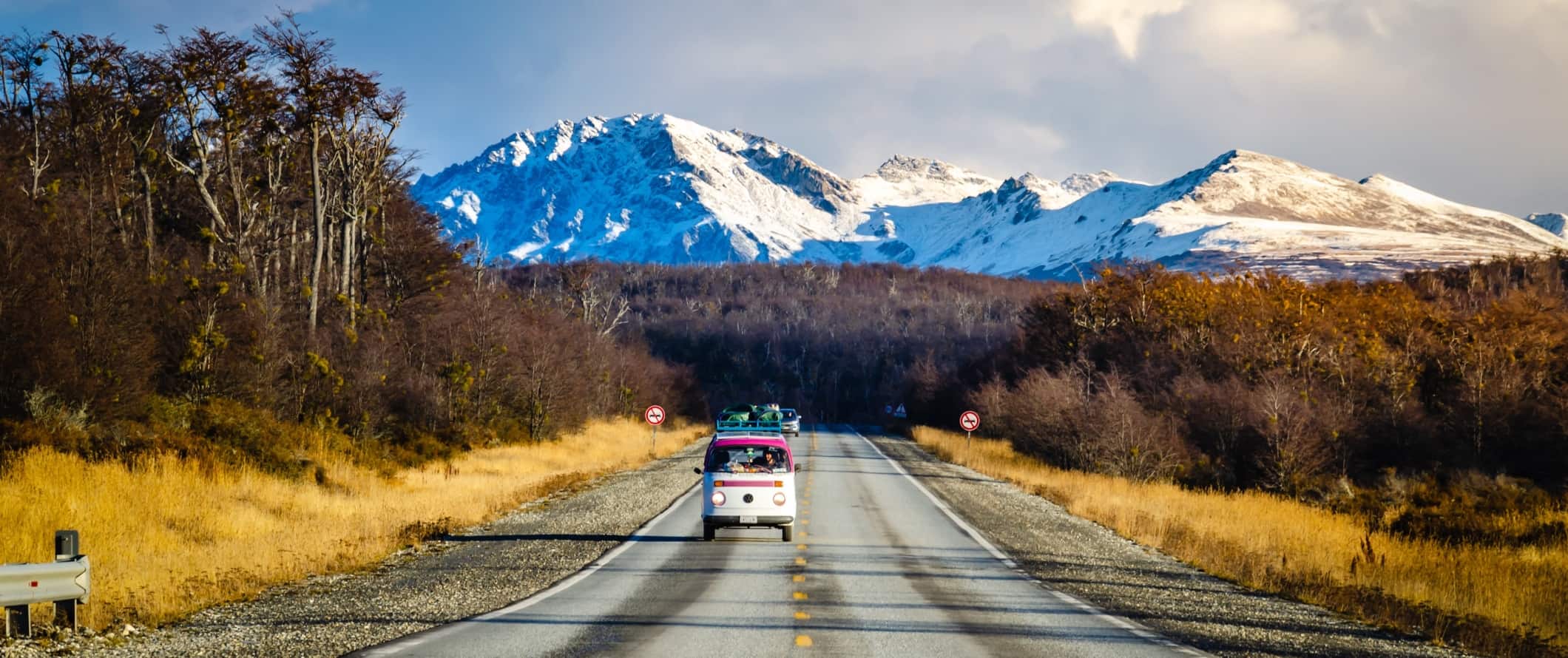
Public transportation – Buenos Aires is the only city in Argentina with a subway system (the Subte). The subway runs from 5:30am-11:30pm on weekdays, 6am-midnight on Saturdays, and 8am-10:30pm on Sundays.
Public buses are the most common way to travel within the cities. In Buenos Aires, a one-way fare is around 1,000 ARS per trip. In Mendoza, fares start at 800 ARS.
In Buenos Aires, Mendoza, and Mar del Plata you need a transit card to use the public transit, while smaller areas take cash. You can find these cards at kiosks all over the place.
Taxis – Taxis are very affordable in Argentina. Prices start around 500 ARS and go up by around 300 ARS per kilometer. That said, public transportation can usually get you anywhere you need to be so you can likely skip the taxis here.
Buses – Argentina boasts an outstanding short and long-distance bus network. It is common to have food served on board as well as Wi-Fi and alcohol on long-distance buses. For example, the ride from Buenos Aires to Mendoza takes about 14.5 hours and tickets begin at 10,000 ARS. A 10-hour trip from Bariloche to El Calafate (in Patagonia) starts from 20,000 ARS, while the bus from Buenos Aires to El Calafate is 50,000 ARS.
A “shorter” journey like Mendoza to Salta in 7 hours costs about 35,000 ARS. You can take the overnight bus and then save on accommodation since you’ll be sleeping on the bus.
To find bus routes and prices, use BusBud .
Flying – Flying around South America isn’t very cheap, and Argentina is no exception as fares are taxed highly for foreigners (it subsidizes cheap fares for residents). However, it might be worth it for you if you’re short on time as those 14-hour bus rides are not an efficient way to travel. Argentina’s two most popular airlines are Aerolíneas Argentinas (the domestic carrier) and LATAM.
You can fly from Buenos Aires to El Calafate for 340,000 ARS return, or Buenos Aires to Bariloche for 190,000 ARS return. You’ll get better deals the further out that you book your tickets.
Train – Argentina’s rail system only goes to three places: Buenos Aires, Cordoba, and Rosario. The train from Buenos Aires to Cordoba costs about 28,400 ARS. There are also train journeys aimed specifically at travelers, like the epic Train to the Clouds that begins in Salta and passes through the Andres. It’s one of the highest railways in the world. There’s also La Trochita, the Old Patagonian Express between Esquel and El Maiten for 30,000 ARS.
Hitchhike – Argentina is easy and safe for hitchhikers. You can find rides throughout the country, and Argentines are naturally curious about foreigners. There’s a good chance you’ll end up crammed into a car with an entire family! Hitchwiki has information on hitchhiking in Argentina if you want to give it a try.
When to Go to Argentina
Argentina is enormous. The best time of year to visit entirely depends on what regions you plan on traveling around.
Argentina’s spring is from September to November. This is one of the best times to visit overall (although it’s still very cold in Patagonia). Average temperatures range from 14°C (57°F) in the center, 8-14°C (46-57°F) in Patagonia, and about 20°C (68°F) in the north.
Summer is from December to February. This is the best season for spending time in the Andean mountains. It’s also the best time to travel to Tierra del Fuego, although there still might be snow. The north is a lot warmer, and Buenos Aires can get hot and sticky. Temperatures can get as high as 26°C (79°F).
Autumn (March-April) is another great time to visit, especially in the San Juan and Mendoza regions for the wine harvests. Temperatures here are 6-14°C (42-58°F). Patagonia is stunning this time of year with its bright autumn colors as well.
Winter is from June to August when temperatures dip to 8–13°C (46–55°F). This is the ideal time to visit if you’re a skier hoping to hit up the ski resorts. It’s not a great time for visiting Patagonia, however; bad weather can leave you stranded, and a lot of places are closed from Easter to October.
How to Stay Safe in Argentina
Argentina is a safe place to backpack and travel. While violent crime here is rare, petty theft and pickpocketing is on the rise so you’ll need to be vigilant. Don’t flaunt expensive jewelry or belongings while you’re out and about and always keep your wallet secure and out of reach. Cell phone theft is incredibly common and thieves sometimes literally snatch the phone right from your hand in broad daylight so be on guard and never bring your phone out in public. If you need to use it, step inside a shop just to be safe.
If taking an overnight bus, lock your bag and make sure your valuables are secure. If you rent a car, always keep it locked and never store anything in it overnight as break-ins can occur.
Female travelers should generally feel safe here, however, the standard precautions apply (don’t walk around at night intoxicated, never leave your drink unattended at the bar, etc.). Whenever possible, avoid walking around at night (especially if you’re alone). Even during the day, it’s best to walk around in groups when you can as you’ll be less of a target that way. If you’re carrying a purse, wear it across your chest so it can’t easily be snatched (a backpack is a better/safer choice, though).
When taking out money from an ATM, make sure to use a machine inside the bank so that you can safely access your money without prying eyes or people ready to rob you.
Scams here are rare, but they can occur. To avoid getting ripped off, read about common travel scams to avoid here .
Always check the weather before you go hiking and make sure you dress appropriately and bring enough water.
If you experience an emergency, dial 911 for assistance.
Always trust your gut instinct. Make copies of your personal documents, including your passport and ID.
The most important piece of advice I can offer is to purchase good travel insurance. Travel insurance will protect you against illness, injury, theft, and cancellations. It’s comprehensive protection in case anything goes wrong. I never go on a trip without it as I’ve had to use it many times in the past. You can use the widget below to find the policy right for you:
Argentina Travel Guide: The Best Booking Resources
These are my favorite companies to use when I travel. They consistently have the best deals, offer world-class customer service and great value, and overall, are better than their competitors. They are the companies I use the most and are always the starting point in my search for travel deals.
- Skyscanner – Skyscanner is my favorite flight search engine. They search small websites and budget airlines that larger search sites tend to miss. They are hands down the number one place to start.
- Hostelworld – This is the best hostel accommodation site out there with the largest inventory, best search interface, and widest availability.
- Booking.com – The best all around booking site that constantly provides the cheapest and lowest rates. They have the widest selection of budget accommodation. In all my tests, they’ve always had the cheapest rates out of all the booking websites.
- Get Your Guide – Get Your Guide is a huge online marketplace for tours and excursions. They have tons of tour options available in cities all around the world, including everything from cooking classes, walking tours, street art lessons, and more!
- SafetyWing – Safety Wing offers convenient and affordable plans tailored to digital nomads and long-term travelers. They have cheap monthly plans, great customer service, and an easy-to-use claims process that makes it perfect for those on the road.
- LifeStraw – My go-to company for reusable water bottles with built-in filters so you can ensure your drinking water is always clean and safe.
- Unbound Merino – They make lightweight, durable, easy-to-clean travel clothing.
- Top Travel Credit Cards – Points are the best way to cut down travel expenses. Here’s my favorite point earning credit cards so you can get free travel!
Argentina Travel Guide: Related Articles
Want more info? Check out all the articles I’ve written on Argentina travel and continue planning your trip:
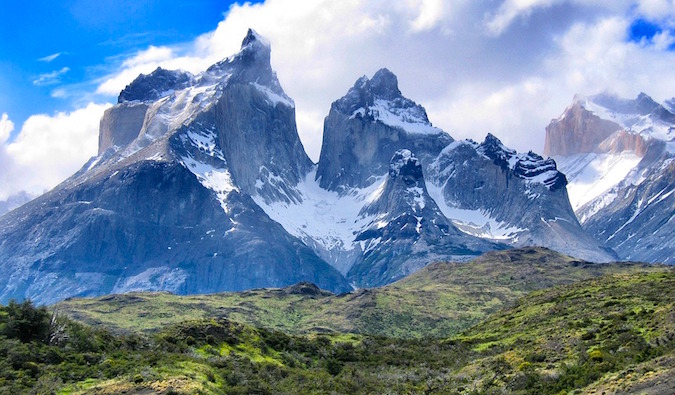
18 of the Best Spots in Patagonia
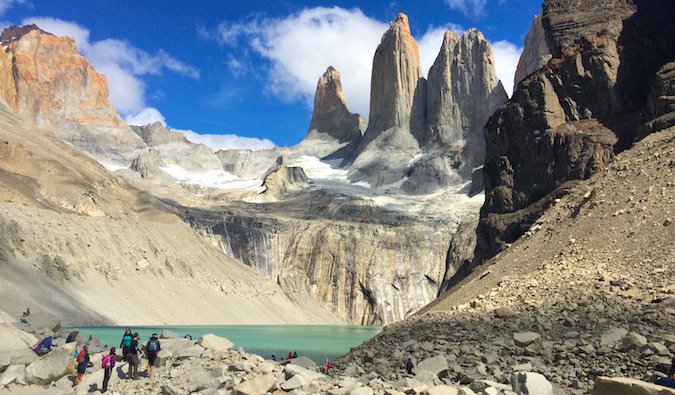
Patagonia: Thoughts on Getting Offline and Trying to Camp
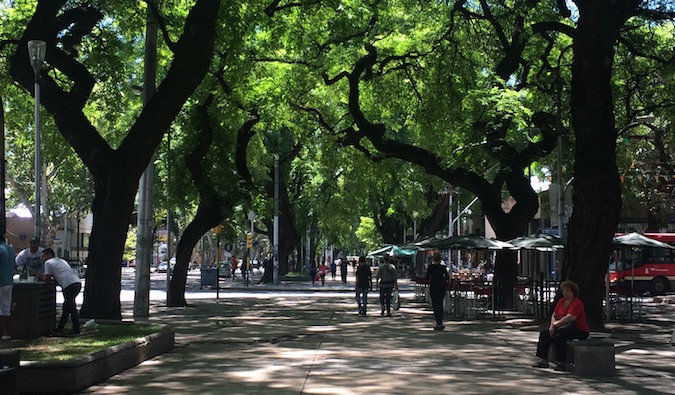
12 Ways to Save Money in Argentina
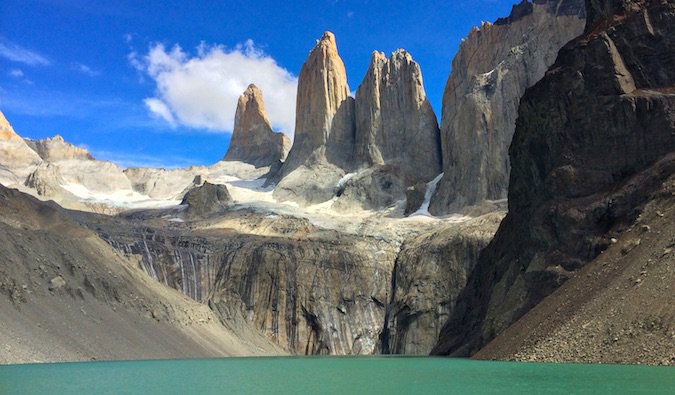
16 Amazing Photos from My Visit to Torres Del Paine
Get my best stuff sent straight to you, pin it on pinterest.
- Where To Stay
- Transportation
- Booking Resources
- Related Blogs

First-hand travel experiences and tips
THE ULTIMATE ARGENTINA TRAVEL GUIDE: ALL YOU NEED TO KNOW

This Argentina travel guide is your essential companion to navigating one of the most diverse South American countries. I gathered in it all the information I have from my experience and I wish I had known before I left for Argentina. Argentina unfolds with a landscape that ranges from the dramatic Patagonian glaciers to the lush Iguazú Falls, and a culture as colorful as its geography. In this comprehensive Argentina travel guide, we highlight the optimal times to explore Argentina, taking into account its vast climatic differences. We’ll guide you through the bustling avenues of Buenos Aires city, where rich history meets urban vibrancy, introduce you to the culinary delights awaiting in local markets, and suggest routes through the wine-soaked hills of Mendoza. Additionally, we provide practical advice on navigating this massive country safely, understanding local customs, and making the most of your travels with suggested itineraries tailored for various durations and interests. From adventure seekers to cultural enthusiasts, this guide equips you with the knowledge to fully experience Argentina’s unique attractions and hidden gems.

Table of Contents
Argentina Travel: Basic Facts To Have In Mind
- Where is Argentina? Argentina is in South America. It is in the southern hemisphere so the seasons are the opposite of those in the northern hemisphere.
- Size of Argentina Argentina is the world’s eighth-largest country with an area of 2 780 400 sq. km. It ranks as the second largest country in South America.
- Population of Argentina The country has more than 47 million inhabitants and 30% of them live in the metropolitan area of Buenos Aires.
- Capital of Argentina The capital is the city of Buenos Aires, often referred to as CABA (Ciudad Autonoma de Buenos Aires). The urban population is more than 3 million people.
- Argentina Currency The currency of Argentina is Argentine Peso (ARS). Money is a mess in Argentina, so be sure to read the Money section of this Argentina travel guide carefully.
- Religion Mainly Christian.
- Language Spanish is the official language. In Buenos Aires, many people speak English which is not the case outside of the capital even in tourism-related businesses. Some basic Spanish can make all the difference.
- LGBT Argentina is the most LGBT-friendly country in Latin America.
Best Time to Visit Argentina
Seasons and climate variations across different regions.
Argentina’s vast expanse means the country experiences a wide range of climate zones, making any time of year ideal for a visit, depending on your destination and interests.
- Best time to travel to Patagonia : The Southern Hemisphere’s summer months, from December to February, are a great time for exploring Patagonia when the weather is mildest and hiking trails are most accessible. Winter, from June to August, sees this region transform into a snowy wonderland, perfect for skiing but many areas become less accessible.
- Best time to visit Buenos Aires : Spring (September to November) and autumn (March to May) offer pleasant temperatures and fewer crowds, ideal for exploring the city’s outdoor attractions and vibrant street life.
- Iguazu Falls : The falls are most impressive during the rainy season from November to March, but these months can also be quite hot and humid. Cooler, drier weather from April to October makes for a more comfortable visit, though the water flow might be less dramatic.
Special Events and Festivals
Argentina’s calendar is dotted with festivals that celebrate its rich culture and traditions, providing travelers with unique experiences.
- Carnaval : Taking place in late February or early March, Carnaval is celebrated with parades, music, and dancing, especially vibrant in the northern provinces like Jujuy and Corrientes.
- Tango Festival : Buenos Aires comes alive with the Tango Festival and World Championship in August, attracting dancers and spectators from around the globe to enjoy performances, classes, and milongas (tango dance events).
Planning your visit around these climatic patterns and cultural events can enhance your Argentine adventure, offering a deeper connection to the places you explore and the people you meet. Whether you’re trekking through Patagonia, soaking in the urban culture of Buenos Aires, or marveling at the natural spectacle of Iguazu Falls, understanding the best time to visit each region ensures a journey filled with memorable experiences.
Regions of Argentina
Argentina’s vast territory is segmented into distinct regions, each offering unique landscapes, attractions, and experiences. Here’s a closer look at four key regions: Patagonia, Buenos Aires, Mendoza, and Misiones, highlighting what each is famed for and the must-visit sites within them.
Patagonia: A Haven for Nature Enthusiasts

Patagonia, stretching across the southern tip of South America, is a region of unparalleled natural beauty, known for its dramatic landscapes that include glaciers, mountains, and wildlife-rich forests. Wildlife observation is exceptional here, with opportunities to see penguins, dolphins, whales, and guanacos in their natural habitats.
- Beagle Channel and Tierra del Fuego National Park : This strait in the Tierra del Fuego Archipelago offers breathtaking boat tours that provide views of remote islands, marine wildlife like seals and penguins, and the legendary lighthouse at the end of the world.
- Torres del Paine National Park (Chile) is a hotspot for trekking with its iconic granite peaks.
- Los Glaciares National Park : Home to the majestic Perito Moreno Glacier, this park is a UNESCO World Heritage site and a must-visit for its awe-inspiring ice formations and opportunities for glacier trekking.
Buenos Aires: The Paris of South America

Argentina’s capital city is a vibrant metropolis known for its European-style architecture, tango, and rich cultural life.
Where To Stay In Buenos Aires: Best Areas & Hotels
- Palermo : Known for its trendy boutiques, lush parks, and vibrant nightlife, Palermo is the go-to district for those seeking a blend of leisure and style. It’s a haven for foodies, art enthusiasts, and shoppers alike.
- Recoleta : This upscale neighborhood is famous for its Parisian-style buildings, the renowned Recoleta Cemetery, and cultural institutions. It’s a place where history and luxury meet, offering visitors a glimpse into the city’s opulent past.
- San Telmo : Characterized by its cobblestone streets and colonial buildings, San Telmo is the heart of Buenos Aires’ bohemian culture. It’s best known for its Sunday market, where antiques, artisanal crafts, and street performers abound.
- La Boca : Vibrantly colored houses and the iconic Caminito street make La Boca neighborhood a must-visit. This neighborhood is steeped in art and history, offering a lively atmosphere that’s quintessentially Argentine.
- Puerto Madero : Once a port area, Puerto Madero has transformed into one of Buenos Aires’ most modern districts. Its waterfront is lined with upscale restaurants, chic bars, and sleek skyscrapers, offering stunning views of the Rio de la Plata.
- El Ateneo Grand Splendid : Arguably the world’s most beautiful bookstore, El Ateneo is housed in a converted theater, where books line the former auditorium, and a café sits on the stage, inviting visitors to linger over a coffee and a good read.
- Teatro Colon : An architectural masterpiece, the Teatro Colon is one of the most prestigious opera houses globally. Its interiors are as magnificent as the performances, making it a top cultural site.
- Palacio Barolo : Inspired by Dante’s Divine Comedy, Palacio Barolo is a stunning example of early 20th-century architecture. Tours offer insights into its unique design and panoramic city views from its lighthouse.
- Street Markets : Buenos Aires’ street markets, like the Feria de San Telmo and the Mataderos Fair, are hubs of culture, cuisine, and crafts, reflecting the city’s diverse heritage and vibrant community life.
- Notable Bars and Cafes : The city’s café culture is legendary, with historic cafés like Café Tortoni and La Biela offering a window into Buenos Aires’ soul. These spots are not just about coffee but are institutions reflecting the city’s literary, artistic, and social history. Buenos Aires is a city that captivates with its mix of cultural richness, historical depth, and contemporary flair. Each neighborhood tells a part of the city’s story and hides places often kept unknown to tourists . From its European roots to its cosmopolitan present, Buenos Aires is an essential destination for anyone exploring Argentina.

Mendoza: A Paradise for Wine Lovers
Located at the foot of the Andes, Mendoza is Argentina’s most famous wine region, celebrated for its Malbecs and other fine wines. Beyond vineyard tours and wine tasting, Mendoza offers outdoor adventures like hiking, horseback riding, and white-water rafting against the backdrop of stunning mountain scenery.
The Misiones region: Home To The Iguazu Falls

Located in Argentina’s northeastern tip, Misiones is an ideal destination for those seeking to explore the intersection of natural beauty and cultural depth in Argentina. It stands out for its lush rainforests, distinctive red soil, and the majestic Iguazu Falls.
- Iguazu Falls stands as one of the natural wonders of the world, located on the border between Argentina and Brazil. This magnificent cascade system is one of the most breathtaking sights in South America, drawing visitors from all corners of the globe.
- Jesuit Missions of the Guaranis – UNESCO World Heritage sites that offer insight into the area’s historical significance.
Each of these regions presents a different facet of Argentina’s diverse character. From the icy wonders of Patagonia and the cultural diversity of Buenos Aires to the vine-covered valleys of Mendoza, Argentina offers myriad experiences tailored to nature lovers, culture enthusiasts, and gastronomy aficionados alike. Exploring these regions provides a comprehensive insight into the natural beauty and cultural richness that make Argentina a unique and compelling destination.
Cultural Experiences in Argentina

Delving into Argentina’s cultural heritage, you can immerse yourself in a variety of experiences that highlight the country’s traditions, culinary heritage, and artistic prowess. From the passionate dance of tango to the rich flavors of its cuisine and the vibrant array of local markets, Argentina offers a depth of cultural encounters.
- Tango Show and Lessons The tango is not just a dance in Argentina; it’s an expression of history, emotion, and culture. Buenos Aires, the tango’s birthplace, hosts numerous shows in historic theaters and intimate clubs, showcasing the captivating dance. If you are tempted to learn, tango lessons are available for all levels, offering a hands-on way to connect with this integral part of Argentine culture.
- Argentine Cuisine: Asado, Empanadas, Mate Argentine cuisine reflects the country’s agricultural bounty, with asado (barbecue) at its heart. This culinary tradition involves social gatherings around a grill to enjoy various types of meat. Empanadas, with their flaky crusts and savory fillings, are a staple, perfect for any meal. Mate, an herbal tea, is a symbol of community and friendship, shared from a single cup and straw.
- Local Markets and Crafts Argentina’s local markets offer a glimpse into the country’s artisanal heritage. These markets are hubs for handcrafted goods and artisanal crafts, ranging from leather products to handmade jewelry and woven textiles. They’re not only places to shop but also spaces to engage with local artisans and learn about the craftsmanship behind their creations.

Travel Tips and Practical Information for Argentina
Visa requirements .
Before planning your trip to Argentina, it’s crucial to check the latest visa requirements. Visitors from many countries can enter Argentina without a visa for short stays, typically up to 90 days, for tourism purposes. However, regulations can change, so it’s advisable to consult the official website of the Argentine embassy or consulate in your country for the most current information. Ensure your passport is valid for at least six months beyond your planned date of departure from Argentina.
Transportation within Argentina
Argentina’s vastness makes it important to plan your internal travel well. The best way to travel around is by taking domestic flights . The country boasts an extensive network of domestic flights connecting major cities and tourist destinations, making air travel a convenient option for covering long distances quickly. Aerolíneas Argentinas , the national carrier, along with several low-cost airlines, offer various routes.
For those seeking a more scenic journey, Argentina’s bus network is comprehensive and relatively affordable, connecting virtually every corner of the country. Long-distance buses, or “colectivos,” offer various service levels, including comfortable sleeper options for overnight journeys.
Train services are limited but can provide a scenic and leisurely travel alternative for certain routes.
Currency, credit cards and ATMs

Money in Argentina is a bit of a mess so pay special attention to this part of this Argentina travel guide . You will see Argentine currency of the same denomination with different appearances. They are not counterfeit. They are all in use.
The Argentinian Peso Exchange Rates
The value of the Argentinian peso is different depending on the different exchange rates .
- The Official Argentine peso exchange rate or Bank rate is used by banks, ATMs, and exchange offices. It is also used by hotels, so if you exchange dollars to Argentine peso at the blue rate , you will pay for your accommodation half the price.
- The blue dollar rate is not official, although you can find the Blue Dollar rate published daily in newspapers and online . It is almost double the official rate. Find out how to get the blue dollar rate in Argentina .
- The MEP rate . When paying with a foreign VISA or Mastercard, your credit card will be charged at a rate close to the Blue Dollar rate, with a difference of 5-15%. The difference depends on the country and the bank where your card was issued. Visa will charge your card at the Credit Card rate at the time of the transaction while Mastercard will charge your card at the official exchange rate and credit your account with the difference a few days later. As of March 2023, MEP rate did not apply to Amex credit card payments.
Are credit cards widely accepted in Argentina?
Credit cards are widely accepted in cities and tourist areas, but it’s wise to carry some cash for smaller transactions, especially in remote regions. Most hotels, restaurants, supermarkets, and travel agencies accept VISA and Mastercard although some merchants may offer you a 15-20% discount if you pay in cash.
ATMs in Argentina
ATMs are available, but withdrawal limits may be low and fees relatively high.
A “$” price tag: what does it mean?
I often saw price tags that started with a $ sign. At first, I almost had a heart attack. Well, such tags do NOT mean US dollars. ‘$100’ means 100 Argentine pesos. If the price is in US dollars, the price tag will look like ‘US$100’.
In theory, any purchase over 70 pesos (a few cents!) that foreign visitors take out of the country entitles them to a VAT refund at customs. During my traveling around the country, I didn’t see a single store with the Tax-Free logo. Those I asked about it said they didn’t issue the required Tax-Free form.
Is Argentina expensive for tourists?
Definitely not. Exchanging money at the Blue Dollar rate makes your Argentina travel affordable, if not cheap.
Tipping in Argentina
Tipping is customary in Argentina, with 10% considered standard in restaurants. It’s also appreciated to tip small amounts to luggage handlers and taxi drivers. In bars and cafes, rounding up the bill is a common practice.
Accommodation Guide for Argentina

Finding the perfect place to stay is crucial for a memorable trip to Argentina. This accommodation guide covers options for every budget, from cozy hostels to luxury hotels, alongside practical booking tips and location advice.
Recommendations for All Budgets
- Hostels : Ideal for budget travelers and solo adventurers, hostels in Argentina offer not only affordable lodging but also a vibrant social atmosphere. Major cities like Buenos Aires, Mendoza, and Bariloche boast a wide range of hostels, many offering communal kitchens, free Wi-Fi, and organized social events. Look for hostels in central areas or close to public transportation to maximize convenience.
- Hotels : Argentina’s hotels cater to a broad spectrum of preferences and budgets. In urban centers, you can find everything from international chains to local boutique hotels, each offering different levels of amenities and service. For a deeper dive into Argentine culture, consider staying in a family-run hotel where personalized service is the norm.
- Boutique Accommodations : For those seeking a unique or high-end experience, Argentina’s boutique accommodations merge comfort with character. These properties often reflect their local environment, offering guests a more intimate and tailored stay. From restored colonial houses in Salta to luxury lodges in Patagonia, boutique accommodations are perfect for travelers looking to immerse themselves in their surroundings.
Tips for Booking and Locations
- Book in Advance : Especially during peak seasons (summer in Patagonia, winter in ski resorts, and major holidays), booking your accommodation well in advance is advisable to secure the best rates and availability.
- Location Matters : Consider your itinerary and activities when choosing your accommodation. Staying centrally might be more expensive, but it can save you time and money on transportation. Conversely, staying a bit further out can offer a more authentic and quieter experience, often at a lower cost.
- Check Reviews : Utilize online review platforms to gauge the quality and reliability of accommodations. Pay attention to comments about cleanliness, safety, and the helpfulness of the staff.
- Consider Alternatives : Besides traditional accommodations, Argentina offers a range of alternative lodging options such as estancias (ranches), Airbnb rentals, and camping in national parks. These alternatives can provide a unique perspective on the local lifestyle and landscapes.
- Avoid high season : Accommodation prices can get much higher in peak season.
By considering these factors and exploring the diverse lodging options available, you can find the perfect base for your adventures in Argentina, whether you’re exploring the urban landscape of Buenos Aires or the natural wonders of Patagonia.

Safety and Etiquette in Argentina
Safety tips for travelers .
Ensuring a safe travel experience in Argentina involves being aware of your surroundings and taking common sense precautions. Major cities, while generally safe, do require visitors to be vigilant against pickpocketing and petty theft, especially in crowded areas and tourist hotspots. It’s advisable to use official taxi services or reputable ride-sharing apps to avoid scams. When exploring, keep valuables secure and out of sight. I saw many tourists wearing their backpacks on the front of their bodies. I strongly discourage you from doing this. After all, it is like wearing a cartel that says: “I’m a tourist”. So whenever you can, try to look like and act like a local. Emergency services in Argentina can be reached by dialing 911 in major cities, a number good to have on hand.
Cultural Norms and Etiquette in Argentina
Understanding and respecting local customs is key to a harmonious visit. Greetings in Argentina are warm and personal, often involving a handshake or a cheek kiss (un beso) in more familiar settings. Punctuality is flexible, with social events often starting later than the scheduled time. When invited to an Argentine home, bringing a small gift like wine or sweets is a thoughtful gesture. Dining etiquette in Argentina is fairly relaxed, but it’s polite to wait for the host to start the meal. Tipping is customary, with 10% being the norm in restaurants.
Language and Communication
Spanish is the official language of Argentina, and while English is widely understood in major tourist areas, learning a few basic Spanish phrases can greatly enhance your travel experience. Common phrases like “por favor” (please) and “gracias” (thank you) are appreciated and can open doors to more engaging interactions with locals.
Connectivity
Argentina has a good network of mobile operators, and Wi-Fi is readily available in hotels, cafes, and public spaces, making communication relatively easy for travelers. During my recent trip to Argentina, I didn’t want to solely rely on the free Wi-Fi provided by hotels, restaurants, and other establishments. I considered the possibility of emergency situations, needing to hail a taxi or Uber on the go, or simply using Google Maps. To ensure that I have access to reliable internet at all times, I always purchase a local SIM card or an e-SIM card wherever I travel. And Argentina made no exception. Purchasing a local SIM card is easy and affordable.
By keeping these safety tips and cultural insights in mind, travelers can navigate Argentina with confidence and respect, ensuring a fulfilling and respectful visit to this vibrant South American country.

Itineraries for Exploring Argentina
Suggested itineraries for different lengths of stay.
- 1 Week : For a seven-day adventure, focus on a specific region to immerse yourself deeply rather than trying to cover too much ground. Buenos Aires, with day trips to the nearby Delta del Tigre or the historic city of Colonia in Uruguay (via ferry), offers a rich mix of culture, history, and cuisine. Alternatively, dedicate your week to exploring Patagonia, starting in El Calafate for the Perito Moreno Glacier, and then traveling to Ushuaia for the Beagle Channel and Tierra del Fuego National Park.
- 2 Weeks : With two weeks, you can explore more than one region. Begin in Buenos Aires for a few days of culture and cuisine, then fly to Iguazu Falls for 2-3 days of natural wonder. Next, head to Mendoza to indulge in wine country and the beauty of the Andes. This itinerary balances city life, natural landscapes, and culinary delights, showcasing Argentina’s diversity.
- 1 Month : A month allows for a comprehensive exploration of Argentina. Start in the north, visiting Salta and Jujuy for colorful mountains and indigenous cultures. Work your way through the country’s heartland to Buenos Aires and on to Patagonia, spending time in both El Calafate and Ushuaia, the southernmost city in the world. Cap off your journey with a visit to the wine regions around Mendoza and the Cordoba hills for a taste of Argentina’s rural charm and tranquility.
Tips for Creating a Flexible Travel Plan
- Book in Advance : For popular destinations like Iguazu Falls and Patagonia, booking accommodations and certain activities in advance is crucial, especially during peak season.
- Stay Flexible : While it’s important to have a plan, Argentina’s vast distances and varied transport options mean that weather, seasonal events, or strikes can affect travel plans. Have buffer days for long-distance travel and consider alternative destinations or activities.
- Embrace Local Advice : Locals and fellow travelers are invaluable resources for discovering hidden gems and navigating travel hiccups. Be open to adjusting your itinerary based on recommendations.
- Consider Transport Options : Domestic flights are efficient for covering long distances, but buses in Argentina are a comfortable and scenic way to see the country, often offering lie-flat seats on longer routes.
Crafting an itinerary for Argentina involves balancing ambitious exploration with the practicalities of travel time and distances. Whether you have a week, two weeks, or a month, Argentina offers a wealth of experiences that cater to all interests, from the urban sophistication of Buenos Aires to the raw natural beauty of Patagonia and the rich cultural tapestry of the north.
Conclusion: Discover the Diversity of Argentina
Argentina is a land of breathtaking contrasts and diverse experiences, a country where every traveler can find their heart’s desire. From the vibrant streets of Buenos Aires, brimming with culture and history, to the majestic landscapes of Patagonia, offering adventure in its purest form, Argentina promises a journey of discovery. The thunderous power of Iguazu Falls, the serene beauty of the wine country in Mendoza, and the rich cultural heritage of the north invite exploration and wonder.
This Argentina travel guide has aimed to equip you with the essential information, practical tips, and suggested itineraries to navigate Argentina’s vast offerings. Whether you’re drawn to its natural wonders, intrigued by its cultural depth, or tempted by its culinary delights, Argentina offers a unique blend of experiences that resonate long after your visit.
We encourage you to explore Argentina, to immerse yourself in its landscapes, to engage with its people, and to savor the flavors and rhythms that make this country unforgettable. Every corner of Argentina has a story to tell, a new experience to offer, and an adventure to embark upon. Let Argentina be your next destination, and discover the endless possibilities that await in this vibrant and soulful country.
Have you read the whole post? You can now plan your independent travel to Argentina all by yourself. Start by booking your plane tickets . Haven’t decided yet? Pin for later.

Click here to download the Argentina Cheat Sheet Printable and enjoy your Argentina trip.
I hope you have found my Argentina Travel Guide for 2024 helpful. Share it on social media. It may help someone else plan their independent Argentina travel.
You may also be interested in:
- 21 Epic Things to Do in Ushuaia: 2024 Ultimate Guide
- Blu e Dollar Rate in Argentina: Ultimate 2024 Info
- 11 GREAT BUENOS AIRES ATTRACTIONS FOR YOUR MUST SEE LIST
- HOW TO VISIT USHUAIA – THE END OF THE WORLD
- GREATEST EXPERIENCES IN USHUAIA: END OF THE WORLD

View all posts
2 thoughts on “THE ULTIMATE ARGENTINA TRAVEL GUIDE: ALL YOU NEED TO KNOW”
Thank you for this guide. Argentina has been on my bucket list for a long time. I’m surprised that they drink tea and not coffee, because many Argentinians have Italian ancestry.

As a coffee addict I was unpleasantly surprised too, but that’s what it is. Otherwise Argentina exceeded my expectations. I would gladly return any time.
Comments are closed.

TRAVEL to ARGENTINA – Tips and Information Guide
Argentina is not just famous for its football, National Parks such as Tierra del Fuego and Los Glaciares remain to be some of the most pristine places on earth. Thinking of going to Argentina for 1 to 2 weeks? You might want to think longer once you find out just how epic this place is!
From the streets of Buenos Aires, you will find yourself immersed in the world of Jazz and Blues music or head to a local restaurant to indulge in empanadas or why not a steak accompanied by a glass of Malbec red!
Argentina is a place of natural beauty from the Andean Northwest’s coloured desert canyons to the world-famous Fitzroy Range. Where ever you wander, there’s a good chance you will visit at least one national park while in Argentina, and don’t worry if you can’t do them all in one visit, you’ll just have to book that flight back.
Argentina Travel Guide
When you start planning to travel to Argentina, it’s handy to do a bit of research before you go. Check out our Argentina travel guide to help set prepare you for the land of tango and wine!
General Info
Here’s some general information about Argentina.
- Capital: Buenos Aires
- Other Cities: Mendoza, Ushuaia, Cordoba
- Currency: Argentine Peso
- Language: Spanish
- Population: 43,717,000
- Area: 2,777,815 sq. km
5 Interesting Facts About Argentina
- Lionel Messi is regarded as one of the best footballers in the world, and from Argentina!
- Argentinians barely eat breakfast! So you’ll just have to wait till lunch to feast!
- ‘Mate ’ (pronounced mah-tay ) is a drink comprised of chopped leaves from a special plant where family and friends gather for a ritual based on sharing.
- Che Guevara born in Rosario, Argentina, 1928 is the most famous of revolutionaries ever to live. He assisted Fidel Castro win back Cuba in 1959 followed by a spur of attempts to liberate South America.
- Ushuaia is the gate way to Antarctica! It’s very possible to book yourself and cruise to the edge of the earth.
Best Time To Travel To Argentina
- For Buenos Aires and the vineyards, September to November for spring weather, otherwise March till May for that perfect temperature.
- Trekking in Patagonia is best done in summer to avoid freezing temperatures while snow sports are best off in winter.
Top 5 Places To Visit In Argentina
- Patagonia , by far the number one place to go in Argentina. Patagonia occupies a very big area, so heading over to Chile to see El Chaten and Mount Fitzroy are musts!
- Iguazu Falls isn’t just a spectacular waterfall, Parque Nacional Iguazu hosts exotic birds and lush subtropical rainforests
- Tierra del Fuego otherwise known as the ‘end of the world’. Head down to Ushuaia where glaciers thrive and mountains pierce the sky
- Perito Moreno Glacier is a combination of mountains, lakes with a stunning glacier filling the foreground. A must visit while in Argentina!
- General Carrera Lake located near Patagonia where The Andes dominate the landscape. A must see is a series of ancient marble caves, carved by continuous wave action over a period of 6,000 years.
Top 5 Experiences In Argentina
- Climbing Aconcagua. Head to Mendoza to begin preparations for climbing the highest peak in the Western Hemisphere. Aconcagua stands at 6,960 metres.
- Witnessing a football game between Boca Juniors and River Plate in Buenos Aires! Argentinians are deeply involved in football so why not go join the crowds!
- The Andean Northwest lays close to the Andes where desert canyons, archaeological sites can be found. Colonial architecture is also a common feature in this area. So why not get the bus from Buenos Aires for an epic road trip!
- Parque Nacional Glaciares hosts the stunning Fitzroy Range which is literally one of the most beautiful places in the world to hike!
- Peninsula Valdes is quite possibly one of the most epic locations in Argentina to spot whales, elephant seals, penguins to grey foxes. Definitely worth the journey!
Read Our Argentina Posts
Backpacking in patagonia – ultimate travel guide [2024], 8 awesome things to do in puerto madryn, argentina, hiking in patagonia – the ultimate guide to the best treks, the ultimate guide to visiting perito moreno glacier (2024), the perfect 3 days in buenos aires itinerary [2024], getting a brazil visa in buenos aires, ushuaia – chilling at the end of the world, overlanding argentina – buenos aires to ushuaia by bus, our next travel plans – we’re off to south america, iguazu falls – a new natural wonder of the world.

Argentina Travel Guide
Looking for an in-depth Argentina travel guide ?
Then you’re in the right place!
Start researching a trip to Argentina and you’ll quickly realize that this South American nation is one of the coolest destinations on the planet.
From its incredibly diverse environment to its vibrant cities to its delicious cuisine, there’s so much to explore in Argentina. So much, in fact, that you might not know where to start. Whether you want to tango the night away in a Buenos Aires nightclub or explore the glaciers of Patagonia, we’re here to help you plan the ultimate Argentinian adventure.
Outdoor adventurers from around the world flock to Argentina to revel in the country’s natural beauty. The country has a robust network of national parks, offering visitors the opportunity to explore Argentina’s deserts, mountains, glaciers, lakes, and more.
One of the most famous parks is Los Glaciares National Park, located southwest of Santa Cruz Provence. The park is home to many glaciers making up portions of the Southern Patagonian Ice Field, including Perito Moreno Glacier, one of the largest in the world.
Can’t stand the cold? Head to the Argentine Lake District, a gorgeous area full of picturesque mountains, greenery and, of course, lakes. Whether you’re hiking the hills or exploring nearby towns like Bariloche , you’re bound to have a relaxing time.
And if you’re a night owl, head to San Juan in west-central Argentina for some exceptional stargazing. At El Leoncito National Park, you can marvel at the stars under a clear night sky or get a closer look at the park’s observatory, which hosts tons of stargazing events throughout the year.
Argentina is also home to one of the best wine regions in Latin America; in fact, the country is actually the fifth biggest producer of wine in the world behind Italy.
Mendoza is widely considered Argentina’s “wine country” and has plenty to entertain any kind of wine enthusiast. The area is home to tons of wineries offering tastings, tours, and more to give you a behind-the-scenes look at the country’s wine industry.
Beyond the vineyards, the area is absolutely beautiful. It’s worth renting a bike for a self-guided tour of the region’s lush hills and farms.
And of course, you’ll find great wine wherever you go in Argentina, as well as delicious traditional dishes like empanadas , asado, provoleta, and more.
Keep reading to dive into resources that will help you with planning a trip to Argentina in South America.
Note: This ultimate guide to Argentina travel contains affiliate links to trusted partners!

Argentina Map
Use this Argentina travel map to begin planning your trip to this incredible country!
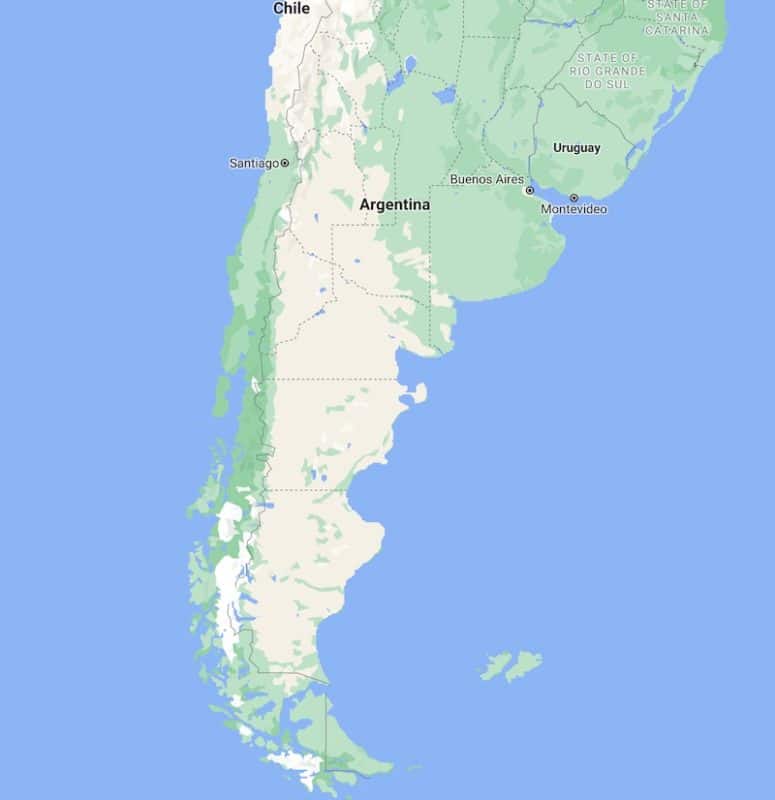
Click here for an interactive Google Map version of the above graphic.
Argentina Travel Tips
This advice can help you with planning a trip to Argentina !
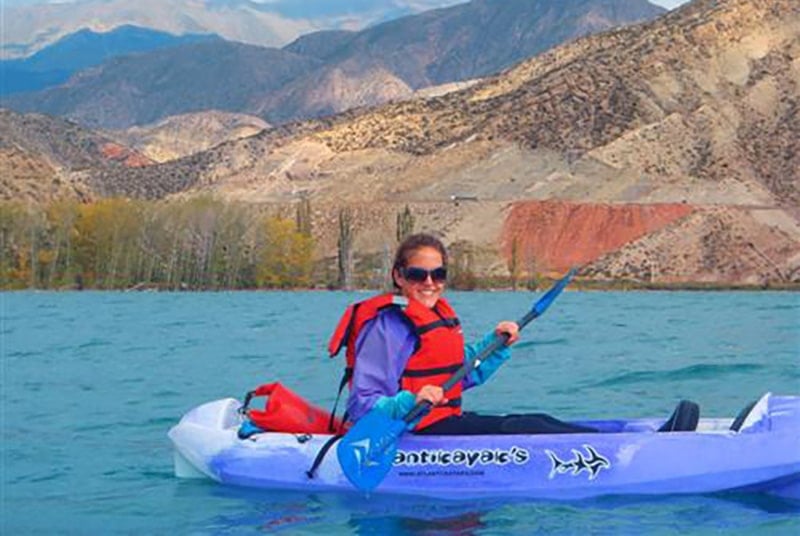
10 Ways Argentina Surprised Me
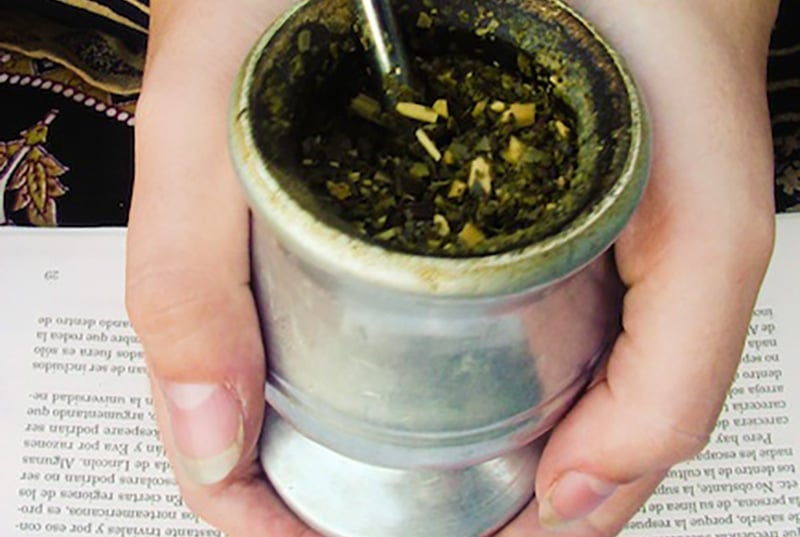
Making Connections Through Mate Drinking In Argentina
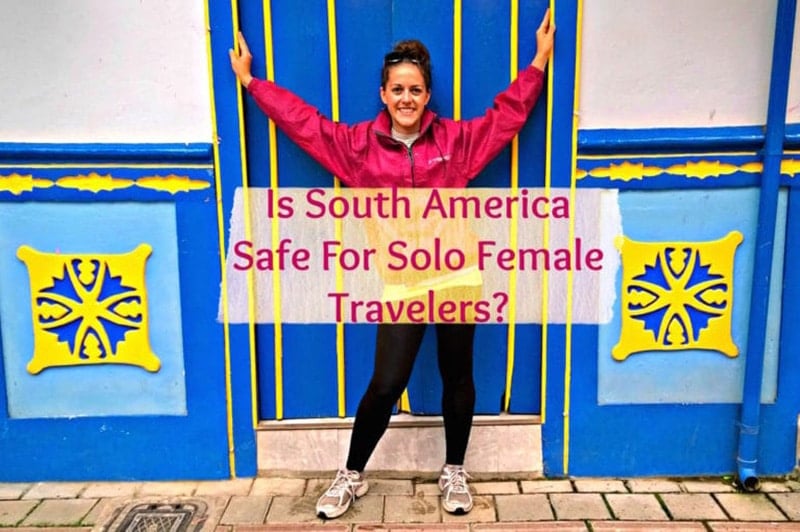
Is South America Safe For Solo Female Travelers?
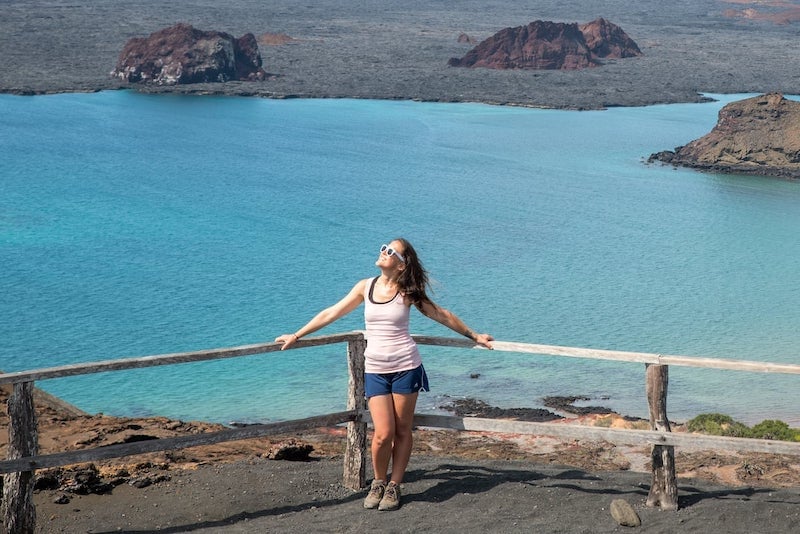
21 Best Places For Solo Travel In South America
Buenos Aires Travel Guide
Use the following posts as a Buenos Aires visitor’s guide !

How To Explore Beautiful Buenos Aires Beyond The Guidebook
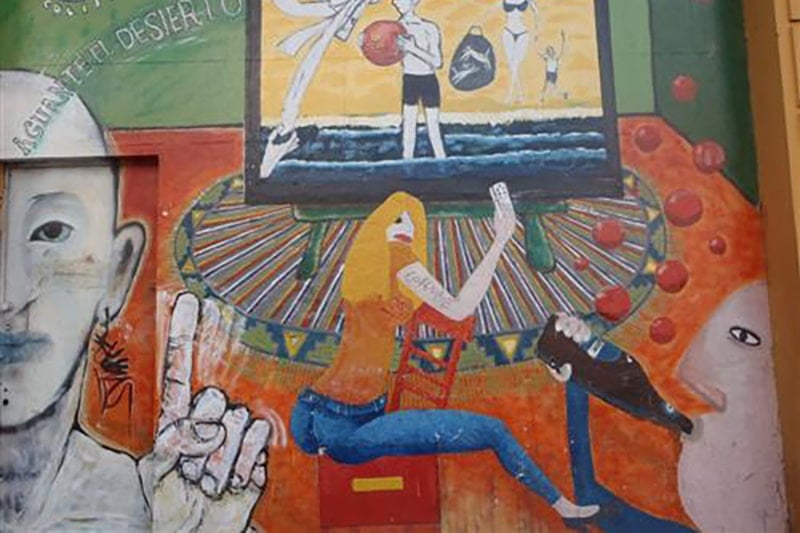
24 Hours In Buenos Aires, Argentina

Ordering Coffee Like A Local At Buenos Aires’ Oldest Cafe
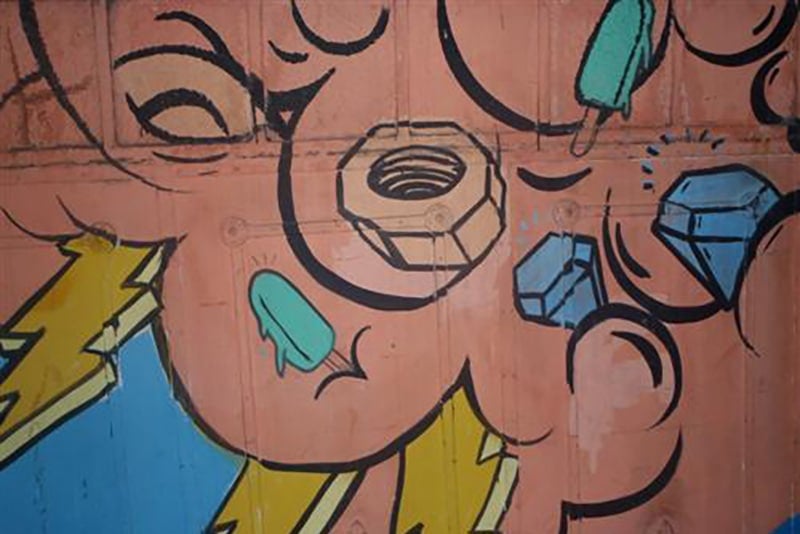
Review Of Art Factory Hostel In Buenos Aires, Argentina
Mendoza Travel Guide
These Mendoza guides will help you have a memorable Argentina vacation!

Review of Hostel Mora In Mendoza, Argentina
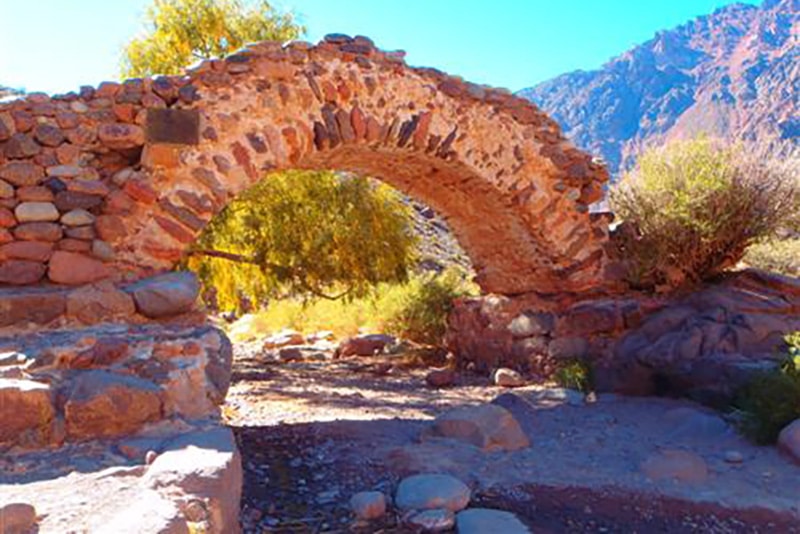
An Epic Mendoza Day Trip Exploring The Andes Mountains
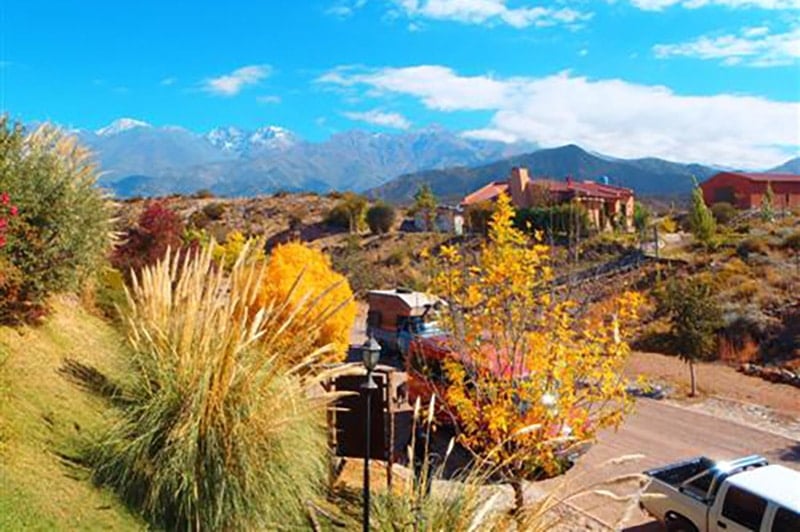
Visiting Potrerillos: An Adventurous Day Trip From Mendoza, Argentina
Patagonia Travel Guide
Plan an epic trip to Patagonia, one of the best Argentina travel destinations !
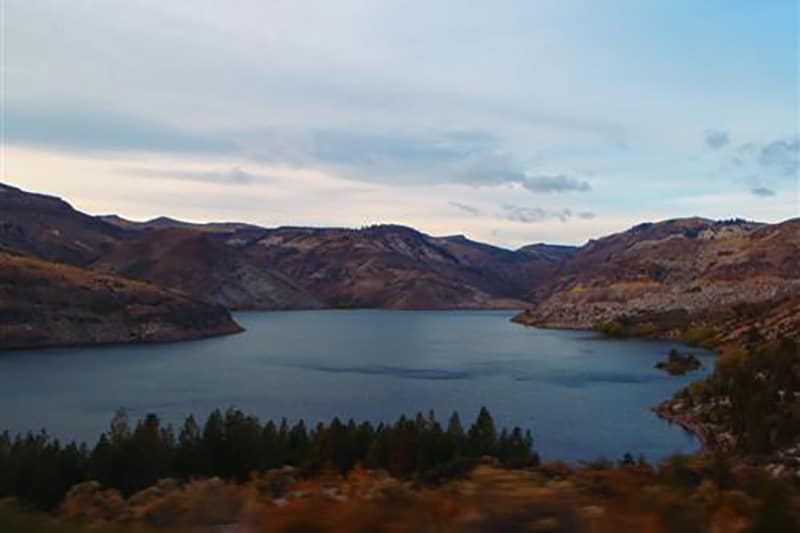
24 Hours In Bariloche, Argentina
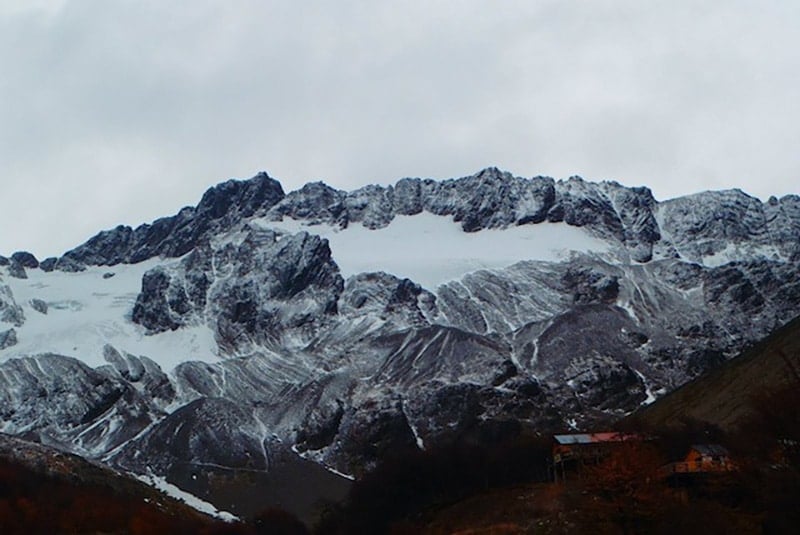
Free Adventures In Patagonia: Trekking Martial Glacier In Ushuaia

Valle de Lobos: A Budget-Friendly Hiking Alternative To Tierra del Fuego In Ushuaia, Argentina
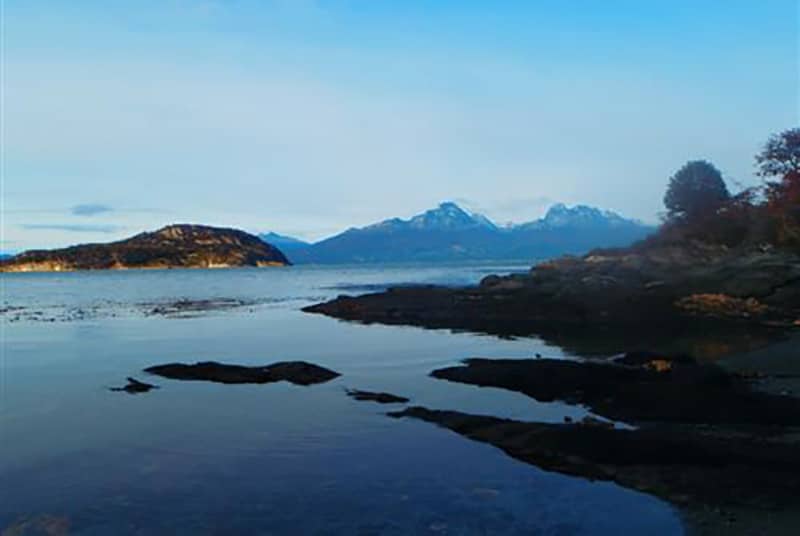
Review Of Cruz del Sur Independent Hostel In Ushuaia, Argentina
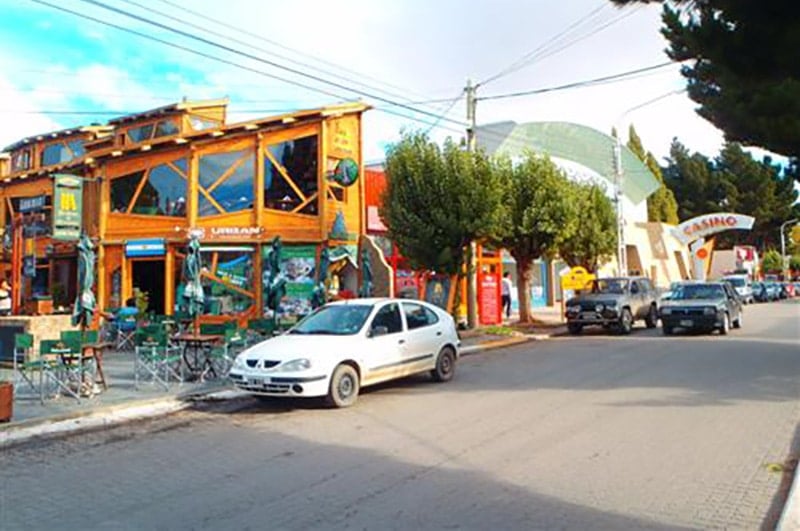
Review Of Hospedaje Lautaro Hostel In El Calafate, Argentina
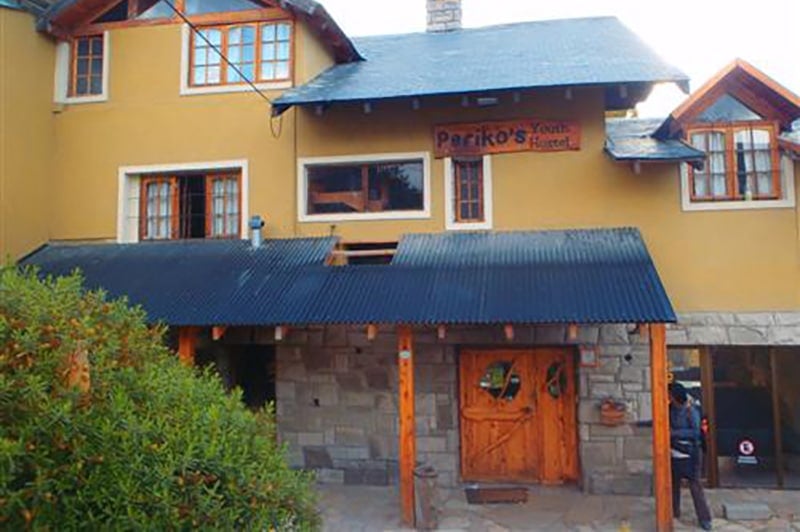
Review Of Periko’s Youth Hostel In Bariloche, Argentina
Other Argentina Travel Guide Destinations
These Argentina tourism guide posts will help you plan an incredible trip!
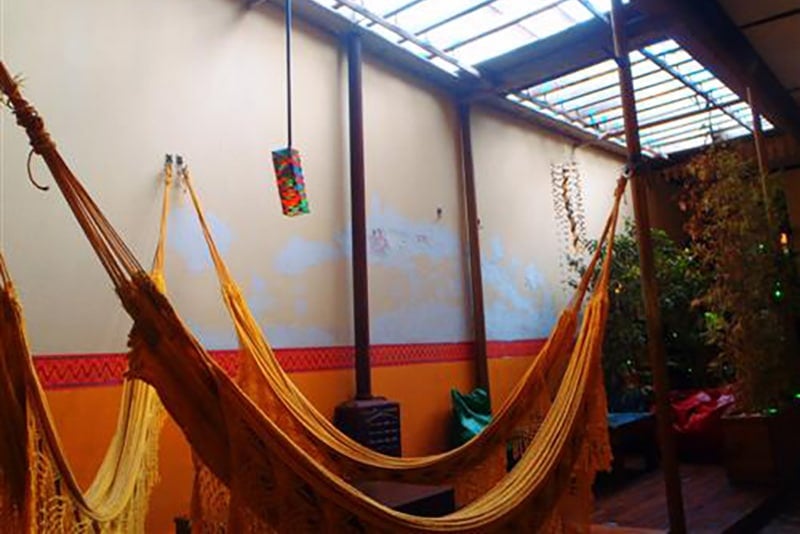
Review Of Hostel Prisamata In Salta, Argentina
Best Argentina Tours
Explore local culture with an Argentina tour guide through these unique excursions:
- Buenos Aires Graffiti & Street Art Tour
- Helicopter Ride: Overflight & Landing in the Andes Mountains A30 from Ushuaia
- Full-Day Tour to the Perito Moreno Glacier including Boat Safari from El Calafate
- Guided Hike at the Penguin Colony in Ushuaia
- Full Day Tour to Torres del Paine from El Calafate
Argentina Hotels
Click here to browse the best Argentina travel hotels!
Prefer self-contained stays?
Click here to check out unique local rentals !
You can also use this map to search for local stays:
Renting A Car In Argentina
Many visitors to Argentina choose to rent a car to really explore all that the country has to offer. If you’re doing the same, I highly recommend using Discover Cars to quickly compare your rental options.
Argentina Travel Insurance
It doesn’t matter if you’re traveling solo or with a group on an Argentina tour. When visiting Argentina — or any other country in the world — make sure to get travel insurance to protect your health and safety.
In my opinion, the best travel medical insurance for travelers is SafetyWing as they’ve got a large network and offer both short-term and long-term coverage — including coverage if you’re traveling for months as well as limited coverage in your home country).
Additionally, SafetyWing is budget-friendly and offers $250,000 worth of coverage with just one low overall deductible of $250.
With coverage, you’ll have peace of mind as you embark on your Argentina travel itinerary.
Click my referral link here to price out travel insurance for your trip in just a few clicks .
Argentina Travel Guide FAQ
Below, find answers to frequently asked questions about traveling in Argentina .
Q: What are the best places to visit in Argentina?
Argentina’s natural wonders are some of its biggest attractions. The country is home to 33 national parks that show off the nation’s diverse landscape and ecology.
Iguazu Falls , located on the border between Argentina and Brazil, draws in thousands of travelers every year, all coming to marvel at the sheer power of the fourth widest waterfall in the world. Walkways and viewing platforms make it easy to get up close to the falls for a truly spectacular view.
In Patagonia , you’ll find L os Glaciares National Park , a UNESCO World Heritage Site featuring giant ice formations you’ll have to see to believe. You can explore the Perito Moreno Glacier, the third-largest freshwater reserve in the world, on an ice-trekking tour, or just enjoy the view from the visitor center.
Just off the Chilean border in Southern Argentina, you’ll find Tierra del Fuego National Park featuring 156,000 acres of stunning landscapes and bucket list-worthy hiking trails .
Not much of an outdoor adventurer? Enjoy the park from the comfort of an antique steam train on the Southern Fuegian Railway.
Argentina’s cities are also huge draws for travelers looking to engage with the country’s history, culture, and modern lifestyle.
The capital city of Buenos Aires is home to gorgeous European architecture and one of the most vibrant cultural scenes in South America.
The Museo Nacional de Belles Artes houses over 500 years of international art, including works from Picasso, Goya, and Manet.
Take a deep dive into Argentinian history at El Zajon de Granados , a maze-like complex featuring 500 years of ancient architecture.
And of course you can’t miss Buenos Aires’ nightlife; this is the birthplace of the tango, after all!
In central Argentina, Cordoba features a mix of old colonial architecture and modern buildings, as well as a lively culture thanks to the city’s many colleges and universities.
The Jesuit Block is one of the city’s biggest draws and features one of the best-preserved European settlements in the area as well as the University of Cordoba, the fourth-oldest university in the Americas.
Museo de la Memoria also shows a darker side of the country’s history, preserving the memories of those lost in the “Dirty Wars” of the 1970s and 80s.
Argentina is also an amazing destination for foodies and wine enthusiasts.
Travelers flock to Argentina’s main wine-producing region, Mendoza , every year to tour the local vineyards and wineries, particularly during the harvesting season in March and April. You can easily tour the vineyards by bike and find tasting events any time of year.
The country is also well-known for its beef production, so carnivores will definitely find something they like here. You’ll find choripan (chorizo sausage in chimichurri sauce) on every corner in Buenos Aires and plenty of steakhouses throughout the country to satisfy your cravings.
Whether you’re chowing down at a family bodegon or a five-star restaurant, you’re bound to find something good.
Q: Is Argentina expensive for tourists?
Argentina is considered a pretty expensive destination . Years of high inflation and high prices can make it kind of difficult to find deals here.
The average traveler spends about $100 USD per day in Argentina on food, accommodations, transportation, and other travel expenses.
Still, there are plenty of ways to save money. Street vendors and smaller cafes often sell empanadas for less than $2 USD each and you can find some good lunch specials with a little research.
You can also save money by traveling in the off seasons (March through June and September through November), particularly when it comes to accommodations.
Q: What is the best way to travel around Argentina?
Buses are probably the most economical way to travel around Argentina. The country’s bus system is extensive and you can easily find routes running between major cities.
The coaches can also be quite luxurious , featuring air-conditioning, toilets, comfy seats, and sometimes even refreshments! If you’re taking an overnight trip, you can pay a little extra for a sleeper class ticket for an extra comfy ride.
Air travel is probably the quickest way to get from Point A to Point B in Argentina, considering the country’s size. Aerolíneas Argentinas offers tons of domestic flights, though there are several airlines operating in the country, including a few low-cost carriers.
You’ll want to book in advance, as flights can fill up quickly here. And be flexible with your plans if you’re flying — domestic flights in Argentina are subject to frequent delays and cancelations.
Q: Is Argentina safe for travel?
Argentina is considered a pretty safe destination . Violent crime is rare here, though muggings can happen in some cities.
Petty crime rates are higher, particularly when it comes to pickpocketing and purse snatching. You’ll want to keep any valuables out of view and stay aware of your surroundings to avoid pickpockets , particularly in major tourist areas.
You’ll also want to watch out for scams here. Never get into an unlicensed taxi and always double-check your change when paying in cash. And, as always, beware of any deals that seem too good to be true.
Q: What do I need to know before going to Argentina?
One major thing to know before going to Argentina is that the country is huge. This is not a destination you can completely cover in a short amount of time, so you’ll want to pick a few major places to visit if you’re on a tight schedule.
It’s also important to keep this in mind as you plan your travel between destinations. You may need to build in a day or two just to get from one place to another, so be sure to plan ahead.
Argentinians are also major night owls. Most businesses aren’t even open until 9 AM and everyone will know you’re a tourist if you show up for dinner at 6 PM.
If you’re into nightlife, you may find yourself out at the clubs until the wee hours of the morning. It’s best to try and take a break from your usual schedule and get on Argentinian time here. After all, you are on vacation!
It’s also important to note that the weather varies pretty widely here. You’ll find mild temperatures throughout the year in Buenos Aires, but winter temperatures drop to extreme lows in Patagonia.
The weather can also change quickly in the Andes region, so layer up and pack some rain gear if you’re exploring the mountains.
And don’t forget the SPF! The sun is strong throughout the country and protection is essential all year round.
Q: How many days should you spend in Argentina?
Most experts suggest spending 10-14 days in Argentina to visit different regions and get a good sense of the country. This will give you enough time to spend a few days in major destinations like Buenos Aires and travel between places without stress.
You may be able to fit one or two destinations in over a week’s time, but you’ll definitely need to plan a few more days for a more comprehensive trip.
Q: What is the best month to visit Argentina?
April through June are generally considered the best months to visit Argentina. These months make up the country’s autumn season where you’ll generally find mild temperatures and fewer crowds. You’ll also find great deals on accommodations during this time as most of the crowds have subsided.
Summer (December through March) is widely considered Argentina’s high season for tourism, so you’ll run into bigger crowds at popular attractions. The summer weather can also be quite warm and humid in certain parts of the country, making it a less comfortable time to visit.
Q: Do I need an Argentina travel visa?
Visitors from the United States , Canada , United Kingdom, Australia , Europe (European Union), and several other countries do not need a visa to enter Argentina. A valid passport will allow you to stay in the country for up to 90 days.
It’s recommended to view your country’s Argentina International Travel Information page for the most up-to-date information on entry and exit rules and Argentina Travel Requirements. You can also contact the Consulate General of Argentina.
Q: Where is Argentina?
Argentina is located in South America. It shares borders with Chile (south and west); Bolivia and Paraguay (north); and Brazil, Uruguay, and the Atlantic Ocean (east).
Q: Are credit cards accepted in Argentina?
Credit cards — particularly Visa and Mastercard — are widely accepted around Argentina at larger establishments, though it is always wise to carry some cash for smaller establishments and in case of emergency.
Q: Can you drink the tap water in Argentina?
The tap water is generally safe to drink in Argentina, though it is always best to double-check with your hotel to be safe.
Q: What is the local currency in Argentina?
The local currency in Argentina is the Argentine peso ($).
What would you add to this Argentina travel guide?

Enjoyed this ultimate Argentina travel guide? Pin it for later!

Ultimate ARGENTINA Travel Guide
Argentina is a country located in South America . Buenos Aires is the capital and it is a country known for its dramatic mountains and culture. Our Argentina travel guide is here to help you see the best it offers.
Argentina really nails it when it comes to diversity in landscapes and climates. From the powerful Iguazu Falls, set in the lush rainforest, to the deserts in the northwest, down the Andes Mountains and into Patagonia, it doesn’t disappoint.
It’s also a jumping-off point for trips to Antarctica , with trips leaving from Ushuaia at the far southern tip of Argentina.
We have visited Patagonia, the deep south in Ushuaia, and the Northwest areas of Jujuy and Salta. This guide will continue to be updated as we share more information on the places that we visited.
Destinations
Argentina travel: quick tips, don’t visit argentina without:.
UNIVERSAL TRAVEL ADAPTER

GET A GUIDEBOOK

REUSABLE WATER BOTTLE

WHERE TO STAY IN ARGENTINA
Below you will find some of the places we have stayed during our travels in Argentina. These are individual properties that we enjoyed and would recommend to other travelers.
HOW TO GET AROUND IN ARGENTINA
Anyone looking to travel to Argentina will likely fly into Buenos Aires and connect to the other airports across the archipelago. From Buenos Aires, it is possible to use public transportation to see the city or take buses further afield.
Many people choose to engage in group tours or day tours to get around and see things in Argentina. It is also possible to rent a car and plan a road trip that takes you further afield and out of the city.
TOP ARGENTINA TOURS
Explore chile & argentina.
8 Days Santiago to Buenos Aires Visits: Buenos Aires, Mendoza, Valparaiso & Santiago
PATAGONIA HIKING
9 Days from Buenos Aires Visits: El Chalten, El Calafate, Perito Moreno & Daily hiking
ARGENTINA MULTISPORT
15 Days from Buenos Aires Visits: Mendoza, Aconcagua, Bariloche, El Chalten & El Calafate
SPENDING MORE TIME IN SOUTH AMERICA?
Argentina travel: booking resources, argentina travel guide: related articles.
Looking for more info? Check out all the articles we’ve written on travel to Argentina and start planning your dream trip.
The Best Way to Visit Iguazu Falls: Argentina or Brazil?
Perito moreno glacier tours: top 8 things to do & travel guide, 5 days of hiking in patagonia: the basecamps trek, explora atacama: salta to san pedro de atacama travesia.

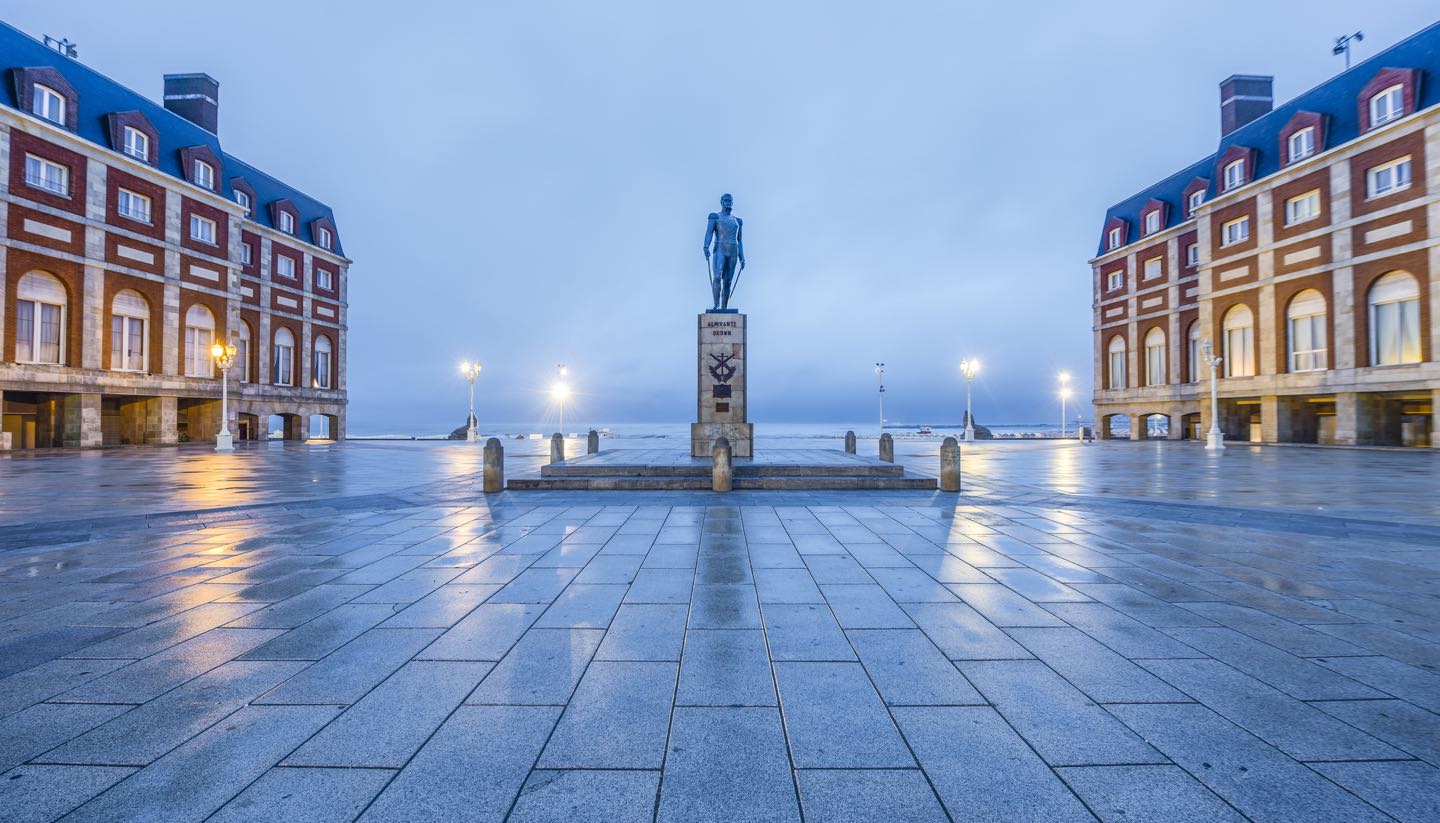
Introducing Argentina
About argentina.
- Images of Argentina
- History, language & culture
- Weather & geography
- Doing business & staying in touch
Plan your trip
Travel to argentina.
- Where to stay
While you’re there
- Things to see & do
- Shopping & nightlife
- Food & drink
- Getting around
Before you go
- Passport & visa
- Public Holidays
- Money & duty free
Book your flights
- Buenos Aires
- Buenos Aires Ministro Pistarini International Airport
Ski Resorts
Cruise locations, argentina travel guide.
Spirited Argentina, with its clamouring capital, vast pampas, rolling wine regions and snowy peaks, is a land bursting with adventure. It’s a place where the clichés hold true: football is essentially a religion, the beef is phenomenal and there’s little point even thinking about starting a proper night out before midnight. Its natural wonders range from Andean plateaux and Patagonian glaciers to subtropical waterfalls and wildlife-rich wetlands. There’s an awful lot to love.
Buenos Aires might sit at the very edge of the country, gazing out across the Rio de la Plata, but it’s very much Argentina’s centrepiece. The city of Evita and Maradona, its tango halls, parillas (grill restaurants) and feisty porteños (BA residents) provide a gutsy introduction to the country. In the high-end neighbourhoods of Recoleta and Palermo you’ll find designer boutiques and trendy eateries, while historic San Telmo offers antique stalls, old-world cafés and an abundance of live music.
In the north, scorched mountains and otherworldly rock formations characterise the Salta region, where Spanish and Gaucho traditions combine and Argentina’s famous white wines flourish. Further west, in the Mendoza region, the grapes are red and the foothills of the Andes offer skiing, while down south, in Patagonia, you’ll find an astonishing spread of expansive lakes, jagged peaks and mile upon empty mile of open space.
Elsewhere, try walking in the glistening Lake District, whale-watching off the coast at Puerto Madryn, meeting baby penguins in Punta Tombo or exploring the Jesuit chapels and farmhouses of Córdoba. Another of the country’s majestic natural beauties is the mighty Iguazu Falls, bordering Argentina and Brazil.
Despite living through a dark military dictatorship and a spectacularly devastating economic crisis, Argentineans still have a vivacious and infectious lust for life. And from its subtropical top to its icy tip, it remains a mesmerising country.
2,780,400 sq km (1,073,518 sq miles).
44,022,394 (UN estimate 2016).
15.6 per sq km.
Buenos Aires.
Federal republic.
President Javier Milei since 2023.
Travel Advice
The Foreign, Commonwealth & Development Office ( FCDO ) provides advice about risks of travel to help British nationals make informed decisions. Find out more about FCDO travel advice .
Before you travel
No travel can be guaranteed safe. Read all the advice in this guide as well as support for British nationals abroad which includes:
- advice on preparing for travel abroad and reducing risks
- information for women, LGBT and disabled travellers
Follow and contact FCDO travel on Twitter , Facebook and Instagram . You can also sign up to get email notifications when this advice is updated.
Travel insurance
If you choose to travel, research your destinations and get appropriate travel insurance . Insurance should cover your itinerary, planned activities and expenses in an emergency.
This advice reflects the UK government’s understanding of current rules for people travelling on a full ‘British citizen’ passport from the UK, for the most common types of travel.
The authorities in Argentina set and enforce entry rules. If you’re not sure how these requirements apply to you, contact Argentina’s embassy or consulate in the UK.
COVID-19 rules
Countries may restrict travel or bring in rules at short notice. Check with your travel company or airline for changes.
If you test positive for COVID-19, you may need to stay where you are until you test negative. You may also need to seek treatment there.
Visit TravelHealthPro (from the UK Health Security Agency) for general COVID-19 advice for travellers .
There are no COVID-19 testing or vaccination requirements for passengers entering Argentina.
Passport validity requirements
If you are visiting Argentina, your passport should be valid for the proposed duration of your stay. If you are a resident in Argentina, your passport must be valid for entry.
Visa requirements
You don’t need a visa to enter or travel through Argentina as a tourist for up to 3 months, unless you’re travelling on an emergency travel document.
You can get proof of your last entry or exit from Argentina from the Argentine Migration Office website . If you wish to extend your stay for another 90-day period, get advice from the Argentine Migration Office before your current stay ends.
If you’re travelling to Argentina for any purpose other than tourism, contact the Consulate of the Argentine Republic in London.
Applying for a visa
To apply contact your nearest Consulate of the Argentine Republic.
Travelling with children
Children aged 17 and under who are resident in Argentina need written permission (‘Autorización de viaje’) from the non-accompanying parents to leave the country.
Non-resident children aged 17 and under who have remained in Argentina for 1 year or more are treated in line with resident children and also need permission. You can get permission from a notary public in Argentina or the Argentine Migration Office .
You can get full information on the different types of permission and requirements for children leaving Argentina from the Argentine Migration Office or from your nearest Consulate of the Argentine Republic .
Vaccination requirements (other than COVID-19)
At least 8 weeks before your trip, check the vaccinations and vaccination certificates you may need on TravelHealthPro’s Argentina guide .
Customs rules
There are strict rules about goods that can be brought into and taken out of Argentina. Read the Argentinian government website for more information (in Spanish) . You must declare anything that may be prohibited or subject to tax or duty.
Taking money into or out of Argentina
You can only enter or leave Argentina with less than 10,000 US dollars or the equivalent in other currencies. Read the Federal Administration of Public Income website for more information (in Spanish) .
There is a high threat of terrorist attack globally affecting UK interests and British nationals, including from groups and individuals who view the UK and British nationals as targets. You should remain vigilant at all times
UK Counter Terrorism Policing has information and advice on staying safe abroad and what to do in the event of a terrorist attack. Find out how to reduce your risk from terrorism while abroad .
Terrorism in Argentina
Terrorist attacks in Argentina cannot be ruled out.
Political situation
Following an increase in violent organised and drug-related crime in Rosario, Province of Santa Fe, the Government of Argentina has deployed additional security forces to maintain public order and safety. Public transport and taxis have also been affected. If you are in Rosario or planning to travel to Rosario, exercise a high degree of caution, monitor the media and follow the advice of the local authorities.
Political demonstrations and picketing are more common in Argentina than in the UK. Some demonstrations attract large numbers of people, and they can occasionally turn violent.
You should:
- avoid all protests, demonstrations and marches
- exercise normal caution at any large gathering
- be aware of your surroundings
- follow the advice of local authorities
There have also been occasional Falklands-related protests including outside the British Embassy and British-affiliated businesses in Argentina.
Demonstrations
Groups of demonstrators (‘piqueteros’) sometimes block major roads during times of social unrest. This can include blocking the major routes into and out of Buenos Aires City. This can cause significant delays.
When planning to travel:
- monitor the local news
- do not attempt to cross blockades
- follow the advice of the local authorities
Protecting your belongings
Thieves normally work in teams of 2 or more and tend to target small bags and pockets. You should:
- always keep a close eye on your personal possessions
- not carry all your valuables in one place
- avoid carrying large amounts of cash or wearing jewellery
- keep a photocopy or scanned copy of your passport somewhere safe
- avoid isolated or poorly lit areas at night
You might be asked for a photo ID when paying with a credit card so carry one with you but keep it secured. A money belt under your clothes is the safest option.
Thieves and pickpockets operate on public transport, bus and train terminals.
Thieves posing as hotel guests snatch bags while tourists are checking into hotels or hostels. Handbags can be cut open in crowded places and mobile phones have been snatched while being used on the street. Thieves on motorbikes can snatch bags from pedestrians.
Thefts from unattended vehicles, especially hire cars, are common.
- keep your valuables out of sight or close to you
- avoid hanging bags on the back of your chair
- avoid using ATMs at night
- be aware of your surroundings when withdrawing money
Street crime and scams
Be alert to street crime, especially thieves (often women) using distraction techniques. A common form of distraction theft reported in Buenos Aires is the ‘mustard scam’. Thieves will rob tourists while an accomplice pretends to help remove mustard that has been accidentally sprayed on them. If this happens to you, politely but firmly refuse assistance and walk away.
In Buenos Aires, be particularly cautious in:
- Florida Street
- Avenida de Mayo
- Rivadavia Avenues near the obelisk
- the Retiro Bus terminal
In Mendoza, be particularly cautious downtown.
Violent crime
Violent and armed robberies can happen in the streets immediately outside the Caminito tourist area in La Boca. Stay in the designated tourist area where there are high-visibility police patrols. If robbed, hand over your cash and valuables without resistance.
Kidnappings and ‘express kidnappings’ occasionally occur in Argentina. Victims are held and forced to empty their bank accounts in different ATMs after which they are normally quickly released.
For English-language assistance, safety tips issued by the City of Buenos Aires, or to file a police report online, visit the Buenos Aires Police website (only accessible in Argentina). You can also contact the Tourist Police, who are available 24 hours:
Telephone: +54 911 5050 9260/3293 (from a mobile)
Telephone: 155 5050 9260/3293 (from a local landline)
Drink and food spiking
Drinks and other foods can be spiked and could put you at risk of robbery or assault. Do not leave food or drinks unattended in bars and restaurants and do not accept them from strangers.
Be aware of the risk of bringing people you don’t know well into your accommodation. It doesn’t happen often, but there have been reports of foreign tourists being robbed or assaulted after inviting new acquaintances, met online or in person, into their accommodation. Be alert to the possible use of ‘date rape’ and other drugs. Alcohol and drugs can reduce your vigilance, making you less in control.
Laws and cultural differences
Illegal drugs and prison sentences.
Don’t become involved with illegal drugs of any kind. Possessing even very small quantities can lead to a lengthy prison sentence.
LGBT travellers
Argentine society is open and diverse. Discrimination based on sexual orientation is rare. Same-sex marriage is legal. Read our advice for LGBT travellers before you travel.
Legal action against oil and gas companies
The government of Argentina has stated that it intends to pursue legal action against oil and gas companies engaged in hydrocarbon exploration in the Falkland Islands. If you’re travelling to Argentina and think you may be affected by this type of legal action, seek independent legal advice.
Outdoor activities and adventure tourism
If you take part in extreme or adventure sports (including paragliding, climbing, off-road driving and hot air ballooning), make sure:
- adequate safety precautions are in place
- you only use reputable operators and insist on training
- your travel insurance covers all the activities you want to undertake and includes helicopter rescue and medical evacuation
You will have to pay for most helicopter rescues, including in Mount Aconcagua.
Altitude sickness is a risk in parts of Argentina. More information about altitude sickness is available from TravelHealthPro (from the UK’s National Travel Health Network and Centre).

Transport risks
Road travel.
You will need an International Driving Permit to drive in Argentina.
Respect for speed limits and traffic signals varies and drivers can make unexpected manoeuvres. Crime against car users, particularly when stationary at traffic lights, is a problem. Always keep car windows closed and doors locked in major cities.
Take care when driving in the province of Misiones, close to the borders with Paraguay and Brazil; the area is used to smuggle goods. Seek local advice from customs officials if you intend to drive in this area.
Book taxis in advance if possible. If you hail a taxi in the street, only use a ‘radio taxi’. These have a clearly visible logo on the car doors.
See the City of Buenos Aires’ government site for a downloadable list of registered taxi companies with their contact details.
Flights from Argentina can be unreliable and susceptible to delays and cancellations. Check the status of your flight with your airline or travel company before travelling to the airport.
There have been cases of disruption by activist groups and unions against British-flagged shipping, and shipping involved in hydrocarbons or fishing activity in the Falkland Islands. If you’re responsible for a vessel, contact your agent or the local authorities before travelling. Most cruise ships and visiting tourists should not be affected.
Extreme weather and natural disasters
Many northern provinces experience occasional flooding. This can disrupt transport and delivery of food. Flash floods can occur during heavy rains, in provinces including Buenos Aires. Monitor local media and follow instructions given by the local authorities.
Volcanic eruptions
The Copahue Volcano on the Argentina-Chile border erupts occasionally, and residents are evacuated. If you’re travelling to this area, monitor local media reports and follow the advice of the local authorities.
Before you travel check that:
- your destination can provide the healthcare you may need
- you have appropriate travel insurance for local treatment or unexpected medical evacuation
This is particularly important if you have a health condition or are pregnant.
Emergency medical number
Dial 107 or 911 and ask for an ambulance.
Contact your insurance or medical assistance company promptly if you’re referred to a medical facility for treatment.
Vaccinations
At least 8 weeks before your trip check:
- the latest information on health risks and what vaccinations you need in TravelHealthPro’s Argentina guide
- where to get vaccines and whether you have to pay on the NHS travel vaccinations page
Health risks
Health risks in Argentina include:
- yellow fever
See the ‘Other risks’ section of the TravelHealthPro Argentina guide for more details.
The legal status and regulation of some medicines prescribed or bought in the UK can be different in other countries.
TravelHealthPro explains best practice when travelling with medicines .
The NHS has information on whether you can take your medicine abroad .
Healthcare facilities
Medical facilities are good but can be expensive. Public hospitals tend to be crowded.
You can view a list of English-speaking doctors in in Argentina .
Travel and mental health
Read FCDO guidance on travel and mental health . There is also guidance on travelling with mental health conditions on TravelHealthPro .
The Foreign, Commonwealth & Development Office ( FCDO ) cannot provide tailored advice for individual trips. Read this travel advice and carry out your own research before deciding whether to travel.
Emergency services
Ambulance: 107
Police: 911 or 101
Find out about call charges
Tourist Police
The Tourist Police can give help in English in certain areas. They are available 24 hours.
Buenos Aires Tourist Police
For contact details and more information, see the Buenos Aires Tourism website .
Mendoza Tourist Police
For contact details and more information, see the Mendoza tourism website .
Contact your travel provider and insurer
Contact your travel provider and your insurer if you are involved in a serious incident or emergency abroad. They will tell you if they can help and what you need to do.
Refunds and changes to travel
For refunds or changes to travel, contact your travel provider. You may also be able to make a claim through insurance. However, insurers usually require you to talk to your travel provider first.
Find out more about changing or cancelling travel plans , including:
- where to get advice if you are in a dispute with a provider
- how to access previous versions of travel advice to support a claim
Support from FCDO
FCDO provides guidance on how to help yourself stay safe and what to do if you need help or support abroad, including:
- finding English-speaking lawyers , funeral directors and translators and interpreters in Argentina
- dealing with a death in Argentina
- being arrested in Argentina
- getting help if you’re a victim of crime
- what to do if you’re in hospital
- if you are affected by a crisis , such as a terrorist attack
Find more support for British nationals abroad .
Help abroad in an emergency
If you are abroad and you need emergency help from the UK government, contact the British Embassy Buenos Aires .
You can also contact FCDO online .
FCDO in London
You can call FCDO in London if you need urgent help because something has happened to a friend or relative abroad.
Telephone: 020 7008 5000 (24 hours)
Risk information for British companies
The Overseas Business Risk service offers information and advice for British companies operating overseas on how to manage political, economic, and business security-related risks.

Book a Hotel
© Columbus Travel Media Ltd. All rights reserved 2024
- 3 Other destinations
- 4.1 Climate
- 4.2 Terrain
- 4.3 Geography
- 4.4 History
- 4.5 Cultural diversity
- 4.6 Electricity
- 4.7 Holidays
- 4.8 Visitor information
- 5.1.1 At arrival
- 5.2 By plane
- 5.3 By train
- 5.5 By boat
- 6.2 By train
- 6.3 By plane
- 6.5 By thumb
- 6.6 On foot and navigation
- 8.1 Urban life
- 8.2 Natural wonders
- 8.3 Some other highlights
- 9.1 Hiking and trekking
- 9.2 Walking tours
- 9.3.1 Football teams
- 9.3.2 Other sports
- 9.4 Itineraries
- 10.1.1 Inflation
- 10.1.2 Banks
- 10.1.3 ATMs
- 10.2.1 Money exchange
- 10.2.2 Credit cards
- 10.2.3 Traveller's checks
- 10.3 Tipping
- 10.4 Shopping
- 17.1.1 Tornadoes
- 17.2 Emergency numbers
- 18 Stay healthy
- 19.1 Communication style
- 19.2 Greetings
- 19.3 Football
- 19.4 Punctuality
- 19.5 Sensitive issues
- 19.7 General
- 20.1 By phone
- 20.2 By internet
Argentina is a large country in the southern part of South America . It offers a great diversity of climates and landscapes from jungles in the north, great grass plains in the center and frozen mountains in the south.
With a history of mass immigration dating from the 1800s, Argentina is a "melting pot" of cultures from around the world.
Regions [ edit ]

Cities [ edit ]
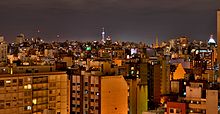
- -34.599722 -58.381944 1 Buenos Aires — the capital at the shores of the Río de la Plata, occasionally called Capital Federal to distinguish it from the province of Buenos Aires
- -31.416667 -64.183333 2 Córdoba — second largest city, in the heart of the Pampas region, known for its university and near a beautiful mountain range
- -34.933333 -57.95 3 La Plata — the capital of Buenos Aires province, known as "the perfect city" for its tracing; just look at a map of the street pattern of the city
- -32.889722 -68.844444 4 Mendoza — well known for its extensive and high quality wine production. It is also near Aconcagua , the highest mountain outside of the Himalayas
- -32.9575 -60.639444 5 Rosario — on the Paraná shore, known for beautiful neoclassical architecture
- -24.788333 -65.410556 6 Salta — in the Northwest, known as 'La Linda' due to its old city and the beautiful surroundings
- -41.15 -71.3 7 San Carlos de Bariloche — in the foothills of the Andes with lots of facilities for skiing and trekking. Known for its picturesque snow-covered landscapes and the European style of its buildings
- -31.5375 -68.536389 8 San Juan — a center of quality wine production
- -26.816667 -65.216667 9 San Miguel de Tucuman — the largest city in the northwest, near a subtropical jungle region
Other destinations [ edit ]
- -50.337778 -72.26 1 El Calafate — the main destination when visiting the Glaciers National Park ; advancing to the Perito Moreno Glacier is a must when visiting Argentina
- Iberá Wetlands — a nature reserve of 13,000 km 2 in a large swampland region with unique wildlife, with its eco village Colonia Carlos Pellegrini right in the heart of the reserve
- -25.695278 -54.436667 2 Iguazú Falls — awesome falls right in the north-east corner of the country
- -41 -71.5 3 Nahuel Huapi National Park — at the foothills of the Andes mountains with lakes, rivers, waterfalls, peaks, glaciers and forests
- -23.199861 -65.348861 4 Quebrada de Humahuaca — a narrow valley in the arid mountains of Jujuy province, including famous colourful mountains and magnificent desert landscapes
Understand [ edit ]
Argentina, officially the Argentine Republic ( Spanish : República Argentina ), is in South America , and is the eighth-largest country in the world. The highest and the lowest points of South America are also in Argentina: At 6,960 m, Cerro Aconcagua is the tallest mountain in the Americas while Laguna del Carbón , at 105 m below sea level, in Santa Cruz Province is the lowest point in South America.
At the southern tip of Argentina there are several routes between the South Atlantic and the South Pacific Oceans including the Strait of Magellan, the Beagle Channel, and the Drake Passage – as alternatives to sailing around Cape Horn in the open ocean between South America and Antarctica .
The name Argentina derives from argentinos , the Ancient Greek diminutive (tinos) form for silver (argentos), which is what early Spanish explorers sought when they reached the region in the 16th century.
Climate [ edit ]
Buenos Aires and the Pampas are temperate; cold in the winter, hot and humid in the summer.
The deserts of Cuyo , which can reach temperatures of 45°C, are extremely hot and dry in the summer and moderately cold and dry in the winter. Spring and fall often exhibit rapid temperature reversals; several days of extremely hot weather may be followed by several days of cold weather, then back to extremely hot.
The Andes are cool in the summer and very cold in the winter, varying according to altitude.
Northwest Argentina's climate varies by altitude with lowland areas experiencing hot summers and mild winters while icy conditions prevail at the highest altitudes. Salta and San Salvador de Jujuy are in valleys and are characterized by a pleasant climate year-round.
Mesopotamia to the northeast has a humid climate with abundant rainfall year-round and high temperatures.
Patagonia is cool (in the south and the west) to warm (in the center and north-east) in the summer and cold in the winter. Much of the region is a desert except in the extreme west where rainfall is higher, supporting forests. The rainfall changes a lot within a small distance ranging from more than 1,000 mm (39 in) to just under 200 (8 in) less than 100 km (62 mi) away to the east. One defining characteristic of the climate is the strong, persistent winds that blow across the region, making the temperature feel much colder than it is. Extreme temperature shifts within a single day are common here; pack a variety of clothes and dress in layers.
Terrain [ edit ]
The central region of Argentina is the rich plain known as La Pampa . There is jungle in the extreme northeast and some valleys in the Northwest. The southern half of Argentina is dominated by the flat to rolling plateau of Patagonia . The western border with Chile is along the rugged Andes mountains, including the Aconcagua , the highest mountain outside the Himalayas. The western Cuyo regions at the base of the Andes are mostly rocky desert with some poisonous frock trees.
Geography [ edit ]
Argentina covers an area of 2,796,427 square kilometres (1,079,707 sq mi), making it the world's eighth-largest country, the second-largest country in South America , and the fourth-largest country in the Americas .
Argentina is slightly larger than Kazakhstan , and is nearly 17 times larger than South America's smallest country, Suriname .
History [ edit ]
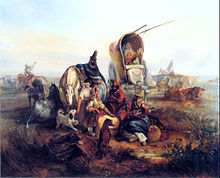
Following independence from Spain in 1816, Argentina experienced periods of internal political conflict between conservatives and liberals. In the first decade of the 20th century, Argentina became the richest nation in Latin America , its wealth symbolized by the opulence of its capital city . During the roaring twenties, Argentina was one of the world's richest countries, with a GDP higher than that of major European economies such as France, Germany and Italy. European immigrants flowed into Argentina, particularly from the northern parts of Italy and Spain; by 1914 nearly 6 million people had come to the country.
After World War II, Juan Perón came to power and instituted a form of populism commonly known as Peronism. Under Peron, Argentina instituted a protectionist economic policy that heavily restricted foreign trade. While such policies led to the overwhelming popularity of Peron and other Peronist politicians among the masses of working-class Argentinians, they also led Argentina's economy to stagnate. Peron was overthrown in a U.S.-backed military coup in 1976.
After waging an unsuccessful war with the United Kingdom over the Islas Malvinas ( Falkland Islands ) in 1982, the military leadership lost power and democracy returned in 1983.
A painful economic crisis at the turn of the 21st century devalued the Argentine peso by a factor of three and ushered in a series of weak, short-lived governments along with social and economic instability. However, later in the decade Argentina seemed to find some new stability, and has a much better economic outlook albeit with the eternal problem of high inflation. Argentina is the third largest economy in Latin America, after Brazil and Mexico, and a member of the G20 group of major economies.
Widespread discontent amid a hyperinflation crisis led to the election of anarcho-capitalist candidate Javier Milei as president in 2023. Milei has pledged to drastically downsize the government and cut welfare program in order to rein in government spending, while also privatising all the state-owned businesses en masse. He has also pledged to abolish the Argentine Central Bank and Argentine peso, and instead adopt the U.S. dollar as Argentina's national currency. Milei has also pivoted Argentina's foreign policy away from China towards the United States and Israel, and converted to Judaism to show his support for the Zionist cause. Whether or not this can rein in inflation and improve the lives of average Argentines remains to be seen.
Cultural diversity [ edit ]

Between 1850 and 1930, the country received millions of immigrants from all over the world. 98% of the population is of partial or full European ancestry.
Italians are the largest ethnic group in the country, with 60% of Argentines (30 million people) claiming Italian ancestry. Italian influence in the country is profound and well documented; Argentine cuisine has been strongly influenced by Italian cuisine , Italian settlements helped to form the backbone of Argentine society, the Argentinian dialect of Spanish exhibits strong Italian influences, and many Argentines are Italophiles.
During the 1800s, hundreds of thousands of immigrants from the British Isles moved to Argentina. English immigrants are credited with introducing the sport of football to Argentina, which has since become the country's national sport, and there are several Welsh -speaking towns in Chubut province.
Argentina has one of the world's largest Jewish populations and houses the largest Jewish community in South America , most of whom are of Ashkenazi extraction.
Other significant ethnic groups:
- Spaniards — the second largest ethnic group and they have been in the country since the 16th century.
- Germans — it is believed that 8% of Argentines are of German descent.
- The French — it is believed that 17% of Argentines are of French descent.
- Russians — it is believed that 1-3% of Argentines are of Russian descent.
- Ukrainians — they make up 9% of the population in Misiones .
- Poles — it is believed that 3% of Argentines are of Polish descent.
Electricity [ edit ]
Argentine electricity is 220 V, 50 Hz. Adapters and transformers for North American equipment are readily available.
The best way to use imported electrical equipment in Argentina is to purchase an adapter once there. These are available in the Florida shopping area in Buenos Aires for around US$2 or less in hardware stores outside the city center. Buildings use a mix of European and Australian plug fittings. The Australian-style plugs are IRAM-2073, which are physically identical to the Australian AS-3112 standard (two blades in a V-shape, with or without a third blade for ground). However, the live and neutral pins in the Australian fittings are reversed. Therefore, Australian equipment may be incompatible despite the apparent plug-compatibility. This is not a problem for battery chargers for devices like laptops and mobile phones.
European standard CEE-7/7 "Schukostecker" or "Schuko" outlets and the non-grounded, but compatible, European CEE-7/16 "Europlug" outlets may still be found in some older buildings. US and Canadian travellers may want to pack adapters for these outlets as well.
Many sockets have no earth pin. Laptop adapters should have little problem with this. If your laptop adapter requires an earth pin you will need a plug adapter that takes three pins from the laptop and requires only two from the wall socket. This does work but may reduce electrical safety or affect your warranty.
Some Argentine sockets accept North American plugs, particularly ones on power strips. This does not mean that these sockets supply 110 volts. Make sure that your equipment can handle 220 volts. Simply changing the shape of the plug with a US$2 adapter will not allow 110 V equipment to operate on 220 V Argentinian voltage, unless the device is specifically designed to work on both 110 and 220 volts, irreparable damage and even fire can result . Most laptop power adapters and many portable electronics chargers are designed to work on either voltage; check the specifications for your equipment to be sure. If your equipment cannot accept 220 V voltage, you can purchase a '220-110 V' transformer for approximately US$6 in most Argentinian electronics shops. This is much heavier and bulkier than a small adapter. There are two types of these transformers. One supports heavy loads for short durations, for example a hair dryer. The other supports light loads for long durations, for example an inkjet printer.
Holidays [ edit ]
- January 1 — New Year's Day
- March 24 — Day of Remembrance for Truth and Justice
- 2 April — Malvinas Day
- 25 May — Day of the First National Government
- June 17 — Anniversary of the death of Martín Miguel de Güemes
- June 20 — National Flag Day
- July 9 — Independence Day
- August 17 — Anniversary of the death of José de San Martin
- October 12 — Day of Respect for Cultural Diversity
- November 20 — Day of National Sovereignty
- December 25 — Christmas
- December 31 — New Year's Eve
Visitor information [ edit ]
- argentina.travel (official tourism website)
Get in [ edit ]
Visas [ edit ].

Passport holders of the following countries do not need a visa to enter Argentina when the purpose of the visit is tourism for up to 90 days (unless otherwise noted): Andorra , Armenia , Australia , Austria , Barbados , Belarus , Belgium , Bolivia , Brazil , Bulgaria , Canada , Chile , Colombia , Costa Rica , Croatia , Cyprus , Czech Republic , Denmark , Ecuador , El Salvador , Estonia , Fiji , Finland , France , Georgia , Germany , Greece , Grenada , Guatemala , Guyana , Haiti , Honduras , Hong Kong , Hungary , Iceland , Ireland , Israel , Italy , Jamaica (30 days), Japan , Kazakhstan (30 days), Republic of Korea , Latvia , Liechtenstein , Lithuania , Luxembourg , Malaysia (30 days), Malta , Mexico , Monaco , Mongolia , Montenegro , Netherlands , New Zealand , Nicaragua , North Macedonia , Norway , Panama , Paraguay , Peru , Poland , Portugal , Romania , Russia , Saint Kitts and Nevis , Saint Lucia , Saint Vincent and the Grenadines , San Marino , Serbia , Singapore , Slovakia , Slovenia , South Africa , Spain , Suriname , Sweden , Switzerland , Thailand , Trinidad and Tobago , Turkey , Ukraine , United Arab Emirates , United Kingdom , United States of America , Uruguay , Vatican City and Venezuela .
Citizens and residents (if their nationality is mentioned under visa exemptions applicable to normal passport holders) of the following countries can enter with their National ID card: Bolivia , Brazil , Chile , Colombia , Ecuador , Paraguay , Peru , Uruguay and Venezuela .
Citizens of India and China (including Macau ) who also hold a valid visa issued by the United States or a Schengen visa can obtain an Electronic Travel Authorization (AVE) at a cost of US$50 prior to travelling to Argentina. The validity of Schengen or U.S. visas must be more than 3 months. The processing time is 10 business days [dead link] .
At arrival [ edit ]
You may bring in goods worth US$300 without paying duties.
If you are just changing planes at the same airport and not entering the country you will still be given a customs form to fill in but as of May 2014 nobody asks for it at the airport and you can keep it as a souvenir.
By plane [ edit ]
Aerolíneas Argentinas and LATAM offer connections between Buenos Aires ' international airport Ezeiza and many cities throughout South America, as well as North America, Europe and Australia. Air New Zealand flies direct from Auckland . Qantas no longer offers direct flights from Sydney to Buenos Aires , instead flying to Santiago, home of its OneWorld Partner LATAM, where people can connect onto multiple destinations in Argentina.
There are international flights to other airports, such as to Mendoza with LATAM from Santiago Chile.
On flights to and from Argentina the cabin is sprayed with insecticide before the security demonstration before takeoff (flight attendants walk down the aisles with spray cans). This is also done on flights in some other parts of the world where tropical diseases are prevalent like between Singapore and Sri Lanka.
If you're flying in or out of Argentina, Buenos Aires is the most common point of arrival and departure. The city has two airports, Ministro Pistarini International Airport ( EZE IATA ) some 40 km southwest of central Buenos Aires and the more centrally located Aeroparque Jorge Newbery ( AEP IATA ). The former is for intercontinental flights and a few domestic ones (mostly to Río Gallegos and Ushuaia), which leave early in the morning but if you're continuing to another location in Argentina or to nearby international destinations (one flight hour away or so) by plane you'll in most cases have to travel from Ezeiza to Jorge Newbery. There are cheap shuttle buses which take you there in about an hour, but travel time varies greatly depending on traffic. Also, there are some flights to Jorge Newbery from three other important South American hubs, namely São Paulo, Rio de Janeiro or Santiago so if you have a changed planes at those airports, your connecting flight might arrive at (or leave from) Jorge Newbery. Take an extra look at your ticket and ensure you are at the right airport.
You should be able to ride a motorcoach or hire a service taxi from one of the booths after you clear customs. The rate for a taxi from Ezeiza international airport to Buenos Aires is AR$130, the rate from the Jorge Newbery domestic airport to town is AR$40 (Mar 2012). You can now also ride an Uber from Ezeiza, the fare is sometimes dynamic and much lower than a taxi, and is recommended to send an SMS or call your driver, since they may need to coordinate the pick up spot with you.
If visiting another city there are a number of airports throughout the country. Many find it far easier to travel to a neighboring country and then take a short distance hop to the smaller airport. All major cities in Argentina and major tourist destinations like Mendoza, Perito Moreno and Iguazu Falls have airports nearby. There are several national airlines, with different levels of service. In general flying gets you everywhere quickly and cheaply (relatively). Although the buses in Argentina are among the most comfortable in the world and are reasonably priced, travelling takes a lot of time because of the distances and slow road travel involved.
Passengers leaving Ezeiza Airport no longer have to pay the "departure tax" of US$29 (US$8 to Uruguay and domestic flights) after check-in, as they are now included in the prices of the tickets.
By train [ edit ]
There are no long-distance international services to Argentina, only a short-distance train from Encarnación ( Paraguay ) to Posadas (though even that is not operating as of June 2022). Coming from Bolivia , the border towns of Villazón and Yacuiba can be reached by train. A connection between Chile and Argentina is under construction.
By bus [ edit ]

International coaches run from all the neighbouring countries.
- Retiro Bus Terminal: +54 11 4310-0700
The Retiro bus terminal is large and hidden behind Retiro train and Subte stations. For long-distance buses it is advisable to buy a ticket several days in advance of your trip. Arrive at least 45 minutes before your departure and always ask at an information desk if your gate number is the same as the one printed on your ticket. You will be given a range of possible gate numbers (for example 17-27). Watch your belongings carefully at Retiro as it is often crowded and there have been reports of thefts and even muggings at night. Travelling by bus is one thing you won't regret. You will come across the best customer service and world class seats. Comparing Argentinian coach buses to those in the United States would be insulting to Argentina, for they have much higher standards than those like Greyhound.
By boat [ edit ]
Regular catamarans routes link Buenos Aires with Montevideo and Colonia in Uruguay .
The Buquebus ferry service operates between Buenos Aires, Argentina, and both Colonia del Sacramento and Montevideo, Uruguay. Some services are even from Punta del Este (via bus). For the Buquebus-Ferry between Buenos Aires and Colonia del Sacramento there are two options, one takes three hours and the other one hour to get there. Generally, Buquebus seems a little more expensive than Colonia Express.
Colonia Express operates between Buenos Aires and Colonia by one hour ferry. In addition, you can add a bus option between Colonia and Montevideo. Ticket prices from/to Montevideo or Colonia are between US$25–50, depending on the day of week and time.
Seacat Colonia also operates between Buenos Aires and Colonia by one hour ferry, also offering a combined bus option between Colonia and Montevideo or even Punta del Este.
There is also the directferries.com/.co.uk website, which offers those trips and ferries, although at inflated prices. In addition, it sometimes requires you to book business seats, which adds even further cost. In the end prices can easily be threefold for a simple one way ticket.
Furthermore, there are two companies ( Cacciola and Líneas Delta ) that link the city of Tigre with Carmelo and Nueva Palmira in Uruguay , respectively. Trains to Tigre depart from Retiro (one of Buenos Aires' main train stations) every ten minutes. The trip costs AR$1.1 and takes 50 min.
To a lesser extent, Grimaldi Freighters run freighters which carry up to 12 passengers from Hamburg , London , Antwerp , Le Havre , and Bilbao to Montevideo ( Uruguay ) every 9 days. They also carry cars and you drive your car on and off — unlike other freighter services. More information can be found on the website.
By car [ edit ]
Argentina has many border crossings with its neighbouring countries Chile, Uruguay, Paraguay and Brazil, which are easy to use.
Some ferries between Buenos Aires and Colonia also carry vehicles. However, taking the land border crossing can be convenient for a more complete route including Salto, Paysandú and Carmelo and the cities on the Argentinian side on your trip between Argentina and Uruguay.
Get around [ edit ]
Argentina is a colossal country. With a land area of 2,780,400 square kilometres (1,073,500 sq mi), travelling from one region to another can take a lot of time.
Argentina boasts an outstanding short and long-distance bus network. Since regional train service is limited and plane tickets are more expensive, bus travel is the most common way to travel from city to city within Argentina. It is not as cheap as it was before, with about US$4-5 for each hour of travelling (Puerto Iguazú to Buenos Aires about US$100).
In Buenos Aires, a city bus is called a colectivo or bondi while a long distance, intercity bus is called a micro or omnibus ; this is not always true though, usage varies somewhat in provincial areas.. The hub of this network is definitely Buenos Aires' Terminal de Omnibus de Retiro ; it has up to 2,000 bus arrivals and departures per day, and multiple companies serve most destinations. Buses arrive and depart from a total of 75 platforms, and in order to buy your ticket you will have to choose between about 200 ticket booths situated on the upper level of the terminal.
The more expensive buses generally offer high-quality service, and for distances longer than 200 km, it is common to have food served on board. There is generally a good amount of legroom, and many buses have seats that recline horizontally into beds ( called camas ) making them a lot like travelling business class on a plane. The best category with completely reclining seats is normally called cama suite , but other names such as tutto leto , ejecutivo , cama vip or salon real are also in use. Somewhat cheaper seats only recline partially ( semi-camas ), or not at all ( servicio común ). Every service belongs to one of five official comfort classes with minimum requirements that are prescribed by law in order to facilitate comparisons. The better buses will provide everything you need, while for the lower categories it may be a good idea to take drinks and food with you, as well as toilet paper and ear plugs. If the trip is really long e.g. more than 12 hours it's definitely better to spend a few more bucks and pay for a better bus service. If travelling with a large bag or suitcase bring a handful of coins to tip the porter that heaves your pack in and out of the taxi and bus.
Remember that, although buses usually arrive at their destination a little late, they almost always leave on time. Do not think that the relaxed approach carries over to bus departure times!
More information on bus schedules and fares is available on the webpages of the online ticket resellers Plataforma 10 , Central de Pasajes . To buy tickets and to really have a choice to different bus companies you may visit Ticket Online or VoyEnBus . For buses departing or arriving in Buenos Aires, you can consult the webpages of the Terminal Retiro in Buenos Aires. A second bus terminal in Buenos Aires is situated in the Liniers neighbourhood, but it is smaller and less accessible than the one in Retiro. Major bus companies are Andesmar , Flecha Bus and Expreso Singer .
For city buses in Buenos Aires you should check BA Cómo Llego (In English, also an app for smartphones) and Omnilineas (in English).
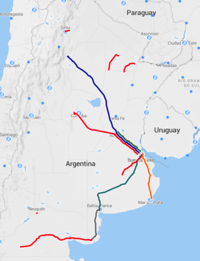
The history of rail transport in Argentina is one of many ups and downs. While in the 19th century the rail network rivaled that of the US or many European countries in density, speed and quality as befitted a nation among the richest in the world, the declining fortunes of Argentina in the 20th century hit the railway, too. The railways were nationalized during Juan Domingo Perón's first term and remained state-owned until they were privatized under the government of Carlos Menem. However, the railways have since made yet another U-turn and a new state-owned railway was created in 2015. The government has promoted the re-establishment of long-distance passenger trains, although most lines still operate at a low frequency (one or two departures weekly). The rail network is very limited, and intercity buses offer better service and faster rides. Train fares are very cheap, often only a quarter of the bus fare. The website is a bit hard to navigate and Spanish only.
Local travel in the Buenos Aires province is by bus and by local trains, with fast trains being the quickest way to get through the city's traffic. The three largest train terminals in Buenos Aires are Retiro, Constitucion and Once. Retiro is a group of three train stations alongside each other with the main long-distance bus (or "micro") terminal behind the furthest of the train terminals (from the city center).
One of the major long distance train operators is Trenes Argentinos , which departs from Retiro (Buenos Aires) to Rosario, Córdoba and Tucumán, and from Constitución (Buenos Aires) to Bahía Blanca. See also Satélite Ferroviario for up-to-date information on trains and services ( in Spanish ). Tickets can be bought online with a 5% discount and with credit card. Even though, it does not allow for the selection of a foreign passport ID when buying a ticket, you can enter your number (and letters) under DNI , which will be accepted in the train. For getting the needed online account, you cannot enter letters for your ID number, but just put anything, since you will be asked anew for each purchased connection.
An amazing (but quite expensive) train ride is the Tren a las nubes (Train to the Clouds) in the northwestern province of Salta , but some people may get altitude sickness. This service, which has experienced suspensions, recommenced in August 2008. The train line no longer crosses the border into Chile.
Domestic flights are available within Argentina, but tickets are pricey, and most domestic flights pass through Buenos Aires' domestic airport Aeroparque Jorge Newbery. The main carriers are Aerolíneas Argentinas , Aerolíneas Austral (a subsidiary of Aerolíneas Argentinas) and LATAM Argentina . Aerolíneas Argentinas' subsidiary Austral, shares its parent's fleet, and tickets for both can be booked at the same office. The prices for tickets are double for non-residents, so be careful with publicized ticket prices.
An exception to passing through Buenos Aires for domestic flights is Aerolineas Argentinas' "Great Circle Route", going both ways Saturdays, Tuesdays and Thursdays BA-Bariloche-Mendoza-Salta-Iguazu-BA (and reverse on another flight both days).
If you fly on your international trip to Argentina with Aerolíneas you sometimes can get discounts on domestic flights. Sometimes you even get free flights with your international ticket but keep in mind that you probably already paid for this with the inflated price of your international ticket.
Always plan to arrive at your final destination before your flight home 2 or 3 days in advance, as Argentina, like most Latin American countries, experiences more delays and cancellations in travel than most areas of the world.
Additional smaller carriers offering domestic flights are:
- Andes Líneas Aéreas , toll-free: 0810 777-2633 (in country only) . Began in 2006 with regular flights between Buenos Aires and Salta. Since then they now serve several major cities in Argentina. ( updated Apr 2018 )
- Avianca Argentina . Connects Buenos Aires to Rosario, Mar del Plata and Santa Fe in ATR 72 aircraft. Plans are underway to expand service to additional cities. ( updated Apr 2018 )
- Fly Bondi . ( updated Aug 2018 )
- Líneas Aéreas del Estado (LADE) , ☏ +54 11 5353-2387 , toll-free: 0810 810-5233 (in country only) . State owned airline, operated by the Air Force, serving Buenos Aires, Buenos Aires Province and Entre Rios in the north and Chubut, Rio Negro, Santa Cruz and Tierra Fuego provinces in Patagonia with Saab 340B aircraft. ( updated Apr 2018 )
- Norwegian Argentina . Subsidiary brand of Norway's Norwegian Air Shuttle to provide domestic flights from Buenos Aires and Cordoba to Mendoza, Puerto Iguazú, Neuquén, Salta and San Carlos Bariloche. Plans are underway to include international flights to Singapore via Perth from Buenos Aires and to include additional domestic and international connections out of Buenos Aires. ( updated Oct 2018 )
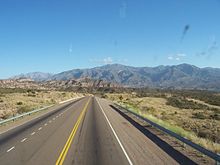
Travelling by car allows you to visit locations that are hard to reach by public transportation. Patagonia, in the South of Argentina, is a popular driving location among tourists due to the breathtaking views across many miles of open land.
Argentina generally recognizes valid drivers' licences from foreign jurisdictions. Drivers must be over 21. Car rental is readily available throughout Argentina, though it is a bit expensive compared with other forms of transportation.
Traffic regulations in Argentina are generally the same as in Europe and the U.S., but the locals often ignore the regulations. On roads and highways it's mandatory to have car lights on, even during daytime.
Highways are limited to the areas around large cities. Most of the country is connected by paved unlit two-lane roads ( rutas ) shared by buses, cars, and large trucks. Some places are accessible only by gravel or dirt roads. Indeed, some main roads in southern Argentina are unsealed, leading to 4x4 vehicles being more popular. This is particularly the case in the south. It is important to travel with a good map, and to be well informed about your route distances, road conditions and the estimated travel time.
In many small towns, particularly in the north, they may ration gasoline to ensure they have enough to sell until the next refuelling truck arrives. It's advisable to fill your tank at regular intervals when the opportunity arises.
By thumb [ edit ]
The hitchhiking club Autostop Argentina [dead link] began in Argentina in 2002, inspired by clubs in France, Germany, Italy and the United States. As a result, hitchhiking has become more acceptable among the younger generation, and raising a thumb at a highway is a symbol most people understand.
Hitchhiking in addition is a great and inexpensive way to get to know the real Argentina and its people. If you do get a ride, you will in general be treated with much generosity: Argentinians are very friendly and interested. Due to the lack of budget accommodation in remote regions and even larger cities off the touristy routes, as well as because of the large distances, it is advisable to carry a tent with you. There are many opportunities along the main highways to put it up—sometimes a little search is necessary. This way you can discover Argentina (at least its south) even with the most limited budget: €300 for 4-5 weeks is possible and still see the interesting and picturesque sights.
Everything south and including the La Pampa Province is comfortable and easy to hitchhike. Only infrequent traffic (through the center), other hitchhikers (near El Chalten , El Calafate and especially El Bolsón ) or bad weather might set you back. Hence, always have a backup plan (bus, tent, hike, etc.) and simply stay confident. You might in addition take a route which might seem longer, but is in the end much faster, i.e. Ruta 3 is very easy due to the high traffic and few competitors, but Ruta 40 has far less traffic, more competitors and is generally slower due to its conditions. Either way, many helpful tips can also be found in the hitchhiking guide of Wikivoyage .
Nevertheless, near Buenos Aires, Mendoza and Cordoba it is considerably more difficult to hitchhike, and the thumb of a woman is significantly more successful than the thumb of a man. A single man should count on long hours of waiting or simply luck in these regions. Just try it once or twice to find out whether it is possible where you are. Nevertheless, even though as woman it might be more successful, be cautious and vary especially as a solo woman: and never fall asleep and remain on the main roads.
On foot and navigation [ edit ]
Argentina is an excellent place for hiking and trekking, both in the western Andes, southern Tierra del Fuego and the wide Patagonia, providing many interesting trails. However, due to the often remote nature of these trails, it is important that you are well prepared and have a proper and reliable map with you. In addition, using GPS navigation adds an extra layer of safety, both in cities as well as the countryside. For reliable (offline) maps and comprehensive trails and map information, consult OpenStreetMap , which is also used by this travel guide, and by many mobile Apps like OsmAnd or Mapy.cz . Or just download the according GPX or KML files through Waymarked Trails for such trails on OpenStreetMap. (Note, you just need to change the OpenStreetMap relation ID to download the GPX or KML files through the same link.)
Talk [ edit ]
The official language is Spanish . Generally, most people speak Spanish using a local dialect, Castellano Rioplatense , which is subtly different from both the language of Spain and that of Central America . Most notably, the pronoun "tú" is replaced by "vos", and the you plural pronoun "vosotros" replaced with "ustedes", the latter being common throughout Latin America.
People from each city pronounce words differently as well. People from Buenos Aires speak differently compared to those from Spain and other Spanish speaking countries; example: chicken in Spanish ( pollo ) is pronounced PO-zhO or PO-SHO by the "Porteños" (residents of Buenos Aires), with the SH sound harder than in Spanish; unlike most other Spanish speakers of South America who pronounces it PO-yo . All Argentinians learn standard Castilian Spanish in school.
Rioplatense Spanish is also heavily influenced by Italian , even frequently being mistaken for it, a result of the large influx of Italian immigrants. Hand gestures derived from Italy are extremely common, and many colloquialisms are borrowed from Italian (for example: instead of saying "cerveza", which means beer, youngsters find "birra" cooler, which is in Italian). Most locals can readily understand most Spanish dialects, as well as Portuguese or Italian (especially due to its similarity to the local Spanish).
English is mandatory in high school and usually understood in at least a basic level in tourist areas. German and French can be understood and to some extent spoken by a few. A few places in Patagonia near Rawson have native Welsh speakers.
The interjection "che" is extremely common and means approximately the same thing as English "hey!". It can also be employed as a phrase known to someone you don't remember their names. Ex: "Escúchame, Che,...." Sometimes it is peppered throughout the speech, similar to the English phrase "yo," as in "What's up, yo?" Nonetheless, communication will not be a problem for any Spanish speaker.
Argentines will communicate with each other using lunfardo, a street dialect or slang. It is used together with Spanish by replacing nouns with their synonyms in lunfardo. As opposed to changing the original meaning, it just makes the phrase more colourful. An important aspect of lunfardo is that it is only spoken. For example, one knows the word dinero (money), but may use the word "guita" in order to refer to the same things. Lunfardo is composed of about 5,000 words, many of which do not appear in the dictionary.
See [ edit ]
For many visitors, Argentina as a country has the same seductive appeal as the tango for which it's famous. Just like that iconic partner dance, Argentina embraces you, constantly moving to the rhythm of the streets and improvising every step of the way.
Urban life [ edit ]
Its large cities all bustle with life. The famous capital, Buenos Aires , is the most visited city in South America and a place like no other. Of course, there's fancy cosmopolitan boutiques, top of the line nightlife and gourmet cuisine. However, it's the classic, unpolished side of the city that makes it a worldwide traveller's magnet. The downtrodden but colourful neighbourhoods where crazy traffic sounds drown out distant accordion tunes, the pleasant street-cafés and parillas (steak houses), busy outdoor markets and the lovely old centre with its European colonial architecture. San Telmo is the oldest neighbourhood of the city and a good place to indulge in the city vibe of cafés, street artists, tango parlors and antique markets in a colonial surrounding. The atmosphere is perhaps Buenos Aires' biggest attraction, but some of the main sights include Recoleta's cemetery and the Plaza de Mayo . Argentina's other big cities share the energetic buzz of BA, but have a distinct character of their own. Mendoza is a lively yet laid-back town, characterized by broad avenues. It's famous as a wine capital far beyond the borders of Argentina and a perfect starting point for the Argentina Wine Route along the hundreds of wineries in the area. As it's close to the Andes, it's also a good base for winter sports and other outdoor activities. The old university city Córdoba is known for its particular musical culture with the cuarteto as its number one music style. The city also boasts some of the best colonial heritage sights in the country. Bariloche , also at the base of the Andes mountains, is a major tourist destination, popular for its skiing opportunities, lovely beaches and chocolate shops.
Natural wonders [ edit ]
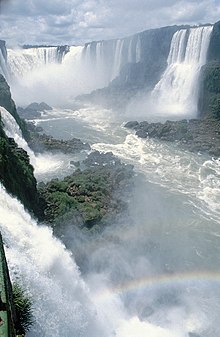
Fascinating as Argentina's urban life may be, the country's mighty natural attractions are at least as good a reason to come. The landscapes are incredibly various, from the high peaks of the Andes and the famous Perito Moreno Glacier to cacti-filled deserts, sandy Atlantic beaches and biodiverse wetlands. With some 30 national parks in the country, there's always a good place nearby to see some of the country's natural wonders. A highlight in the subtropical north are the spectacular Iguaçu Falls , easily one of the most impressive waterfalls on earth. Argentina's wildlife includes flamingos, penguins, caimans and capybaras, sea lions and -at times- even whales. Especially when you're visiting in autumn, the coastal town of Puerto Madryn is a must. From there you can easily make your way to Punta Tombo and Peninsula Valdes to go whale-watching and meet up close and personal with some of the million penguins who come to Patagonia each year to nest and raise their young. Head to El Calafate to organize your tour to the highly popular Los Glaciares National Park and see the famous glaciers and the icy Argentino Lake . Be amazed by the many colours and remarkable rock formations of Quebrada de Humahuaca , a mountain range in the north that extends far over the Bolivian border . Drive through and spot traditional villages and indigenous women and their goat herds. Other great destinations for nature lovers include the Ibera wetlands (with the most diverse fauna in the country) and Talampaya National Park , a primary site for archaeological and palaeontological finds.
Generally, Argentina is a country that charges excessively for its natural wonders and touristy sights, like the one mentioned above. And especially as a foreigner you generally pay twice as much as locals, even though costs of living do not differ much between Argentina and Europe. This can make Argentina an expensive destination and barely interesting for someone on a shoestring. However, there are great alternatives that require little money and are equally interesting, like El Chalten and the Viedma Glacier (the largest in Argentina), El Bolsón with great hiking options (even into Chile), (Lake) Epecuén , Cerro de La Ventana , San Antonio Oeste with the popular Las Grutas beach resort town and the picturesque Playa Las Conchillas and Playa Piedras Coloradas, Pinguinera Cabo Dos Bahias near Puerto Madryn , Bosques Petrificados (de Jaramillo) , the colorful hills of the Quebrada de Humahuaca in Jujuy and other impressive rock formations in the Salta Province , and many more. In addition, relying on hitch-hiking and travelling with a tent can bring down costs.
The website www.argentina.gob.ar has a list of destinations, Ruta de las Estrellas [dead link] , that pertains to astrotourism .
Some other highlights [ edit ]
The countryside in general is a most pleasant part of Argentina; laid-back and with a taste for life close to nature. Rural villages are a breath of fresh air compared to the country's hectic big cities and a nice way to experience traditional culture. The north is as South-American as Argentina gets. Its wine regions are famous throughout the world and an increasingly popular tourist destination. If the bustle of Buenos Aires is too much for your taste, Mendoza and Salta are an excellent choice. They also make for a good base to explore the scenic regional vineyards and friendly villages with the Andes mountains in the background. Salta is also the starting point for the Train to the Clouds , a heritage railway that seems to be running solely to provide some unforgettable panoramas for visitors. The Traslasierra Valley is a pleasant green valley and one of the many places where you can enjoy a world class spa , as hot springs naturally occur around here. Finally, if you like a day at the beach, Argentina has plenty to offer for you. Mar del Plata is one of the top destinations for beach resorts.
Do [ edit ]

Hiking and trekking [ edit ]
Argentina is a great country to seek out the nature, glaciers, lakes and mountains for a couple of days with a tent, sleeping bag and cooking ware. Many of the above-mentioned sights are spotted with beautiful hiking trails of varying quality and level, like El Chalten , San Carlos de Bariloche , or El Bolsón —read there for more information on specific trails. Often you will have to climb up a mountain to see a glacier or a lake, just to return later—in that case consider leaving your (heavy) luggage where it cannot be found and enjoy the trail without the burden, but remembering where you left your backpack before.
Walking tours [ edit ]
Buenos Aires has a number of walking tour options. They include the typical tours you may find in any city, as well as interesting options including free walking tours, downloadable MP3 walking tours, and even running tours.
Sports [ edit ]
The most popular sport in Argentina is football (soccer), and it is often said that football is not just a sport but a religion. If you come to Argentina, you shouldn't miss the chance to experience a professional match live. Argentina's top professional football league is the Primera División , and the fans are very passionate. The Argentinian national team is also one of the world's footballing powerhouses, having won the FIFA World Cup 3 times (in 1978, 1986 and 2022), and matches against Brazil and England in particular are very charged affairs.
Football teams [ edit ]
Five teams, all from Buenos Aires and its immediate area, are the historic elite of Argentine football and collectively known as "Los 5 grandes".
- Boca Juniors – famous stadium "La Bombonera" where Diego Maradona played.
- River Plate – Stadium "El monumental de Nuñez" where Argentina won the 1978 FIFA World Cup.
- Racing Club – The first Argentine team to win the Club World Championships.
- Independiente – won the most Copa Libertadores
- San Lorenzo
Other prominent teams include:
- Rosario Central – Stadium: "El gigante de Arroyito". Rosario is about 300 km/190 mi by road from Buenos Aires.
- Newell's Old Boys – Rosario Central's crosstown rival, where Gabriel Batistuta played. Lionel Messi played in its youth program before moving to Spain as a teenager.
- Vélez Sarsfield (European SouthAmerican Cup Champion in Tokyo 1994). Another Buenos Aires-area club.
- Estudiantes de La Plata – World Champion '68, Champion of America 1968 - 1969 - 1970 - 2009. Still another club in greater Buenos Aires; Juan Sebastián Verón played here.
- Colón de Santa Fe – team with the largest number of supporters; based in the city of Santa Fe, about 170 km/100 miles up the Paraná River from Rosario
The rivalry between the Buenos Aires clubs of Boca Juniors and River Plate, known as El Superclásico , is by far the most intense in Argentina, with rioting and even stabbings between fans of the two clubs being a regular occurrence.
Other sports [ edit ]
Rugby and basketball ( básquet ) are also popular. Bahía Blanca in particular is regarded as the hotbed of Argentine basketball, producing more than its share of the country's top players, most notably Hall of Famer Manu Ginóbili.
Argentine polo is famous throughout the world, and the country is home to all of the highest ranked players today. Introduced by British settlers in the 1870s, skillful gauchos adopted it and the passion caught like wildfire. The Argentine Polo Open, usually played on early December every year, is a must for polo fans from all over the world. The sport's governing body is the Asociacion Argentina de polo and its webpage lists all the official tournaments held each year. Argentina is also well known for the many polo clinics held on clubs and farms around Buenos Aires.
Tennis has been growing in popularity with the Argentina's steady production of top players since the 1980s.
Field hockey has also became a popular sport, especially among women. The National Women's Field Hockey Team, Las Leonas ( The Lionesses ), has grown in the past years and developed into a now competes against the best in the world.
Car racing is popular too: The main leagues are Turismo Carretera (Ford vs Chevrolet), TC2000 (Touring Cars) and TopRace. The most important racetrack in Argentina is in Buenos Aires is Autódromo Oscar Alfredo Gálvez.
Golf in Argentina is an increasingly popular sport thanks in part to the success of Argentinian players such as Ángel Cabrera, Andrés Romero and Eduardo Romero. There are around 280 courses in the country, most around Buenos Aires and including such well-known names as the Jockey Club, Olivos and Hurlingham. On the Atlantic coast in Mar del Plata are a couple of courses that have held international events, and Patagonia has excellent resort courses such as Llao Lloa, Arelauquen and Chapelco (a Nicklaus design), as well as the 9-hole course in Ushuaia.
Itineraries [ edit ]
- Tren de las Sierras
- National Route 40 (Argentina)
Buy [ edit ]
Money [ edit ].
The official currency of Argentina is the peso (ISO: code: ARS ), denoted by the symbol " $ ". It is divided into 100 centavos. Coins come in denominations of 5, 10, 25, 50 centavos, 1, 2, 5 and 10 pesos. Banknotes are issued in values of 5, 10, 20, 50, 100, 200, 500, 1,000 and 2,000 pesos. Be prepared to receive small change in the form of golosinas (candies/sweets), especially in Chinese supermarkets. Because the largest banknote is 2,000 pesos (roughly US$2.50 as of late 2023), cash payments often involve carrying stacks of banknotes.
Since 1969 thirteen zeroes have been dropped (a factor of ten trillion), the peso has been revalued again and again, and its name changed.
Inflation [ edit ]
In December 2023, the peso was devalued by 50% against other currencies. Any price information must be treated with a lot of caution and is probably unreliable. Most accommodations post their prices in US dollars online—prepare yourself for discussions on the corresponding price in pesos.
Banks [ edit ]
Banks are generally open from 10:00 to 15:00 and only on weekdays.
ATMs [ edit ]
ATMs are the most convenient but on the other hand quite expensive source of cash. In general, ATMs in Argentina charge very high additional fee when using a credit card, independently of your credit card conditions at home. ATMs should be used only in banks or ATMs that acted as the banks' branches. Just like in most cities, independent ATMs (not affiliated with any bank) are considered less safe.
Most ATMs strictly limit withdrawals on foreign cards. Most machines have a withdrawal limit of around AR$10,000 and a fixed fee of AR$600-1000 (Mar 2021). RedBrou ATMs have been good bets.
Sometimes the machines also dispense US dollars for international bank cards that are members of the Cirrus and PLUS networks. Visitors from Brazil can find many Banco Itaú agencies all over the city.
Western Union [ edit ]
You can send yourself cash via Western Union online. Western Union uses a US dollar-to-peso exchange rate that is similar to the MEP (foreign credit card exchange rate). It is a far better rate than the official exchange rate, but not as high as the highest black market rate. On the other hand, with Western Union, you do not have to fear getting counterfeit ARS currency.
You will get an email confirmation within a few minutes allowing you to collect your Argentinian pesos at their nearest office or shop. You must set up an account to send yourself money.
Money exchange [ edit ]
Cash exchange rates for US dollars are very competitive, and it may be more advantageous to bring a large sum of US currency, considering the high fees of ATMs. It is easy to stack up US dollars in Uruguay because its ATMs do allow US dollar withdrawals at no or a low fee. However, of course then you will also have to watch this money all the time. So, a mix of both, US dollars and ATM, is probably the best.
Exchange rates at official Bureau de Change in Argentina are very competitive with rates being barely 1% off the official interbank rate. Also, many of the larger banks (like Banco de la Nación Argentina ) exchange money at competitive rates, even euros. As of 2019, expect to lose 10-20% when buying Argentenian pesos with Chilean pesos as most banks do not exchange them. The bigger the city the easier it gets to exchange money, even the oddest currencies—see Buenos Aires#Buy . You might need a passport with banks though.
Black market currency dealers, called arbolitos ("little trees") and operating from cuevas ("caves"), can be found yelling "Cambio", with Florida Street in Buenos Aires being particularly notorious. At so-called "blue dollar" ( dólar blue ) currency exchanges you can get up to AR$330 as of December 2022 (roughly double the official rate). The black market is illegal, so take all possible precautions to avoid getting ripped off, and remember that your money may be confiscated if you are busted by the police.
Hostel owners will sometimes be willing to exchange US dollars. Check the notes received and the current and up-to-date rates .
Credit cards [ edit ]
The situation for foreign travelers using non-Argentine credit cards changed dramatically at the end of 2022. In short, the Argentine government established a new exchange rate for such transactions, called the "MEP" rate. As of December 2022, major international credit cards such as Visa began to process transactions at the new MEP rate. At the end of January, when the black market exchange rate was about 375 ARS/USD, Visa processed transactions at 330 ARS/USD. In addition, foreigners using foreign credit cards at hotels in Argentina are not charged the 21% VAT charged to Argentines.
Credit cards are used less commonly in Argentina than in the USA or Europe. Many businesses in the city accept them and you can expect any major chain — supermarkets, fast food, clothing stores, etc. — to also accept them. The standard 10% tip in restaurant is often expected to be paid in cash, even when you pay the bill by credit card. Bear in mind, tipping is only expected when the establishment does not already charge you for "cubiertos" (literally, utensils. In practice it means "table service").
If you use a debit or credit card, the checkout operator in places like supermarkets will often require you to present both your card and a form of identification such as a drivers' licence. Present both simultaneously at checkout and with confidence. A lack of confidence will lead to a request for your passport as identification. For larger purchases such as long-distance bus tickets you will need to present your passport and your credit card. Although this makes shopping difficult, do try to keep your passport in a location such as a hotel-room safe.
PIN cards have become the most common ones and should be accepted anywhere, as well as magnetic band cards. PINs should be accepted but if not, the shop attendant will ask you to sign the invoice. Contactless credit cards have begun to be accepted as of 2023.
Traveller's checks [ edit ]
They are rarely used and may be difficult to exchange, but there is an American Express office at San Martin Plaza in Buenos Aires that will take American Express' Traveller's Checks. Also, Banco Frances will cash them with proper identification.
Tipping [ edit ]
There is no obligation to tip in Argentina although it is considered customary. Some restaurants already charge customers with "cubiertos" (table service). In these cases tipping is not expected. Sometimes rounding up or telling them to "keep the change" is enough on small checks, deliveries, gasoline tenders, etc. Leaving at least a 10% tip is considered kind and polite at restaurants, cafes, hotels, beauty parlors, barbers, ushers and car-washes. Tipping bartenders is not customary. Leaving no tip when feeling unsatisfied is not an uncommon gesture, and it's interpreted as such. Taxi drivers do not expect to be tipped.
Another local custom is to tip the ushers in theatres and opera houses when they're also in charge of handing out the programmes; one may request one without tipping, at the risk of being considered cheap.
Service fees are included in most upscale hotels and restaurants, usually around 15%. These fees can appear in the menu as "valor del cubierto", "servicio", or simply "cubierto". By law it is mandatory that this item is represented in the same text size as the rest of the menu items.
Shopping [ edit ]
The fashion and art scenes are booming. Buenos Aires' signature European-South American style overflows with unique art pieces, art deco furniture, and antiques. Local fashion designers, who are becoming a source of inspiration for the U.S. and European high-end markets, compose their collections based on lots of leather, wools, woven fabrics and delicate laces with a gaucho twist. At times, the exchange rate can present good value for international tourists.
Fashionable clothing and leather products can be found in most commercial areas; jackets, boots and shoes are easily available. However, Buenos Aires has a relatively mild climate, so truly cold-weather gear is harder to find here. Long coats or heavy gloves may not be in stock; similarly, jeans and other basics have a thin construction compared with those in cooler countries. The Andes regions and Patagonia are considerably colder in the winter, so thick clothing is much easier to find here.
Electronics are not cheap, as they are subject to heavy import tariffs. The price of music, books, and movies lags slightly behind changes in the exchange rate and can offer a bargain if the volatile exchange rates are in your favour.
Most free-standing shops in Buenos Aires are open 10:00-20:00 on weekdays, and some of them also Saturdays and Sundays, depending on what area of the city they are in. Enclosed malls, however, set their own hours, and are also open on the weekends.
Most places outside of the city of Buenos Aires, where most stores remain open during a siesta, still observe a siesta from approximately noon until 16:00; almost all businesses are closed during this time. The precise closing hours vary from store to store, according to the preferences of the owner. Shops and offices generally open again in the evening until 21:00 or 22:00.
Eat [ edit ]

Argentinian breakfasts are somewhat light compared to what those from English-speaking countries are accustomed to. Typically, it consists of a hot drink (coffee, tea, milk) with some toast, medialunas (croissants, literally "halfmoons") or bread.
Hotels typically provide a free buffet consisting of coffee, tea, drinkable yogurt, assorted pastries and toast, fruit and perhaps cereal. These kinds of breakfasts are also readily available in the many cafes.
Lunch is a big meal in Argentina, typically taken in the early afternoon. Lunch is so big because dinner is not until late: 20:30 to 21:00 at the earliest, more commonly at 22:00 or even later. Most restaurants do not serve food until then except for pastries or small ham-and-cheese toasted sandwiches (tostados), for afternoon tea 18:00-20:00. Tea is the one meal that is rarely skipped. A few cafés do offer heartier fare all day long, but don't expect anything more substantial than pizza or a milanesa (breaded meat fillets) or a lomito (steak sandwiches) outside of normal Argentine mealtimes. Dinner is usually eaten at 22:00 and typically consists of appetizers, a main course, and desserts.
North Americans should beware that Argentinians use the term "entrée" to refer to appetizers. This is common outside of North America but can surprise some Canadians and most Americans. In Argentina the main dish is a "plato principal".
The appetizers in Argentina typically consist of empanadas (baked pastries with a meat filling), chorizo or morcilla (meat or blood sausage), and assortments of achuras (entrails). For a main dish, there is usually bife de chorizo (sirloin or New York Strip steak) and various types of salads. Dessert is often a custard with dulce de leche and whipped cream topping.
Beef is a prominent component of the Argentine diet, and Argentine beef is world-famous for good reason. Argentina and Uruguay are the top 2 countries in meat per capita consumption in the world. Definitely check out Argentine barbecue: asado, sometimes also called parrillada, because it is made on a parrilla, or grill. Food in Argentina is virtually synonymous with beef. The beef is some of the best in the world, and there are many different cuts of meat. Lomo (tenderloin) and bife de chorizo are excellent. "Costillas" (ribs) is considered by locals the real "asado" meat cut and is very tasty. North Americans will see that costillas are different to those at home. Argentinians cut ribs perpendicular to the bone. Having a parrillada dinner is one of the best ways to experience Argentine cuisine; preferably with a bottle of wine and a good amount of salads. In some popular areas, parrilladas are available from small buffets, or street carts and barbecue trailers. Skewers and steak sandwiches can then be purchased to takeaway.
Given that a large portion of Argentines are of Italian, Spanish and French descent, such fare is very widespread and of high quality; pizzerias and specialized restaurants are very common. A convention observed in Argentina is to treat the pasta and sauce as separate items, with each charged separately.
Cafés, bakeries, and ice-cream shops (heladerías) are very popular. Inexpensive and high-quality snacks can be found in most commercial areas, and many have outdoor seating areas. Empanadas (turnovers) containing meats, cheeses, or many other fillings can be bought cheaply from restaurants or lunch counters. The Alfajor is a must try snack of a two cookies (biscuits) with a dulce de leche filling and can be purchased at any local kiosco.
Smoking is now prohibited in all of Buenos Aires' restaurants and all of Mendoza's restaurants. In most cities, it's forbidden in all public buildings (cafés, shops, banks, bus stations, etc.), so it's better to ask before smoking anywhere.
Signature/national dishes
- Asado (barbecued meats)
- Empanada (baked pastries with a meat, cheese and/or vegetable filling)
- Milanesa (breaded meat fillets)
- Chorizo (sausage) and Choripan (with bread)
- Tarta de Jamón y Queso (baked pastry crust with ham and cheese filling)
- Guiso Criollo — with meat, vegetables and fruit
- Pizza — Due to the large number of Italian immigrants, Argentina has its own unique style of pizza.
Desserts and snacks
- Dulce de leche
- Flan con Dulce de Leche
- Torta de Ricotta
Drink [ edit ]

Yerba mate (pronounced in two syllables, 'MAH-teh') is a traditional Argentine herbal drink, prepared in a hollowed-out gourd which is passed around in a social setting and drunk through a metal straw. Although usually drunk hot, mate can also be served cold, usually known as "tereré"; the version that is preferred in Paraguay and Mato Grosso, Brazil. Mate contains less caffeine than coffee, but contains other vitamins and minerals that give it a stimulating effect, particularly to those who are not used to it. It is naturally rather bitter, so it's not uncommon to add sugar, though it's polite to ask before adding sugar to it. The drinking of mate with friends is an important social ritual in Argentina. The informal tea ceremony is led by a "cebador" or server and people arrange themselves in a "rueda" or wheel.
Argentina is renowned for its excellent selection of wine . The most popular being Mendoza, whose terrain seems to complement the European grape varietals with interesting notes not present when produced in other climates. The best way to experience and understand the selection of Argentine varietals is one of the many tasting events.
The legal drinking age is officially 18, although most establishments will serve anyone approximately 16 or older. Most restaurants serve a broad range of liquors . Beer is offered in drought form in a chopp (small glass) or served in bottles or cans, and is typically a light, easily drinkable lager. The most popular locally made brands of beer are Quilmes, Isenbeck, Schneider and Brahma (although it's Brazilian). Widely-available imports include Warsteiner, Heineken, Budweiser and Corona. There are now many small pubs and bars in Buenos Aires that brew beer on premises, but most of these offer a poor quality product compared to what is widely available in parts of Europe and the USA. In the Buenos Aires area, the Buller Brewing Company in Recoleta and the Antares Brewery in Mar del Plata offer excellent handcrafted English-style ales. Ask if there are "cervezas artesanales", locally hand crafted beers.
Fernet is widely consumed by Argentinians, especially in Córdoba, Santa Fe and Buenos Aires. It came from Italy, and is a very bitter drink made from herbs, with 40% alcohol and dark brown in colour. Due to its bitter taste, it is usually mixed with Coke (served in bars, pubs, clubs), and if you go to an Argentinian house they will have Fernet and Coke to offer you. Also, Fernet is usually served as a digestif after a meal, but may also be enjoyed with coffee and espresso, or mixed into coffee and espresso drinks. It may be enjoyed at room temperature or with ice.
Cider ( sidra ) is the typical drink at celebrations, especially at Christmas. On other important occasions such as birthdays, anniversaries or weddings, sidra is the drink chosen for the toast.
Cafés often have fresh-squeezed fruit juices , which is otherwise hard to find.
Sleep [ edit ]
A wide range of accommodation possibilities are available in Buenos Aires and the rest of the country, from student hostels to homey bed and breakfasts to trendy boutique hotels in the city to luxurious palaces and modern five-star hotels. There are also many beautiful lake-side lodges in Patagonia, and fabulous regional farms ( estancias ) outside the cities.
Many vacation cabañas (cabins or weekend houses) are available for short-term rent directly from the owners in the mountains, seaside, and in rural areas. Drive around and look for signs saying alquiler ("rental"), or check the classified section of any major newspaper.
Argentina is a vast country and camping is possible at many places (free or including amenities), especially near the beach. In addition, many villages and towns offer inexpensive "municipal camping". However, consider that many grounds are private property, so you should not camp here. Consult OpenStreetMap , which many mobile Apps like OsmAnd or Mapy.cz use, to find places which have been tagged by other people as possible camping sites.
Learn [ edit ]

Education in Argentina is free for everyone, no matter the level, and it has a good quality. Argentina is a popular destination for University students, especially from neighboring countries (such as Brazil , Paraguay and Uruguay ). The most pretigious university of the country and one of the most important universities of Latin America is the University of Buenos Aires . It have excellent undergraduate and postgraduate programmes and are internationally recognised, with exchange programmes with various universities in many countries around the world.
Apart from Buenos Aires, Mendoza is another popular and excellent place to take Spanish lessons for those who want a more idyllic setting (see the entry for Mendoza for details).
There are also a lot of public and private quality institutes who give Spanish lessons, and many more for Tango lessons, Argentinean art and literature and architecture.
Work [ edit ]
Volunteering (and learning Spanish at the same time) is big in South America and thus also in Argentina. General information on the South America article .
Cope [ edit ]
Facebook has an Argentina & Chile Backpacker / Traveler group where you can find other travellers and up-to-date information on the country. In general, also see South America#Cope .
Stay safe [ edit ]
Lately Argentina has seen a rise in crime directed towards tourists, it is well known that tourists bring hard currency to Argentina to avoid the official exchange rate. Exercise extra caution here, don't go to Western Union alone, be careful changing on the street, and bring a lock for your bags, take the $1-2 Uber instead of walking at night. The 500 or so dollars you may bring represents 3 months at the minimum wage. Be careful.
Argentina has a relatively high traffic mortality rate, with about 20 road deaths per day, and with more than 120,000 injured people each year, including tourists. Pedestrians should exercise extreme caution. Do not jaywalk if you do not feel comfortable, and be careful crossing even when allowed.
There is plenty of activity and foot traffic throughout the night. Nice areas have a very thorough police presence, perhaps one officer per 3 blocks, plus store security and auxiliary patrols. Public security in all major cities like Buenos Aires , Córdoba and Rosario is handled by the Federal Police and the National Gendarmerie or the Naval Prefecture, especially in the Puerto Madero area of Buenos Aires.
As in any large city, certain particular neighbourhoods in Buenos Aires and other cities are very dangerous. Some shady neighbourhoods include Retiro, Villa Lugano, La Boca and Villa Riachuelo. Ask trusted locals, such as hotel desk staff or police officers, for advice. Pay attention to your environment and trust your instincts. If an area seems questionable, leave.
Many people in the street and in the subway hand out small cards with horoscopes, lottery numbers, pictures of saints, or cute drawings on them. If you take the card, the person will ask for payment. You can simply return the card along with a no, gracias. or simply in silence if your Spanish is not good. Persistent beggars are usually not dangerous; a polite but firm no tengo nada ("I don't have anything") and/or hand gestures are usually enough.
Most crimes involve petty theft (pickpockets) in the subway and on crowded city streets, and especially inhabitant from Buenos Aires have a story to tell, which is also why many people carry their bags in front of them. In most cases, if your wallet is stolen, you won't even notice until hours later. However, paying attention to your stuff, will mostly prevent this from happening. Never hang your purse or bag from the back of your chair in a cafe or restaurant—stealthy theft from such bags is common. Keep your purse or backpack on the floor between your legs while you eat. Petty theft is common but seldom, like in a few other European cities like Paris or Naples. Violent robberies are uncommon, and mostly only happen where you would expect them, at night in a lone street in the wrong quarter. In the unlikely event that you are confronted by a mugger, simply hand over your valuables; they are replaceable and the muggers may be on drugs, drunk, have a knife or a gun.
Popular demonstrations are very common in Buenos Aires, and are best avoided by tourists as these demonstrations sometimes grow into violent confrontations with the police or National Gendarmerie, particularly as they approach the government buildings in the city center.
Since 2005 the government has cracked down on illegal taxis very successfully. Petty crime continues (like taking indirect routes or, less commonly, giving counterfeits in change). Taxis that loiter in front of popular tourist destinations like the National Museum are looking for tourists. Stay away from them. Your chance of falling prey to a scam increases in these situations. Stopping a taxi a block or two away on a typical city street where others locals would do the same is good choice. Also having small bills will help you avoid issues mentioned, as well you will often find taxis that don't have change for 100 peso notes.
Carry some ID with you, but not your original passport; a copy (easily provided by your own hotel) should be enough.
'Villas' or ghettos, usually composed of wooden or steel plate shacks, should also be avoided due to the high crime rate in these areas. Should you want to visit one of these, you should only do so as part of a guided tour with a reputable guide or tour company.
Drug use, while legal in Argentina, is frowned upon by most inhabitants. Alcohol is generally the vice of choice here. Paco , a crack-like mix of by products from the cocaine manufacturing process, is a serious problem, and its users should be avoided at all costs.
It was reported in 2007 that security workers at airports were stealing electronics, sun glasses and jewellery from checked luggage. This has not been reported since but it is always wise to keep all valuables in carry-on luggage.
Police officers will often ask for a bribe during a traffic stop, although it is reported they are not overly pushy.
Natural disasters [ edit ]
Tornadoes [ edit ].
The central and northern Argentinian provinces (including La Pampa , Santa Fe , Buenos Aires , Entre Ríos , Córdoba , Corrientes , Misiones , the north of Río Negro , south of San Luís , central and eastern regions of Formosa and southeast of Santiago del Estero and Chaco provinces) are part of the South America Tornado Corridor , the second most tornado-prone area in the world (behind the United States Tornado Alley). Monitor local media notices and if you see that the sky is dark, the light take on a greenish-yellow cast or a loud sound that sounds like a freight train, this could be an indication of a tornado. Find shelter immediately.
Refer to the tornado safety article for analysis of the issues here.
Emergency numbers [ edit ]
- Ambulance ( Immediate Health Emergency Service , SAME in Buenos Aires): 107
- Firemen ( National Firemen Corps ): 100
- Police ( Argentine Federal Police ): 911 mostly, might be 101 in some smaller cities
- Tourist Police: +54 11 4346-5748 / 0800 999 5000
Stay healthy [ edit ]

Visiting Argentina doesn't raise any major health worries. Certain vaccinations may be necessary for visitors, depending on what parts of Argentina you plan to visit. Yellow fever vaccinations are recommended for those visiting the Northern forests. If you missed your vaccination at home, it is possible to receive a free yellow fever shot in Argentina, in one of the bigger cities. This can be of advantage if you travel further to other Amazonian countries. However, be prepared to be queue at the very end—first the locals are treated. Also, there are specific days of the week when the vaccination takes place.
Dengue , a mosquito borne illness, is a serious and potentially fatal illness, but only a risk in the far north. Mosquito bites should be prevented at all costs in the far north, where they have many bug repellents, from lotions to sprays, as well as citronella candles, and 'espirales' (a spiral shaped incense). These are purchasable at most kiosks (kioskos) or pharmacies.
Different climate conditions might take your body by surprise, so be aware of the weather before you arrive. An upset stomach is the most you're likely to have to worry about as your body adjusts to local micro-organisms in the food.
It's also best to ease yourself gently into the local diet – sudden quantities of red meat, red wine, strong coffee and sweet pastries can be very unsettling for a stomach used to gentler repasts – and though tap water in Argentina is safe to drink, if sometimes heavily chlorinated, you may prefer to err on the side of caution in rural areas in the north of the country.
Although oral contraceptives are sold over the counter, without a prescription, a woman considering taking them is well advised first to consult a wise and licensed physician about their proper use, as well as possible contraindications and side effects.
Hospitals are free. They won't charge you for any treatment, but it is customary to offer a contribution, if you have the means. In public/state run hospitals, it is now illegal for any hospital employee to receive or even ask for payment. This does not include private health care facilities, or for medicines.
Sun block is recommended in the north of the country, where the heat can be intense with 38°C (100°F) common in some areas. Heat rash, dehydration, and sunburns are common for first time visitors. The atmospheric ozone layer in Argentina has thinned considerably, so the ultraviolet radiation, which is harmful to health, is very strong. The ozone problem is at its worst during midday and afternoon hours in spring from September to November and in summer from Christmas to March. It is advisable to protect your skin with clothing and to use products that protect against ultraviolet radiation.
Respect [ edit ]
Generally speaking, Argentines are expressive and emotive conversationalists.
Communication style [ edit ]
Compared to other South American nations, Argentines are often seen as more direct and forthright in their communication style. Try not to be offended by the way they speak; in most cases, they rarely intend to make you feel bad or uncomfortable.
Argentines tend to be very inquisitive and curious; it is common for them to ask people, even those they have just met for the first time, personal questions. If someone asks you personal questions, it is expected that you answer or share in return. Don't be put off by this; Argentines are not trying to interrograte or investigate you.
Argentines interrupt others and shout while conversing. What may seem like a shouting match in public may actually be a passionate, engaging discussion.
Argentines, in general, are notorious for their regular use of profanity. Don't be put off by this as people don't intend to make you uncomfortable in any way.
Greetings [ edit ]
Cheek kissing is very common in Argentina, especially in bigger cities, among and between women and men. People make contact with right cheeks, and make a light "kiss sound" but not touch the cheek with their lips (only once, two kisses -right and then left- is very rare). When two women, or opposite sexes first meet, it is not uncommon to kiss. Two men will first shake hands if they do not know each other, but will probably kiss when departing, especially if they have spoken for a while. Male friends cheek kiss every time when greeting, it is like a sign of trust. Trying to shake hands when offered a kiss will be considered odd, but never rude especially if you are an obvious foreigner.
In the rest of the country, regular handshaking applies. Also women will greet by kissing as described above, but it's reserved to other women and to men they are acquainted with.
Football [ edit ]

Football is the most popular sport in the country and many Argentines are passionate, die-hard fans of the sport. Iconic players like Diego Maradona and Lionel Messi, along with successes in FIFA World Cup matches, further fuel their love for the sport.
While discussing the sport may be an icebreaker, be aware that praising or wearing jerseys of rival clubs or national teams (especially Brazil and England ) may attract negative attention, rude remarks, or even lead to physical confrontations. To be on the safe side, only wear an Argentine national team jersey and discuss highlights of the Argentine national team.
Punctuality [ edit ]
Argentines have a casual and flexible view of time; the pace of life in Argentina is slow, many activities (plays and concerts, for instance) rarely happen as scheduled, and it is normal for Argentines to be late for casual appointments and social events. However, punctuality is expected for business meetings.
Buses, flights, and trains usually never leave on time, and public transportation delays are common, especially in big cities.
Sensitive issues [ edit ]
Avoid talking about the Falkland Islands ( Islas Malvinas ) and the dispute about Falklands War, with their English name. Argentines do not refer to the islands as "Falklands", but "Malvinas". These are very sensitive issues for many Argentines and can trigger a strong reaction and create an uncomfortable situation for you.
There is a degree of distrust and resentment towards the United Kingdom, particularly among older Argentines, especially due to the Falklands War. Avoid wearing any English and British symbols due to the above mentioned reasons. English and British flags as well as English national football (soccer) tops (who are rivals of the Argentine national football team during the World Cup) are definitely to be avoided. Although no assaults on people wearing them have been recorded, people might be very upset about them and you are very likely to receive very icy looks and treatment from the population.
Domestic politics are highly polarising and sensitive. Argentina has had a long history of political instability since the 1930s, and most ordinary folk are incredibly frustrated with their government and political leaders. The Perón years and the military juntas are particularly sensitive subjects. While it's not a social faux pas to discuss politics (Argentines tend to be vocal about political issues anyways), do not share your opinions on Argentine politics, even if you know a thing or two about the country's political landscape ― your opinions will not be welcomed and it may cause your Argentine counterpart(s) to think you are meddling in their country's affairs.
Do not compare Argentina with Brazil and Chile, because they are considered rivals, especially in the economic sphere.
Avoid comparing regional foods. This too can be a sensitive subject, as recipes and key ingredients vary from province to province.
Argentines take pride in their beef, and asking for ketchup or barbecue sauce on a steak is disrespectful. You should ask for salsa criolla or chimichurri.
LGBT [ edit ]
Same-sex marriage has been legal since 2010, and Buenos Aires is LGBT-friendly enough that it's been called the "gay capital of Latin America". But in small towns, or the more conservative north of the country, some people (especially older generations) might be shocked by public displays of homosexual affection.
General [ edit ]
Religious sites: People do not have to cover their heads when entering a church or temple; Argentina has a liberal attitude towards religion compared to its Latin American neighbors. However, wearing shorts or miniskirts is not encouraged.
Beach: Sunbathing topless is not a common custom, although you can change clothes on the beach.
Connect [ edit ]

By phone [ edit ]
You can get a prepaid Movistar / Claro / Personal SIM card for a few pesos / free at phone shops, all you pay is about ARS20 (about US$5) for your initial credits. Inserting the SIM card into your unlocked mobile phone should work, although to register the SIM you might have to enter your passport (or any 9 digit) number. You then have your personal Argentinian phone number, which is very useful to keep in touch with other travellers, either by calling or by writing text messages. Calls cost around ARS1 per minute. Still, having to register the SIM card is extremely rare.
Receiving calls is usually free, except for international calls , and some cross network / inter-city calls. Hence, buying a SIM card purely to keep in touch with people overseas may not be worth it.
To reload you can buy small cards with secret numbers at many kiosks, but the easiest way is just to ask for "Recarga Virtual" and tell the shop assistant your Phone number and company, and the amount of pesos you want to recharge.
Not related to mobile phones, there are similar cards with credits for international calls. You get them at so called locutorios , where you can also use the phone booths. You dial a free number to connect to the service, then your secret number for the credits, and then the international phone number you want to call. Using these cards, a one-hour call to Europe will cost about 10 Pesos (3 US-Dollars). Don't call without such cards or even from your hotel — it will be way more expensive.
The phone numbering plan in Argentina is hopelessly complicated for foreigners. Do check out the Wikipedia article about it to find out more.
- Directory Listing ( The White Pages ): 110
- International Operator: 000
- National Operator: 19
- Collect National Calls: 19 from regular phones, *19 from public phones
- Mobile phone numbers start with 15 or 11
- Regional code for Buenos Aires: 011
Other useful phone numbers include:
- Official Time: 113
- Consumer Advocacy: +54 11 5382-6216 or 6217
All 2 and 3-digit numbers are free, except the official time service (113).
All 0800 numbers are toll-free numbers, except if you call from a mobile phone.
Long-distance calls from Argentina: You may use calling card, ARS0.18/min or ARS0.59/min for calling from Argentina to USA.
By internet [ edit ]
Most cafés and restaurants offer free Wi-Fi with an advertisement in their windows. All you need to do is buy a coffee and ask for the password. Public WiFi is also very common in Buenos Aires with great speeds. The network name will be BA Wifi
Go next [ edit ]
Argentina borders Brazil and Uruguay to the northeast, Chile to the east, and Bolivia and Paraguay to the north.
The capital of Uruguay, Montevideo , is just an hour away by ferry from the Argentinean capital Buenos Aires . Porto Alegre , in the Brazilian state of Rio Grande do Sul, is a 14-hour drive from Buenos Aires. A popular summer vacation destination for many Argentines is Florianópolis , in the Brazilian state of Santa Catarina , a 19-hour drive away or by flight from Buenos Aires.
- Has custom banner
- Has map markers
- Articles with dead external links
- Go listing with no coordinates
- Has Geo parameter
- South America
- All destination articles
- Outline countries
- Outline articles
- Country articles
- Pages with maps
Navigation menu

Argentina Travel Guide
As the world’s 8th largest country, the diversity of Argentina is incredible. From the snowy peaks of Patagonia, to the desert beauty of the north, to the charm of Buenos Aires, Argentina is a country that you’ll quickly fall in love with.
I lived in Buenos Aires, Argentina’s charming capital, for almost two years. In this Argentina travel guide, you’ll find my guides to exploring Buenos Aires and beyond, including the north of the country, wine regions and Patagonia.
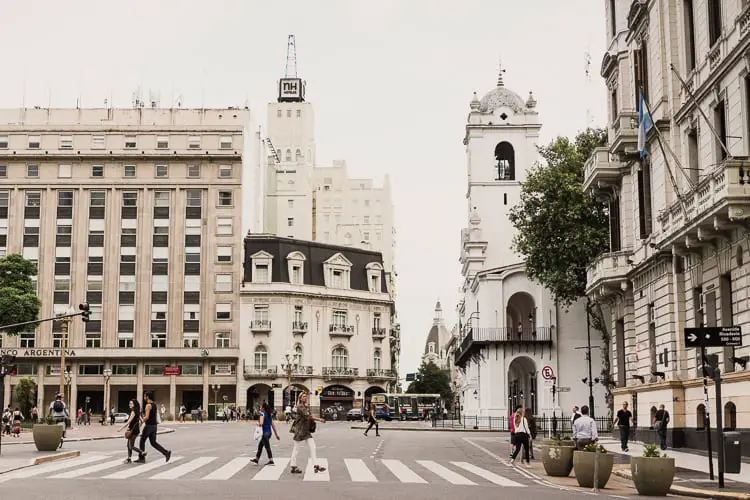
Essential Argentina travel information
- Capital: Buenos Aires
- Language: Spanish
- Population: 45,195,774
- Area: 2,780,400 square kilometres (1,073,500 sq miles)
- Currency: Argentine Peso
- Electricity : 230V 50HzType I connectors (same as Australia, New Zealand and Uruguay)
- General emergencies (in Buenos Aires): 911
- Police: 101
- Medical emergencies: 107
- Telephone country code : +54
Top 5 Argentina travel experiences
1. Gazing up in awe at the grand buildings in Buenos Aires and then partying until the wee hours
2. Driving through the dusty landscapes of the north of the country
3. Taking a boat ride around the tip of Patagonia
4. Sipping wine in Mendoza or Cafayate and trying the local varietals of Malbec and Torrontes
5. Hearing for the first time the thunder of Iguazu Falls , a series of 200 waterfalls on the border of Argentina, Brazil and Paraguay
Argentina travel inspiration
Read all the articles I’ve written about Argentina with these detailed planning tips and guides to the best places to visit.
Travel planning
Plan a Trip to Argentina: 19 Travel Tips for First-Time Visitors
Argentina Itinerary Ideas: How to Plan a Trip for 1-4 Weeks
2 Weeks in Argentina: The Ultimate Argentina Itinerary
45+ of the Best Things To Do in Argentina
Best Time to Visit Argentina: Find the Ideal Time for Your Trip
Navigating Money in Argentina: A Traveller’s Guide to Money Matters
Is Argentina Safe to Visit?
17 Tips + Tricks for Renting a Car in Argentina
Tips for Buying Travel Insurance for Argentina
15 Reasons to Visit Argentina
9 of the Most Romantic Destinations to Honeymoon in Argentina
Typical Argentinian Food: 31 Traditional Dishes You Need to Try
Visit Buenos Aires
The Must-Do 3 Days in Buenos Aires Itinerary: Everything to See, Do and Eat
What to Do in Buenos Aires: 101+ Ideas for Your Itinerary
Where to Eat in Buenos Aires: 50+ of the Best Restaurants (and Bars) to Try
Where to Stay in Buenos Aires, Argentina: A (Former) Local’s Guide
The 6 Best Estancias Near Buenos Aires, Argentina
What to Buy in Buenos Aires: Take These Great Souvenirs Home!
Inside Palacio Barolo in Buenos Aires: Step Into Heaven and Hell
Best places to visit in Argentina
15 Incredible Places to Visit in Argentina
North Argentina: A Mind-Blowing, 9-Day Argentina Road Trip Itinerary
A Guide to Cafayate Wine: Argentina’s Other Wine Region
Visiting Iguazu Falls: The Ultimate Guide to the Argentina and Brazil Sides
Ruta de los 7 Lagos: How to Drive, Bike or Tour Argentina’s 7 Lakes Route
Ice, Ice Baby: Trekking Perito Moreno Glacier in Argentina
The Best El Chaltén Hiking Trails: Trekking in the Prettiest Place in Patagonia
9 of the Best Things to do in Ushuaia, Argentina: The End of the World
MORE INFORMATION
ABOUT WORK WITH ME CONTACT PUBLISHED WORK
AFFILIATE DISCLOSURE
AS AN AMAZON ASSOCIATE I EARN FROM QUALIFYING PURCHASES
© 2024 REBECCA AND THE WORLD
Privacy Policy
I ACKNOWLEDGE THE WURUNDJERI AND BOON WURRUNG PEOPLE OF THE KULIN NATION AS THE TRADITIONAL OWNERS OF THE LANDS AND WATERWAYS OF THE AREA I LIVE ON. I PAY MY RESPECTS TO ELDERS PAST AND PRESENT AND CELEBRATE THE STORIES, CULTURE AND TRADITIONS OF ALL ABORIGINAL AND TORRES STRAIT ISLANDER PEOPLE ACROSS AUSTRALIA.

- Privacy Overview
- Strictly Necessary Cookies
This website uses cookies so that we can provide you with the best user experience possible. Cookie information is stored in your browser and performs functions such as recognising you when you return to our website and helping our team to understand which sections of the website you find most interesting and useful.
Strictly Necessary Cookie should be enabled at all times so that we can save your preferences for cookie settings.
If you disable this cookie, we will not be able to save your preferences. This means that every time you visit this website you will need to enable or disable cookies again.

No videos yet!
Click on "Watch later" to put videos here
Argentina Travel Guide – Everything You Need to Know

Argentina, the land of tango, football, and diverse landscapes, is a captivating destination for travelers. Located in South America, it offers a blend of cultural richness, natural beauty, and culinary delights. From the bustling streets of Buenos Aires to the breathtaking landscapes of Patagonia, Argentina invites tourists to explore its vibrant cities, experience its passionate culture, and immerse themselves in its awe-inspiring scenery. Whether you’re an adventure enthusiast, a food lover, or a history buff, Argentina has something special to offer every traveler. Get ready to tango your way through this enchanting country and discover its unique charm.
What’s the Best Time to Visit? 📅
The best time to visit Argentina as a tourist depends on your preferences and the specific regions you plan to explore, as the country’s vast size and diverse landscapes result in varying weather patterns throughout the year. Here’s a breakdown of Argentina’s seasons and the best times to visit different parts of the country:
- Spring (September to November):
- Spring is a delightful time to visit many parts of Argentina. The weather is pleasant, with mild temperatures and blooming landscapes.
- It’s an excellent time for outdoor activities in Patagonia, the Lake District, and the Andes Mountains.
- Buenos Aires and the wine regions, like Mendoza, offer pleasant weather for city exploration and wine tasting.
- Summer (December to February):
- Summer is a popular time to visit Argentina, especially for beachgoers and those looking to experience the vibrant culture of Buenos Aires.
- The coastal areas, such as Mar del Plata and Punta del Este, are bustling with tourists.
- It’s the best time for exploring the northern regions, including Iguazu Falls, which are at their fullest during this season.
- Autumn (March to May):
- Autumn is a lovely time to visit Argentina when the temperatures are still comfortable, and the fall foliage creates a picturesque backdrop.
- The wine regions, particularly Mendoza and Salta, offer grape harvesting and wine festivals.
- Patagonia and the Lake District remain pleasant for outdoor activities.
- Winter (June to August):
- Winter is ideal for skiing and snowboarding enthusiasts, with excellent conditions in the Andes resorts like Bariloche, Chapelco, and Las Leñas.
- Buenos Aires can be cold but less crowded, making it a good time for cultural exploration.
- Northern Argentina, including Salta and Jujuy, offers milder temperatures during this season.
In summary, the best time to visit Argentina varies depending on your interests. If you’re looking for pleasant weather and outdoor adventures, spring and autumn are ideal. Summer is perfect for beach vacations and experiencing Argentine culture, while winter caters to snow sports enthusiasts. Be sure to consider regional weather patterns when planning your trip, and keep in mind that Argentina’s seasons are opposite to those in the Northern Hemisphere.
What’s the Best Way to Get Around? 🚌
Getting around Argentina as a tourist is relatively straightforward, thanks to the country’s extensive transportation network. The best way to travel within Argentina depends on your budget, itinerary, and the regions you plan to visit. Here are some common ways to get around Argentina:
- Domestic Flights: Argentina is a vast country, and domestic flights are often the quickest way to cover long distances. Major cities like Buenos Aires, Cordoba, Mendoza, and Salta have well-connected airports. Several airlines operate domestic routes, and it’s advisable to book in advance for the best fares.
- Buses: Argentina has an extensive long-distance bus network that connects cities and towns across the country. Long-distance buses, known as “colectivos” or “micros,” are comfortable, affordable, and a popular choice for budget travelers. Companies like “Plataforma 10” and “Andesmar” offer online ticket booking.
- Trains: While not as extensive as the bus network, Argentina has some scenic train routes. The “Tren a las Nubes” in Salta and the “End of the World Train” in Ushuaia are popular tourist trains.
- Metro and Public Transportation: In Buenos Aires, the subway (Subte) and buses are convenient for getting around the city. Other major cities like Cordoba, Rosario, and Mendoza also have local bus networks.
- Taxis and Ride-Sharing: Taxis are readily available in most cities and can be hailed on the street or booked through apps like “Uber” (in certain cities) and “Cabify.” Always use official taxi services, and make sure the meter is running.
- Rental Cars: Renting a car can be a great option if you plan to explore remote regions or want more flexibility in your itinerary. However, driving in large cities like Buenos Aires can be challenging, and traffic congestion is common.
- Cycling: Many cities, including Buenos Aires and Rosario, have bike-sharing programs and dedicated bike lanes, making cycling a viable and eco-friendly way to explore urban areas.
- Walking: Exploring cities and towns on foot is a pleasant way to experience local culture and discover hidden gems. Buenos Aires, in particular, is known for its pedestrian-friendly neighborhoods.
- Boats and Ferries: If you plan to visit destinations like the Tigre Delta or travel to Uruguay (e.g., Colonia or Montevideo), consider taking boats or ferries, which provide scenic journeys.
- Guided Tours: For specific attractions and remote regions, guided tours can be a convenient way to explore. Tour operators offer a range of options, from day trips to multi-day adventures.
Before traveling, research the transportation options available in your chosen destinations and consider booking tickets or accommodations in advance during peak tourist seasons. Keep in mind that safety should be a priority, so choose reliable transportation providers and take precautions with your belongings, especially when using public transportation or taxis.
What’s the Official Language?
The official language of Argentina is Spanish. Here are some common Spanish phrases and words that can be useful for tourists traveling in Argentina:
- Hello: Hola
- Good morning: Buenos días
- Good afternoon: Buenas tardes
- Good evening/night: Buenas noches
- Please: Por favor
- Thank you: Gracias
- You’re welcome: De nada
- Excuse me / Sorry: Perdón / Disculpa
- What’s your name?: ¿Cómo te llamas?
- My name is [Your Name]: Me llamo [Tu Nombre]
- How are you?: ¿Cómo estás?
- I’m fine, thank you: Estoy bien, gracias
- Goodbye: Adiós / Chau (informal)
- See you later: Hasta luego
- Please, I need help: Por favor, necesito ayuda
- I don’t understand: No entiendo
- How much does it cost?: ¿Cuánto cuesta?
- Where is [place]?: ¿Dónde está [lugar]?
- I need a taxi: Necesito un taxi
- Food: Comida
- Water: Agua
- Coffee: Café
- Beer: Cerveza
- Bill / Check: La cuenta
- Restroom / Bathroom: Baño
- Hotel: Hotel
- Airport: Aeropuerto
- Bus station: Estación de autobuses
- Train station: Estación de tren
- Emergency: Emergencia
Argentinians are generally friendly and appreciative when tourists make an effort to speak some basic Spanish. While many people in tourist areas and cities speak English, especially in hotels and restaurants, having a few essential Spanish phrases at your disposal can enhance your travel experience and help you connect with locals.
Where to Stay? 🏨
Argentina offers a wide range of accommodation options for tourists, catering to various budgets and preferences. Here are some popular types of accommodation and recommendations on where to stay in Argentina as a tourist:
- Hotels: Argentina boasts a wide selection of hotels, from luxury establishments to boutique and budget options. In major cities like Buenos Aires, Cordoba, and Mendoza, you’ll find a diverse range of hotels to choose from. In Buenos Aires, consider staying in the upscale neighborhoods of Recoleta or Palermo for a luxurious experience, or San Telmo for a more historic ambiance.
- Hostels: Hostels are prevalent throughout Argentina, making them a great choice for budget-conscious travelers and backpackers. You can find hostels in major cities and popular tourist destinations like Bariloche, Salta, and El Calafate. Hostels are also an excellent way to meet fellow travelers.
- Vacation Rentals: Websites like Airbnb offer a variety of vacation rentals, including apartments, houses, and even unique accommodations like cabins and ranches. This option provides more space and the opportunity to experience a destination like a local. Look for rentals in neighborhoods that match your interests and preferences.
- Estancias: For a unique experience in the countryside, consider staying at an estancia, a traditional Argentine ranch. You’ll have the chance to enjoy outdoor activities like horseback riding and gaucho demonstrations while experiencing rural life. Estancias are often found in regions like the Pampas.
- Eco-Lodges: Argentina’s natural beauty invites travelers to explore its national parks and remote areas. Eco-lodges and eco-friendly accommodations are available in places like Patagonia and the Iguazu Falls region, allowing you to connect with nature while minimizing your environmental impact.
- Boutique Hotels: Argentina is home to charming boutique hotels known for their unique character and personalized service. These are often found in historic city centers, offering a blend of comfort and cultural immersion.
- Albergues Transitorios: In larger Argentine cities, you might come across “albergues transitorios,” which are short-stay hotels often used by couples. These hotels offer privacy and a unique experience but are not typical tourist accommodations.
- Refugios: If you plan to trek in the Andes or explore Patagonia, refugios are mountain huts that provide basic accommodation for hikers. They are essential for multi-day treks in remote areas.
- Resorts: Argentina has a growing number of luxury resorts, particularly in regions like Bariloche and Mendoza. These offer top-notch amenities and beautiful surroundings, making them ideal for relaxation and outdoor activities.
When choosing accommodation in Argentina, consider your travel itinerary, budget, and the type of experience you desire. Booking in advance, especially during peak tourist seasons, is advisable to secure your preferred choice. Whether you prefer city life, rural escapes, or outdoor adventures, Argentina has a place to stay that suits your needs.
What to Eat? 🍽️
Argentina is renowned for its delicious cuisine, with a focus on meat, wine, and traditional flavors. When visiting Argentina as a tourist, be sure to try these must-try foods and dishes:
- Asado: Asado is Argentina’s iconic barbecue, featuring various cuts of beef, sausages (chorizo and morcilla), and often other meats like lamb and pork. It’s cooked on a grill or open flame and is a social and cultural event.
- Empanadas: These savory pastries are filled with ingredients like ground beef, cheese, ham, or vegetables. Empanadas are widely available and come in various regional styles.
- Milanesa: Similar to a breaded and fried schnitzel, milanesa features thinly pounded meat (usually beef or chicken) coated in breadcrumbs and served with lemon wedges.
- Chimichurri: This tangy sauce made with parsley, garlic, vinegar, and oil is a staple accompaniment for grilled meats. It adds a burst of flavor to your asado.
- Parrillada: A parrillada is a mixed grill platter that includes various cuts of meat and sausages. It’s perfect for sharing with friends or family.
- Matambre a la Pizza: This dish features thin slices of beef cooked on the grill and topped with tomato sauce, cheese, and sometimes herbs and vegetables.
- Provoleta: A popular appetizer, provoleta is a skillet of melted provolone cheese typically seasoned with oregano and chili flakes. It’s often served with bread.
- Locro: A hearty, traditional stew made with white corn hominy, beans, vegetables, and often pork or sausage. It’s especially popular during national holidays.
- Humita: A steamed corn cake made from a mixture of corn, cheese, and seasonings, wrapped in corn husks. It’s a delightful snack or side dish.
- Dulce de Leche: A sweet, caramel-like spread made from condensed milk, dulce de leche is used in various desserts, including alfajores, pancakes, and pastries.
- Alfajores: These sweet treats consist of two delicate cookies filled with dulce de leche and often coated in chocolate or powdered sugar.
- Argentine Pizza: Argentine-style pizza features a thick, doughy crust with a variety of toppings. Try a slice or two at a local pizzeria.
- Wine: Argentina is renowned for its wine production, particularly Malbec. Visit local wineries in regions like Mendoza to sample a wide array of Argentine wines.
- Mate: While not a food, mate is a traditional Argentine drink made from the leaves of the yerba mate plant. It’s a social ritual and is often shared among friends and family.
- Helado: Argentine ice cream, known as helado, is creamy and delicious. Try unique flavors like dulce de leche, maracuyá (passion fruit), and frutilla (strawberry).
- Cordero Patagónico: In Patagonia, lamb is a specialty. Enjoy it slow-roasted or grilled with regional seasonings.
- Fainá: Fainá is a chickpea flour flatbread that’s a popular accompaniment to pizza in Buenos Aires.
Exploring Argentine cuisine is an integral part of the travel experience, so be sure to savor these mouthwatering dishes and flavors during your visit.
What to See? 🔍
Argentina offers a wealth of stunning natural landscapes, vibrant cities, and cultural attractions. Here are some must-see places to visit when traveling to Argentina as a tourist:
- Iguazu Falls: Located in the north of the country, Iguazu Falls is one of the most impressive waterfall systems in the world. Explore the lush rainforest surroundings and take in the breathtaking views.
- Buenos Aires: Argentina’s capital city is a cultural hub known for its European-style architecture, vibrant neighborhoods, and rich history. Must-visit areas include Recoleta, San Telmo, and La Boca.
- Perito Moreno Glacier: Located in Los Glaciares National Park in Patagonia, this glacier is a marvel of nature. Witness the dramatic ice formations and listen to the creaks and groans of the glacier as it moves.
- Bariloche: Nestled in the Andes, Bariloche is known for its stunning lakes and snow-capped peaks. It’s a haven for outdoor enthusiasts, offering hiking, skiing, and delicious chocolate.
- Mendoza: Argentina’s wine country, Mendoza, is famous for its vineyards and wineries. Take a wine tour, sample Malbec, and enjoy the picturesque surroundings of the Andes.
- Salta: In the northwest, Salta offers a blend of colonial architecture, colorful landscapes, and indigenous culture. Explore the historic city center and take a trip to the Salinas Grandes salt flats.
- Cordoba: Argentina’s second-largest city is known for its vibrant arts scene, historic Jesuit churches, and the picturesque Sierras de Cordoba.
- Valdes Peninsula: A UNESCO World Heritage site, this peninsula is a prime spot for wildlife enthusiasts. See penguins, sea lions, and whales along the rugged coastline.
- Tierra del Fuego: Located at the southernmost tip of South America, Tierra del Fuego offers stunning landscapes and the city of Ushuaia, known as the “End of the World.”
- Quebrada de Humahuaca: This UNESCO-listed valley in Jujuy province features colorful rock formations, indigenous culture, and historic villages.
- El Chaltén: Known as the “Trekking Capital of Argentina,” El Chaltén is a gateway to some of the country’s most spectacular hiking routes, including those leading to Cerro Fitz Roy.
- Aconcagua: For adventurous climbers, Aconcagua is the highest peak in the Americas and a challenging ascent.
- Cafayate: Located in the Calchaquí Valley, Cafayate is known for its wineries and dramatic red rock formations.
- San Rafael: Visit this picturesque town in Mendoza province for its beautiful landscapes, including the Atuel Canyon and the Crystal Cave.
- Talampaya National Park: Explore the red rock formations, ancient petroglyphs, and rugged canyons of this protected area in La Rioja province.
Argentina’s diversity of landscapes, from the tropics of the north to the glaciers of the south, offers a wide range of travel experiences for tourists. Whether you’re into adventure, culture, or simply enjoying natural beauty, Argentina has something to offer every traveler.
What to Do? 📸
Argentina offers a wide range of activities and experiences for tourists. Here are some must-do things to make the most of your trip to this diverse and vibrant country:
- Tango Dancing: Experience the passion of the tango by attending a live tango show or taking a tango dance class in Buenos Aires, the birthplace of this iconic dance.
- Attend a Football Match: Immerse yourself in Argentina’s football (soccer) culture by attending a match. Boca Juniors and River Plate in Buenos Aires are two of the most famous teams.
- Sample Argentine Cuisine: Savor Argentine specialties like asado (barbecue), empanadas, milanesa, and dulce de leche. Don’t forget to pair them with Argentine wine or a traditional mate tea.
- Hike in Patagonia: Explore the stunning landscapes of Patagonia through activities like trekking in El Chaltén, visiting Perito Moreno Glacier, or hiking in Tierra del Fuego.
- Visit Iguazu Falls: Witness the awe-inspiring power of Iguazu Falls, and explore the surrounding rainforest with opportunities for wildlife viewing and boat rides.
- Wine Tasting in Mendoza: Take a wine tour in the vineyards of Mendoza, sampling Argentina’s renowned Malbec wines and enjoying scenic views of the Andes.
- Discover Argentine History: Visit historical sites like San Telmo in Buenos Aires, where you can explore colonial-era architecture and learn about Argentina’s past.
- Experience Gaucho Culture: Learn about the traditions of the Argentine cowboys, known as gauchos, by visiting estancias (ranches) in the Pampas region.
- Explore Cordoba’s Sierras: Hike, bike, or horseback ride in the Sierras de Cordoba, a beautiful mountain range offering outdoor adventures.
- Take a Train to the Clouds: Ride the Tren a las Nubes (Train to the Clouds) in Salta, a breathtaking railway journey through the Andes.
- Whale Watching: If visiting between June and December, go whale watching in Peninsula Valdes to see southern right whales and other marine life.
- Visit Historical Cafes: Enjoy a coffee or a glass of wine in Buenos Aires’ historic cafes, like Café Tortoni, where famous writers and intellectuals once gathered.
- Hike to Fitz Roy: Challenge yourself with a hike to Cerro Fitz Roy in El Chaltén, known for its striking peak and stunning vistas.
- Enjoy Traditional Festivals: Experience Argentine culture at festivals like Carnival in Gualeguaychú, the Fiesta de la Vendimia in Mendoza, or the Tango Festival in Buenos Aires.
- Take a Boat Trip to Antarctica: For an epic adventure, embark on a cruise to Antarctica from Ushuaia, Argentina’s southernmost city.
- Explore the Andean Northwest: Discover the stunning landscapes and indigenous culture of the Andean Northwest, including Jujuy and Salta provinces.
- Relax in Thermal Springs: Visit the thermal springs of Termas de Reyes in Salta or Termas de Copahue in Neuquén for a relaxing soak in natural hot springs.
Argentina’s diverse landscapes and rich culture offer countless opportunities for exploration and adventure. Tailor your activities to your interests, and you’re sure to have a memorable experience in this captivating country.
Culture and Safety 🦺
Traveling to Argentina offers an opportunity to immerse yourself in a rich and vibrant culture. However, like any destination, it’s important to be aware of local customs and safety considerations. Here are some cultural insights and safety tips for travelers to Argentina:
- Language: The official language is Spanish. While many people in tourist areas and cities speak some English, especially in the service industry, learning a few basic Spanish phrases can enhance your experience.
- Tango: Tango dancing is an integral part of Argentine culture. Attend a tango show or even take a dance class to experience this passionate dance.
- Mate: Mate is a traditional Argentine drink made from the leaves of the yerba mate plant. It’s often shared among friends and is a symbol of hospitality. If offered mate, it’s customary to drink from the same straw (bombilla) as others.
- Punctuality: Argentines have a more relaxed approach to punctuality, so don’t be surprised if meetings or events start a bit late. However, it’s best to be on time for appointments.
- Gaucho Culture: In rural areas, you may encounter the gaucho culture, characterized by traditional dress and cowboy customs. Estancias (ranches) offer an opportunity to learn about this unique way of life.
- Greetings: Greet people with a kiss on the cheek (a single kiss is common) when meeting friends and acquaintances, both male and female.
- Street Smarts: Like in any major city, be cautious when navigating busy streets, particularly in Buenos Aires. Keep an eye on your belongings and be aware of your surroundings.
- Currency Exchange: Use official exchange offices (cambios) or banks to exchange currency rather than street money changers. Beware of counterfeit bills.
- ATMs: Use ATMs in well-lit and secure areas, such as bank branches. Be cautious of card skimming devices.
- Petty Theft: Petty theft, such as pickpocketing, can occur in crowded tourist areas. Use anti-theft bags or pouches, keep valuables out of sight, and be vigilant in crowded places.
- Taxi Safety: Use official taxi services, and make sure the meter is running or agree on a fare before the ride. Avoid hailing taxis off the street at night; ask your hotel or restaurant to call one for you.
- Protests and Demonstrations: Be aware of potential protests or demonstrations, especially in Buenos Aires. While they are generally peaceful, it’s best to avoid getting caught up in large crowds.
- Health Precautions: Argentina is relatively safe in terms of health risks, but it’s still a good idea to have travel insurance and be aware of any necessary vaccinations or health precautions before traveling.
- Altitude Sickness: If traveling to high-altitude regions like the Andes, be aware of the symptoms of altitude sickness and acclimatize gradually.
- Traveler Scams: Be cautious of common traveler scams, such as distraction thefts or fake police officers asking for identification or passports. Verify credentials before complying.
- Emergency Numbers: Familiarize yourself with emergency numbers, including 911 for general emergencies and 101 for police assistance.
While Argentina is generally a safe destination for travelers, it’s essential to exercise common-sense precautions and stay informed about local conditions. By respecting the culture and taking basic safety measures, you can have a rewarding and enjoyable trip to this captivating country.
In conclusion, Argentina is a diverse and enchanting destination that has something to offer every traveler. From the vibrant culture and captivating history of Buenos Aires to the stunning natural wonders of Patagonia, this South American gem promises unforgettable experiences. Whether you’re savoring the world-renowned Argentine steak, dancing the tango in the streets, or exploring the breathtaking landscapes of the Andes, Argentina’s beauty and hospitality will leave a lasting impression on any tourist. So, pack your bags, embrace the Argentine spirit, and get ready for an adventure of a lifetime in this extraordinary country.
You may also like

State of Palestine Travel Guide – Everything You Need to Know

South Sudan Travel Guide – Everything You Need to Know

Democratic Republic of the Congo Travel Guide – Everything You Need to Know
Travel destinations.
- Experiencing Australia 20
- Experiencing Cambodia 5
- Experiencing China 24
- Experiencing Cruise 6
- Experiencing France 5
- Experiencing Germany 3
- Experiencing Indonesia 10
- Experiencing Italy 11
- Experiencing Japan 10
- Experiencing Korea 7
- Experiencing Malaysia 6
- Experiencing Maldives 7
- Experiencing Myanmar 10
- Experiencing New Zealand 17
- Experiencing Singapore 15
- Experiencing Switzerland 4
- Experiencing Taiwan 14
- Experiencing Thailand 18
- Experiencing Vietnam 5

Getty Images
Buenos Aires
Buenos Aires combines faded colonial architecture with Latin passion, dynamite dining and a robust nightlife. Sexy and alive, this beautiful city gets under your skin.
Best Time to Visit
Best things to do, leave the planning to a local expert.
Experience the real Buenos Aires. Let a local expert handle the planning for you.
Attractions
Must-see attractions.
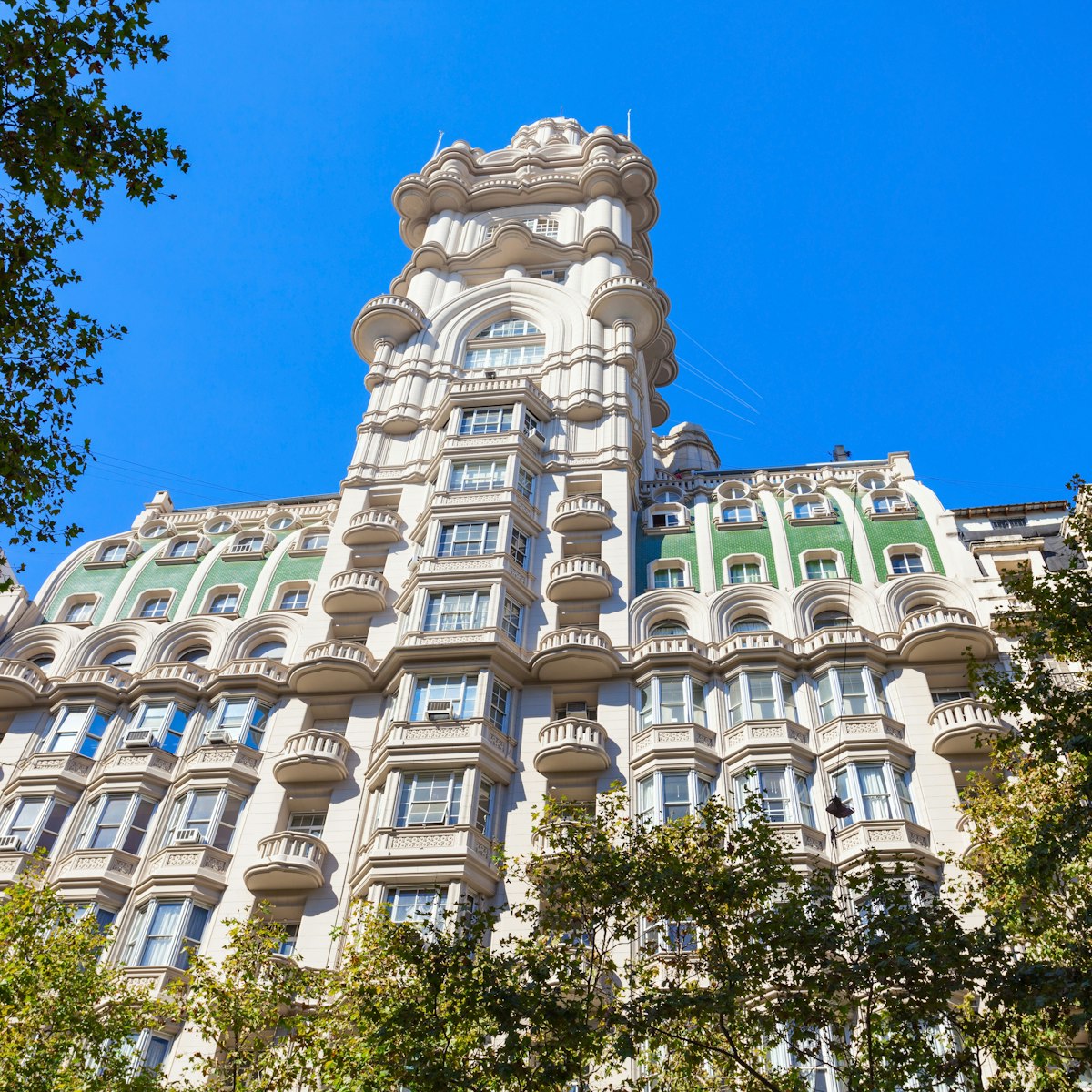
Palacio Barolo
One of Buenos Aires' most beautiful monuments, this 22-story building has a unique design inspired by Dante’s Divine Comedy. Its structure is divided into…
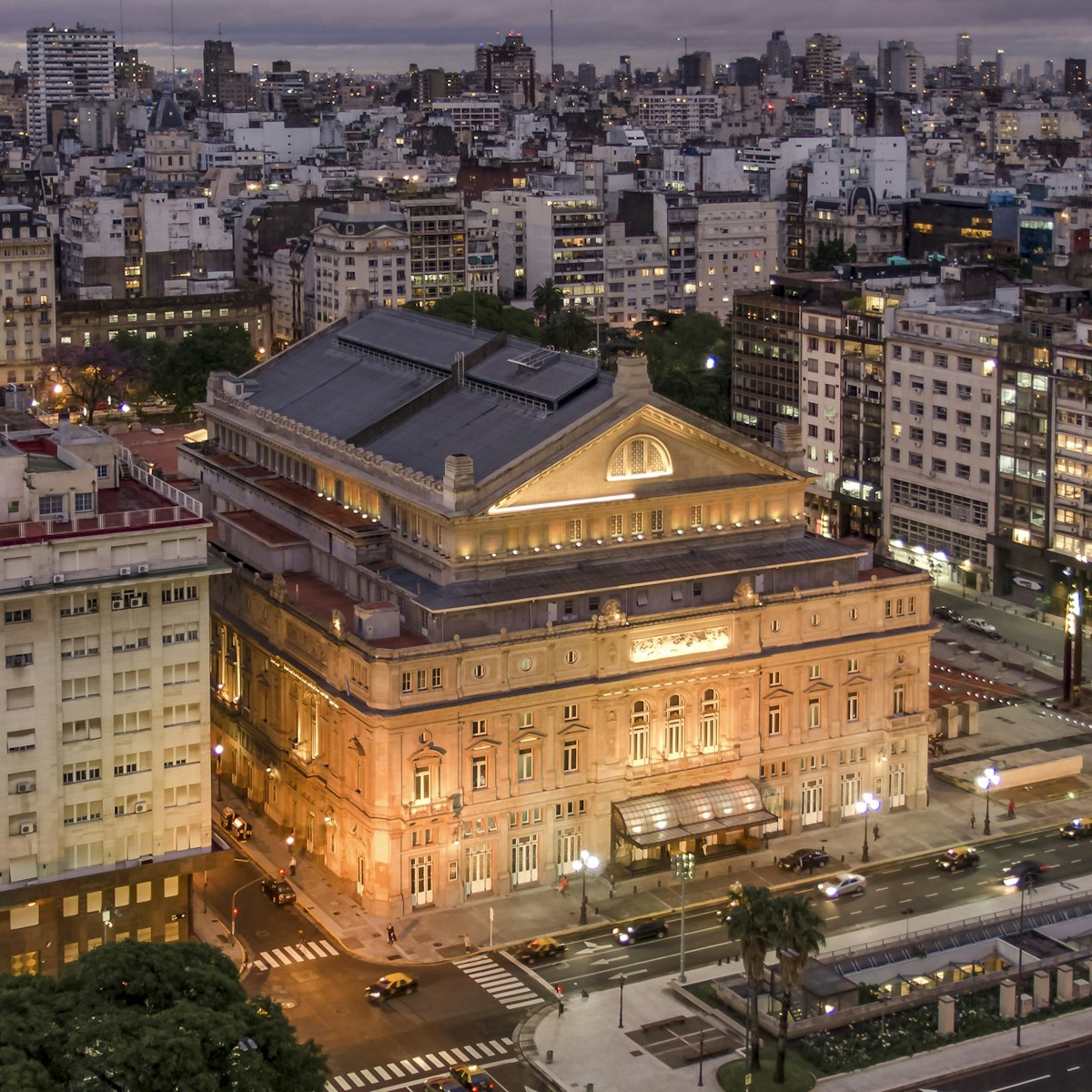
Teatro Colón
Occupying an entire city block, this impressive seven-story theater is one of BA’s most prominent landmarks. It’s the city’s main performing arts venue,…
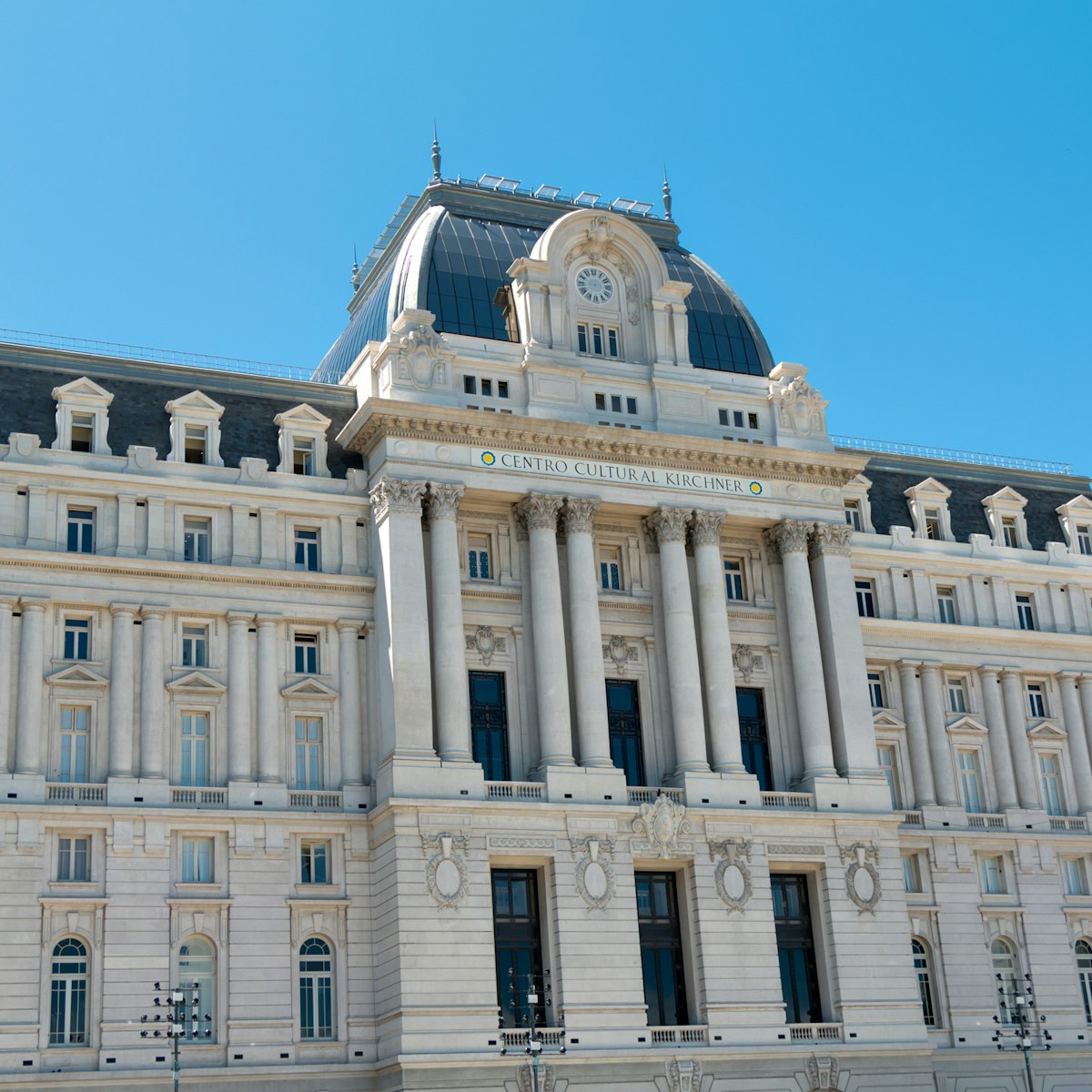
Centro Cultural Kirchner
It was former president Néstor Kirchner who, in 2005, first proposed turning the abandoned former central post office into a cultural center. He died in…
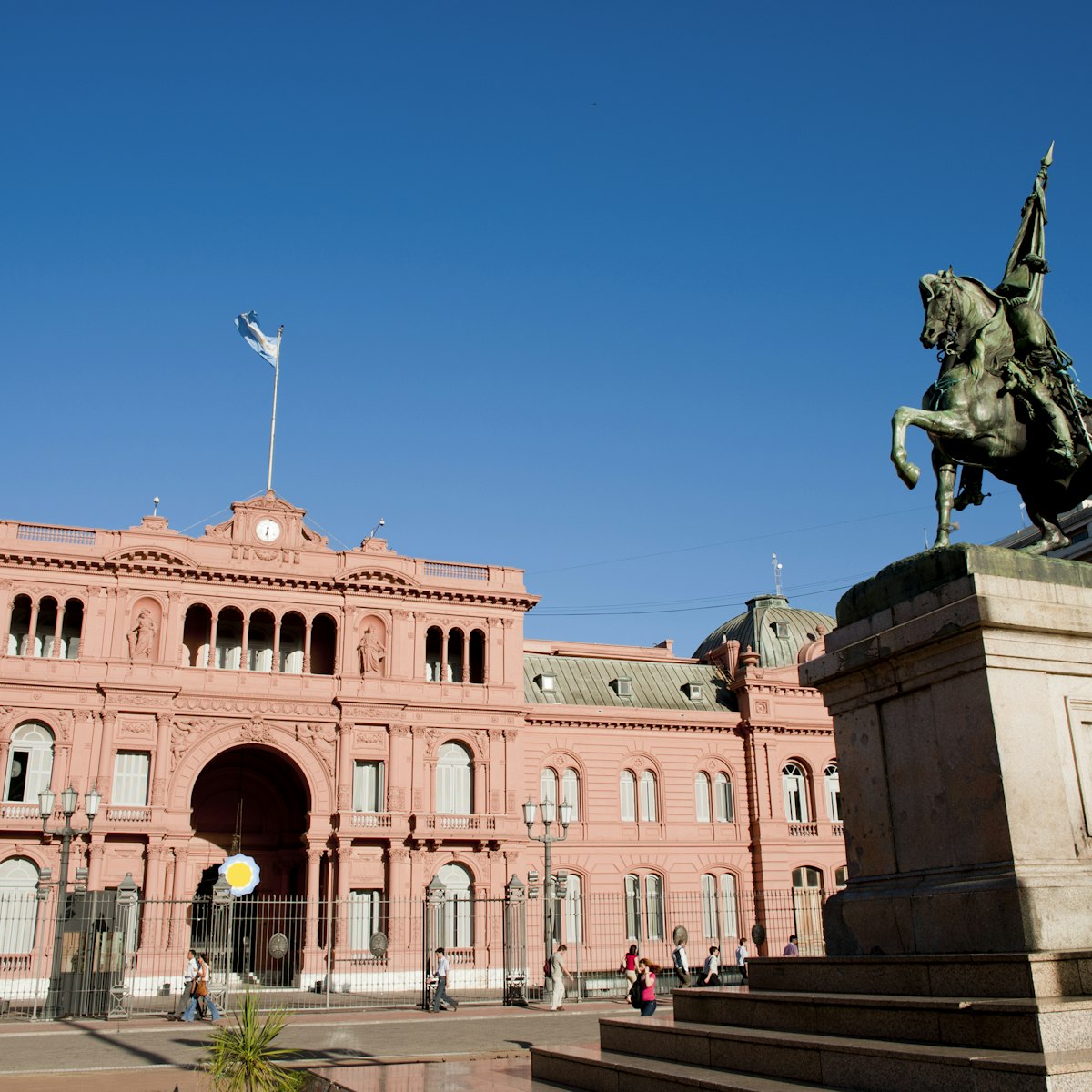
Casa Rosada
The Casa Rosada was named for its distinctive color. It was from the balcony here, at the presidential palace, that Eva Perón famously addressed the…
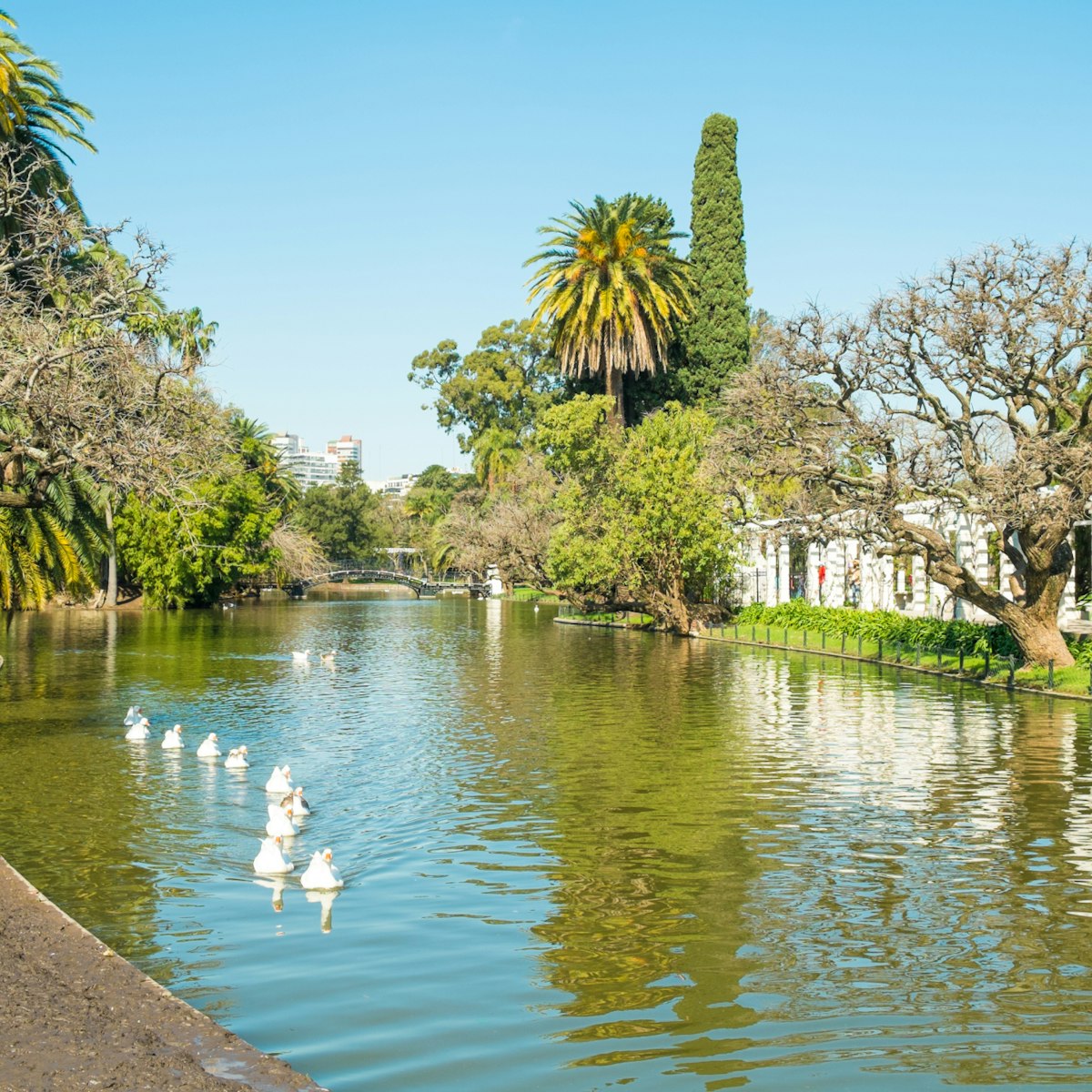
Parque 3 de Febrero
This sweeping park abounds with small lakes and pretty gazebos. Stands rent bikes and in-line skates, and joggers and power walkers circle the ponds – if…
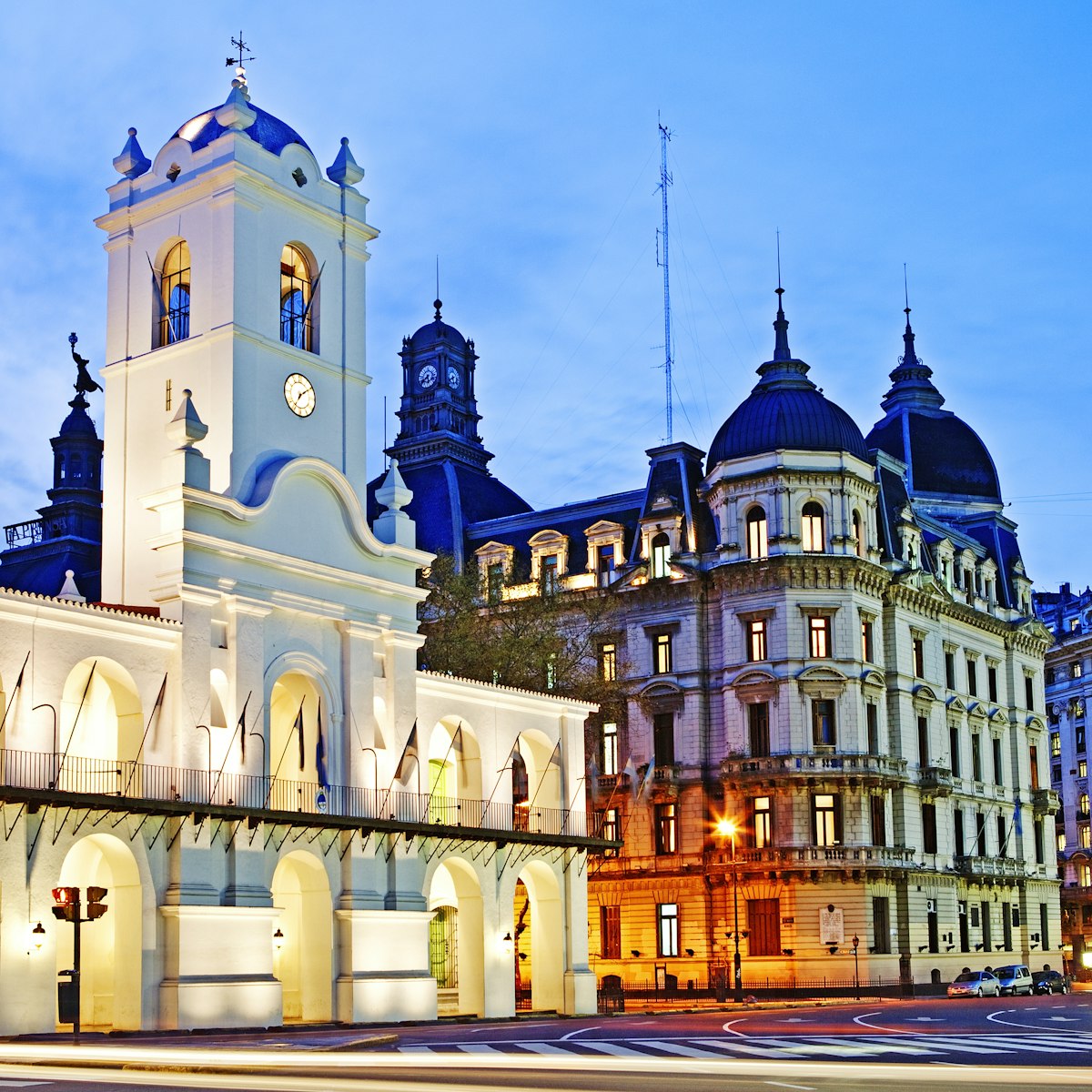
Plaza de Mayo
Surrounded by the Casa Rosada, the Cabildo and the city’s main cathedral, Plaza de Mayo is the place where Argentines gather in vehement protest or…
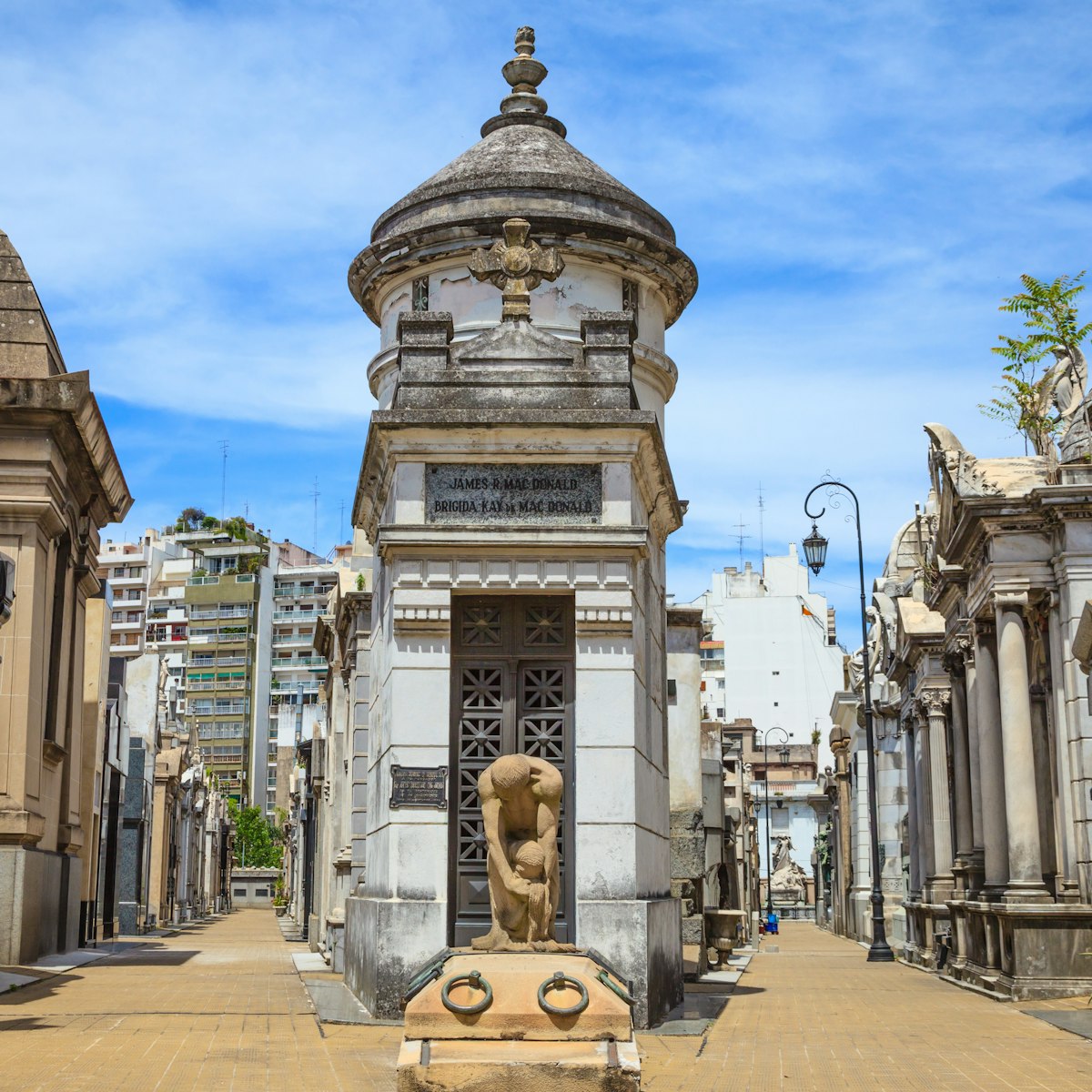
Cementerio de la Recoleta
Recoleta & Barrio Norte
This cemetery is perhaps BA's top attraction. You can wander for hours in this incredible city of the dead, where the ‘streets’ are lined with impressive…
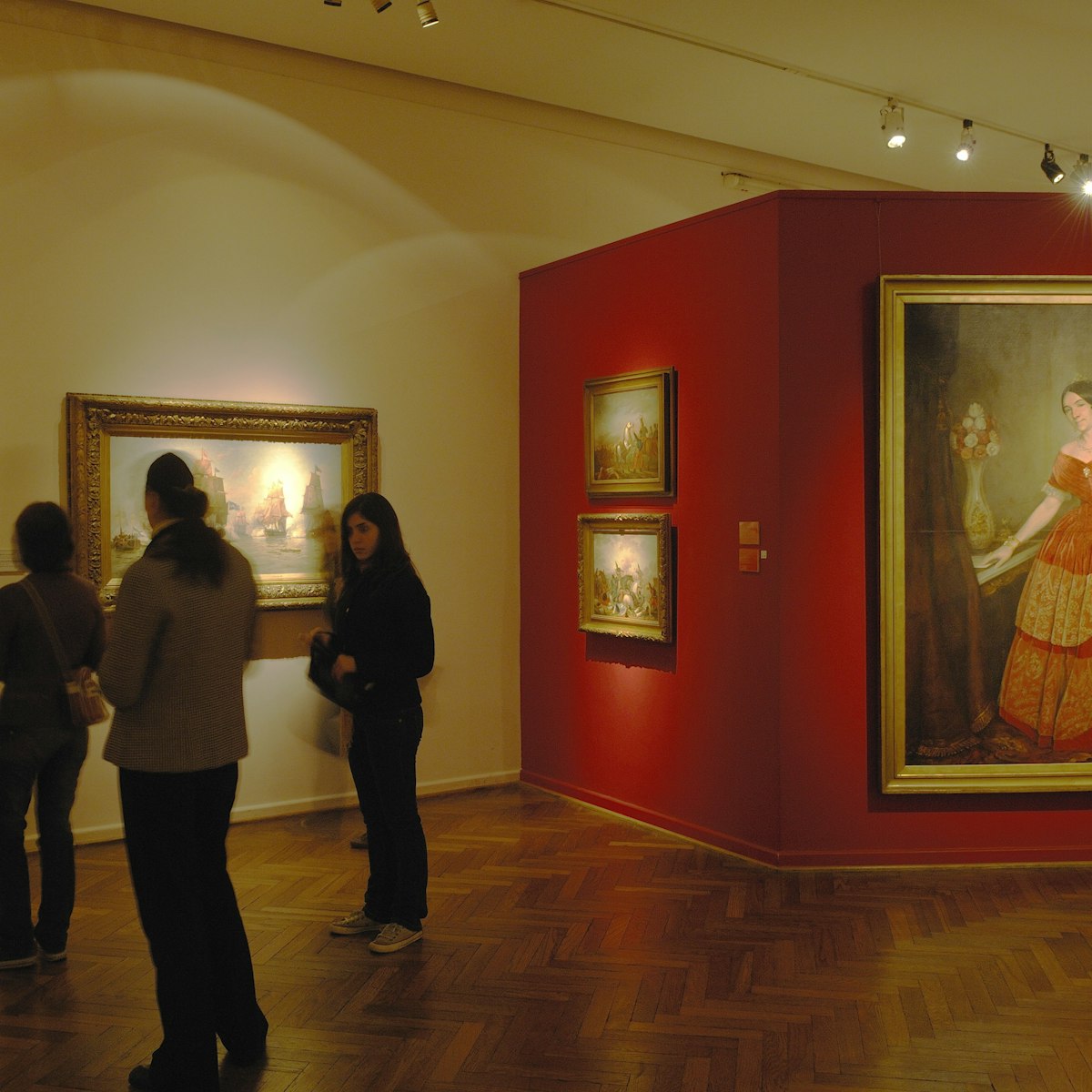
Museo Benito Quinquela Martín
Once the home and studio of painter Benito Quinquela Martín (1890–1977), this fine-arts museum exhibits his works and those of other Argentine artists…
Top picks from our travel experts
The best 15 experiences in buenos aires.

Aldo’s Restoran & Vinoteca
This restaurant and wine shop is an upscale eatery serving a short, gourmet menu of steaks, seafood and pasta dishes, plus small plates and charcuterie,…

Como en Casa
This upscale cafe-restaurant has an elegant atmosphere and attracts Recoleta’s wealthiest. Its best feature is the shady patio, complete with large…

Casa Coupage
Wine enthusiasts love this sophisticated closed-door eatery run by sommelier Santiago Mymicopulo. The gorgeously presented gourmet cuisine, presented in…

Milonga La Glorieta
Belgrano, Nuñez & the Costanera Norte
It’s hard to imagine a more romantic setting for an outdoor milonga than the park bandstand at the Barrancas de Belgrano, where on summer evenings dancers…

Feria Artesanal Plaza Francia
Recoleta’s popular artisan fair has dozens of booths and a range of creative, homemade goods from leather wallets and silver jewelry to mate gourds and…

La Catedral
This rustic warehouse turned bohemian tango club and cultural center is a unique venue in the city. Join a tango class – walk-ins are welcome, and it's a…

La Bombonera Stadium
Seeing Boca Juniors play at La Bombonera is one of the world's top spectator sports experiences, especially if you manage to catch the 'superclasico'…

Salón Canning
Some of BA’s finest dancers (no wallflowers here) grace this traditional venue with its great dance floor. Well-known tango company Parakultural stages…

On the 13th floor of hip Hotel Pulitzer, this after-work spot draws a mix of locals and travelers at sunset for cold drinks, chilled-out Bossanova and…

Mercado de San Telmo
Occupying an entire city block, this striking marketplace was built in 1897 by Juan Antonio Buschiazzo, the Italian-born Argentine architect who designed…

Café Bar Roma
Join the locals for a merienda (afternoon snack) at this wonderfully atmospheric bar with exposed brick walls. It's been a neighborhood favorite since…

Parque de la Memoria
On the edge of the river on the Costanera Norte is this landscaped park and gallery that serves as a memorial to the victims of the military dictatorships…

Lo de Joaquín Alberdi
Nationally produced wines for every taste and budget line the racks and cellar of this attractive wine shop; ask the friendly owner for his…
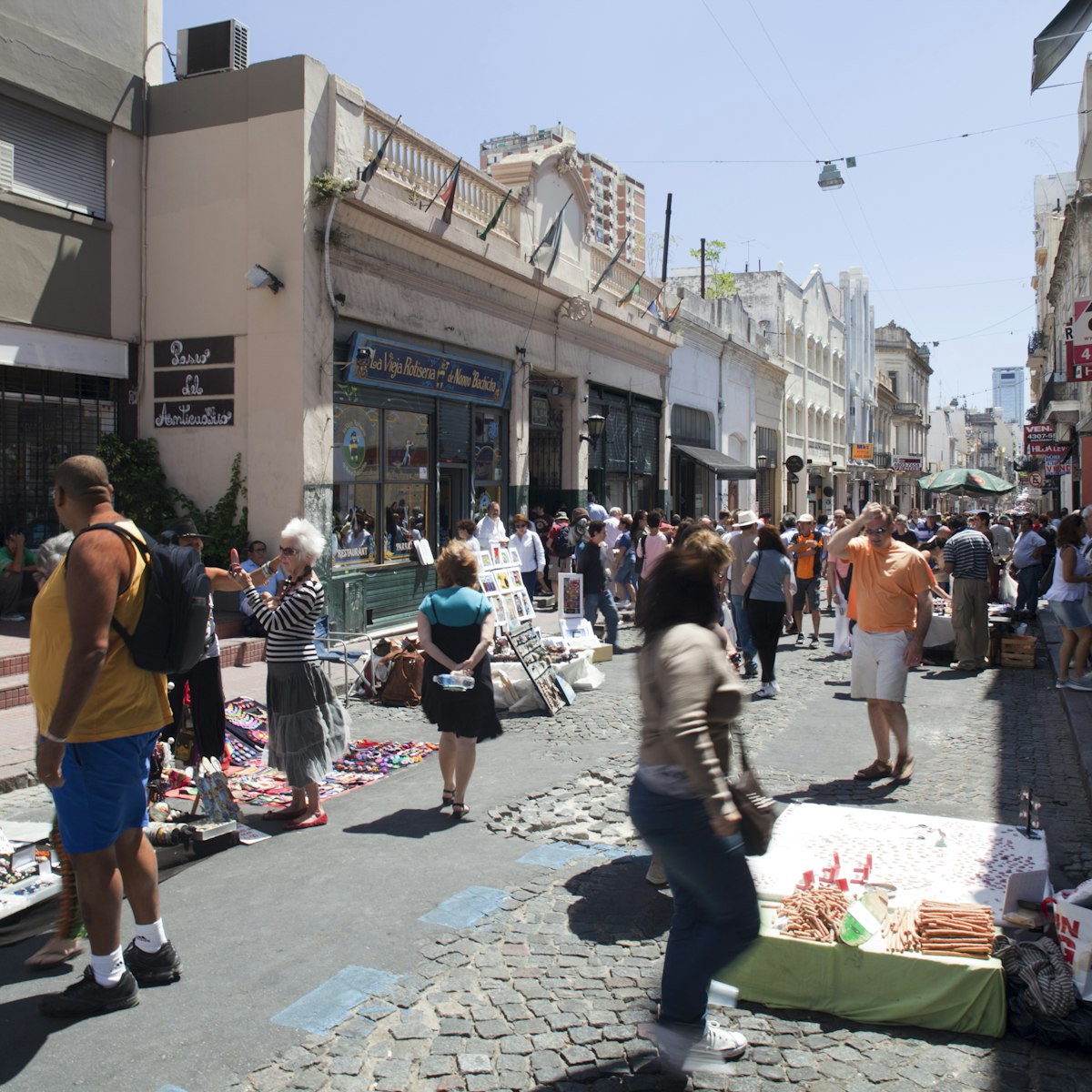
Feria de San Telmo
On Sundays, San Telmo’s main drag is closed to traffic and the street is a sea of both locals and tourists browsing craft stalls, waiting at vendors’…
![travel guide to argentina [UNVERIFIED CONTENT] Show a view of the city from this amazing reserve. Amazing place to view wildlife and flowers. Also, a park used by the locals for walking, jogging, picnicking and relaxing.](https://lp-cms-production.imgix.net/2019-06/f990e3b719e12b73e7a0f88e064b0a92-reserva-ecologica-costanera-sur.jpg?auto=format&fit=crop&ar=1:1&q=75&w=1200)
Reserva Ecológica Costanera Sur
Puerto Madero
The beautifully marshy land of this sprawling waterfront nature reserve is a popular site for weekend picnics, walks and bike rides (rental kiosks line…

Hugely popular for grilling up some of the city's best steaks – so soft they can be cut with a spoon. Yes, it's touristy and pricey compared to the local…

Classy service and a great wine list add an upscale bent to this traditional – and very popular – corner steakhouse. The bife de chorizo (sirloin steak)…

Recommended wine shop in San Telmo.

Alvear Roof Bar
This rooftop bar at the swanky Alvear Palace is a chic venue for a sunset cocktail or late-night drinks.
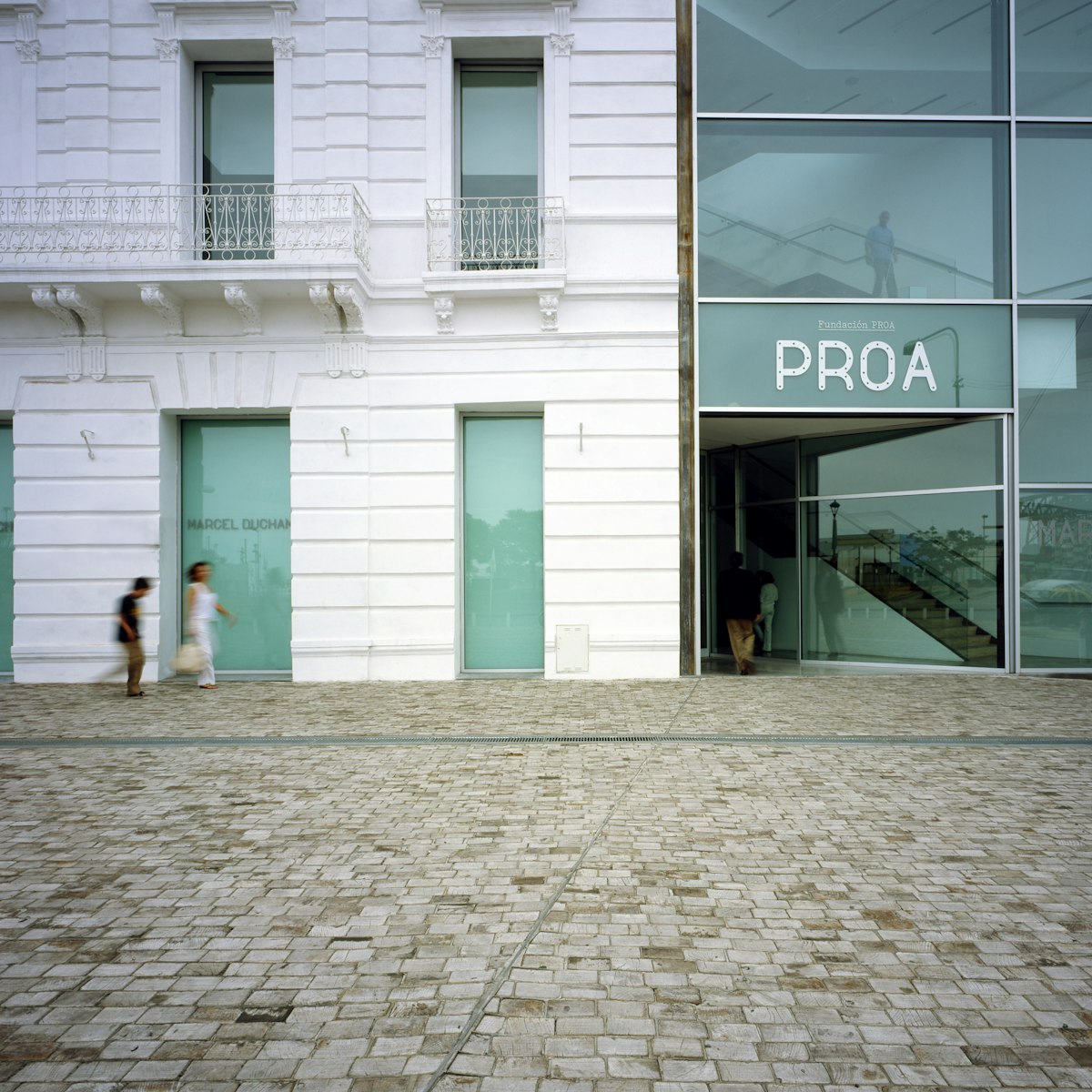
Fundación Proa
Only the most cutting-edge national and international artists are invited to show at this contemporary art center, with its high ceilings, white walls and…

Feria Plaza Belgrano
Belgrano’s artisan market is a great spot on a sunny weekend. Browse the stalls for handmade jewelry, mate (tea-like beverage) gourds, clothes and leather…
Top 10 free activities in Buenos Aires

Usina del Arte
This former power station has been transformed into a spectacular concert venue in an effort to regenerate a somewhat sketchy area of La Boca. It’s a…
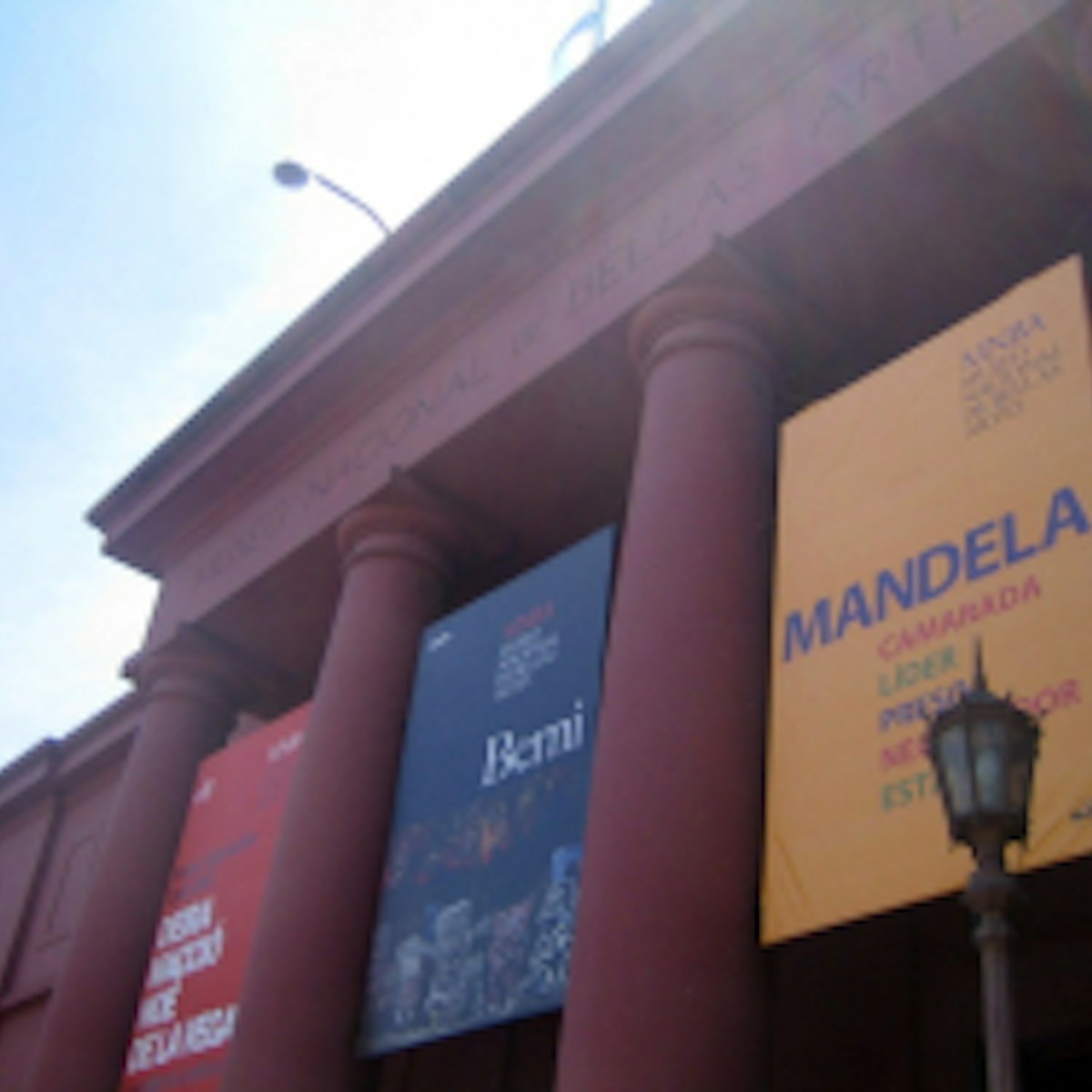
Museo Nacional de Bellas Artes
This is Argentina’s most important fine arts museum, containing many key works by Benito Quinquela Martín, Xul Solar, Eduardo Sívori and other Argentine…
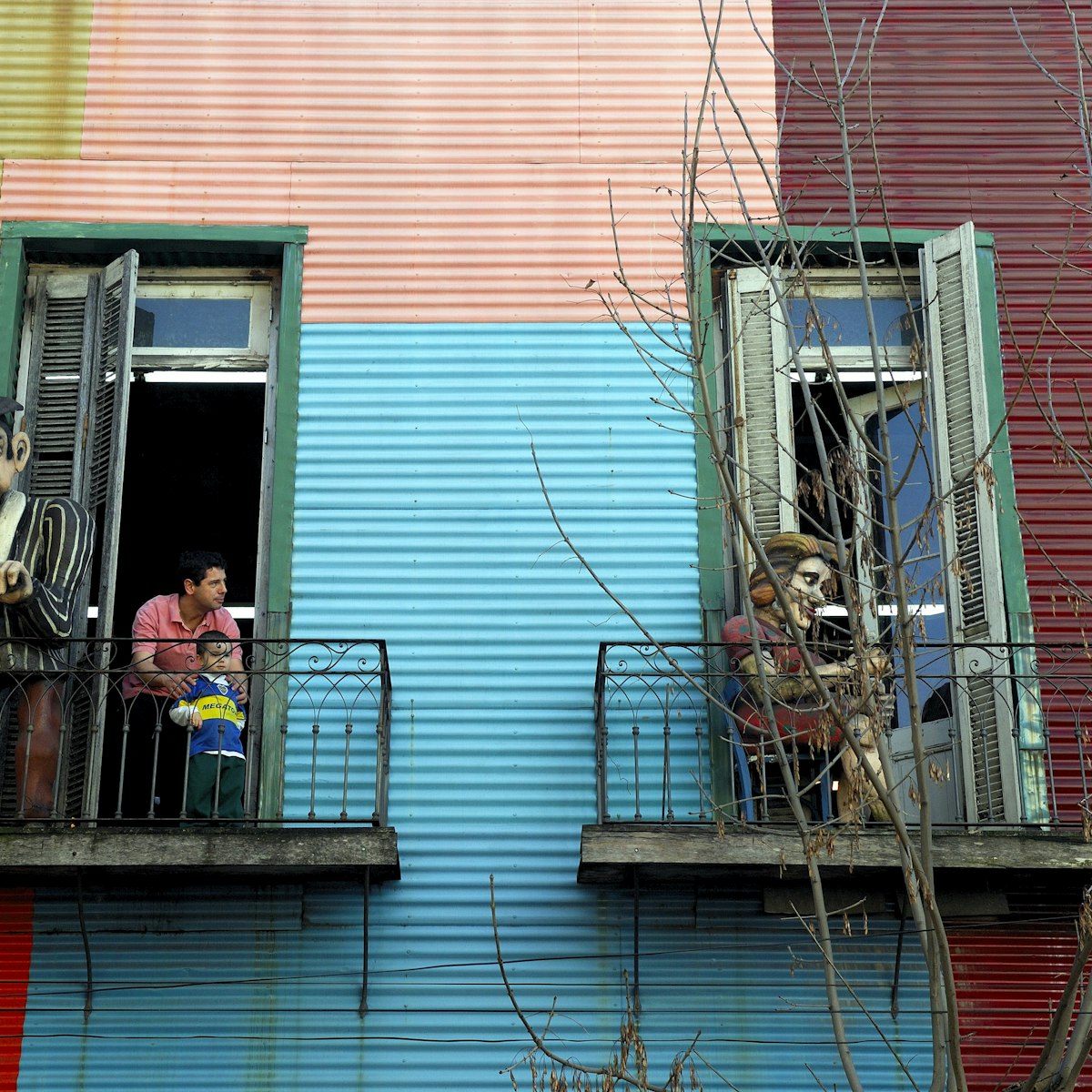
El Caminito
La Boca's most famous street and 'open-air' museum is a magnet for visitors, who come to see its brightly painted houses and snap photographs of the…

Plaza Dorrego
After Plaza de Mayo, Plaza Dorrego is the city’s oldest plaza. Dating back to the 18th century, it was originally a pit stop for caravans bringing…
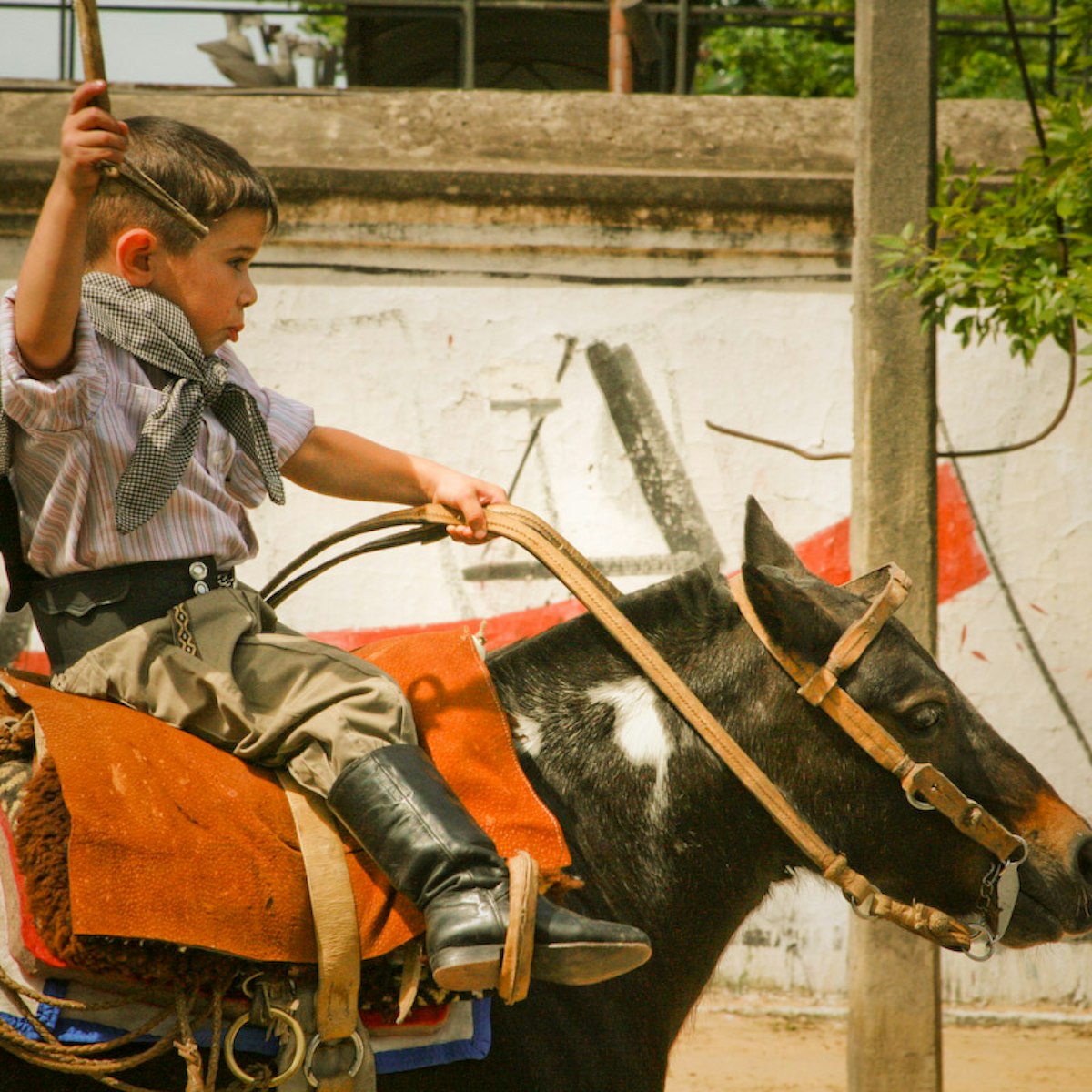
Feria de Mataderos
On the outskirts of the city in the working-class barrio of Mataderos, this excellent folkloric festival happens on Sundays and national holidays. Come…

Within Parque 3 de Febrero is this gorgeous garden with more than 18,000 roses.
Planning Tools
Expert guidance to help you plan your trip.
Best Neighborhoods
The sheer scale of Buenos Aires can be overwhelming but delving into its neighborhoods will result in the trip of a lifetime. Here are 7 of our favorites.
Buenos Aires pulls you in with a magnetic grip, but beyond the city limits, you can explore even more on a day trip.
Transportation
Navigating Buenos Aires' emblematic broad avenues is simple, and getting around the city by foot, bicycle, bus or subway is easy and generally safe.
Free Things to Do
If you want to explore Buenos Aires without breaking the budget, start with these 10 free activities around the capital.
Plan with a local
Experience the real Argentina
Let a local expert craft your dream trip.
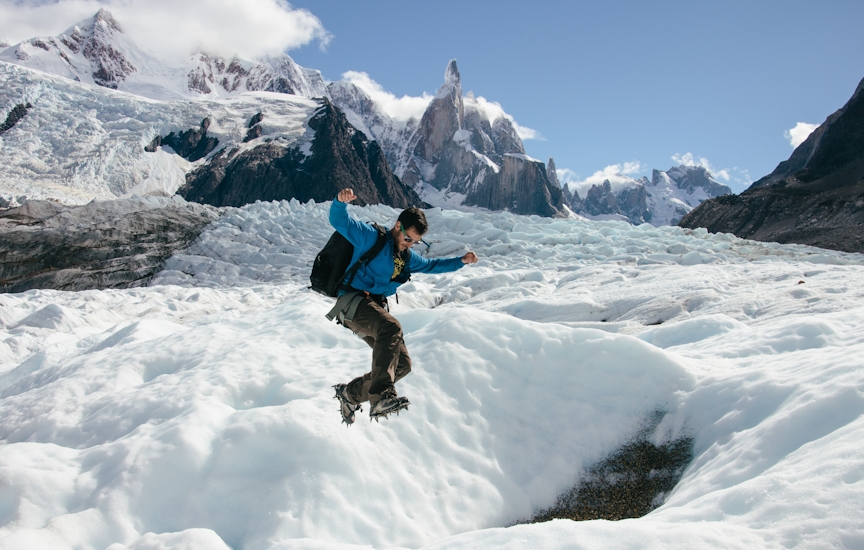
Latest stories from Buenos Aires
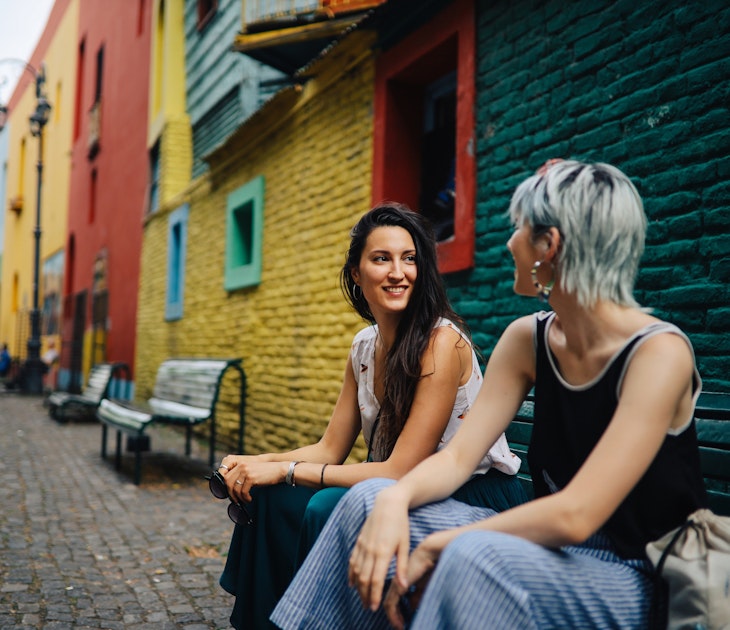
Destination Practicalities
Jan 31, 2024 • 5 min read
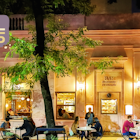
Jan 12, 2024 • 4 min read

Mar 28, 2023 • 7 min read
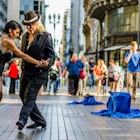
Jan 16, 2023 • 5 min read
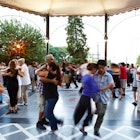
Jan 8, 2023 • 9 min read

Jan 5, 2023 • 6 min read
Dec 18, 2022 • 5 min read
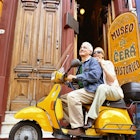
Dec 12, 2022 • 5 min read

Oct 13, 2021 • 5 min read

Jan 20, 2021 • 4 min read
in partnership with getyourguide
Book popular activities in Buenos Aires
Purchase our award-winning guidebooks.
Get to the heart of Buenos Aires with one of our in-depth, award-winning guidebooks, covering maps, itineraries, and expert guidance.
Buenos Aires and beyond

- Meet the Team
- Work with Us
- Czech Republic
- Netherlands
- Switzerland
- Scandinavia
- Philippines
- South Korea
- New Zealand
- South Africa
- Budget Travel
- Work & Travel
- The Broke Backpacker Manifesto
- Travel Resources
- How to Travel on $10/day
Home » South America » Argentina » Backpacking Guide
EPIC Backpacking Argentina Travel Guide (Updated 2024)
Dreaming about exploring the wilds of Argentina? Me too amigo, me too.
This is a land of contrasts: a place where scorching deserts and lush jungles melt into each other. Fine wine costs a couple of dollars – and fine people sip mate in the streets . It’s home to sacred landscapes of Patagonia, football, meat, empanadas, hikes of every difficulty level, and ridiculous levels of enthusiastic energy.
There are reasons why backpacking Argentina is so popular amongst us travellers. Adventures are extreme, the diversity of landscapes is incomprehensible, and the people are sexy – I mean – vivacious .
But, Argentina is ENORMOUS … So if you’re visiting Argentina for a flustered quickie or planning a complete road trip, you gotta be prepared.
I’ve been lucky enough to backpack around South America with my Argentinian partner too… So I’ve roped in Seba G Vivas: Argentina native and lifelong enthusiast. Together, we’re going to guide you through this magnificent country to show you the must-visits AND off-the-beaten-path highlights we’ve discovered in 25+ years of trips around Argentina.
This epic backpacking Argentina travel guide has the best budget tips and travel tricks, lovingly gathered over our lifetimes, in the most passionate nation in the world . From our favourite cheap accommodation, the low down on hikes, to the boring stuff like travel insurance and safety, you’re safe with us.
No country has left an impression on me quite like exploring Argentina. So I, LauraMcBlonde, and my beautiful Argentino partner are taking you on a wild road trip from the desert to trekking Patagonia.
Vamos! We’re going backpacking Argentina…
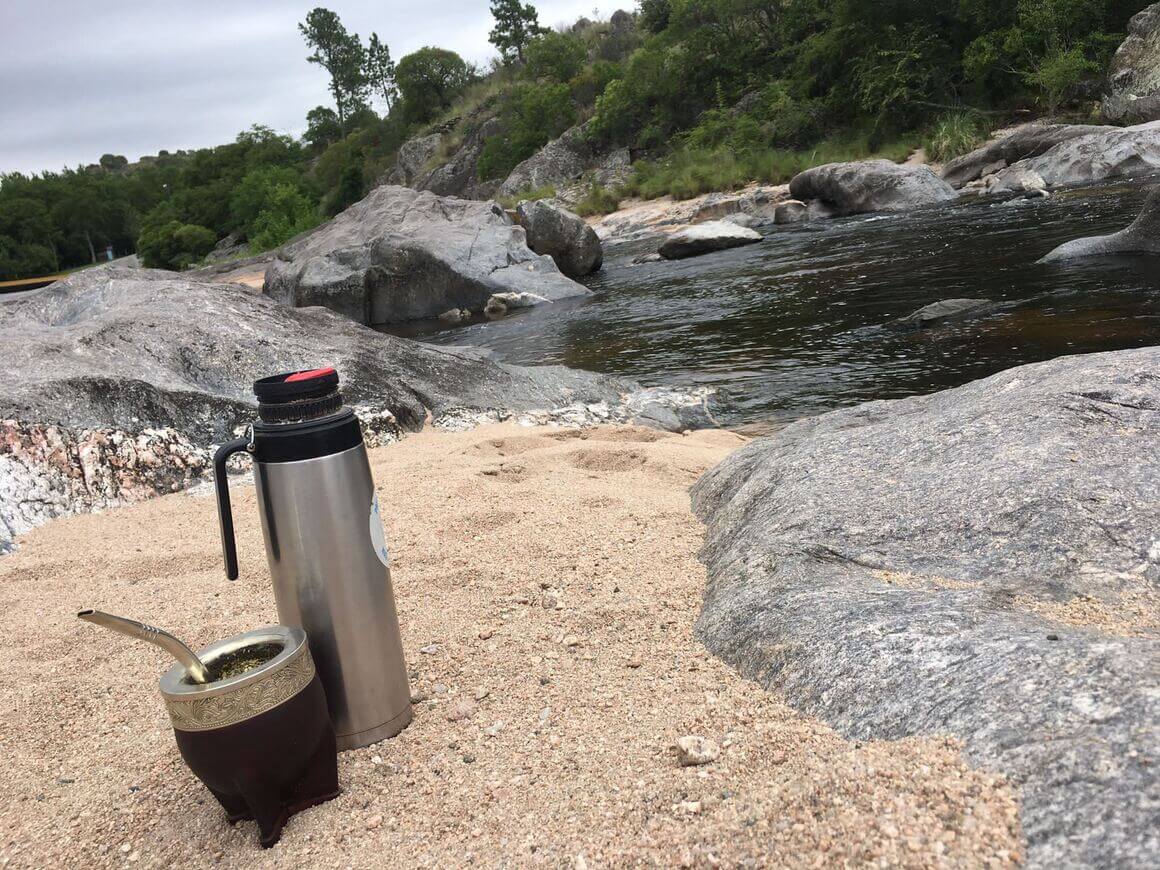
Why Go Backpacking in Argentina?
If you tried to describe Argentina with a couple of words, it wouldn’t be possible. The 8th largest country in the world hosts some of the most dramatic and distinct landscapes. So whatever type of backpacker you are, Argentina has something for you.
Snowy Patagonian mountains run alongside miniature mountain villages. Humid rainforests and dry deserts crash into each other. Then you’ll find highly developed cities.
The Southern South American country borders friendly neighbours like Brazil, Chile, and Bolivia. So it’s a no-brainer to make Argentina part of your backpacking South America adventure.
And amazingly, Argentina is cheap as shit! So it really is a broke backpacker’s dream destination. You just have to know the tricks.
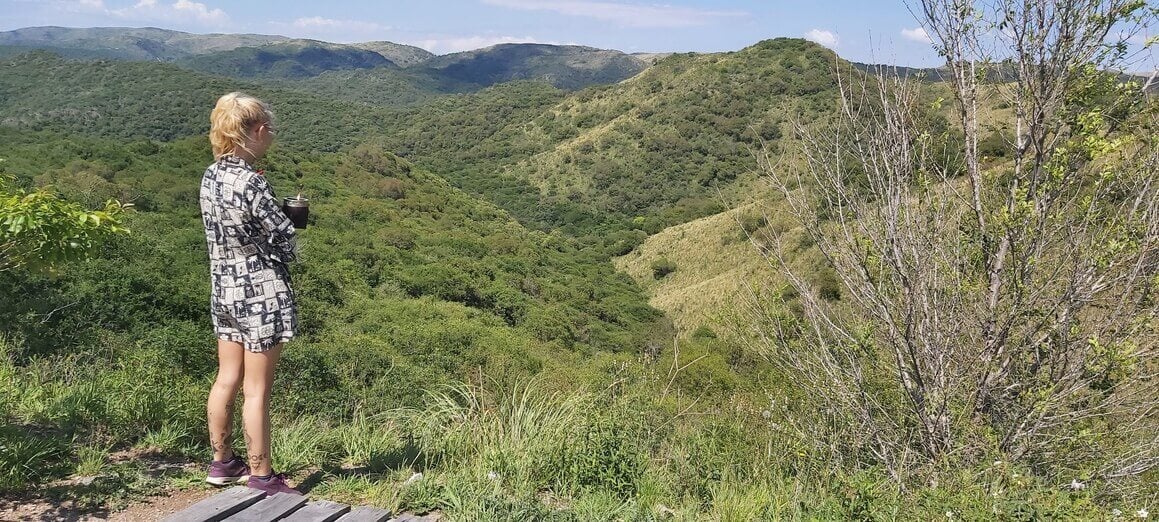
More than that, Argentina has a special place in my heart. The locals don’t do anything by halves and that passion transcends to everything in their beloved country. They LOVE and they HATE Argentina, in equal measure, passionately .
The energy that the people have is electric. Whether it’s a football game, a music concert or an Argentinian festival , people have a particular way of sharing emotions; those very high and very low vibrations.
Best Travel Itineraries for Backpacking Argentina
Best places to visit in argentina, 10 top things to do in argentina, backpacker accommodation in argentina, some unique experiences in argentina, argentina backpacking costs, best time to travel to argentina, staying safe in argentina, how to get into argentina, how to get around argentina, argentinian culture, working in argentina, faqs about backpacking in argentina, final advice before visiting argentina.
There are top things to do in Argentina all over the country. Even if you just keep your Argentina itinerary within places to stay in Buenos Aires , you’re in for an adventure. But once you get out of the capital, you see the country unfold.
Backpacking Argentina itineraries involve long travel distances ; bear this in mind when planning your trip. Flights are expensive and bus journeys are long .
If you’re only planning on visiting Argentina for 1 or 2 weeks – or even with a one-way ticket – it’s impossible to get around the whole country. Pinning a few must-see destinations may be useful.
14-Day Travel Itinerary for Argentina – The Northern Cities
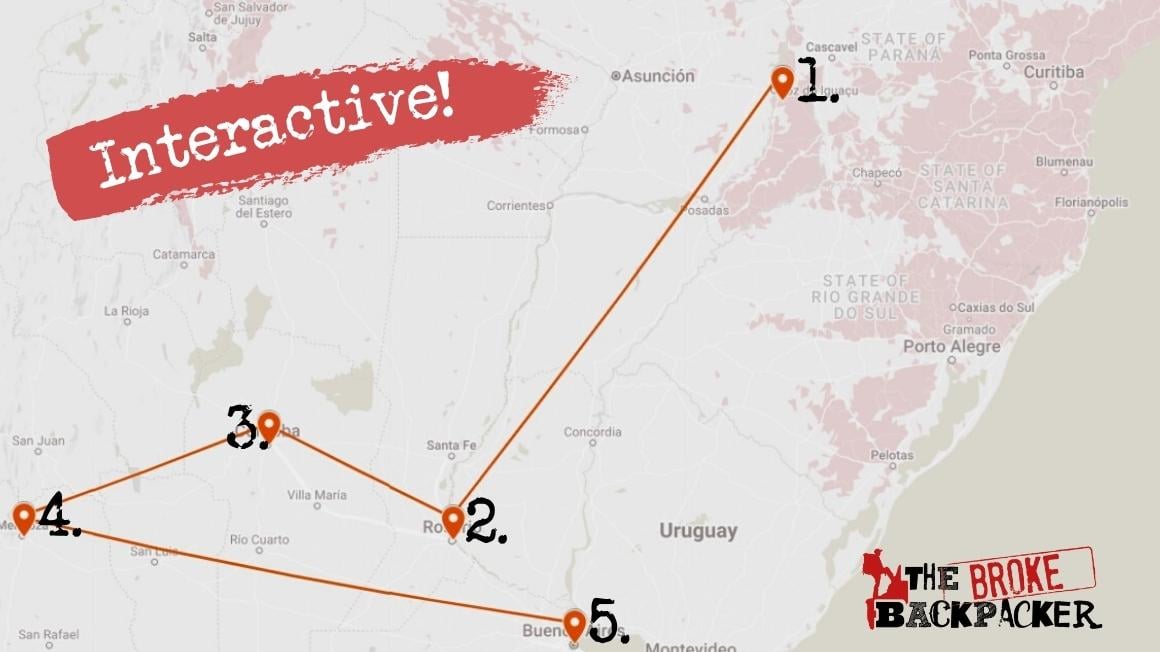
With 2 weeks in Argentina, you can cover the most culturally significant cities in Northern Argentina: Buenos Aires , Rosário , Córdoba , and Mendoza . This 14-day backpacking Argentina itinerary starts at the iconic Iguazú Falls and ends in Buenos Aires. But it can be done in reverse.
If you’re flying into and out of Buenos Aires , or you’re short on time, you may want to connect to Puerto Iguazú on a round-trip flight to avoid the long-distance bus.
To see the incredible example of the power of nature, spend 1 or 2 nights at Iguazú Falls . You can also see it from the Brazilian side, but I’m biased, right?
Take a bus ride to Rosário , one of the most progressive South American countries. Delight your senses with outstanding street art, culture, and playtime – I mean nightlife .
You won’t be disappointed by Córdoba : a city with very modern values. Stay in the city of Cordoba for a few days, then – if you can – get out and explore the region of Córdoba.
The Sierras de Córdoba is a mystical place to explore. Camping here is one of the biggest pleasures.
From here, the journey to the wine capital of Argentina, Mendoza , is easy. Go wine-hopping from vineyard to vineyard. The nearby Andes mountains also offer skiing, hiking, and climbing.
Then finally, Buenos Aires awaits you. This chaotic city has no shortage of attractions. Be sure to visit the charming neighbourhoods of Recoleta , San Telmo , and Palermo .
1-Month Travel Itinerary for Argentina – The Culture Route
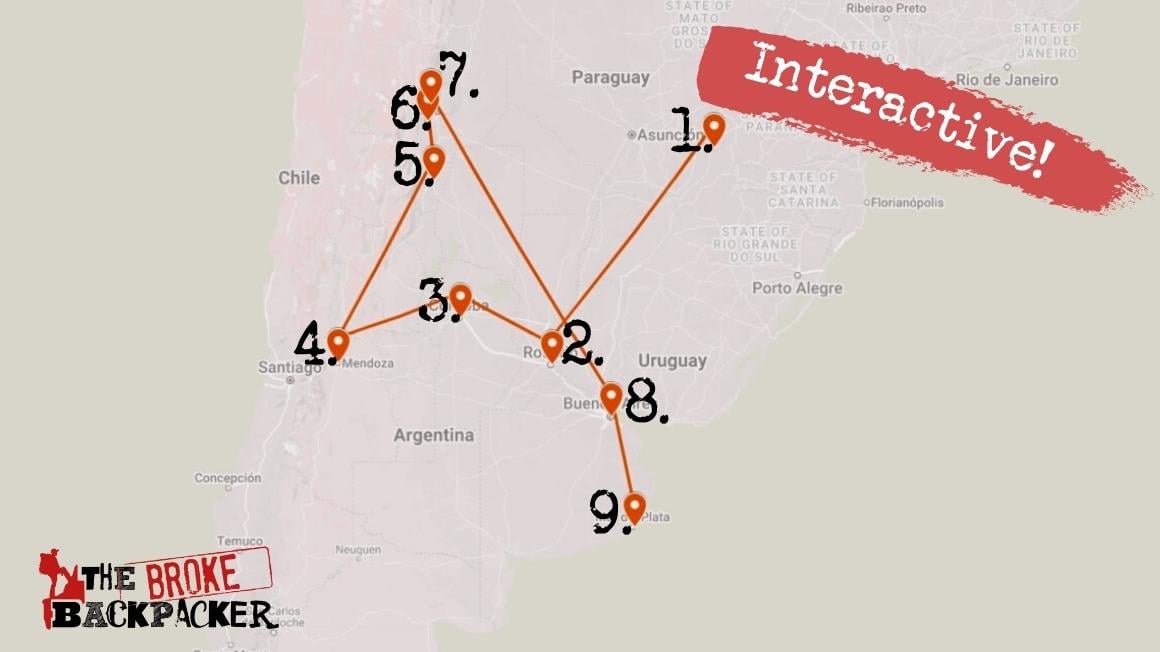
Now we’re really digging deep into what Argentina has to offer. This 4-week backpacking Argentina itinerary expands further on the previous 2-week itinerary but now you could have time for Salta and Jujuy . End your trip on the beach at Mar del Plata .
On your way North from Córdoba or Mendoza , you can make a stop in San Miguel de Tucumán to break up a long bus journey. Dive into some of the nation’s history at the Casa Histórica and the Casa de Gobierno .
You’ll notice the landscape become arider and desert-like until the scenery crescendos into surreal formations and colours. From here on out, simply looking out the window at the alien-like views is entertainment enough.
As well as being one hell of a wine region, Salta has an extraordinary landscape of rock formations. Set a few days aside for getting lost within it.
Then, you’re the most North West as Argentina goes in the state of Jujuy . Tred through raw Argentina. Enjoy the traditional life with a backdrop of natural wonders: Quebrada de Humahuaca and the Pucará de Tilcara .
If you’re heading out of Buenos Aires, Mar del Plata is the best place to wind down or party on down. Whatever kind of beach vibe you crave, you’ll find it here.
3-Month Travel Itinerary for Argentina – The Whole Cow
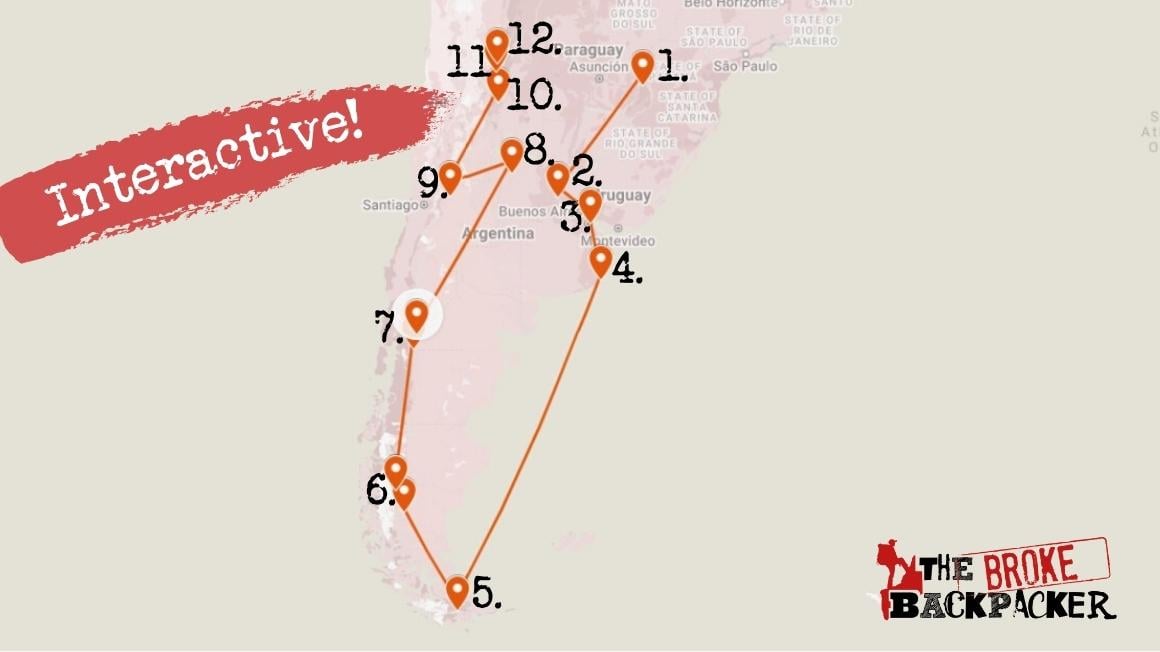
Now, this is my kinda trip! With a 3-month backpacking Argentina itinerary, you can delve deep into the heart of this special nation.
You’ll be able to experience nearly every shade of its coloured and marvellous geography: mountains, deserts, coastlines, vineyards… well, as much as 3 months allows. As well as having the previous destinations on your hit list, now you have plenty of time to explore Patagonia too!
Don’t miss some of the best places to see in Argentina: El Bolsón , Bariloche , El Chaltén , and El Calafate . You may well find that you just don’t want to leave!
It wouldn’t be a justified backpacking Argentina travel guide if I didn’t recommend that you take at least one trek. You have plenty of the best hikes in the world to choose from: the mighty Fitz Roy and Cerro Torre , climbing atop the Perito Moreno Glacier , or at the ends of the Earth in Tierra del Fuego in Ushuaia.
On this trip through Argentina, You’ll also have plenty of time to simply soak in the energy that the country gives off. Take the days (and nights) to enjoy fine food, wine, and fine company. By travelling slowly , that’s when you get the full Argentina experience.

A new country, a new contract, a new piece of plastic – booooring. Instead, buy an eSIM!
An eSIM works just like an app: you buy it, you download it, and BOOM! You’re connected the minute you land. It’s that easy.
Is your phone eSIM ready? Read about how e-Sims work or click below to see one of the top eSIM providers on the market and ditch the plastic .
Of course, this massive country is jam-packed with incredible sights. You can make a list as long as your arm of the best places to visit in Argentina. But let’s go over some highlights.
Backpacking Buenos Aires
Buenos Aires is a city unique in itself. You could spend weeks, months, YEARS here and still feel like a newbie.
It’s a marvel. The city’s full of energy, wonderfully designed, and there is rarely a dull moment. To start backpacking Argentina, Buenos Aires is an exciting place to springboard in.
The city is huge, and most people question safety in Buenos Aires from terrible rumours. But staying in the Microcentro (where most of the attractions are anyway) proves safe enough for thousands of tourists a year.
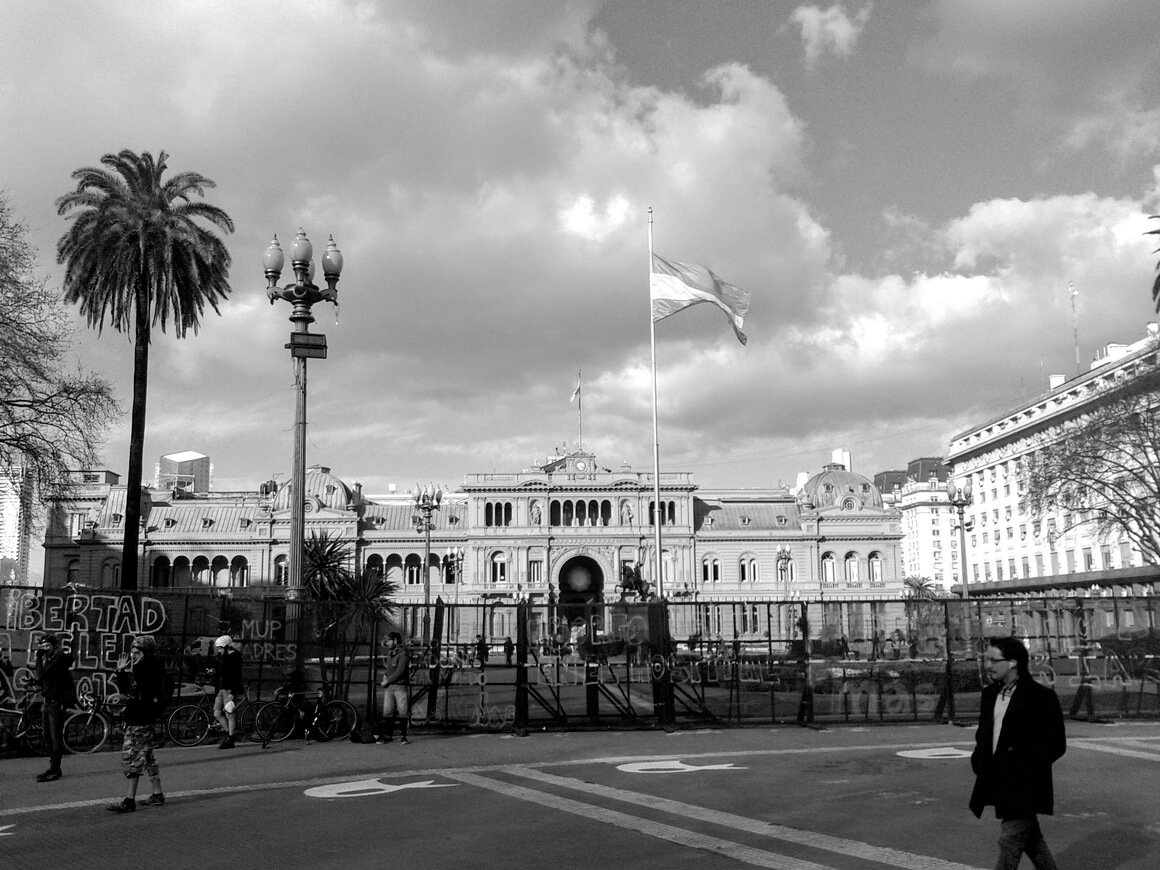
You’ll find Obelisco rising in the middle of the bustling Avenida 9 de Julio to remind you where you are. Several cultural landmarks, like the Casa Rosada and Palacio Barolo , are around this area.
Living the hostel life in Buenos Aires, you’ll meet great people. It’s the place for tip-offs about THE local snack shops too.
Recoleta is class but attracts mostly affluent travellers – the cemetery is weirdly amazing. Palermo SoHo is the hipster part of town and features some of the coolest street art I have ever seen.
La Boca is admittedly cool but overhyped and a bit shady after dark. I recommend staying in San Telmo instead, and just peaking in as a better option.

Backpacking Iguazú Falls
Iguazú Falls is probably the most engrossing waterfall on the planet (and I’ve seen a few stunning waterfalls). The sheer power of this waterfall makes it an intimidating and awe-inspiring sight. Around 275 cascades orchestrate this majestic power.
As you walk along the crest of the falls, witnessing tons of water spilling over the precipitous edge, you’re gonna get wet. (You dirty-minded bastard – not that kind.)
Iguazú Falls is split between Brazil and Argentina and both sides will give you a different taste. The Argentinian side traverses the top of the falls and gives a more up-close and personal experience. The Brazilian side is closer to the bottom of the falls but makes a fuller panoramic view.
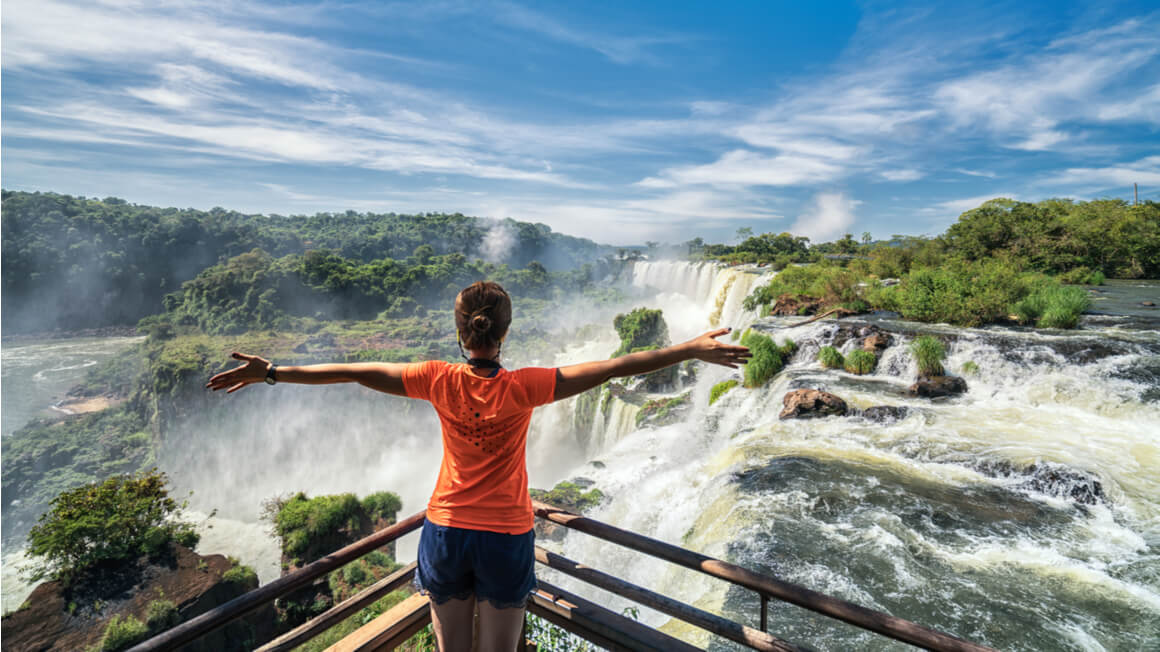
The most magnificent sight is the Garganta del Diablo – The Devil’s Throat . Many people (*cough, cough* the Argentinians) claim it is the best part of the park.
There’s an argument over which side is better: Brazil or Argentina? But this is a backpacking Argentina guide… Of course, I’m going to say Argentina!
Accommodation wise: stay in the Argentinian city of Puerto Iguazú . The city pretty much exists solely as a means to visit the falls. Staying in one of the hostels in Iguazu Falls is where you’ll find the best vibes.
Backpacking Rosário
Rosário doesn’t have the sheer amount of landmarks that Buenos Aires does. What Rosário does have is heaps of culture. Here is one of the most liberally minded and socialist populations in all of South America.
The city is evolving and transforming. Artists, activists, rebels, and youngsters are all drawn to this place to pay homage to idols – like Che Guevara, Lionel Messi – or to become their own (in a sense).
The most important landmarks are the Monumento a la Bandera and the house of El Che Guevara . Both are nationalistic in nature and iconic stops in the city.
Rosário is also the city with the most green spaces in the whole of South America! Check out the Parque Independencia , which is also one of the largest city parks in the whole country. If you’re visiting during warmer seasons, there’s even a stretch of sandy beach along the Paraná River called Balneario La Florida to take your icy beer.
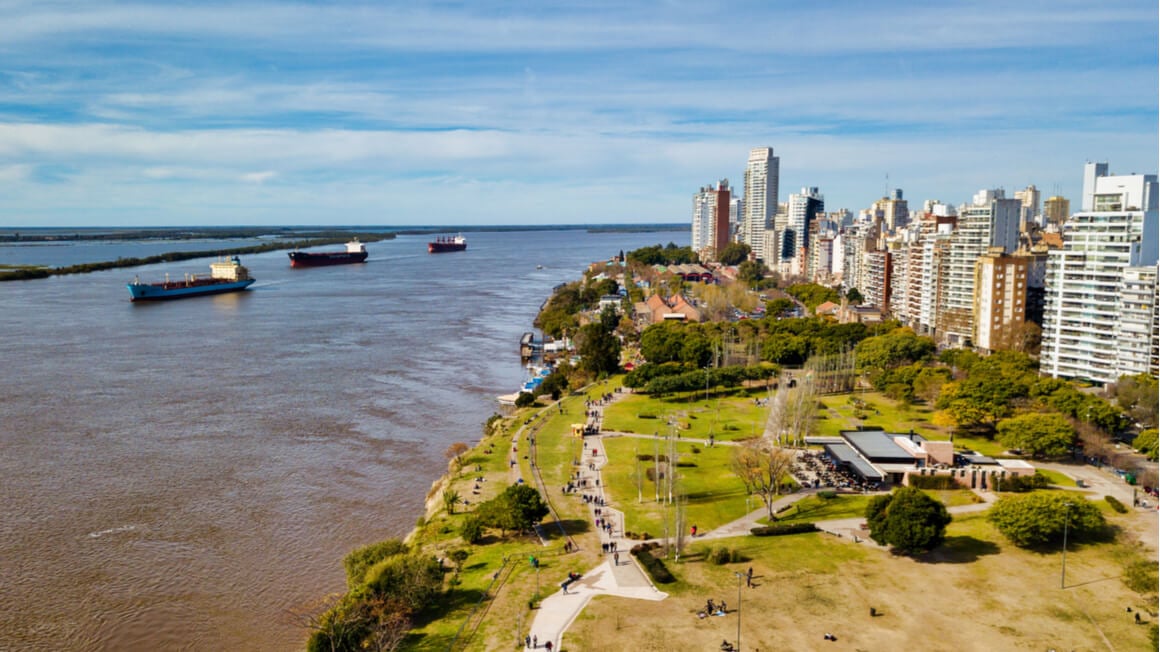
Tourist attractions aside, Rosário really shines when it comes to the people. People are very open-minded and receptive to foreigners. If you happen to make friends with a Rosárino (a person from Rosário), then you’ll be treated very well – first to an Asado , then to a long night of socials in the Pichincha neighbourhood.
If you’re lucky, you may even get a chance to find a lover for the night. It’s common knowledge that Rosárinos are gorgeous.
Backpacking Mar del Plata
Mar del Plata is every Porteño’s (a person from Buenos Aires) favourite summer getaway. This large city boasts some of the best beaches in Argentina and gets rammed in the peak seasons around November to March.
Most people, obviously, journey to Mar del Plata to relax on the beach. The most popular ones are Playa Varese , Playa de los Ingleses , and Playa Grande .
In the summer, these sandy stretches become absolutely bonkers as locals play and pass around drinks and joints. At night, many people go to the bars around Alem Street and stay up all night long only to repeat the process the following day.
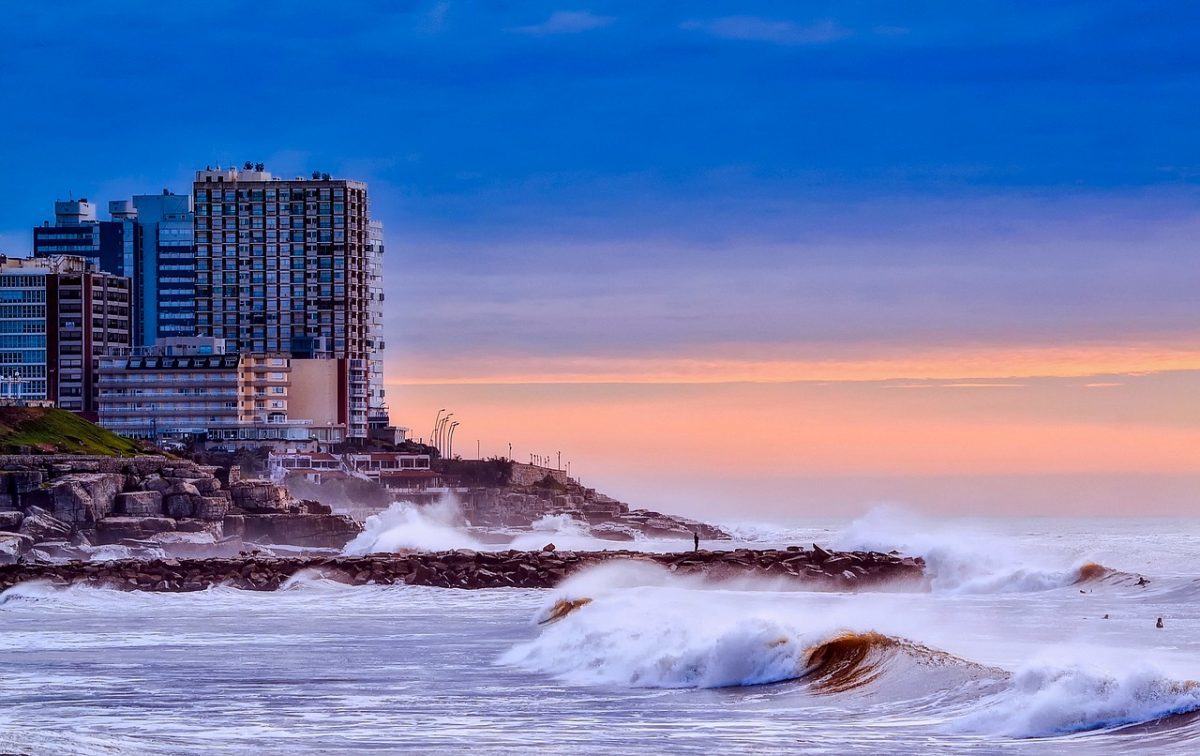
If you want a slightly calmer experience then head north or south to the small coastal towns of Pinamar and Miramar , respectively. Both are way more chilled and attract more families. You’ll find much cheaper accommodation in these areas too.
If you visit Mar del Plata during the rainy off-season, then there is still plenty to do. There are several ecological museums and zoological facilities around the city to visit. Most of these offer predominantly maritime exhibits.
Backpacking Córdoba
Córdoba is the second-largest city in Argentina and is most known for its colonial architecture, scholastic history, and surrounding mountainous landscape. The city is an eclectic mix of the old and the modern. Young travellers and students rain on this city.
Jesuits “founded” the modern city of Córdoba and they established several places of learning. Because of this, Córdoba’s nickname is La Docta or “the learned one.” Scattered throughout are some of Argentina’s prominent historical sites: the Manzana de los Juristas , the Cathedral of Córdoba , and the Capuchin Church .
Go museum crazy in Córdoba. The Evita Fine Arts Museum , which was formerly a palace, is loved by many. Ultra-modern Caraffa Fine Arts Museum is also worth visiting. Backpacker hostels in Cordoba and cool budget accommodation are in abundance.
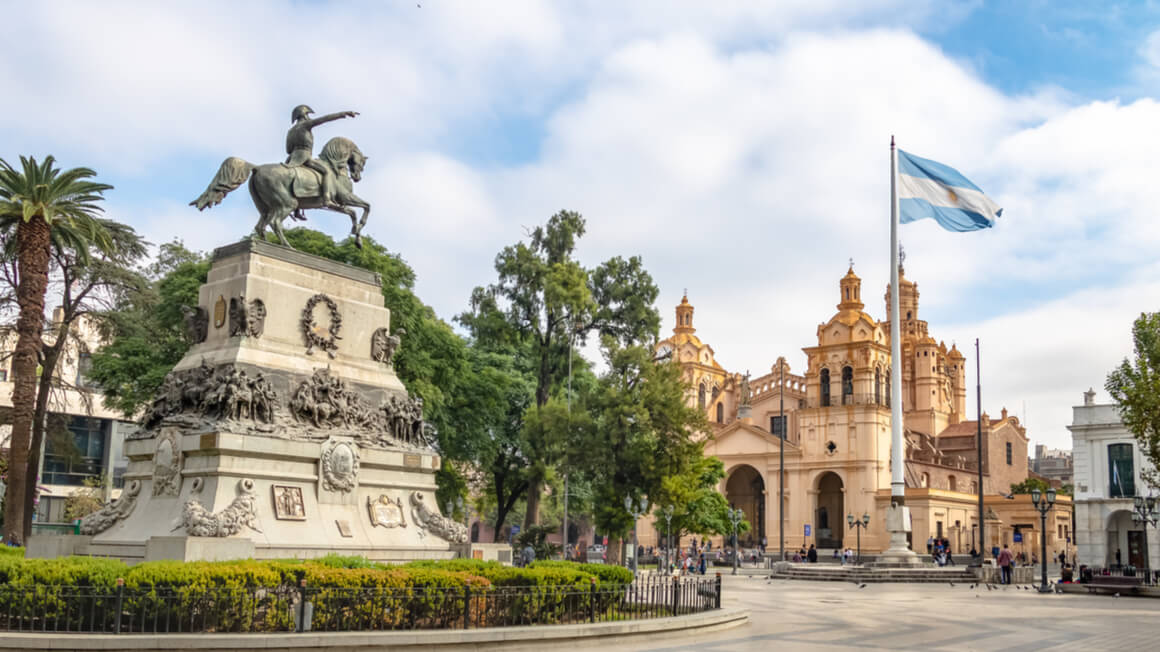
Outside of the city of Córdoba is my favourite place in Argentina – Las Sierras de Córdoba (sorry Paraná, I still love you). I’m just a sucker for camping and road trips.
Charming villages around the mountains, like La Falda , La Cumbrecita , and Villa General Belgrano , are beautiful and have very European sensibilities. The Quebrada del Condorito and Traslasierra Valley areas make incredible hikes.
Argentinians from all over the country flock here with their Asado equipment to retreat from everyday life. Large inland lakes and rivers capture the hearts of many. Picturesque Mar Chiquita serves as a nice retreat for Córdobians.
Nearby Salinas Grande couldn’t be more different. This is a huge salt flat at the base of the mountains.
Backpacking Salta
Salta is a thriving commune and backpacker hangout smack bang in the middle of the desert. This desert also doubles as one of Argentina’s premier wine regions (woohoo!).
I’m not going to beat around the bush here; it’s a journey to get here. You can make a stop in San Miguel de Tucumán – for some history – and Cafayate . Cafayate is the initial gateway to one of the most gorgeous landscapes in Northern Argentina: the Valles Calchaquí .
If you have your own car, you’re laughing. This region – running north all the way to Jujuy – makes the best road trip with its blood-red stone formations canyons that snake throughout it. Cuesta del Obispo is a road I won’t forget in a hurry.
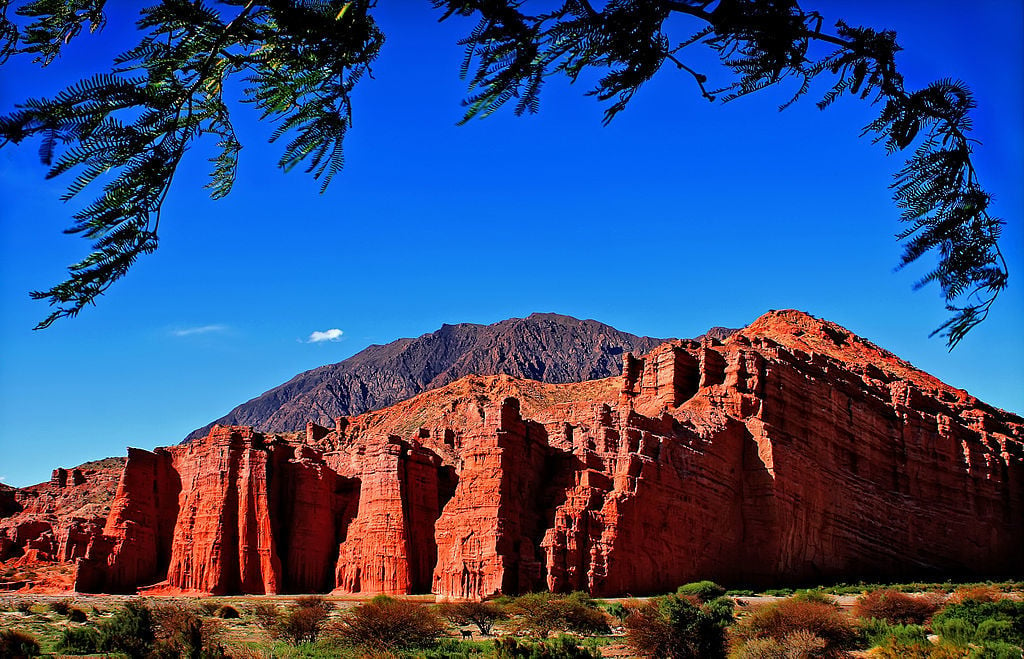
In the Valles Calchaquí, adventure opportunities are plentiful. Who knew backpacking Argentina in Salta can involve paragliding, mountain biking, climbing, rafting, rappelling? Pump some adrenaline, then warm your soul with some winey goodness.
There are numerous wineries around Salta offering different styles and vintages. The harsh climate in this region has a noticeable effect on the grapes, producing bold and hearty tastes.
Inside the city – if religious sights interest you – there are plenty. The gorgeous Iglesia San Francisco and Catedral de Salta , as well as museums of colonialism and archaeology, are prominent features. You can summit several of the surrounding hills via train or cable car as well; each one offers astounding panoramas of the city.
Salta definitely still has a soul and heartbeat that could rival any larger city too. Streets are busier with people more so than cars. Bars are abundant and full of life.
Backpacking Jujuy
North of Salta is San Salvador de Jujuy in the province of Jujuy. Though the regions of Salta and Jujuy appear very similar, they are, in fact, quite different.
Tourism in the region of Jujuy focuses less on winemaking and more on the surrounding landscape. The Quebrada de Humahuaca is one of the most beautiful places in Argentina and hiking through its Seven-Coloured Hills is a once in a lifetime opportunity.
This region isn’t totally desolate either: just over the mountains, you’ll actually find a cloud rainforest. Verdant Calilegua National Park will grant visitors the opportunity to spot jungle wildlife – especially those of the feline variety like jaguar, puma, and ocelot.
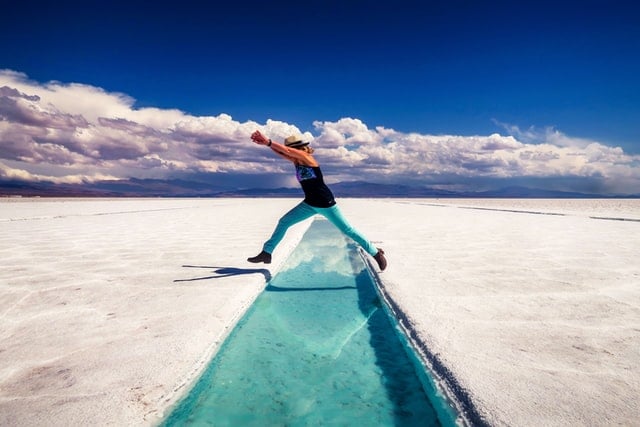
The main towns of the Jujuy province are San Salvador de Jujuy, Purmamarca , and Tilcara . All of them are quite similar and any one of these would make a fine base for exploring the region.
Of the three, Tilcara is the northernmost town and offers great archaeological attractions. The most popular site is the Pucara , which is a mighty pre-Inca fortification built upon a hill.
In addition, there are several other museums around Tilcara that do a great job of representing the local indigenous culture. The town itself has its own unique charm with mud and stone buildings, which give the entire town a very mystical desert feel.
Backpacking Mendoza
The mighty Andes! Here, you’ll find some of the superlatives of South America including the highest mountain on the continent. Home to the Malbec wine grape – “the best in the world”. (According to the Argentinos, obviously).
The city of Mendoza isn’t much to speak of. It’s a bit lacklustre. There are a couple of interesting attractions like the Cerro de la Gloria , Plaza España , and the Parque San Martín .
Most of the action is found outside of the city. This is why you want to make sure to know where to stay in Mendoza .
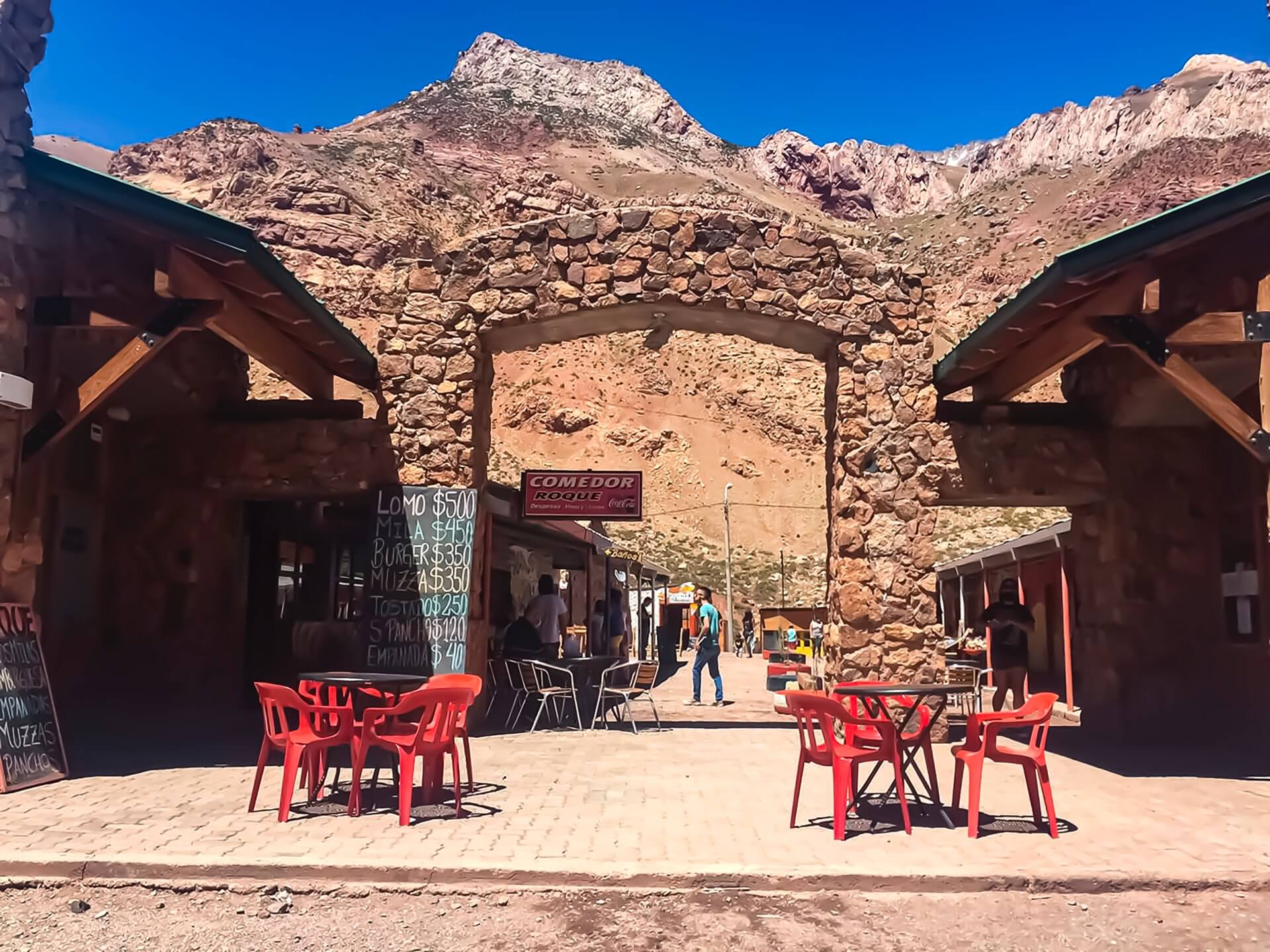
Being so close to the Andes, Mendoza has a myriad of alpine activities to participate in. In the winter, you can take to the mountains with your skis in resorts like Las Leñas .
In the summer, hardy adventurers can climb the gargantuan Aconcagua . This mountain is not for beginners though; attempting it shouldn’t be taken lightly. There are a couple of nice hostels in Mendoza as well.
The Wine Region is Mendoza’s real claim to fame. Don’t forget the name, Malbec : adored by many worldwide, this beauty of a grape is cultivated and celebrated here. A tour around the many wineries is essential in Mendoza.
Mendoza does act as a bit of a crossroads. Many who have been backpacking around Chile enter Argentina via Mendoza. The city is the meeting point for many important backpacking routes in Argentina as well.
If you’re travelling from the east, be sure and drop by the Argentinian national parks of Talampaya and/or Sierra de las Quijadas . Both offer spectacular desert scenery that rivals the beauty found in the Valles Calchaquí region.
Backpacking Río Negro
Okay, this is a biggie! So let’s break it down into two of the hottest destinations to visit while travelling in Argentina.
On the doorstep of Patagonia and the Andes are the beloved destinations of Bariloche and El Bolsón . I’m not messing, these are surreal fairytale places. There’s no wonder why people flock here.
Bariloche is Argentina’s idea of an Alpine retreat. This magical village nestles within the Nahuel Huapi National Park and has mountain splendour aplenty. With so much on offer, choosing the right place to stay in Bariloche can totally change your experience.
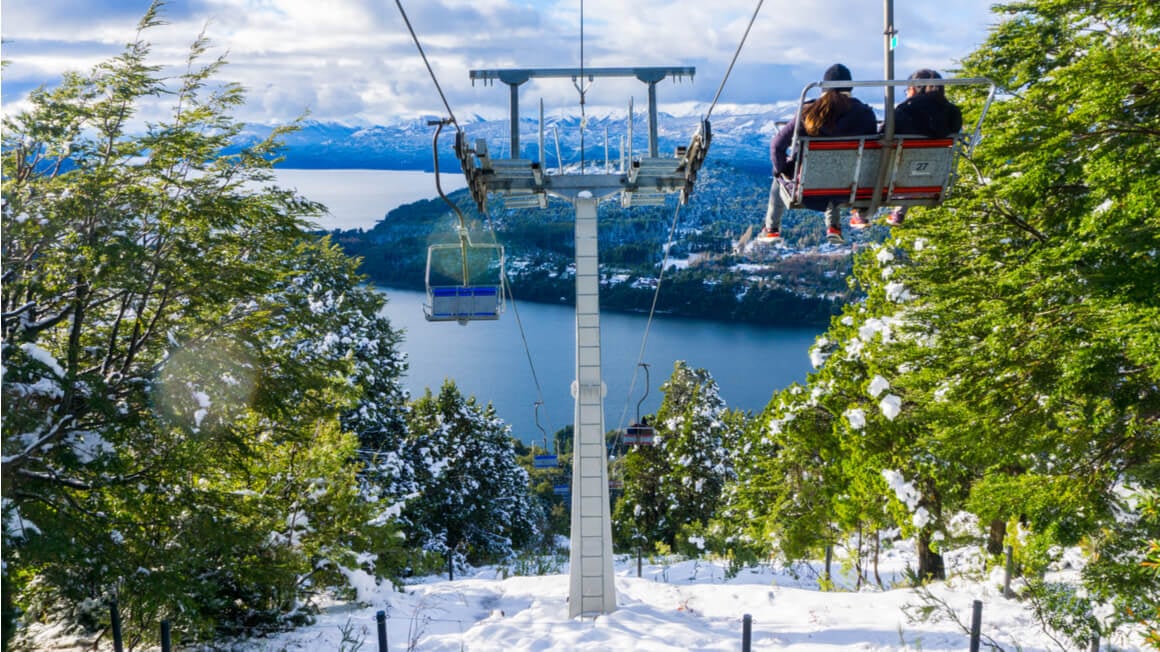
And within this magic-looking land, there is an abundance of outdoorsy adventures. There’s no shortage of world-class mountain activities to slap on your Argentina Itinerary:
- Paragliding
- Snowshoeing
- And more…
Here is South America’s largest ski resort – Cerro Catedral . The younger folk arrive by the busload and spend the nights partying hard too. Staying in a good hostel in Bariloche is where you’ll find the best vibes – and the best routes to the bars.
In the summer, after the snow melts, trekking is super popular. Take advantage of the mountain refuges for the most mind-boggling views. Climbing to Refugio Frey was my favourite!
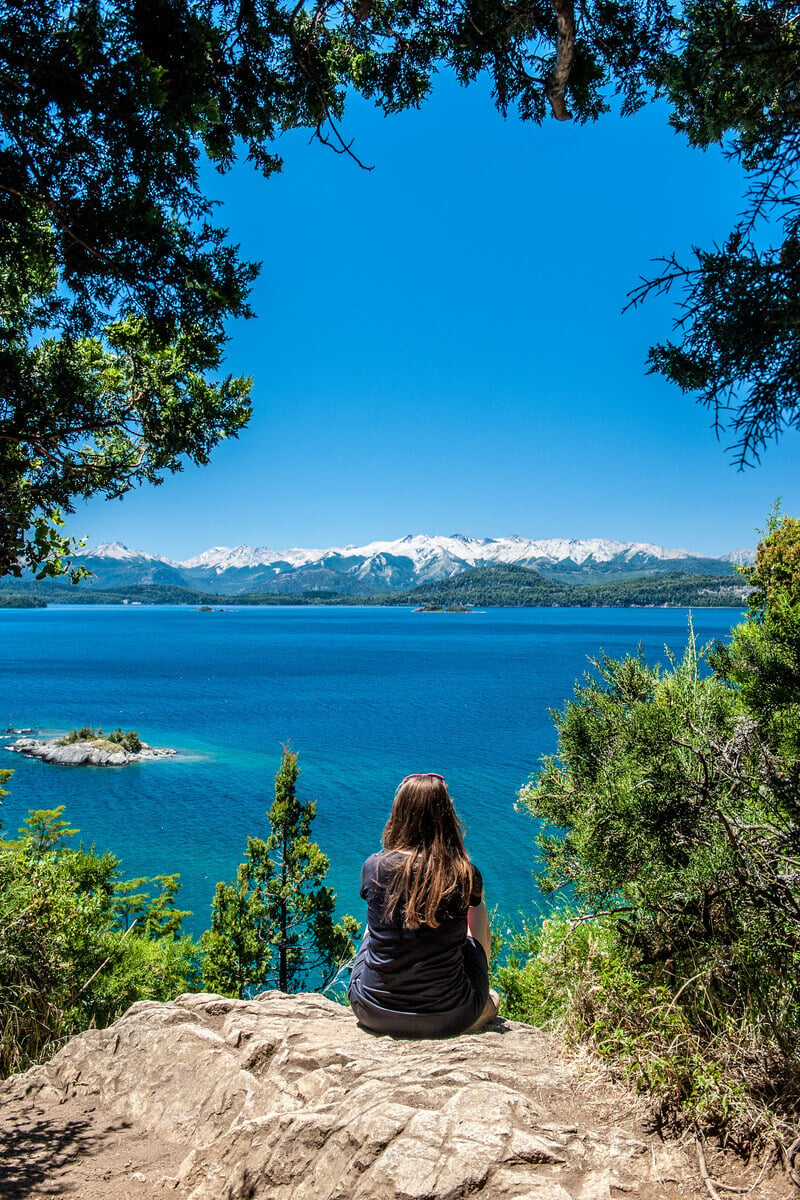
Nahuel Huapi National Park is insane year-round. Don’t miss the opportunity to venture to the lakes and islands and absorb the flora and fauna.
6 hours south of Bariloche is El Bolsón. Tucked away in the secluded Piltriquitron Mountains, people come to escape the stresses of modern living.
El Bolsón boasts some of the highest quality food in Argentina. You could spend your entire trip exploring the organic farmer’s markets and it wouldn’t be a minute wasted. Go ahead and double your body weight in ice cream.
The idyllic conditions mean breweries are overflowing in El Bolsón and brewmasters are getting damn creative. Honestly, I had the most delicious beer here, it made Germany look weak. (Sorry scary Germans, please don’t fight me.)
And, of course, take a day or more to hike around Cerro Piltriquitrón, El Cajón Azul , or Rio Azul .
Backpacking Patagonia
Finally, backpacking Patagonia! Let me tell you about some of my favourite stops: Perito Moreno, El Chaltén, and El Calafate .
Perito Moreno (not to be confused with the Perito Moreno Glacier which is 400 miles south) is not the most adrenaline-pumping place. It’s the location that really sells it.
Positioned halfway between El Bolsón and El Chaltén, it’s perfect to break up a bloody long bus journey. It’s also ideal to cross the border with Chile.
Check out the Cueva de las Manos : a UNESCO site of prehistoric painted hands and depictions of local wildlife, upwards of 13,000 years old! Personally, I thought it was super cool.
El Chaltén is the heart of Patagonia! Its close proximity to Los Glaciares National Park makes it an unmissable stop.
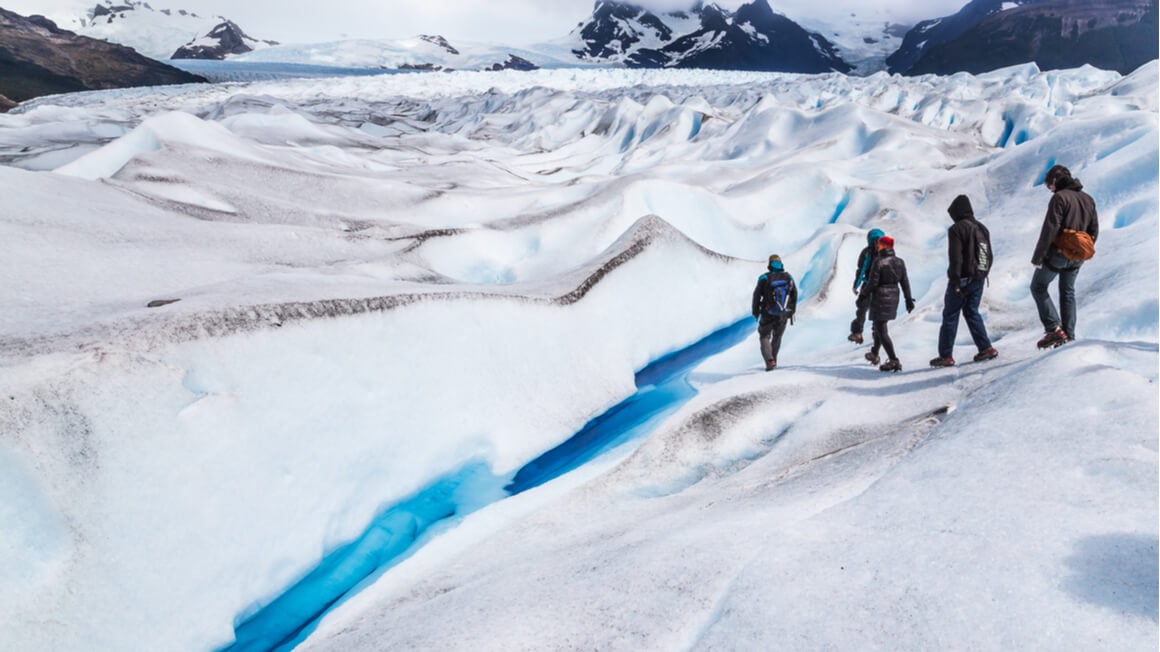
The region’s most notable peaks – Fitz Roy and Cerro Torre – tower in the distance and attract hikers and climbers year-round seeking to brave the malicious conditions. You have a plethora of world-class trails in El Chaltén to hike.
Traversing the epic Patagonian Ice Field is something you won’t forget for the rest of your life. Though this is NOT for novices; those who embark on this trek must be ultra-prepared. There’s no doubt you will feel on top of the world if you make it, though.
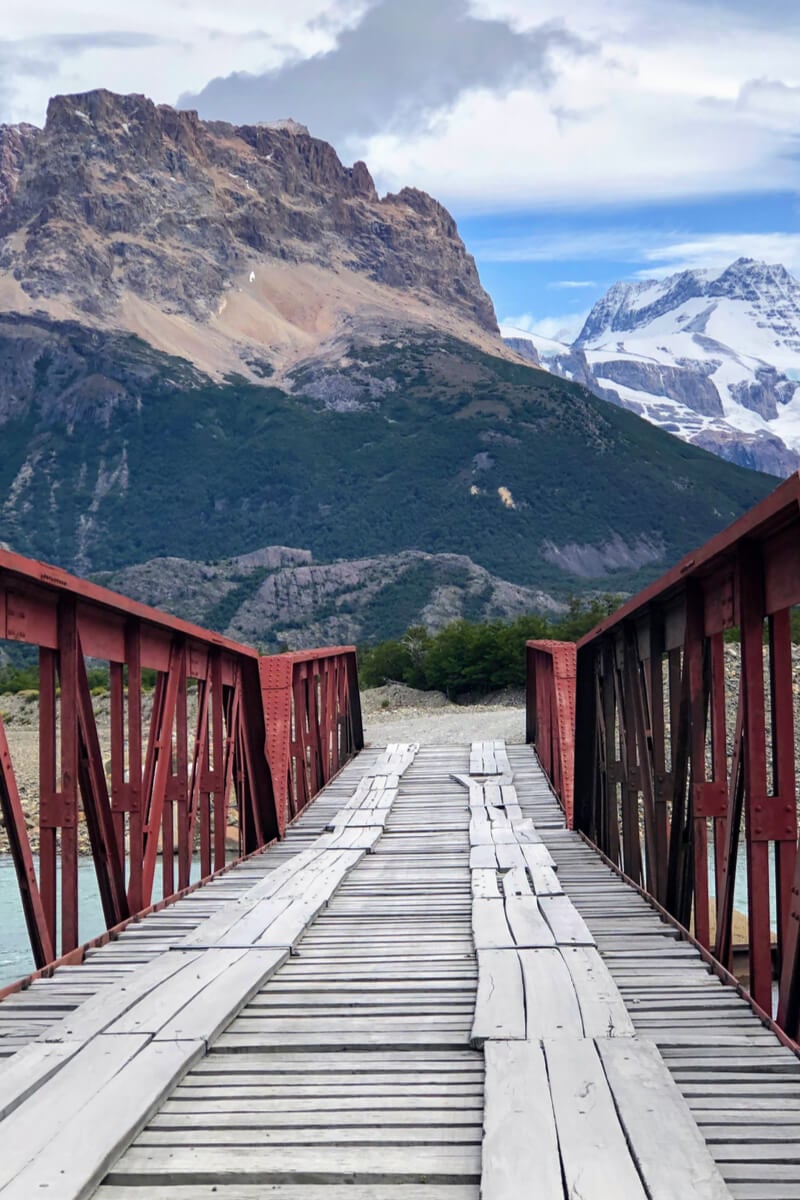
A few hours drive from El Chaltén is El Calafate : the jumping-off point to see the mighty Perito Moreno Glacier . It’s actually 50 miles away from El Calafate but – in Argentina terms – this is “close”.
If you’re kitted out you can walk across the glacier. It’s easily one of the most beautiful things I’ve ever seen. The Perito Moreno Glacier strikes an indescribable cobalt blue that gives you the chills – inside and out. End your expedition with the most satisfying beer you’ve ever drank.
If you’re a museum nerd (like me) the Glaciarium is the place to learn about the big-ass ice block. Inside the ice bar, you can grab a fernet and coke (a love or hate it kinda alcoholic drink).
A little more off the beaten track are the periphery Glaciares, Upsala and Speazzini .
Getting Off the Beaten Path Travel in Argentina
Even within the most heavily touristed regions, like Buenos Aires or Patagonia, there are areas that visitors rarely see. So travelling off the beaten path while backpacking Argentina is easy . There are endless places to stop and watch the world go by.
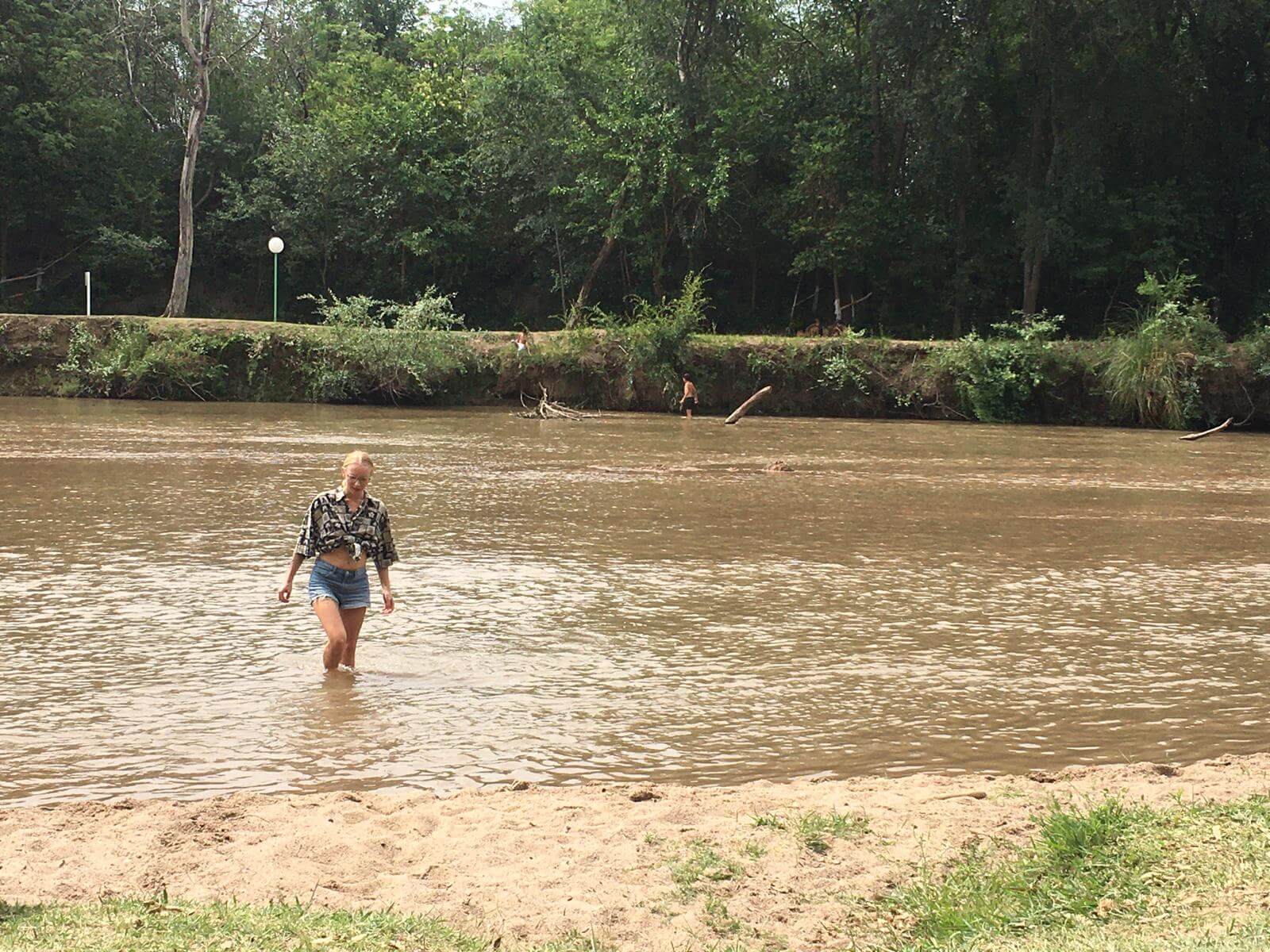
There are plenty of places to see incredible wildlife, flora, and fauna in Argentina. Though this is the part where I’m going to tell you to be very mindful if you’re taking part in animal tourism .
Puerto Madryn will satisfy your beach cravings. It’s also a place to spot whales, dolphins, sea lions, and penguins.
In the northeast, the swampy region of Iberá Wetlands is Argentina’s most ecologically diverse location. It’s overflowing with phenomenal natural sights.
Peninsula Valdes is a place of extreme marine diversity. Scientists compare it to Ecuador’s Galapagos Islands. Capybara, giant anteaters, howler monkeys, anacondas, marsh deer, caimans, and more, all call this place home.
Not many people make it to Ushuaia – Tierra del Fuego. Mostly because it’s damn far and expensive to get to. But if you make it to the Land of Fire , get ready for some of the best hikes in the world . Explore Tierra del Fuego National Park and scale the Martial Glacier .
Ushuaia is the best launching point to take a trip to Antarctica too. Though be warned: they are ridiculously expensive.
I had some of the best nights of my life just bouncing around the hometowns of the locals in places like Paraná and Santa Fe ; share mate , indulge in empanadas, and try every kind of beer.

We’ve tested countless backpacks over the years, but there’s one that has always been the best and remains the best buy for adventurers: the broke backpacker-approved Osprey Aether and Ariel series.
Want more deetz on why these packs are so damn perfect? Then read our comprehensive review for the inside scoop!
Of course, you’re going to find great things to do in Buenos Aires . But backpacking Argentina is much more than the capital city.
So get out there and create your unique Argentina itinerary!
1. Go to an Asado
The most cultural Argentino experience is the Asado . The gathering is centred around slabs of meat, cooked to perfection, on a type of grill called a parrilla .
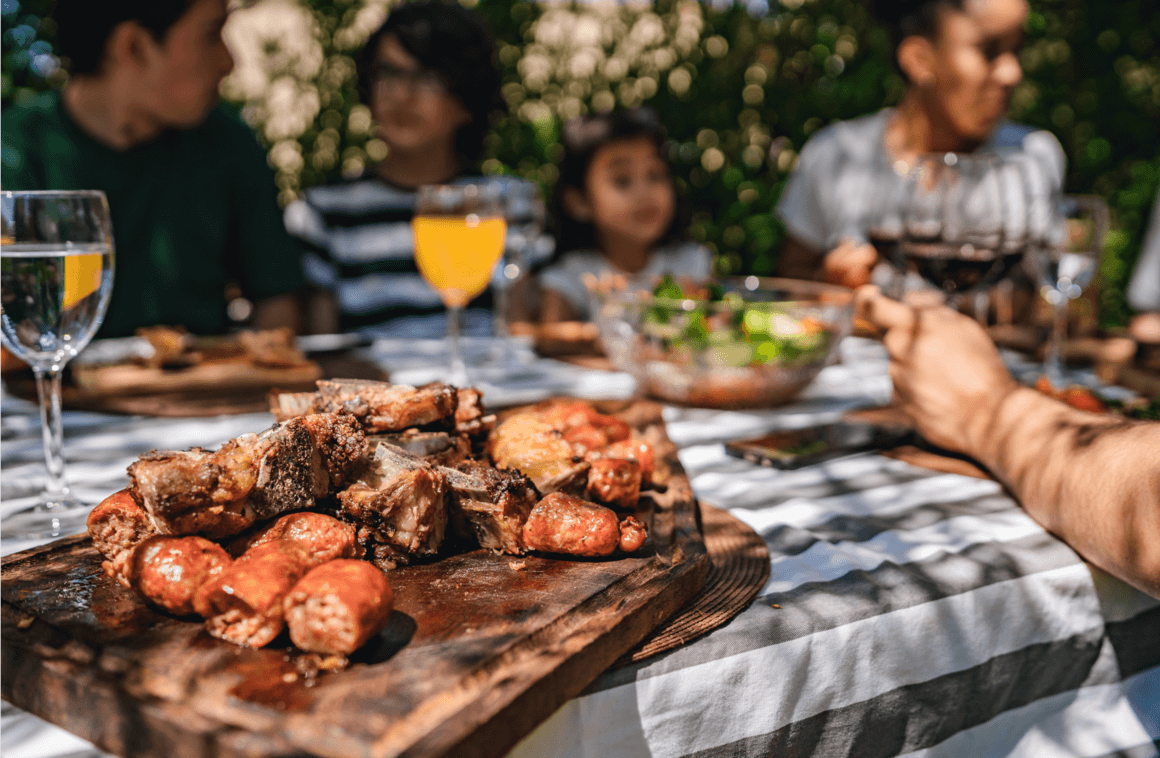
But Asado is not just about the food: it’s more about the company. It’s a very social experience and definitive of who Argentinians are.
Plus, dessert usually involves dulce de leche. That alone is worth selling your soul for.
2. Join the insanity of a football match
I’m from the UK – and I thought we were football crazy – until I went to Argentina. If you love football, this is basically a pilgrimage. If you don’t like football, you’re still in for a hell of an experience.
Players are idolized, deified even – as is the case with Diego Maradona and Lionel Messi – by the masses. Get yourself to a match and prepare for the most energy you’ve ever seen in your life.

3. Bike the wineries in Mendoza
Mendoza is one of the premier wine productions in the world! What a pleasure it is to say that some of the tastiest (and best priced!) wine is right here!
Take a wine-tasting tour to learn the real value of the honoured Malbec grape. Enjoy a glass or 2, or 3… in this fantastical wine region is a guaranteed good time.
4. Experience Iguazú Falls
Iguazú Falls is one of the mightiest scenes on this planet. Grab a rain jacket and walk amongst the towering falls as they plummet 250 feet into the void.
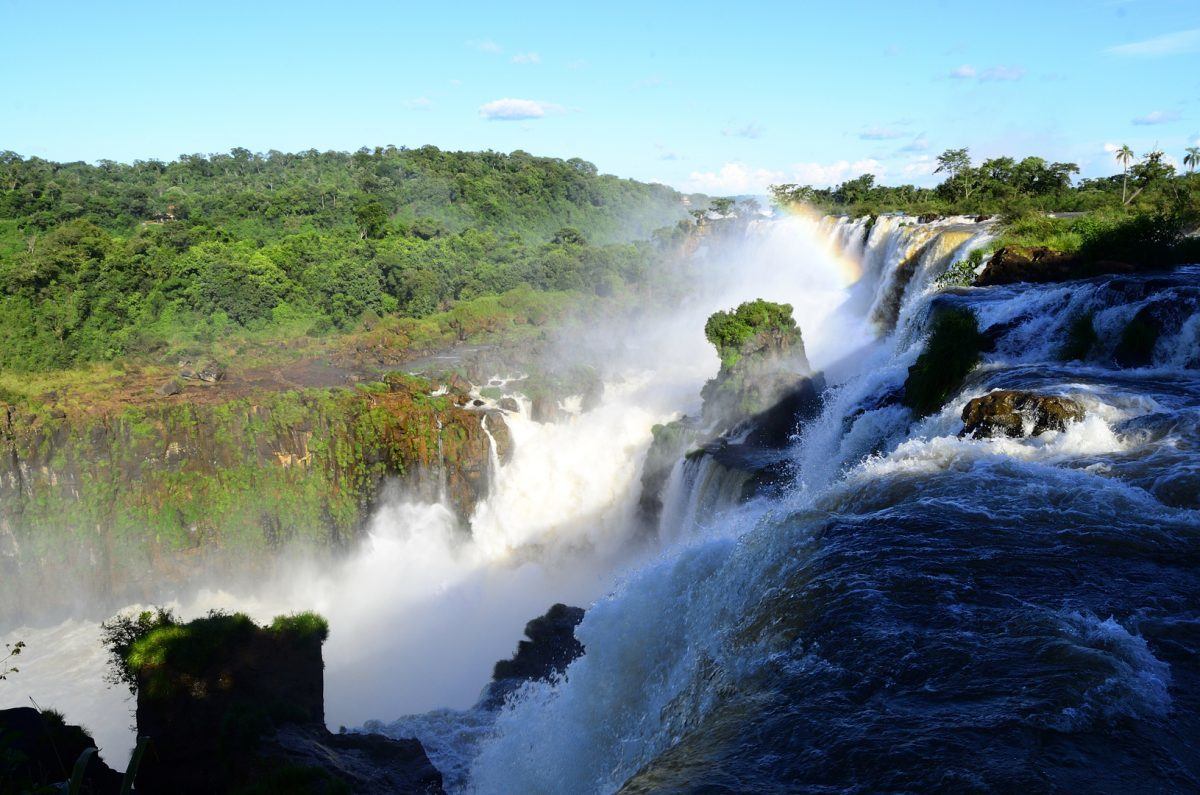
5. Get your walking shoes on!
Who can talk about travelling in Argentina without recommending hiking in Patagonia ? The treks attract walkers from all corners of the world for a reason!
There is really no shortage of trekking opportunities. Grab your boots and take to Cerro Torre, Fitz Roy, and incredible national parks to marvel at their awesomeness.
6. See the life of the Gauchos
Gauchos are Argentina’s version of the cowboy and their relationship with the nation is a long and dramatic one. Visit an estancia and hear about the history that they have of roaming and protecting the nation.
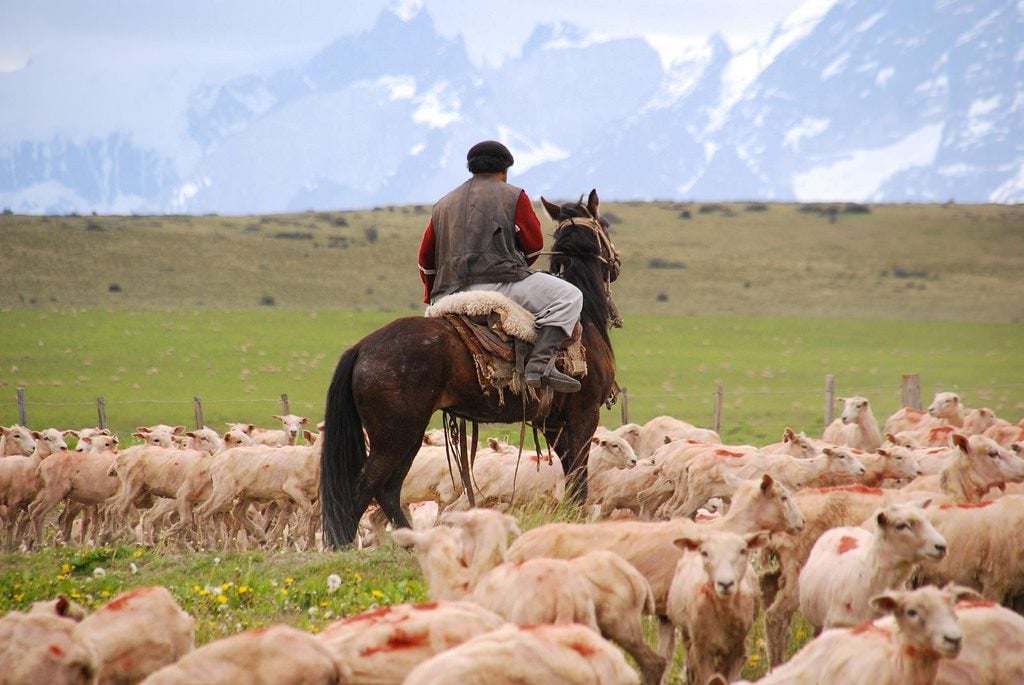
7. Take your mate everywhere
There’s nothing like finding a beautiful spot to just sit and watch the world go by. Then you can do that the Argentinian way too: with your mate (pronounced ma-tey). Mate is usually shared, so it’s a great way to get to know people and share your experience. But even alone, your mate is your friend.
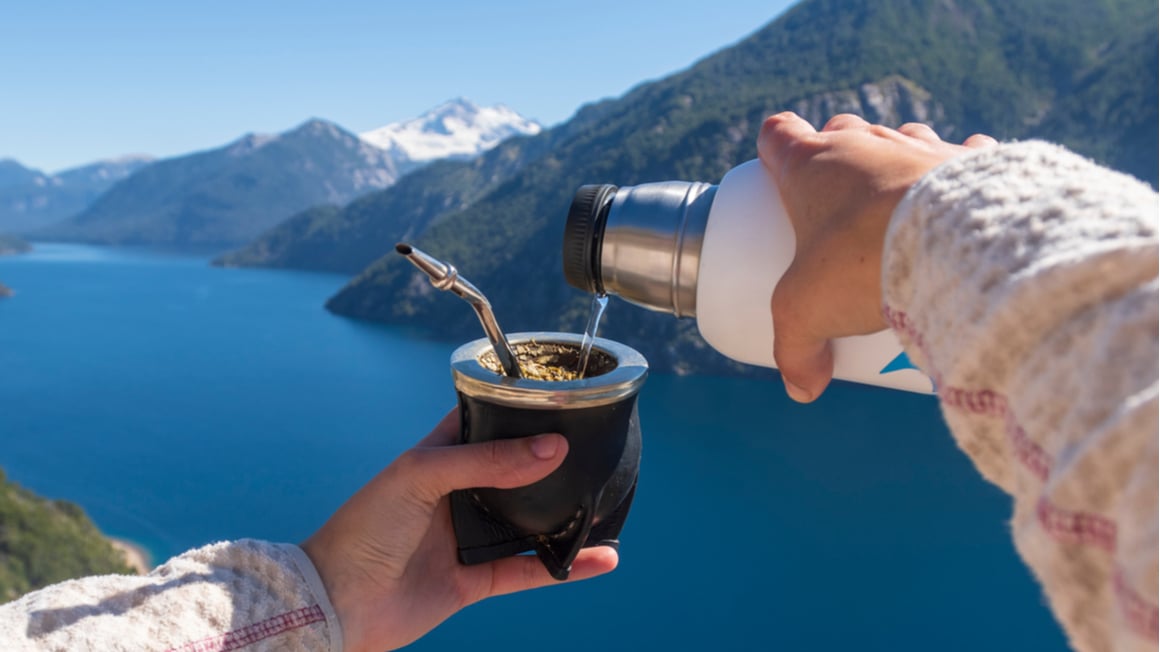
There are stunning parks, mountains, and rivers aplenty in Argentina that become perfect places to take your mate and watch the world go by.
8. Take a road trip
No backpacking route in Argentina would be complete without a road trip. One of the best places to do this is through its finest desert landscapes; some of the biggest deserts in the world in fact!
The Quebrada de Humahuaca road and the Seven Coloured Hills that run through Valles Calchaquí region are both a wild ride. If you have your own transport, you can stop as you please and soak in the splendour.
9. Watch wildlife in Iberá Wetlands or Peninsula Valdes
These are some of the least visited tourist attractions in Argentina due in part to their remoteness. Neither should be missed though as they contain some of Argentina’s most spectacular wildlife!
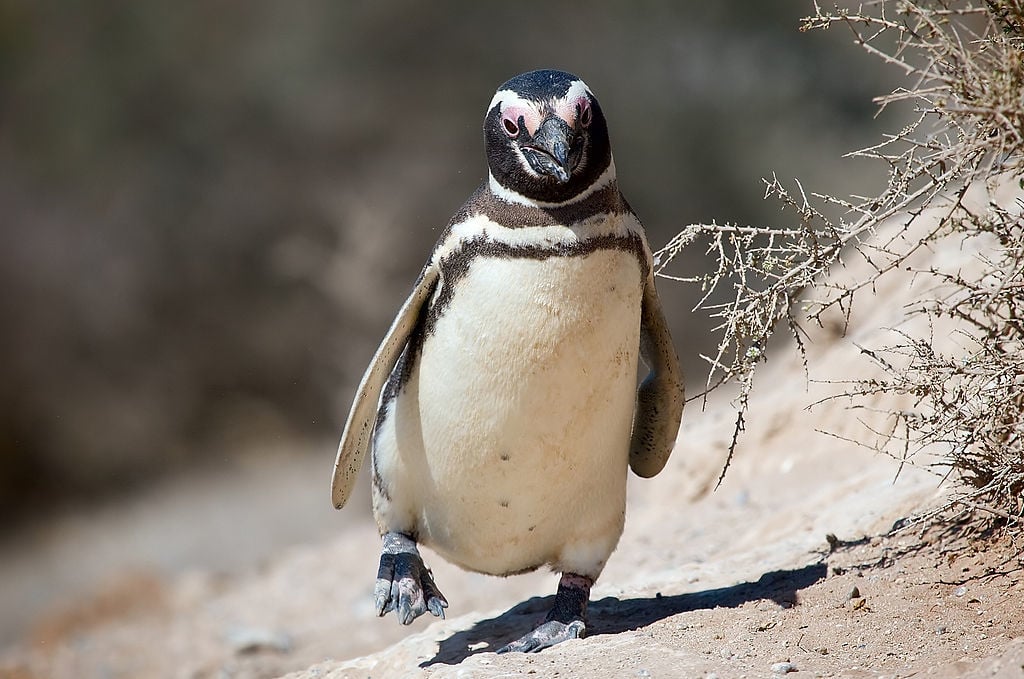
10. An Argentinian
Hey, listen, most backpackers are gonna tell you love and sex while travelling is always something good to partake in. But when I talk about the passion that the Argentinians have, just imagine how that transcends to love …
And the sex? No way… Go find out for yourself.

Wanna know how to pack like a pro? Well for a start you need the right gear….
These are packing cubes for the globetrotters and compression sacks for the real adventurers – these babies are a traveller’s best kept secret. They organise yo’ packing and minimise volume too so you can pack MORE.
Or, y’know… you can stick to just chucking it all in your backpack…
There are a ton of budget backpacker lodges in Argentina! You’ll have no problem finding a place to stay while backpacking Argentina. Of course, there’s an abundance of hostels in Buenos Aires and budget accommodation is ample all over the country.
Many hostels can fill up quite quickly during their respective peak seasons. For example, lodging in Bariloche may be harder to find during the winter when the ski lodges are open.
Conversely, the hostels in Patagonia are busier in the summer when conditions are prime for trekking. In these cases, booking in advance could be beneficial.
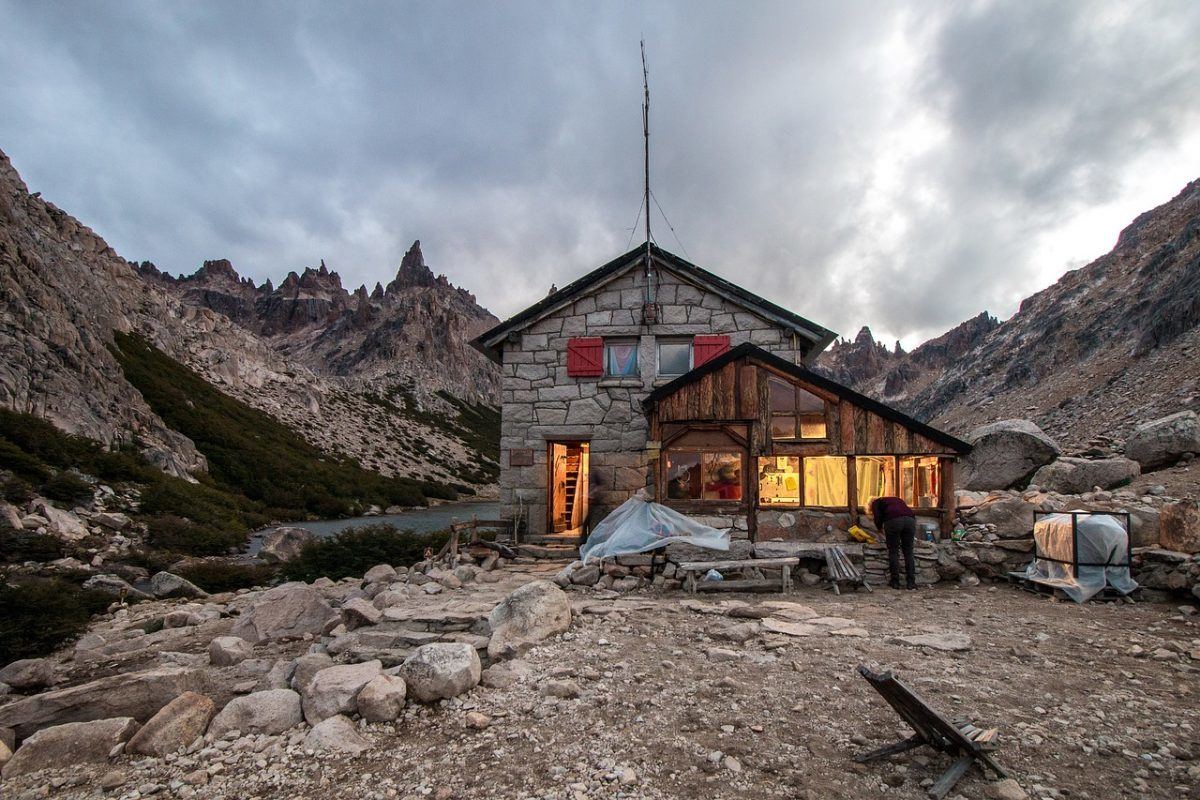
For the best budget accommodation and the best vibes while staying in Argentina, look no further than Couchsurfing . The Argentinians definitely know how to host a guest.
When I’m not Couchsurfing, Airbnb is always my next choice. Having the option to cook your own food saves loads of money. Plus, I’m an introvert: I need my own space from time to time.
Estancias , which are like farm stays or ranches, are another popular form of accommodation in Argentina. This is a great way to experience life in rural Argentina. They can be a bit pricier than a hostel but you can’t get the kind of Argentina experience you can by staying with gauchos from a hostel.
Best Places to Stay in Argentina
Look, you’re going to find great places to stay in Argentina, no matter where you go. But these are some of the absolute best.
Argentina is a paradise for outdoors lovers. There are so many different types of landscape in this country: mountains, tundra, desert, forest, swamp, and more are all represented here. The possibilities for unique adventures are endless.

Things go wrong on the road ALL THE TIME. Be prepared for what life throws at you.
Buy an AMK Travel Medical Kit before you head out on your next adventure – don’t be daft!
Trekking in Argentina
Hikers have probably had a big heart over Argentina ever since they thought about planning a trek abroad . From multi-day treks to little day hikes, the explorer within us will not be disappointed.
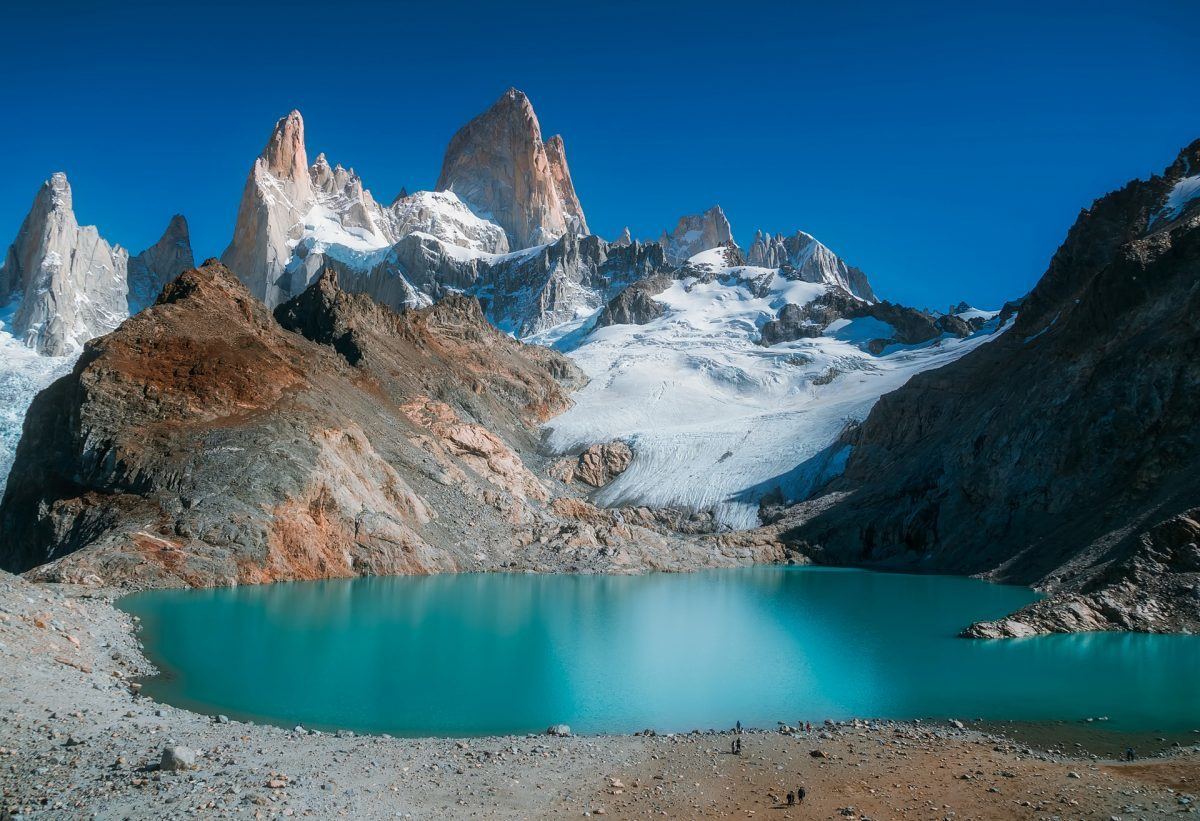
If you’re going to one of Argentina’s many wildernesses or outdoor parks, then I suggest buying all of the necessary camping gear. You’ll save some money that way and avoid paying for rentals via tour operators.
Consider buying a tent and a sleeping mat, or ditch both by investing in a hammock. A good backpacking stove is also a good idea for saving money and creating the best views for your meals.
The Best Treks in Argentina
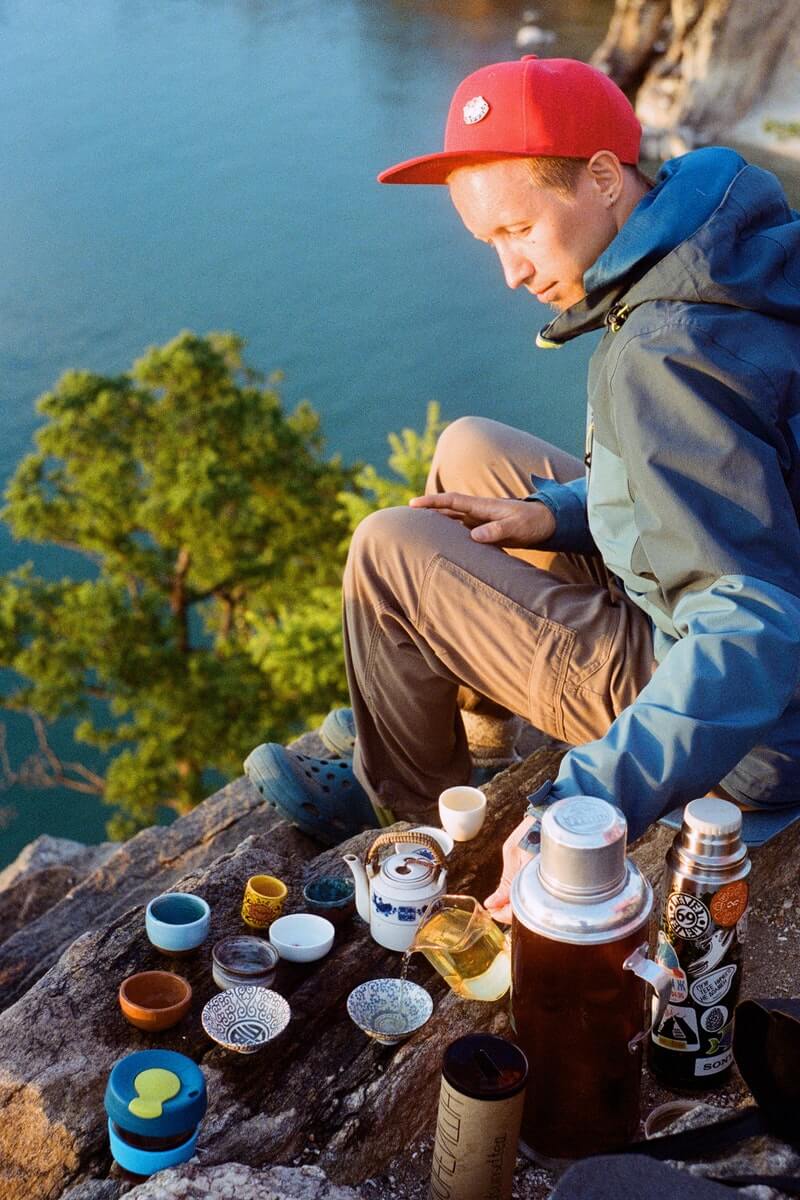
- Los Gigantes (1-2 days, 14 miles) – Big hike into one of the most beautiful portions of the Sierras de Córdoba. Accomplishable via a single (long) day or a multi-day trek.
- Cerro Champaquí from Villa Alpina (12-14 hours, 12 miles) – Reach the summit of the highest peak in the Sierras de Córdoba. May involved overnight camps depending on fitness and itineraries.
- Quebrada de las Conchas (4-5 hours, 6 miles ) – Amazing trek into the Quebrada de las Conchas region of Cafayate. Some of the most stunning desert scenery in Argentina.
- Hut-to-Hut in Bariloche (4 days) – This Spectacular hike affords some of the best views of Nahuel Huapi National Park and its lakes. Tents are optional since you can stay exclusively in the refugios.
- Villa O’Higgins to El Chaltén (2-3 days, 21 miles ) – One of the greatest ways to experience Patagonia. Walk from Villa O’Higgins in Chile to El Chaltén in Argentina. You’ll see some superlative mountain, forest, and lake scenery along the way.
- Laguna de los Tres (8-10 hours, 16 miles) – Hike to one of the most recognized places in all of Patagonia, the Laguna de los Tres at the base of the infamous Monte Fitz Roy.
- Laguna Torre (7-9 hours, 15 miles) – Another must-do hike in El Chaltén, this time to Laguna Torre at the base of the diabolical-looking Cerro Torre.
Hitchhiking in Argentina
Travelling by hitchhiking in Argentina is a pretty common form of transport. There are few roads and lots of drivers heading in the same direction as you, so you can find a good spot easily enough. Just note that hitching in the north of Argentina and hitching in the south are two very different experiences.
The north hosts the larger cities and criminal activity is a little higher here. I hate to say it, but there have been a number of hitchhiking-related crimes – so drivers can be a little cautious. But when you find a ride, drivers are friendly and chatty.
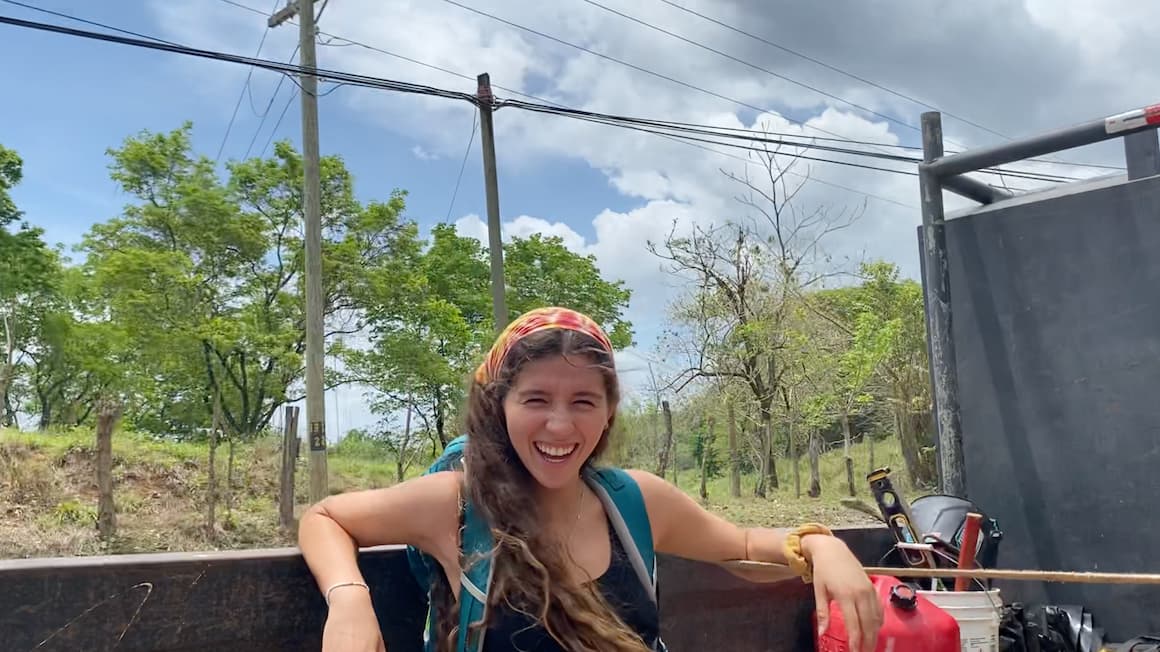
Hitching in the south of Argentina is a matter of finding a ride in the first place. Roads in this part of the country are sparse and there are fewer drivers around.
Drivers are usually more concerned about dealing with treacherous roads and not about picking up hippies. Trying to find a ride in Patagonia in any season outside of summer can be a bleak and very uncomfortable experience.
I would also say to not expect a free ride. Discuss with the driver beforehand about what you’re doing and maybe, at the very least, offer to buy some lunch.
To put it frankly, Argentina is cheap as holy shit right now. In some areas, it even compares to the likes of Southeast Asia. What is a shit situation for local people is shouting us broke backpackers from the rooftops.
I can write a whole essay about the cost of backpacking Argentina. It’s constantly in financial crisis . On top of this, with the effects of the pandemic, the economy has taken its biggest hit.
The Argentinian Peso is constantly suffering inflation. This has led to the black market money exchange in Argentina.
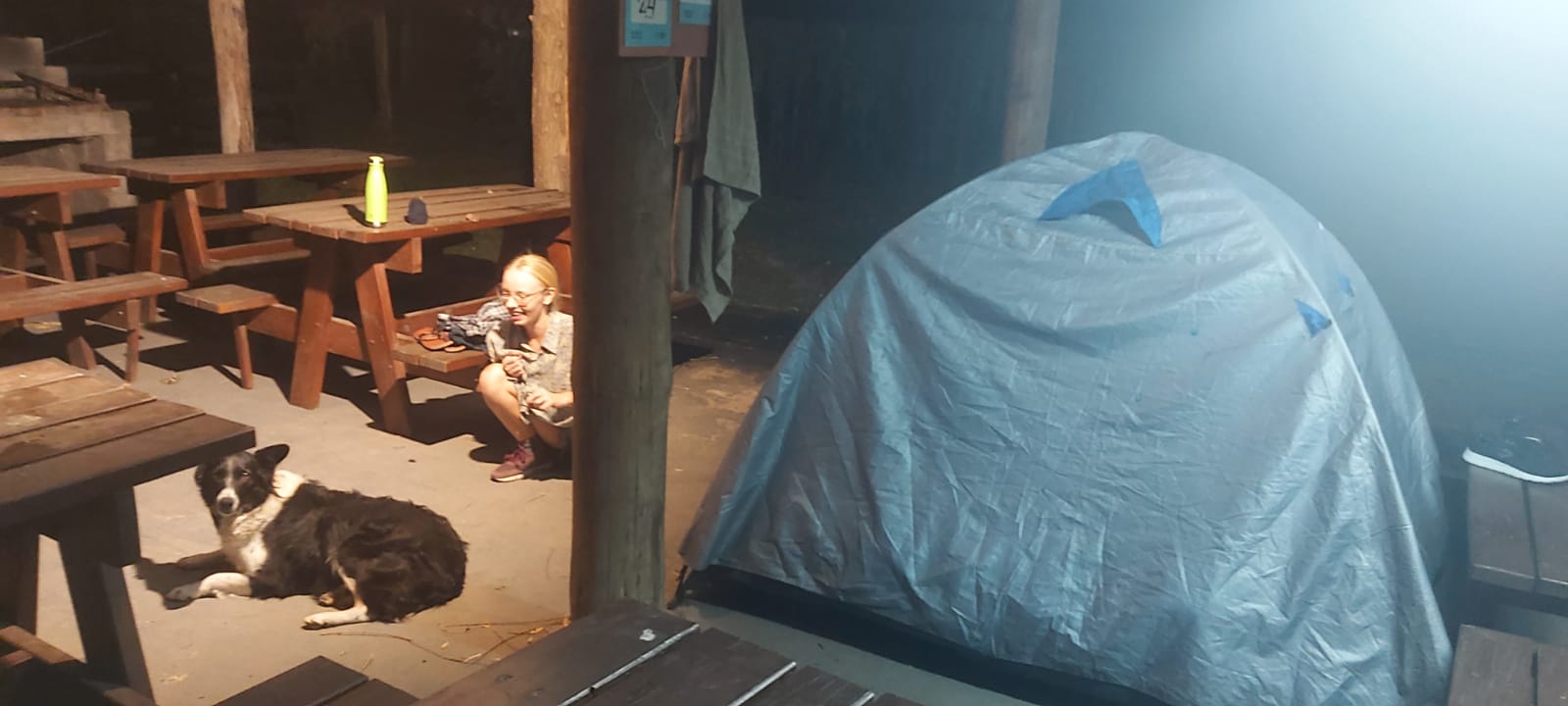
As always, Couchsurfing and camping are the best ways to save on lodging. You can find a camping pitch for less than $5 USD per tent.
Finding cheap food is the least of your concerns. It’s everywhere. Tell me empanadas are $0.35 cents each and I’m rolling out the joint.
Eating out is definitely affordable. A meal for 2 at restaurant, bottle of wine, AND a tip for the staff for less $10 USD is easy. (Tipping isn’t necessary – and I’m not usually a tipper either – but I had to leave a tip for this price.)
Long-distance buses are generally pretty cheap. Overnight buses are super comfy saving your accommodation. 😉 Avoid internal flights if you are on a tight budget while backpacking Argentina.
Obviously in the more remote areas, like Patagonia, prices are higher than in the rest of the country. If you’re going there, you can expect a higher budget. It’s beautiful though so totally worth it.
With some consciousness, a broke backpacker’s budget of $10 USD is easily doable here. If you feel like letting go a bit, a $40 USD daily budget will see you to a very good time.
So budget travel in Argentina is alive and well! Your money will go far here and you can help out a lot of people with your tourism.
A Daily Budget in Argentina
So let’s put it simply. Here’s a quick breakdown of the daily costs of travel in Argentina.
Money in Argentina
The currency in Argentina is the Argentine Peso. With constant inflation in Argentina, you’re going to be seeing a lot of it. Knowing the tricks with this is one of the hottest travel tips for South America right now.
As of writing this (December 2023) here are the current exchange rates for the Argentinian Peso:
The official rate is roughly 800 Argentinian Pesos = $1 USD
The “Dólar Blue” rate is 960 Argentinian Pesos = $1 USD
This brings us to the black market in Argentina . You will notice a drastic difference between exchanging money “officially” and exchanging money on the black market – also known as the “Dólar Blue” .

The best way to exchange money on the black market is to bring money in USD and exchange money when you arrive. You’ll find people selling, and you can always ask for advice when you arrive. The locals are using USD to save money from inflation so they’re more than happy to help you out.
Of course, there is a risk in arriving with loads of dollars: Argentina, is not the place to be prancing around with a fat stack – unless you feel like losing it. So hide your cash well while travelling.
You can retrieve money through Western Union at the black market rate. Beyond this, as far as I know, any other way to exchange money means you’re going to get ripped off.
There are ATMs in most places. But I wouldn’t recommend using them. If you’ve no other option – they’re there.
For all matters of finance and accounting on the road, The Broke Backpacker strongly recommends Wise – The Artist Formerly Known as Transferwise! Our favourite online platform for holding funds, transferring money, and even paying for goods, Wise is a 100% FREE platform with considerably lower fees than Paypal or traditional banks.
But the real question is… is it better than Western Union?
Yes, it most certainly is.
Travel Tips – Argentina on a Budget
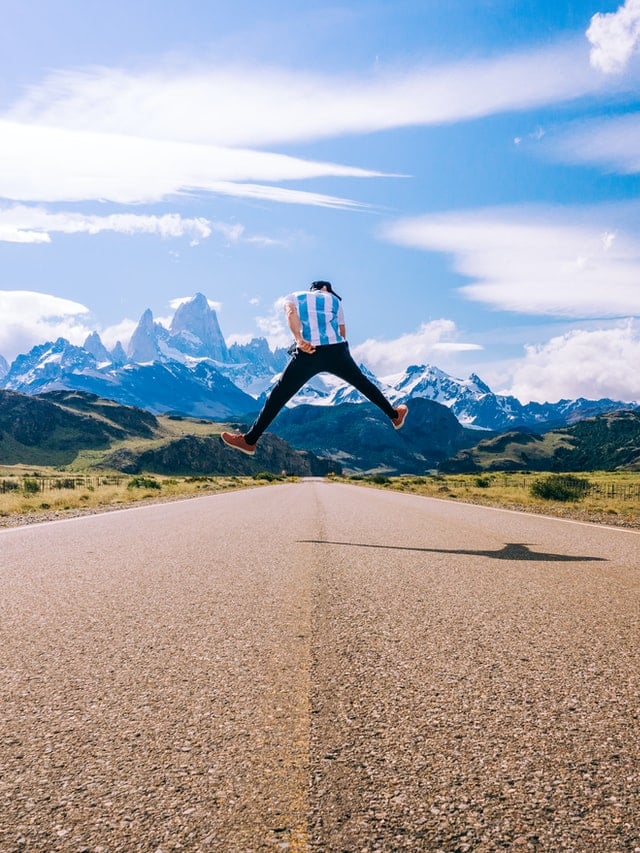
- Camp : Argentina is one gorgeous country to camp, especially in the rural areas. It has been known to even pitch tents in people’s yards (and maybe get invited to an asado). Having a good backpacking tent is your first step to outdoorsy goodness.
- Cook your own food: If you are on a tight budget, you can save money by cooking your own food. Having a portable backpacking stove is a badass trick too.
- Book your transportation early: Both plane and train tickets are much cheaper if you purchase them in advance. This rule doesn’t apply to buses, you can book them the same day or even hour.
- Couchsurf: Argentinians are awesome but I wouldn’t stay anywhere without solid positive reviews. You know this shitty world means that travelling as a woman means we have more personal safety to consider. That being said, Couchsurfing makes real friendships and you see this country from the local perspective.
Why You Should Travel to Argentina with a Water Bottle
We’re globally aware of the plastic problem now, and it can seem overwhelming sometimes to change your habits. But little by little, we can make a difference.
One of the easiest ways to reduce single-use plastic in your life is by carrying a filtered water bottle. You don’t have to worry about the safety of the water, nor do you have to lean on buying plastic bottles every day. It’s one simple step to continue on the road of being a responsible traveller .
Plus, now you don’t have to PAY for water either! Because that really is absurd… Travel with a filtered water bottle and never waste a cent nor some poor fish’s life again.

Drink water from ANYWHERE. The Grayl Geopress is the worlds leading filtered water bottle protecting you from all manner of waterborne nasties.
Single-use plastic bottles are a MASSIVE threat to marine life. Be a part of the solution and travel with a filter water bottle. Save money and the environment!
We’ve tested the Geopress rigorously from the icy heights of Pakistan to the tropical jungles of Bali, and can confirm: it’s the best water bottle you’ll ever buy!
If you haven’t realised by now – Argentina is a massive country and spreads across multiple latitudes. Climate is extremely varied in Argentina; it has regions of excessive heat and humidity, bone dry deserts, highly unpredictable sub-arctic, and everything in between.
But generally, Argentinian weather is generally warm and wet in the summer (December – February) and cold and dry in the winter (June – August). Patagonia is the exception to this rule as it is warm(ish) and dry(ish) in the summer.
Summers are hot in the northeastern corner of Argentina . It can be almost unbearable at times actually. Buenos Aires, Mar del Plata, Rosario, Iguazú Falls, and Córdoba all fall under this category. Winter in these locations will be pleasingly mild and relatively dry.
Northwestern Argentina is predominantly a desert climate so summers here will be very hot while the winters can be quite cold. They are treated to nice summer thunderstorms from time to time. But as it’s the mountains, it can vary a lot.
Finally, the climate in Patagonia is just nutty and very location dependent. Some parts of the region have predictable weather and others are a complete wild card. Summers are generally drier but not exempt from thunderstorms. Winters are almost always cold and snowy.
Honestly, backpackers can visit Argentina at any time of the year; when you go is really dependent on what you want to do. Argentinian winters are great for skiing, and Buenos Aires will be nice and cool. Summer can be super hot and wet, but everyone is in very high spirits.
What to Pack for Argentina
A backpacking South America packing list can look a little different from packing lists for other continents. My mosquito net is my prized possession.
But on every adventure, there are 6 things I never go travelling without:

Snoring dorm-mates can ruin your nights rest and seriously damage the hostel experience. This is why I always travel with a pack of decent ear plugs.

Hanging Laundry Bag
Trust us, this is an absolute game changer. Super compact, a hanging mesh laundry bag stops your dirty clothes from stinking, you don’t know how much you need one of these… so just get it, thank us later.

Sea To Summit Micro Towel
Hostel towels are scummy and take forever to dry. Microfibre towels dry quickly, are compact, lightweight, and can be used as a blanket or yoga mat if need be.

Monopoly Deal
Forget about Poker! Monopoly Deal is the single best travel card game that we have ever played. Works with 2-5 players and guarantees happy days.

Grayl Geopress Water Bottle
Always travel with a water bottle! They save you money and reduce your plastic footprint on our planet. The Grayl Geopress acts as a purifier AND temperature regulator. Boom!
So you’ve heard the rumours. But let’s get it straight: it IS safe to travel Argentina .
Of course, crime is an issue in South America. But crime is an issue everywhere in the world. The vast majority of travellers in Argentina will tell you they had no problems at all by following common-sense travel safety practices .
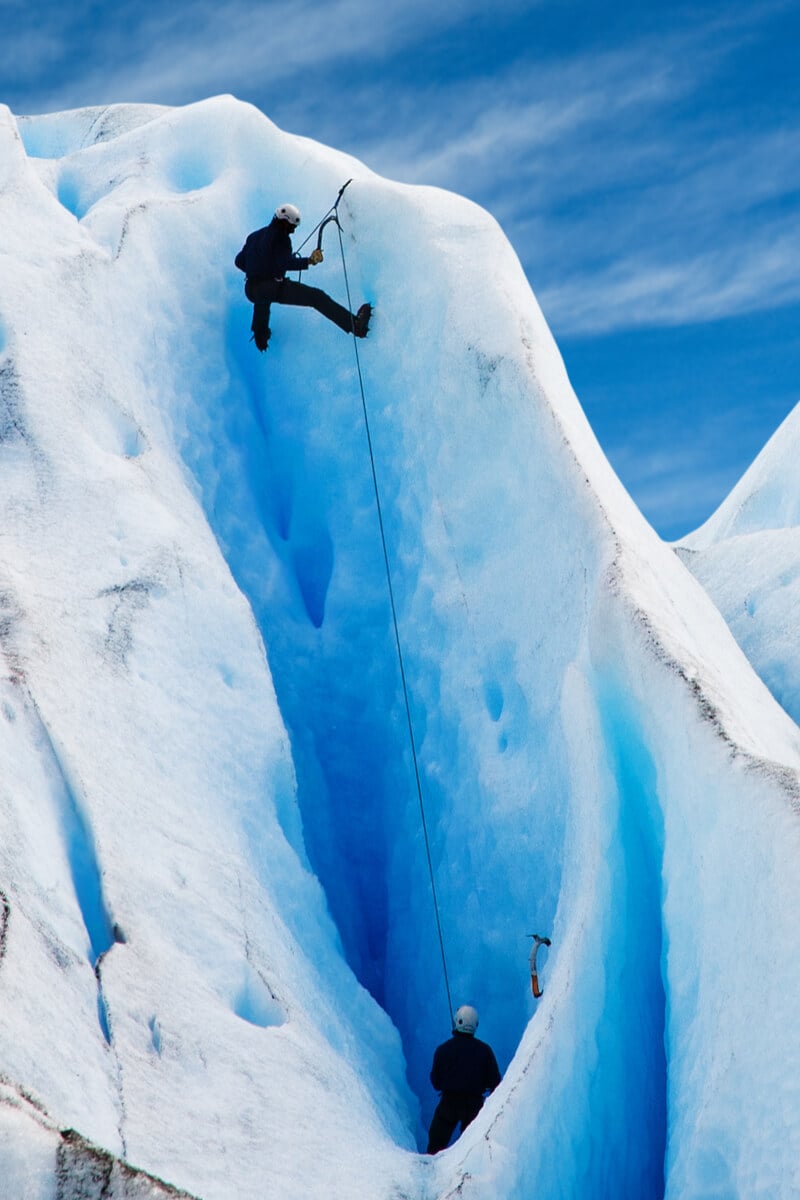
There are certain areas that hold higher risk than others. Large urban cities have the highest crime rate – obviously. But most crime is petty in nature involving pickpockets, scams, and theft of unattended items; violent muggings are not frequent occurrences.
It’s worth asking locals about neighbourhoods you should avoid. Here is a map outlining the safer and more unsafe areas of Buenos Aires . There’s nothing of interest to a traveller outside of the “safe zones” anyway, so you won’t miss a thing.
It should be noted too that drunk driving is a problem in South America. Road accidents are common – please take extra care around the roads. I would go out on a whim and say this is the most dangerous part of travelling in Argentina.
Sex, Drugs, and Rock ‘n’ Roll in Argentina
You know I said the Argentinians are passionate people? Well, that goes for partying too!
First off: the party doesn’t start until well after the sun goes down. Most bars and clubs won’t open until midnight and will only close after the sun has risen. Their partying gusto puts Europe to shame – if you can avoid the shitty cachenge music.
Obviously, this is South America, so cocaine is rife and cheap. This is not like cocaine at home – you’re not snorting as much soap powder here – so be very cautious with your limits.
You’ll also find plenty of other pills and powders around if you keep your eyes and ears open. Just be careful when you are buying drugs on the road. Speak with someone you trust and if it feels weird, it probably is.
One of my (many) favourite things about Argentina is LEGAL WEED! Yes, you heard me right.
The law regarding marijuana has been relaxing for years and most stoners have taken to growing their own plants. It even goes so far as some people being legally permitted to grow and distribute now. Fuck yeah, Argentina!
And now for the sex part: Argentinians are famous for that one. It seems like people are falling in love with Argentinians left, right, and centre! They’re just intensely beautiful and passionate people.
Loving and being loved by them is an experience like no other. So if you’re ready to jump into the dating pool, Argentina could well be the place to do it.
Travelling to Argentina is fairly simple. If you’re travelling from outside of South America by air, chances are you’re landing in Buenos Aires. If you’re arriving from inside South America by air, chances are, it’s still Buenos Aires .
There are plenty of land crossings from neighbouring countries to Argentina. All of these are very easy to conduct. The bus companies are so used to doing these routes so it’s usually a very smooth process.
There is an entry port by boat from Uruguay too. Though this isn’t that common a route.
Entry Requirements for Argentina
Most Western nations can travel to Argentina visa-free for 90 days , depending on your country of origin. For many, the fees have also been waivered! One more reason to visit Argentina.
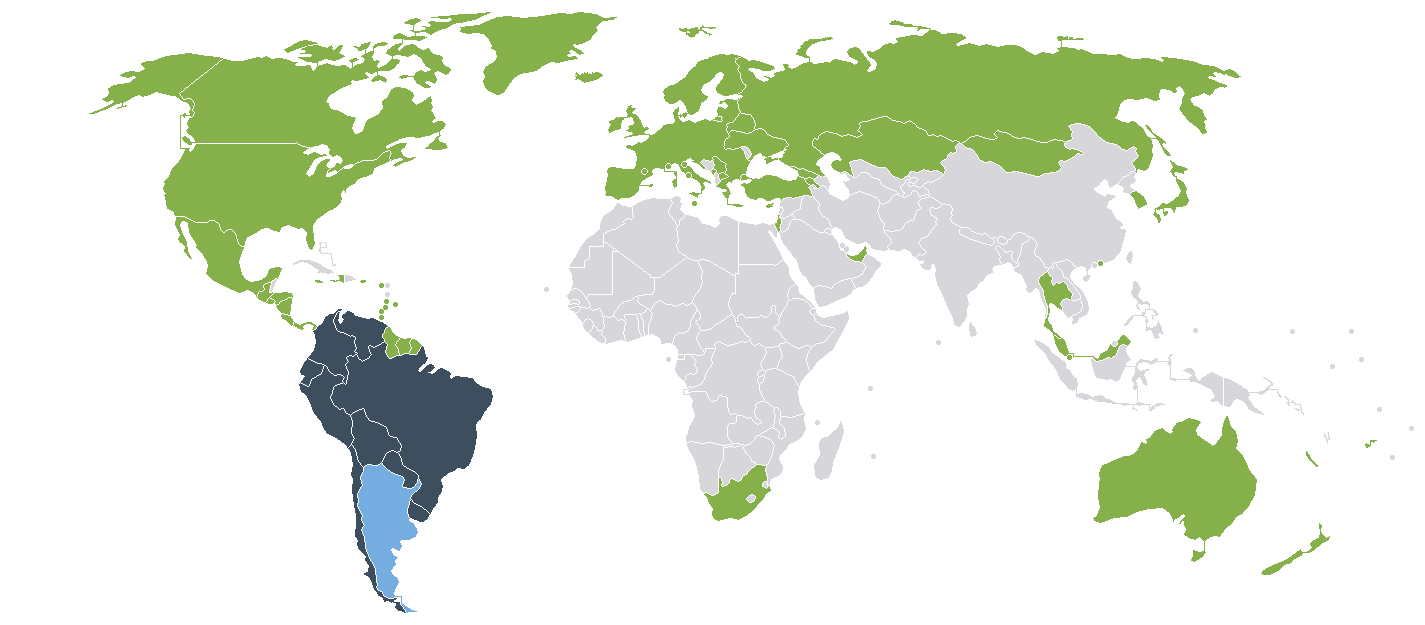
Some nationalities will need to apply for an Argentinian visa prior to arriving. Referring to the map below: those from the nations that are not blue or green will need to contact their local embassy before visiting Argentina.

Get 15% OFF when you book through our link — and support the site you love so dearly 😉
Booking.com is quickly becoming our go-to for accommodation. From cheap hostels to stylish homestays and nice hotels, they’ve got it all!
Travelling between destinations in Argentina is not a quick affair. So no matter which forms of transport you choose, get comfy and enjoy the ride.
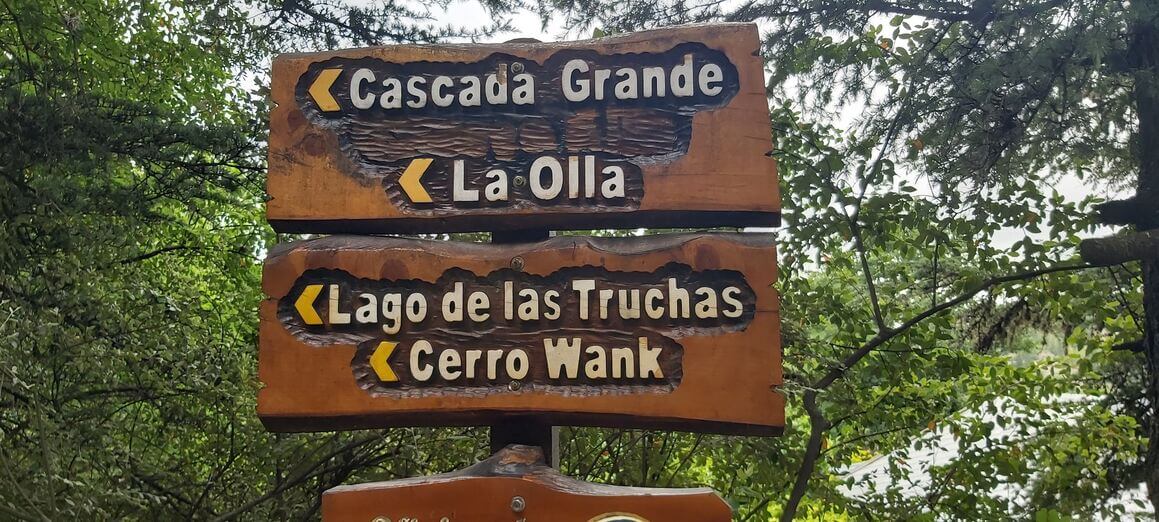
Buses are your new best friend for getting around Argentina! Locally known as the colectivo , they’re comfortable, reliable, and really reasonably priced. Depending on how you like to travel, there are multiple ways to get between major Argentinian destinations.
The best option for travelling in Argentina is undoubtedly driving. Having your own car opens up all kinds of possibilities to enjoy the road less travelled.
Car sharing is very common. One of the best travel apps for Argentina is Carpoolear , which works exactly like BlaBlaCar in Europe. It’s usually a bit cheaper and faster than the bus and, if you’re lucky, sometimes they’ll drop you exactly to where you want to go.
Long-distance buses usually have food and a toilet available – though you’d be wise to bring extra snacks and toilet paper with you.
There are 3 different classes: cama , semi-cama , and servicio común . Cama (meaning bed ) is sleeping class with seats that recline to a completely horizontal position. Semi-cama has semi-reclining seats and servicio común has little reclining, if any at all.
You can purchase bus tickets online but it’s usually cheaper to buy them at the bus terminal. Just use the websites to get an idea of which companies are running to where and the time schedules.
There are a limited amount of long-distance train routes available to those backpacking in Argentina. Most trains connect the larger eastern cities like Buenos Aires, Córdoba, and Mar del Plata.
Flying within Argentina can be expensive, but sometimes it’s a mandatory affair. If you want to visit far-flung places like Patagonia or the Valdes Peninsula and have limited time, you’re going to have to fly.
Buy plane tickets ahead of time to save money. Local airlines like Aerolíneas Argentinas are your go-tos.
Take note that Argentinian nationals pay less for flights than foreigners. Remember this when you think a plane is unusually cheap or falsely advertised.
Onwards Travel from Argentina
Argentina shares friendly borders with all its neighbours. Whether you’re heading to backpack Bolivia , Chile, Uruguay, Brazil, or Paraguay, it should never be a hassle.
If you’re heading overland to continue on the South America journey, you have plenty of border crossings to choose from:
You can catch a ferry in Buenos Aires to the lovely Uruguayan town of Colonia, which is just across the Rio de la Plata. There is a slow ferry (3 hours) and a quicker speedboat (1 hour) available.
Both Argentina and Chile share Patagonia, so you can continue your mountain exploration at one of the many crossings here! Many people hop back and forth across the border easily when backpacking in Patagonia and never experience a single problem.
There aren’t many international airports in Argentina. If you’re leaving South America, you’ll probably be heading to Ezeiza Airport in Buenos Aires .
Getting Insured BEFORE Visiting Argentina
It’s no joke: travelling without insurance in Argentina is risky. Even with all the best intentions, you simply can’t prepare for everything.
In a worst-case scenario situation, the last thing you want to think about is how you’re going to pay for healthcare. So having good travel insurance before you set off on your adventure can literally be a life-saver.
ALWAYS sort out your backpacker insurance before your trip. There’s plenty to choose from in that department, but a good place to start is Safety Wing .
They offer month-to-month payments, no lock-in contracts, and require absolutely no itineraries: that’s the exact kind of insurance long-term travellers and digital nomads need.

SafetyWing is cheap, easy, and admin-free: just sign up lickety-split so you can get back to it!
Click the button below to learn more about SafetyWing’s setup or read our insider review for the full tasty scoop.
Argentinians are very confident and engaging people, so much so that they can even seem intense or intimidating. Really, they’re just very social people. You’ll find everyone, of all genders, greets with a kiss on the cheek – and you won’t be exempt from their kisses.
Argentinians can be boisterous – their personalities fill the room. They waste no time in expressing their mind or feelings. But it’s not to be coarse or arrogant; that’s just their way. Truthfully, they’re some of the most admirable people that I’ve met.

They have little regard for poking fun at you, their friends, or themselves. It’s nothing personal. Actually, it’s their way of showing they like you.
Mate (pronounced ma-tey) is a big part of the culture, especially in the Northern regions. The drink is usually shared between groups and they take it everywhere they go. Being from the UK, my tea culture blended perfectly well with this.
The country is a melting pot of ethnicities and races and its people have taken the best features from their European, Latin, and Indigenous ancestors. Seriously, Argentinians are absolutely beautiful people.
If you want to jump into the dating pool, then be ready to jump into the deep end . They are passionate beyond measure and they will speak from the heart.
G auchos are South American “cowboys” and a national symbol of Argentinian heritage. Before they were forced to fight wars for independence, they were peaceful landkeepers.
Today, football is almost a religion in Argentina. You won’t go a day without seeing shrines to Lionel Messi and Diego Maradona and you literally can’t turn a TV on without a football match appearing. Now imagine all that boisterous energy in their thousands at a football match…
Useful Travel Phrases for Argentina
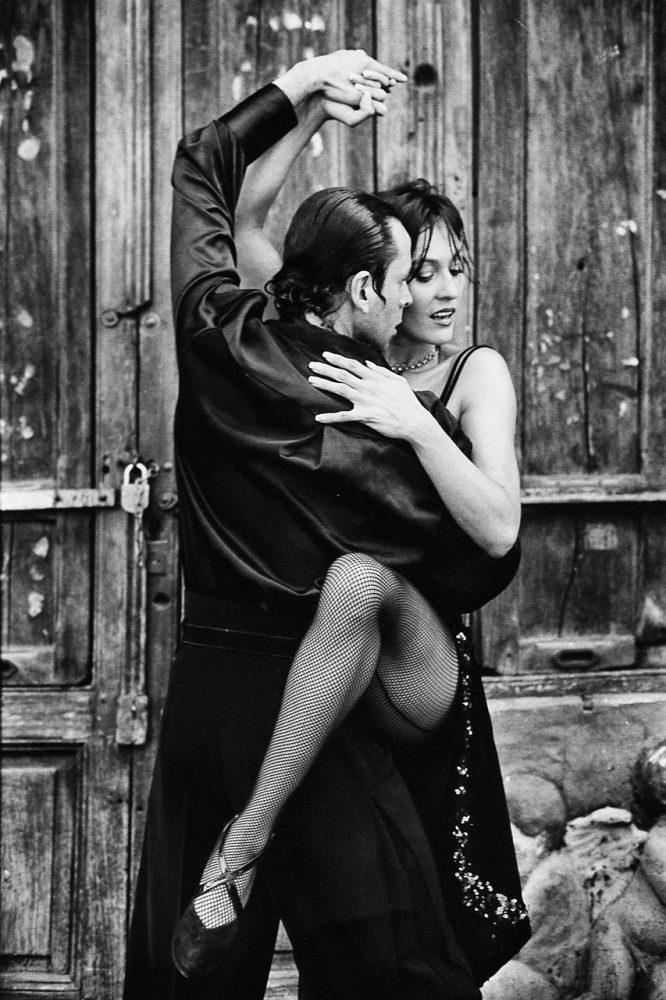
Argentinians speak a very distinct form of Spanish called Castellano Rioplatense . This dialect is different from conventional Spanish. For example, the pronoun tú is replaced with vós .
Argentinians also use slang or Lunfardo – in excess. Lunfardo has no official recognition and is used only in casual conversation. They speak fast and rhythmically, so even if you’re a Spanish speaker, expect a little adjustment phase.
It’s one of the best countries to learn a new language . If you can master communicating in Spanish in Argentina, you’re ready for the rest of South America.
Most Argentinians study English in high school thanks in part to its usefulness and also to the substantial British population. Many locals can communicate with you via English but they love it when you speak whatever Spanish you can muster.
At the very least, learning a few local expressions is useful. So to make your life easier, here are a few helpful Argentinian phrases with English translations.
- Hola – Hello
- Gracias/de nada – Thanks/you’re welcome
- Dónde está…? – Where is…?
- Como te llamas? – What’s your name?
- Buenos dias/buenas tardes/buenas noches – Good morning/afternoon/night
- Cómo andás? – How’s it going?
- Por favor – Please
- Que hora es? – What time is it?
- Cuanto cuesta? – How much does it cost?
- Claro! – Sure/of course!
- Dale! – Let’s go!
- Buenas ondas – Good stuff
- Que es esto? – What is this?
What to Eat in Argentina
There is no way I can open ‘what to eat in Argentina’ without addressing Asado. It’s basically the common friend of the whole nation. The social gathering all centres around MEAT.
The Asado involves excessive quantities of cow, cooked slowly, tenderly , with love, on a parrilla (a grill). It’s more than a barbecue: it’s an art form.
You know it’s the weekend when that hearty smell hits your nose wherever you are in the country. The parrilla is literally part of the house and they get their use out of it.
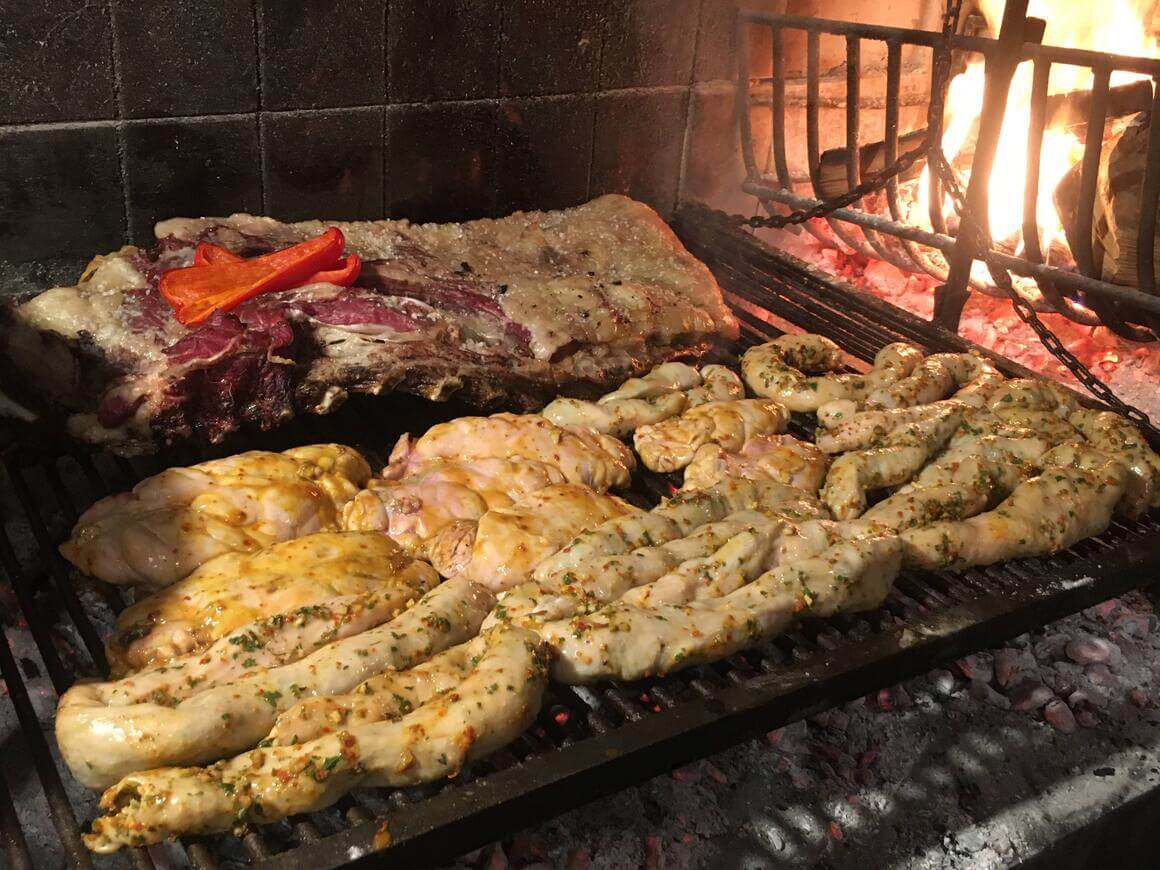
It may or may not be served with salad. But the best Asados are served with chimichurri – a kind of homemade condiment.
Yerba mate is a type of drink. But really, mate is the name of the cup; the yerba is the herb they put inside and drink with hot water, kind of like tea. It’s packed with caffeine and they share the same mate with everyone. Consider it an honour when they pass the mate your way.
If you’ve never tried dulce de leche before, get ready to gain a few kilos. This caramelised condensed milky goodness is everywhere in Argentina: ice cream, alfajores, on bananas, damn even straight off the spoon.
Empanadas are a staple of the diet. These stunning, stuffed pastry pockets come in all flavours. They cost next to nothing so bounce street to street sampling everyone’s soul food.
As a flexitarian, I was kind of revolted by the quantity of meat I saw (and ate) when I arrived in Argentina. But honestly, when I actually looked I was surprised: veggie options are definitely on the rise. I found it easier to avoid meat here than in other countries. It’s the cheese that’s almost impossible to avoid.
For your pleasure, I’ve created a list of 10 of the must-try foods in Argentina.
Must-Try Dishes in Argentina
- Empanadas – Pastries you’ll find everywhere
- Choripan – chorizo sausage sandwich
- Milanesa – fried breaded meat, like schnitzel
- Chipa – cheesy bread balls
- Dulce de leche – caramelised condensed milk
- Asado – meaty Argentinian goodness
- Provoleta – cheese perfect for grilling
- Chimichurri – homemade sauce
- Alfajores – dulce de leche, biscuit, chocolate…say no more
- Yerba Mate – hot infusion drink that’s shared
A Brief History of Argentina
Argentina is a young nation with a brief and turbulent history. Prior to the arrival of Europeans in the 16th century, the land was sparsely populated by native tribes.
The natives repel Spanish conquistadors somewhat successfully until the early 16th century. But this is the beginning of a long and sad story.
Sadly, as we know, European colonization was only a matter of time. The indigenous people were almost completely wiped out by the Spanish invaders.
By the 18th century, a stable settlement of the Spanish Empire is established in the area around the Rio de la Plata . Though brief in existence, this “viceroyalty” soon morphs into the first iterations of the Argentinian Republic.
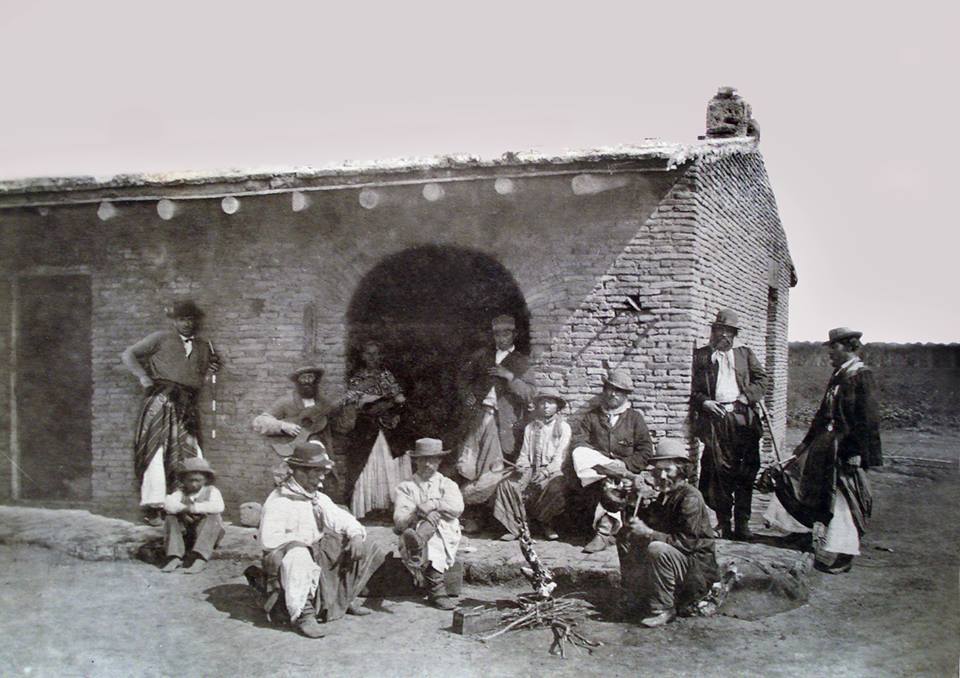
In the early 19th century, Argentina was marked by internal conflicts between federalists and unitarians. Juan Manuel de Rosas was one of the leading figures of this time and was supremely polarizing.
In Buenos Aires, a series of successions and coups opposed him. An official democratic constitution declaring nationhood would finally be ratified in 1853.
Over the next few generations, Argentina is juggled between liberal and conservative parties. Having lost the territories of Uruguay, Paraguay, and Bolivia to the Wars of Independence, Argentina began to expand southward into the desert and Patagonia. By the turn of the 19th century, Argentina resembles its current form.
In the first half of the 20th century, the economy boomed and people emigrated in droves. But key events of this era – World Wars and the Wall Street Crash – leave Argentina in tatters. During WWII, Juan Peron would stage a coup and set Argentina down the path of internal strife yet again.
Since the 1950s, Argentina has suffered brutal dictators and great political upheavals. Although much more stable and safe, the economy and population still suffer the effects. Though, democratic rule has been restored.
Due to the consequences of war, slavery, and colonisation, Argentina is a multi-national country. Today, it is a mixing pot of cultures.
Argentina is a diamond in the rough for the digital nomad lifestyle : reasonable costs of living, cafe culture, widely available, good internet connection; all features that should make remote workers raise their eyebrows. But for some reason, Argentina has not become a digital nomad hub… yet .
Finding regular work in Argentina will be difficult. Unemployment is high and work visas are hard to come by. If you do somehow manage this, don’t expect spectacular wages.

Most people that do work in Argentina are English teachers. Most work 20-30 hours each week with an institute, though some people manage to do just fine with private lessons. To increase your odds of scoring a gig teaching English abroad , it’s always a good idea to get a TEFL certificate.
Broke Backpacker readers also get a 50% discount on TEFL courses with MyTEFL .
Alternatively, Global Work and Travel have a TEFL course in Buenos Aires where you are almost guaranteed a job afterwards. If you haven’t found a job within two weeks, you’ll be assisted in finding one until you do!

Volunteer in Argentina
Volunteering abroad is an amazing way to experience a culture whilst giving something back. Most nationalities can volunteer on a tourist visa for up to 90 days, but long-term stays will have more specific requirements.
Argentina offers a variety of opportunities for backpackers to volunteer. Projects in Argentina range from teaching to agriculture to pretty much everything!. In my personal opinion, the province of Cordoba, in the mountain area, is a very good option combining great weather and people who are cool and receptive to volunteering.
Volunteer programs run through reputable work exchange programs are usually very well-managed and trustworthy. However, whenever you are volunteering, do stay vigilant, especially when working with animals or children.
If you want to find volunteering opportunities in Argentina, I recommend platforms like Worldpackers and Workaway . Although they have their flaws, they are the best way to get your foot in the door of the volunteering community.
Psst… Broke Backpacker readers get a $10 discount when you sign up for Worldpackers. Use the discount code BROKEBACKPACKER .
Is it expensive to travel in Argentina?
No! Argentina is super cheap. If you get a little bit familiar with the black market, you’ll find your money goes far here. Patagonia is the most expensive region in the country. You might see your daily spending creeping up faster if you visit here.
How much time do you need to backpack Argentina?
I would recommend at least 2 weeks for backpacking Argentina. In this time, you could see a few highlights. But it’s a huge country that could be explored for a lifetime. So taking as long as possible to really dive into this country is my real recommendation!
What is the best way to travel around Argentina?
Buses! Or the Colectivo as it’s known in Argentina. Whether you’re travelling long-distance, intercity, overnight, or just to the end of town, buses are going to be your trusty buddy through it all.
Is football popular in Argentina?
Is the pope Catholic? Yes… he is. Football is basically a religion in Argentina. You couldn’t avoid it if you wanted to. I’ve never seen a nation more obsessed with the game.
Argentina is one of those countries that leaves a big, fat print on a traveller’s heart. It is extreme; from the shores of the Atlantic to the tallest tips of Patagonia, this immense country has so much to teach you.
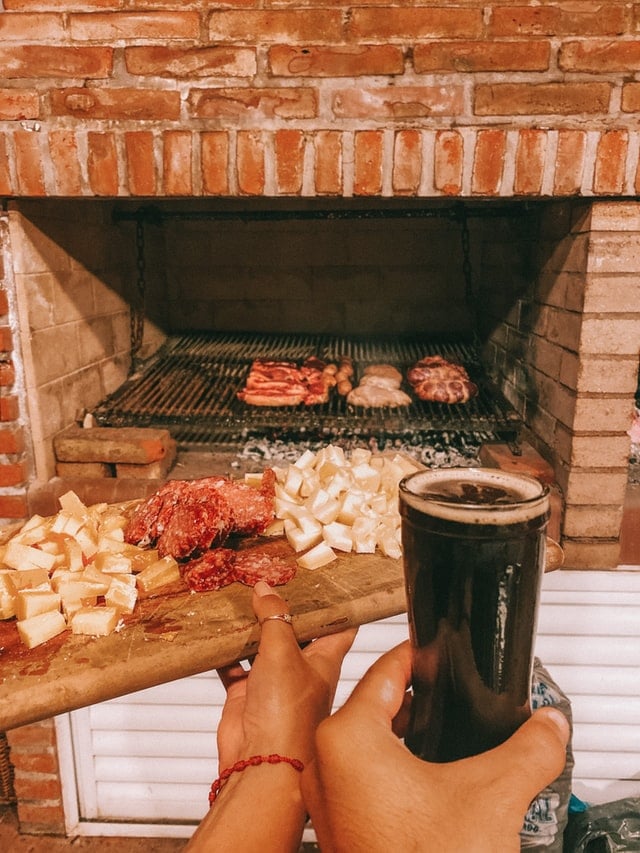
There is one summary I can make after backpacking Argentina. All the things that the Argentinians are most passionate about – Asado, football, mate, wine – they’re all things that are not done alone: they are shared experiences. I think that’s why the energy of this place is so special.
The country is one big melting pot. And you quickly feel like part of the mix.
Your money as a tourist can go far here. But remember, we have a duty, as people of the world, to travel responsibly. You can make a difference to people’s lives with the way you travel through Argentina.
Argentina is a bloody big country. There’s no way you can get round to all of it. But I would love to hear about your experiences and your best travel tips in the comments.
Travelling Argentina is screaming out to the adventurers. So book that ticket! Help out some good people and eat all the empanadas possible.
Now, prepared with your backpacking Argentina travel guide in hand, you’re about to take on the meatiest, most enthusiastic, highly PASSIONATE experience of a lifetime! You’ll find me there. Let’s share a mate.
- We’ve also got where to stay in Buenos Aires covered with our epic guide.
- You’ll also wanna stay in the best hostels in Buenos Aires too!
- Our ultimate South America packing list as all the info you’ll ever need.
- Sort out your backpacker travel insurance before your trip.
- Get your international SIM card organised to avoid hassle.
- Argentina is just the start of your awesome backpacking trip around South America .
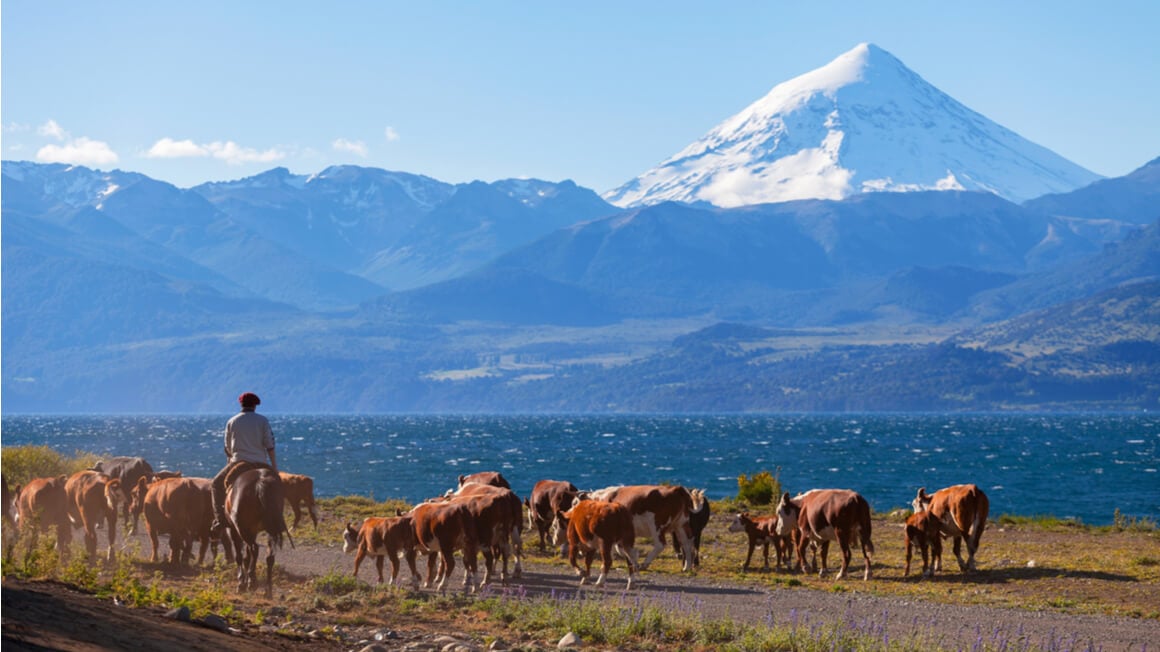
And for transparency’s sake, please know that some of the links in our content are affiliate links . That means that if you book your accommodation, buy your gear, or sort your insurance through our link, we earn a small commission (at no extra cost to you). That said, we only link to the gear we trust and never recommend services we don’t believe are up to scratch. Again, thank you!

Share or save this post

Just got perfect Guide to keep the important things in mind before travelling to Argentina Thanks.
Very comprehensive guide! However the peso is worth 0.026 dollars now (January 2019), which means travelling in Argentina is even cheaper than it was last year.
Leave a Reply Cancel reply
Your email address will not be published. Required fields are marked *
Save my name, email, and website in this browser for the next time I comment.
Notify me of followup comments via e-mail.
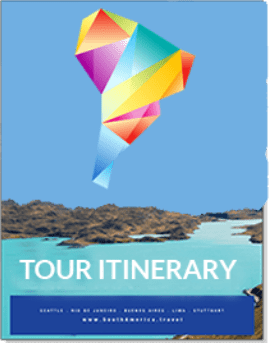
Download itinerary
- Get This Itinerary Now! 📬
- Name * First Last
- Email Address *
- Phone (optional)
- Hidden Country Code
- Hidden Country of Interest
- Special Offers
- Download Free eBooks
- Request Our Travel Brochure
- Speak With a Travel Expert
- ⚡ Create your Custom Tour
FREE Argentina Travel Guide
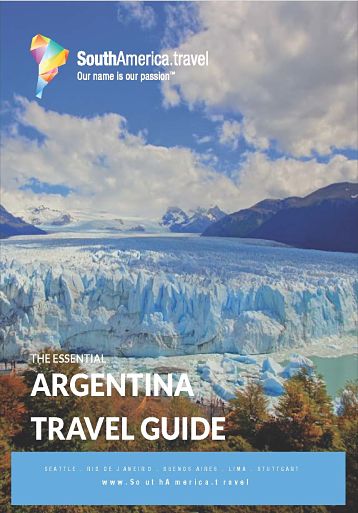
INSIDE the GUIDE:
- Colorful maps and images
- Places to visit in Argentina
- Argentina tour ideas
- Recommended Argentina hotels
- Argentina FAQs and travel tips
Download Your Free
Argentina travel guide.
Download our FREE Argnentina Travel Guide and get inspired to travel to Argentina. Browse through 30 pages of travel planning tips and ideas – a great resource for planning your Argentina dream vacation.
Country of Interest
- Where would you like to travel?
- When would you like to travel?
Click your preferences: Destinations & Activities . Be as specific or general as you like - or click Help Me Decide! We'll spice it with hidden gems & personal tips to create your perfect trip.
You can choose more than one!
Highly recommended - Phone: We ❤️ to talk! A brief chat with your personal Travel Consultant helps us create your perfect trip!
Need assistance? Contact an expert at
If you have an additional 30 seconds we’d love to learn more about you…
Custom Tour Planning
- Hidden Name First Last
- Hidden Email
- Hidden Phone
- Hidden Dreams Brochure
- Hidden Comments
- Hidden Countries
- Hidden Cities/Attractions
- Hidden Activities
- Hidden Accomodations
- Hidden Trip Interests
- Hidden Departure Date
- Hidden Duration
- Hidden # of Adults
- Hidden Age of Adults
- Hidden # of Children
- Hidden Age of Children
- Keeping to my budget
- For the right trip, I’ll increase my budget
- Taking the perfect trip
- I’m not sure about this trip; just starting my research
- I'm probably taking this trip, but need to figure out the details
- I’m definitely taking this trip
One Moment Please
We are matching your tour idea with the right Travel Consultant who will be in touch shortly. Thank you for your request!
- Comments This field is for validation purposes and should be left unchanged.
Create something unique!
Create your personalized South America trip in a few easy steps.
Need assistance? Contact an expert
Custom Tour Request Popup
- Hidden Name * First Last
- Hidden Email *
- Hidden Accommodations
- Hidden Interests
- Email This field is for validation purposes and should be left unchanged.

Travel Guide
- Frommer's Favorite Experiences
- Best Dining Bets
- Best Hotel Bets
- The Most Charming Small Towns
- The Best Outdoor Adventures
- What's New
- Planning a Trip
- Active Pursuits
- Suggested Itineraries
Things to Do in Argentina
The distance from Argentina's northern tip to Tierra del Fuego spans 3,650km (2,263 miles). And the scope of experiences you can find here is no less grand, ranging from the cosmopolitan bustle of Buenos Aires to the tropical jungles and pounding falls of Iguazú or the thunderous splash of icebergs in Los Glaciares National Park. Whether you've come to meander the quiet towns of the Lake District or dance the night away in a smoky, low-lit Argentine tango bar, your trip to the Southern Hemisphere won't disappoint. In this guide, we've selected the best that Argentina has to offer -- museums, outdoor adventures, hotels, and even side trips to Chile.
The Best of Argentina
National parks and monuments.

- All Regions
- Australia & South Pacific
- Caribbean & Atlantic
- Central & South America
- Middle East & Africa
- North America
- Washington, D.C.
- San Francisco
- New York City
- Los Angeles
- Arts & Culture
- Beach & Water Sports
- Local Experiences
- Food & Drink
- Outdoor & Adventure
- National Parks
- Winter Sports
- Travelers with Disabilities
- Family & Kids
- All Slideshows
- Hotel Deals
- Car Rentals
- Flight Alerts
- Credit Cards & Loyalty Points
- Cruise News
- Entry Requirements & Customs
- Car, Bus, Rail News
- Money & Fees
- Health, Insurance, Security
- Packing & Luggage
- -Arthur Frommer Online
- -Passportable
- Road Trip Guides
- Alaska Made Easy
- Great Vacation Ideas in the U.S.A.
- Best of the Caribbean
- Best of Mexico
- Cruise Inspiration
- Best Places to Go 2024
Argentina Travel Guide
Popular destinations, san francisco, new york city.
- Terms of Use
- Privacy Policy
- Your US State Privacy Rights
- Children's Online Privacy Policy
- Interest-Based Ads
- About Nielsen Measurement
- Do Not Sell or Share My Personal Information
- Nat Geo Home
- Attend a Live Event
- Book a Trip
- Inspire Your Kids
- Shop Nat Geo
- Visit the D.C. Museum
- Learn About Our Impact
- Support Our Mission
- Advertise With Us
- Customer Service
- Renew Subscription
- Manage Your Subscription
- Work at Nat Geo
- Sign Up for Our Newsletters
- Contribute to Protect the Planet
Copyright © 1996-2015 National Geographic Society Copyright © 2015-2024 National Geographic Partners, LLC. All rights reserved

Passing Thru Travel
15 Best Places in Patagonia To Visit in 2024
Posted: February 24, 2024 | Last updated: February 24, 2024
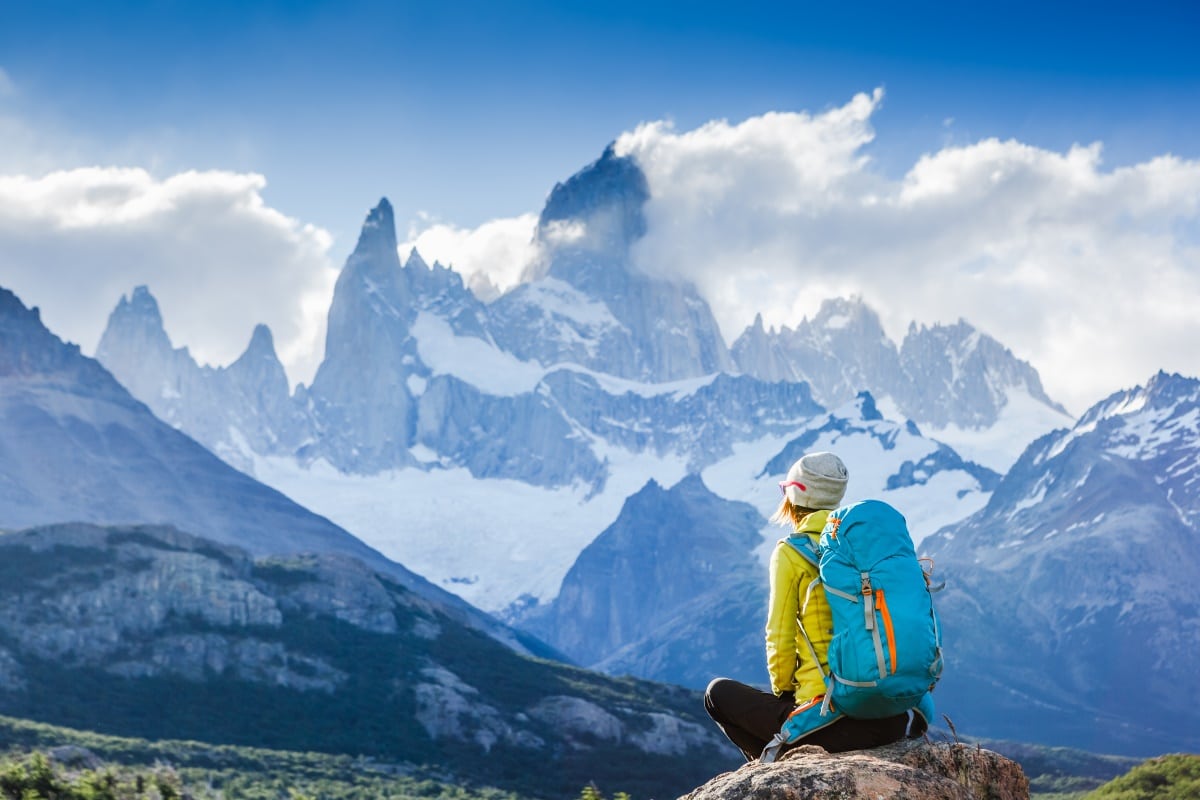
Patagonia, a region shared by Argentina and Chile, is a land of awe-inspiring natural beauty. Known for its rugged landscapes, towering mountains, and pristine glaciers, Patagonia is a haven for adventurers and nature lovers alike. This guide takes you through the most breathtaking destinations in Patagonia, each offering a unique experience of this wild and untamed region. Patagonia’s diverse landscapes promise an unforgettable journey from the iconic Torres del Paine to the remote Tierra del Fuego.
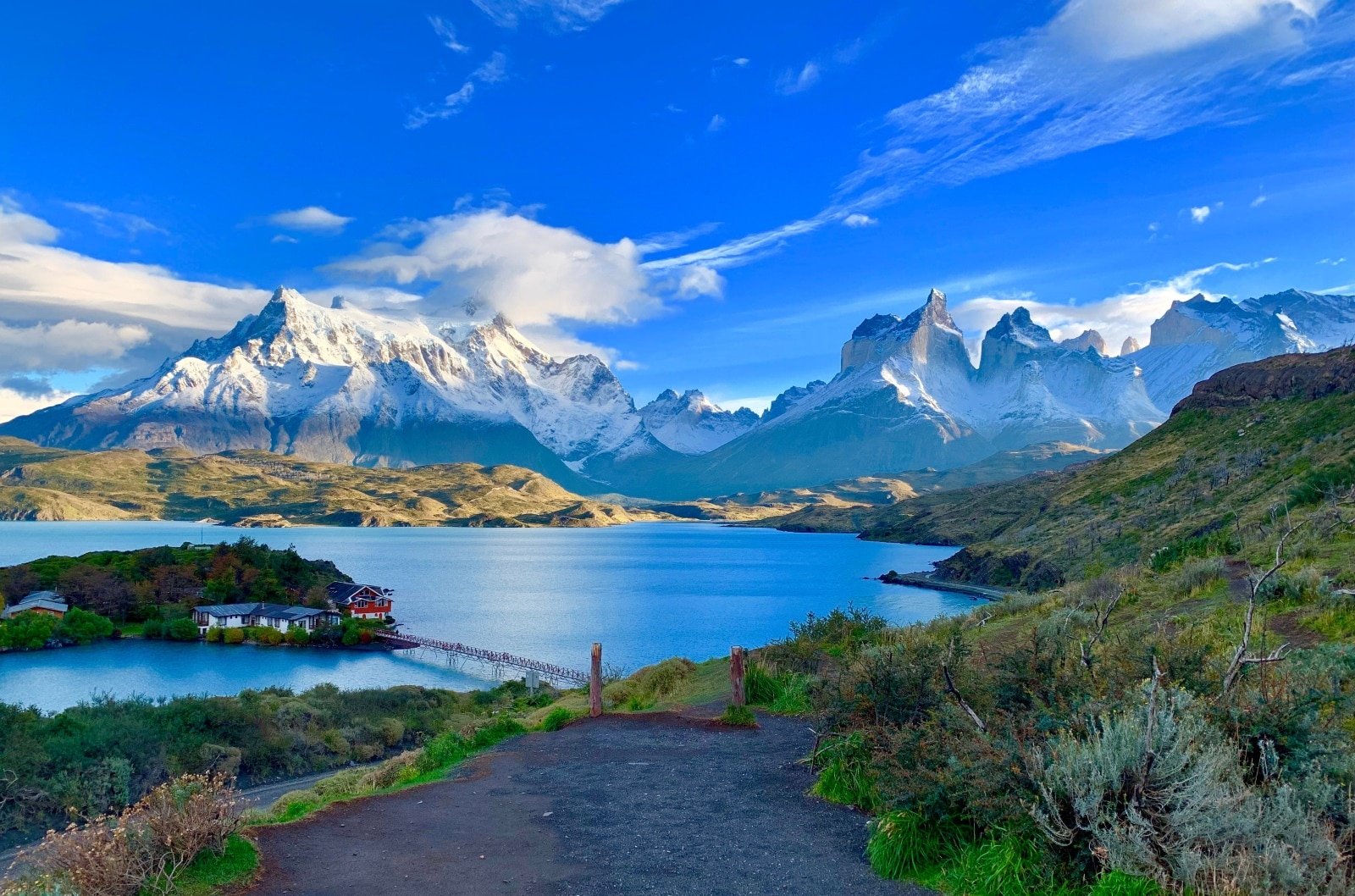
1. Torres del Paine National Park, Chile
Torres del Paine National Park, a highlight of Chilean Patagonia, is renowned for its dramatic peaks, bright blue icebergs, and vast pampas. The park’s network of trails, including the famous W Trek and the O Circuit, offers some of the world’s best trekking experiences. Hikers are treated to stunning views of the park’s namesake towers, the Paine Massif, and the Grey Glacier. The diverse ecosystems within the park, from steppe to subpolar forests, are home to an array of wildlife, including guanacos and condors.
Insider’s Tip: Book refugios or campsites well in advance if you plan to trek.
When To Travel: The best time to visit is during the Southern Hemisphere’s summer, from November to early March.
How To Get There: Fly to Punta Arenas in Chile and then take a bus or a rented car to the park.
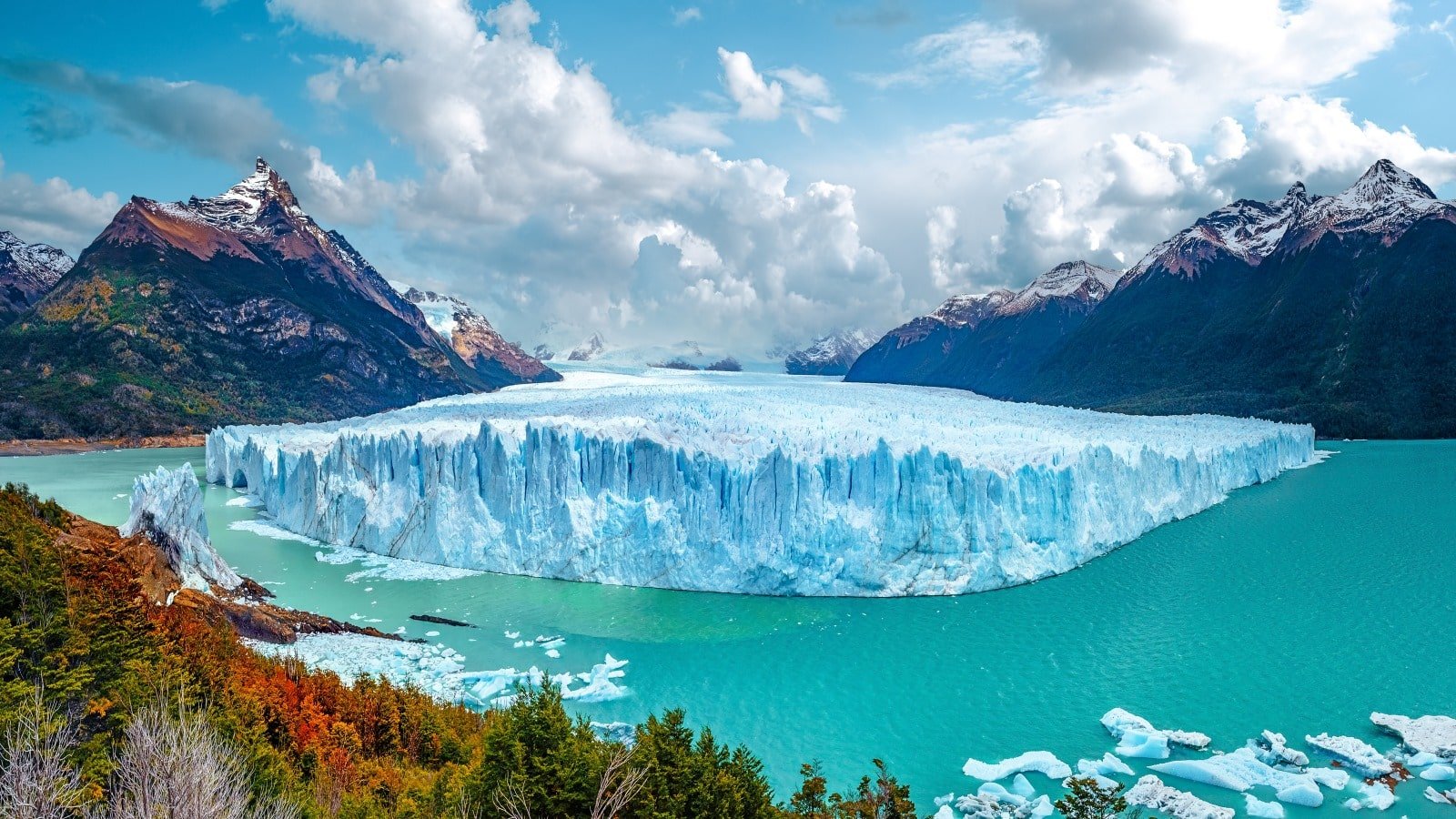
2. Perito Moreno Glacier, Argentina
The Perito Moreno Glacier, part of Argentina’s Los Glaciares National Park, is one of the most accessible and dynamic glaciers on the planet. Visitors can witness the awe-inspiring sight of ice calving from the glacier into Lake Argentino. The park offers various viewing platforms and boat tours for different perspectives of this natural wonder. Unlike many other glaciers worldwide, Perito Moreno is one of the few still growing, making it a particularly fascinating site for glaciology enthusiasts.
Insider’s Tip: Take a guided glacier walk on the ice for a memorable experience.
When To Travel: Visit between October and April for milder weather.
How To Get There: Fly to El Calafate in Argentina, and then it’s a short drive to the glacier.
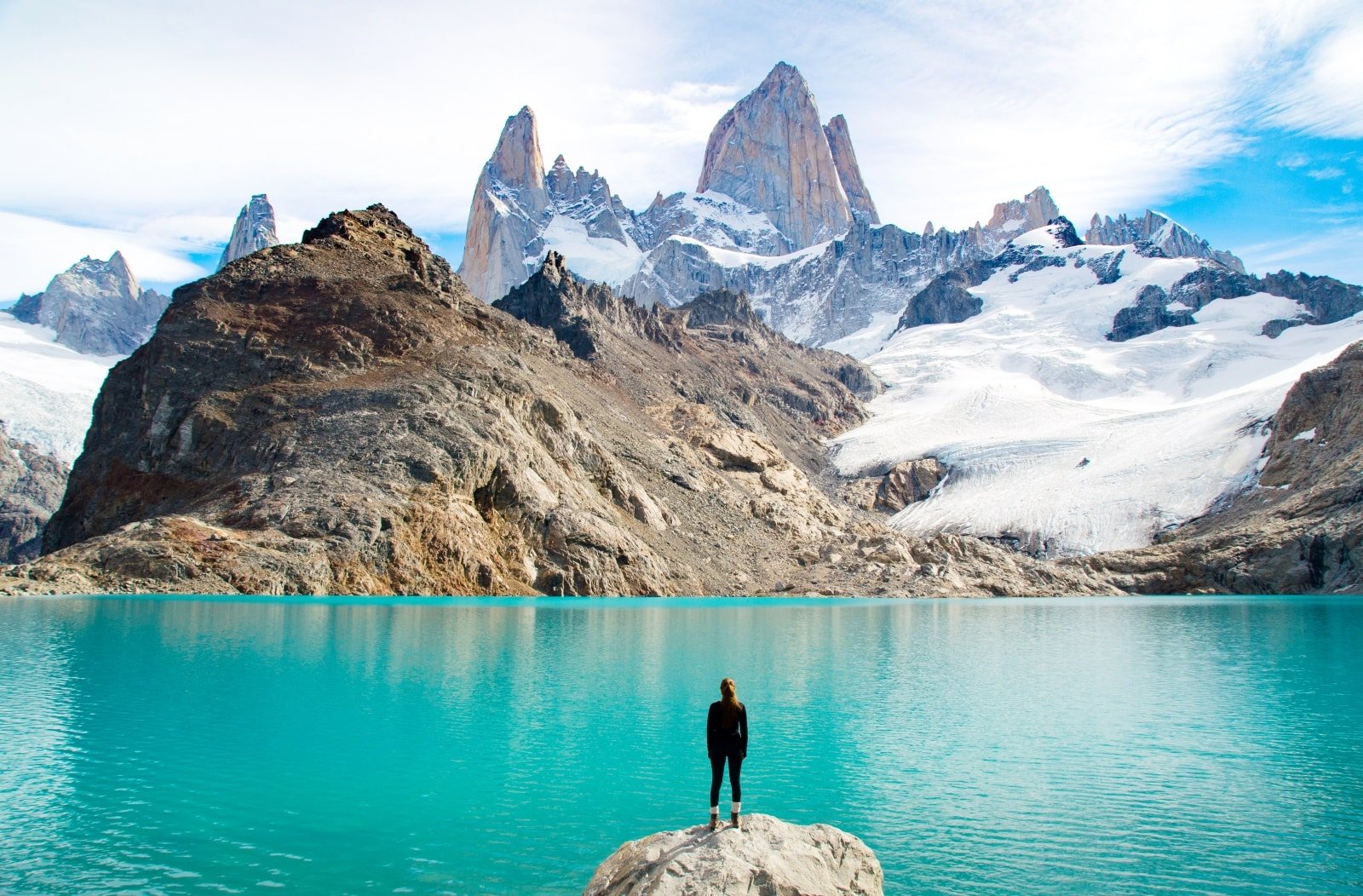
3. Fitz Roy Mountain, Argentina
Fitz Roy Mountain, near the small town of El Chaltén, is a paradise for experienced hikers and climbers. The mountain’s iconic jagged peaks present one of the world’s most challenging and rewarding climbs. For those seeking less strenuous activities, numerous trails like Laguna de los Tres offer breathtaking views of Fitz Roy and the surrounding Patagonian landscape. The town of El Chaltén itself is a charming base for exploring the region, with cozy accommodations and local eateries.
Insider’s Tip: Start your hike early in the morning to avoid crowds and enjoy the best views.
When To Travel: Trekking season runs from November to April.
How To Get There: Fly to El Calafate and then take a bus to El Chaltén.
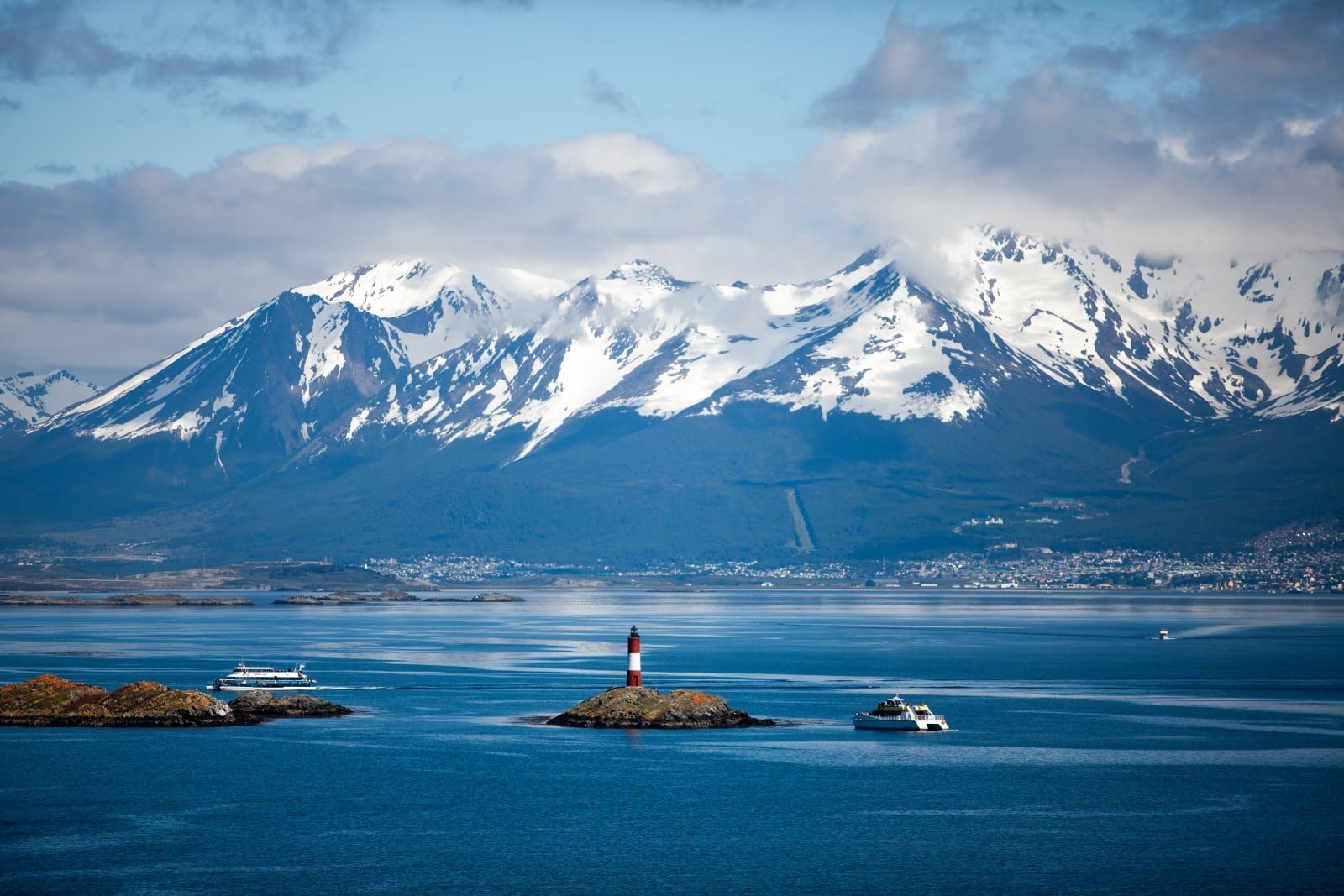
4. Tierra del Fuego, Argentina and Chile
Tierra del Fuego, an archipelago off the southern tip of South America, is a land of stark contrasts and extreme beauty. Ushuaia, the world’s southernmost city, is the gateway to this remote region. Here, visitors can explore the Tierra del Fuego National Park, take boat trips along the Beagle Channel, or embark on expeditions to Antarctica. The region’s unique flora and fauna, including Magellanic penguins and Andean foxes, make it a fascinating destination for wildlife enthusiasts.
Insider’s Tip: Visit the End of the World Museum in Ushuaia to glimpse the area’s history.
When To Travel: The best time is during the Southern Hemisphere’s summer, from December to March.
How To Get There: Fly to Ushuaia from major cities in Argentina or Chile.
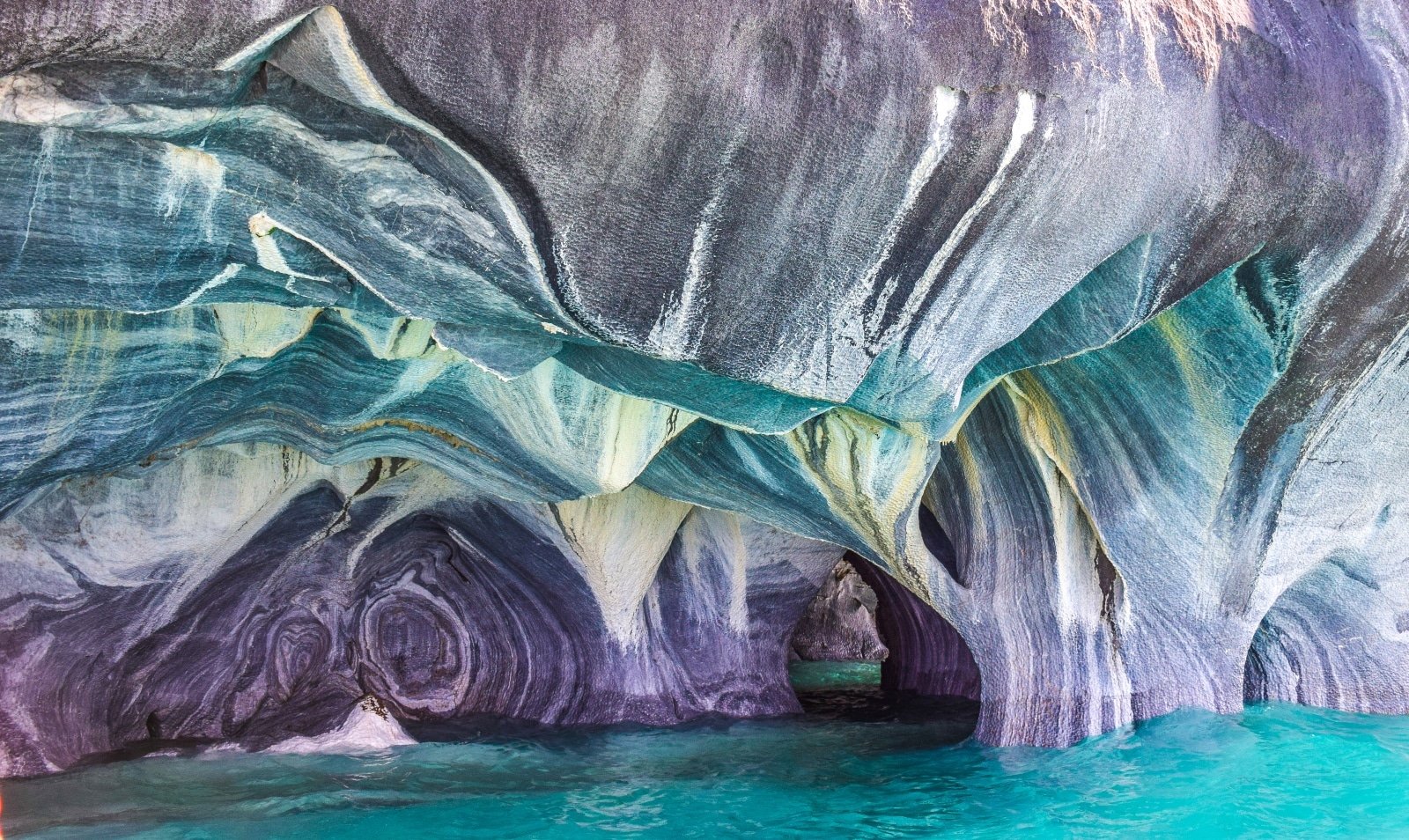
5. Marble Caves, Chile
The Marble Caves on Lake General Carrera are a breathtaking natural formation. Millennia of waves washing against calcium carbonate have sculpted these caves into stunning formations. The caves’ walls, with their swirling patterns of blue and grey, are a photographer’s dream, especially when reflected in the lake’s azure waters. Accessible only by boat, the caves offer a serene and otherworldly experience.
Insider’s Tip: Take a boat or kayak tour for the best views of the caves.
When To Travel: Visit between September and February for the best weather.
How To Get There: Fly to Balmaceda, then drive to Puerto Río Tranquilo, where tours to the caves are available.
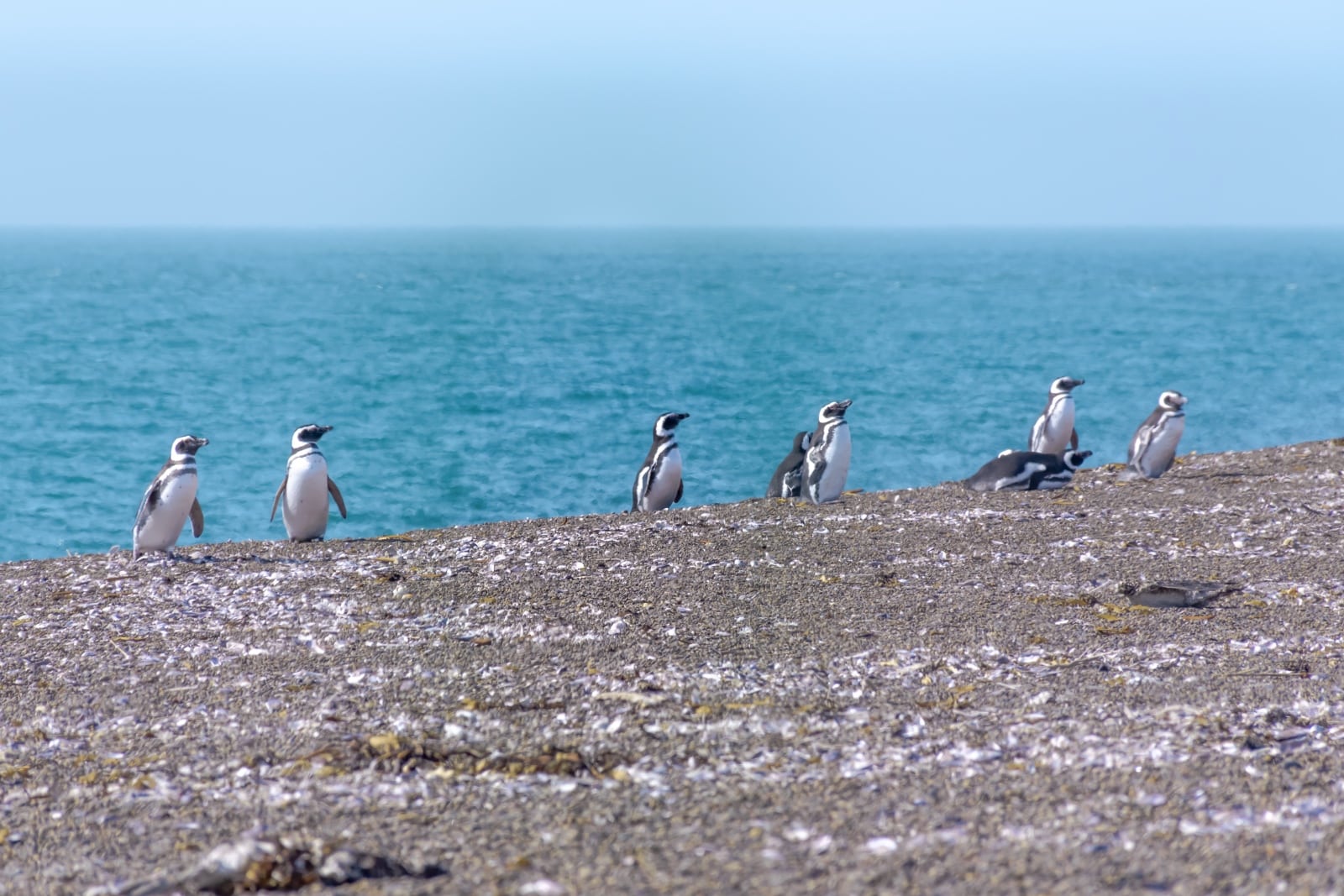
6. Valdés Peninsula, Argentina
Image Credit: Shutterstock / Natalia Di Marco The Valdés Peninsula is a UNESCO World Heritage Site celebrated for its unique marine wildlife and rugged coastline. It’s one of the best places in the world to see Southern Right Whales, which come close to shore between June and December. The peninsula also hosts large colonies of sea lions, elephant seals, and various bird species. Its steppe-like interior and dramatic coastline offer stunning landscapes and excellent wildlife viewing opportunities.
Insider’s Tip: Take a whale-watching tour between June and December to see Southern Right Whales.
When To Travel: Wildlife viewing is best from September to March.
How To Get There: Fly to Puerto Madryn or Trelew, then drive to the peninsula.
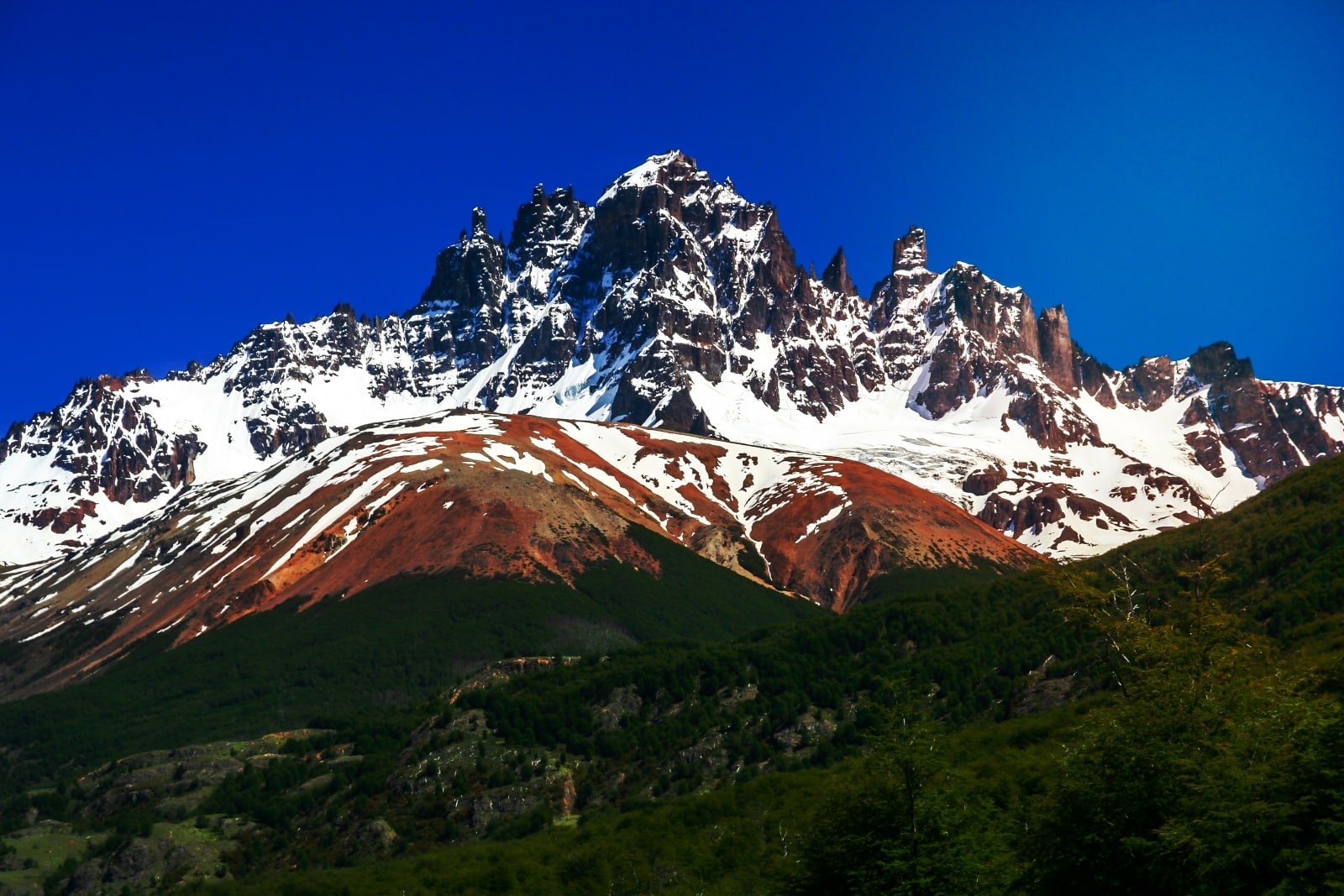
7. Cerro Castillo, Chile
Cerro Castillo, less crowded than Torres del Paine, offers equally stunning scenery for those willing to venture off the beaten path. The trek around Cerro Castillo takes you through diverse landscapes, including forests, alpine meadows, and high mountain passes, with the castle-like peaks of Cerro Castillo as a constant backdrop. The trek is challenging but rewards hikers with incredible views of glaciers, turquoise lakes, and the Patagonian wilderness.
Insider’s Tip: Pack for all weather conditions, as the weather can change rapidly.
When To Travel: The trekking season is from November to April.
How To Get There: Fly to Balmaceda and then drive or take a bus to Villa Cerro Castillo.
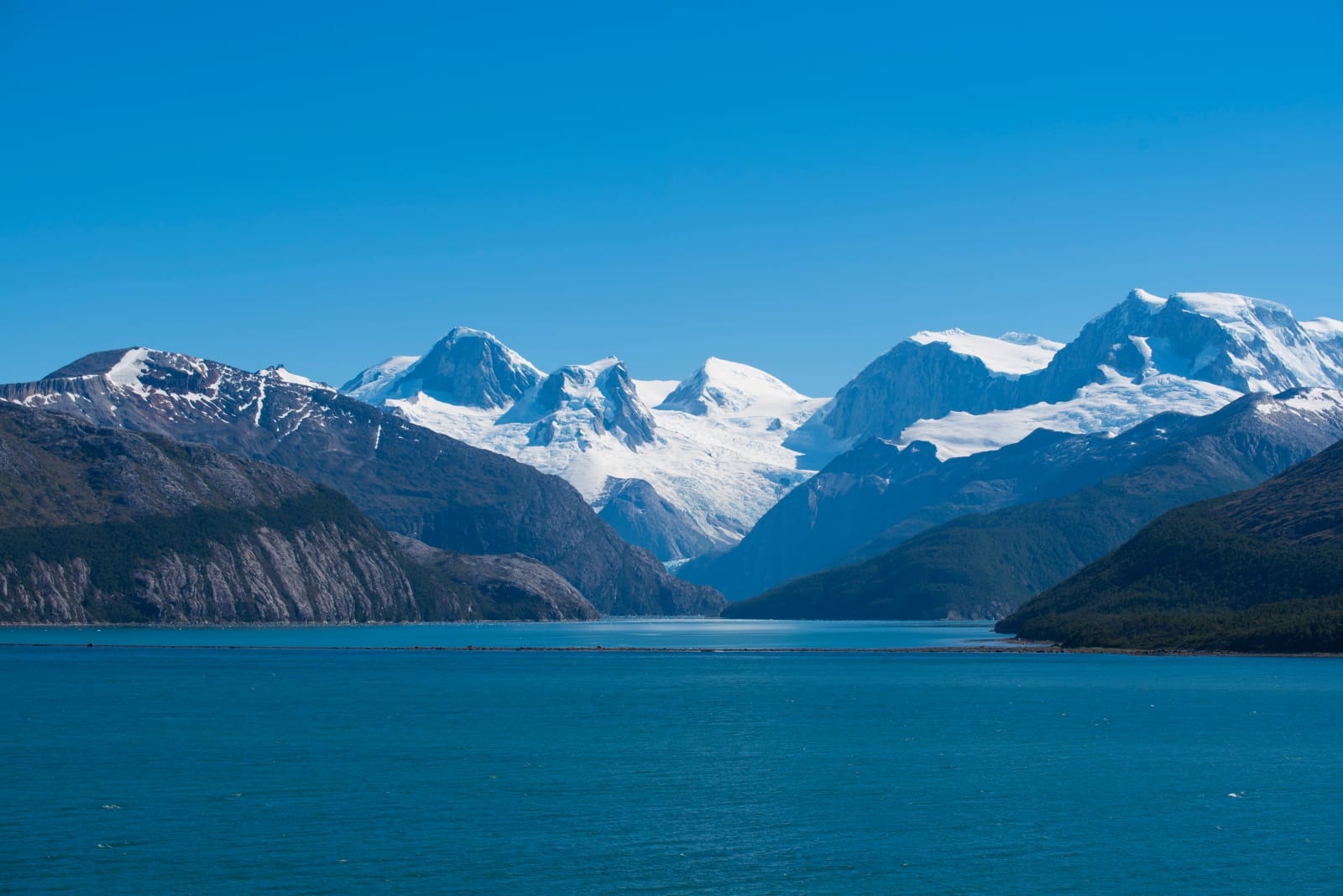
8. Cape Horn, Chile
At the southernmost tip of the South American continent, Cape Horn is a legendary location known for its challenging sailing conditions and rich maritime history. Cruises to this remote area offer a unique opportunity to experience the wild beauty of the southern seas and the sense of adventure that comes with reaching the “end of the world.” The area is also significant for its unique flora and fauna adapted to harsh conditions.
Insider’s Tip: Choose a cruise that includes lectures on the region’s history and wildlife.
When To Travel: Cruises run during the Southern Hemisphere’s summer, from December to March.
How To Get There: Cruises to Cape Horn typically depart from Ushuaia.
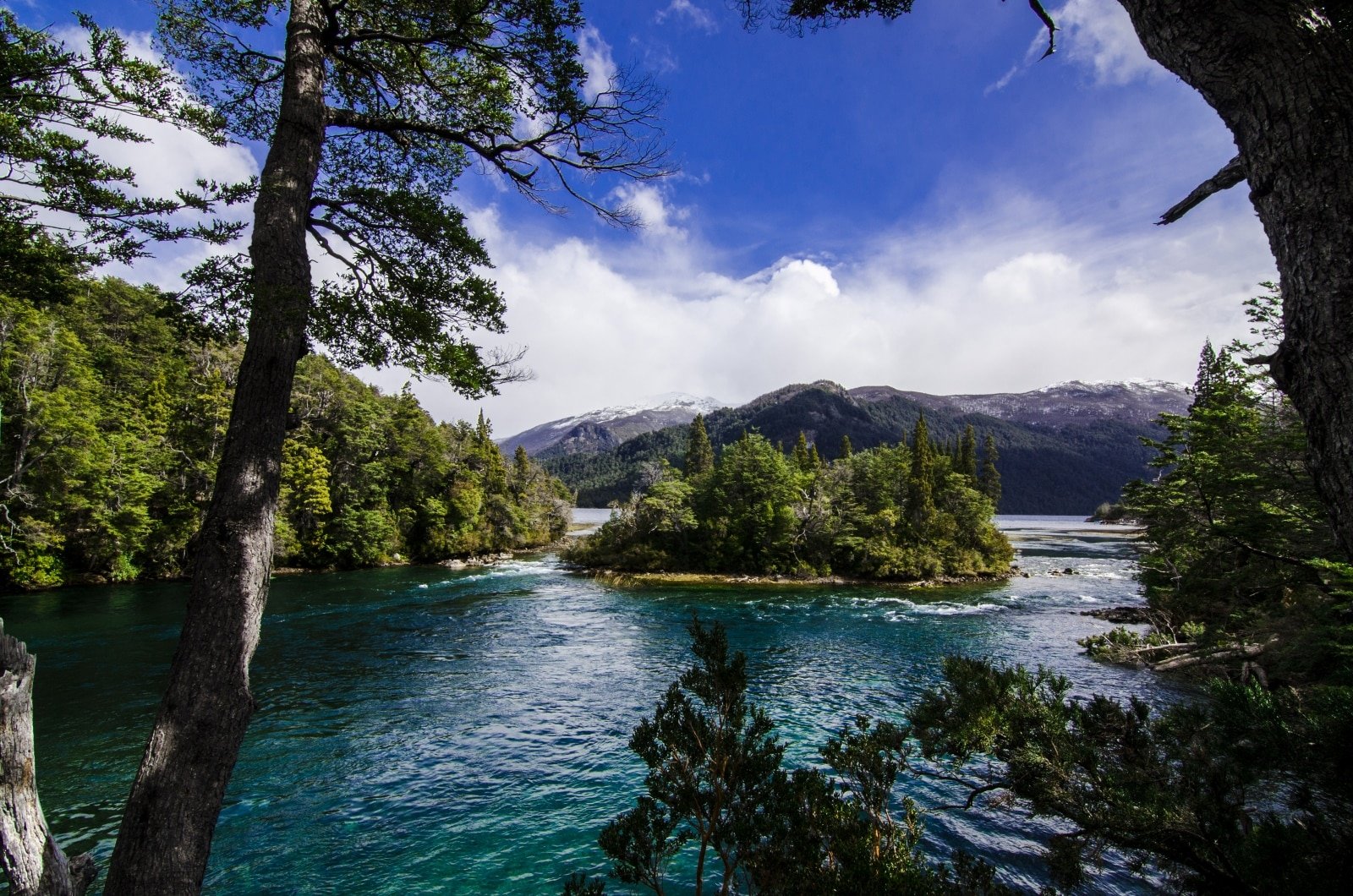
9. Los Alerces National Park, Argentina
Los Alerces National Park, a UNESCO World Heritage Site in Argentina, is known for its ancient Alerces trees, some of which are over 3,000 years old. The park’s lakes, rivers, and forests offer a serene setting for hiking, kayaking, and fishing. The park is a testament to Argentina’s commitment to conservation, with well-maintained trails and minimal-impact tourism practices. The park’s diverse ecosystems are home to various wildlife, including deer, pumas, and several bird species.
Insider’s Tip: Explore the Arrayanes Forest for a magical walk among unique cinnamon-colored trees.
When To Travel: Visit from October to April for the best weather.
How To Get There: Fly to Esquel and then drive to the park.
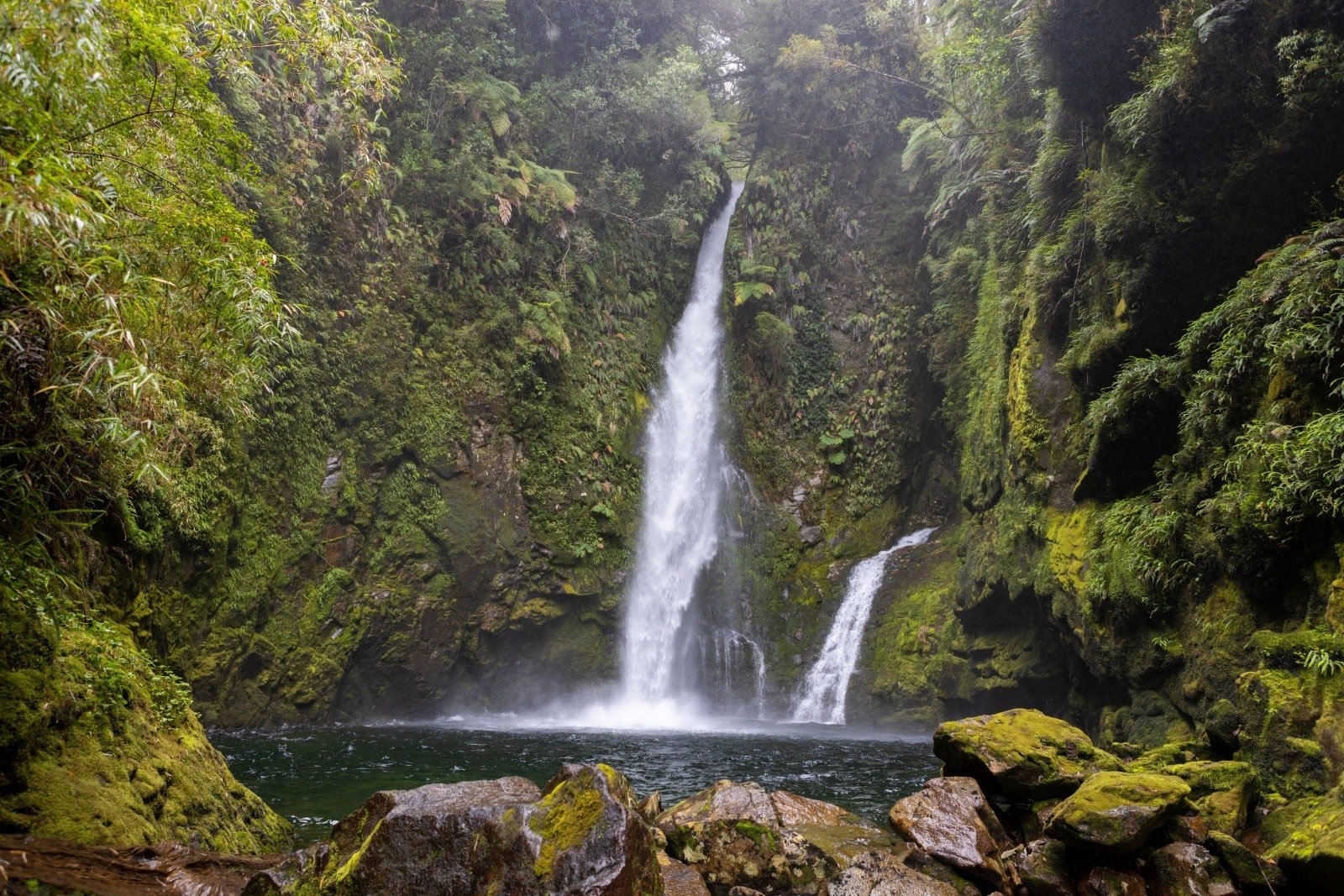
10. Pumalín Park, Chile
Pumalín Park, one of the largest private parks in the world, is a testament to conservation efforts in Chilean Patagonia. Created by conservationist Douglas Tompkins, the park spans over 400,000 hectares of temperate rainforests, fjords, and waterfalls. Visitors can hike through pristine forests, kayak along untouched fjords, and witness the park’s commitment to environmental preservation firsthand. The park’s infrastructure, including trails and campgrounds, is designed to minimize human impact on the environment.
Insider’s Tip: Visit the park’s environmental information centers to learn about its conservation efforts.
When To Travel: The best time to visit is from December to March.
How To Get There: Fly to Puerto Montt, then drive or take a ferry to the park.
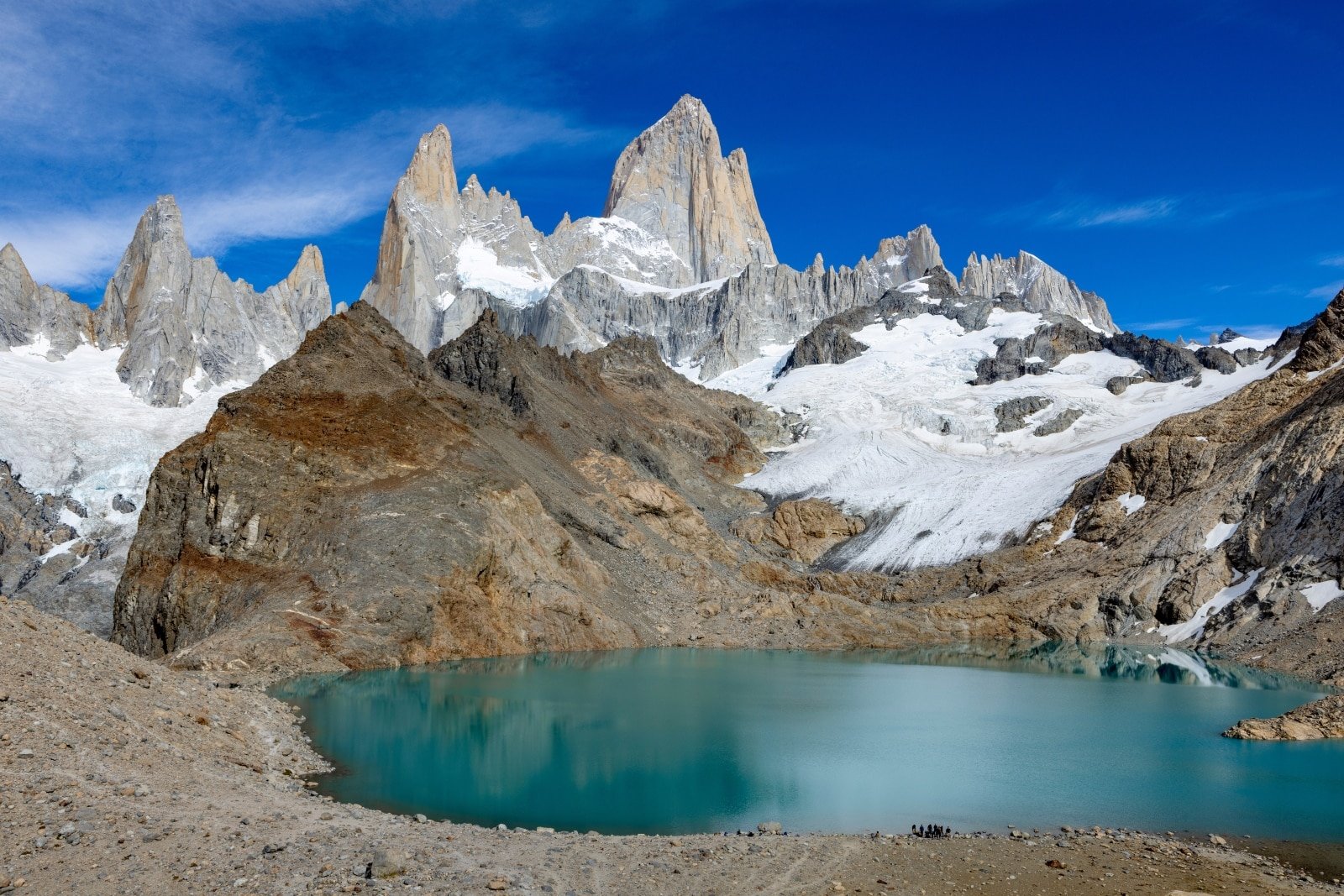
11. El Chaltén, Argentina
El Chaltén, often called Argentina’s trekking capital, is the gateway to some of Patagonia’s most iconic trails. The town offers a range of trekking options, from easy day hikes to challenging multi-day expeditions. The surrounding landscapes of glaciers, lakes, and mountains provide a stunning backdrop for outdoor activities. In addition to trekking, visitors can enjoy rock climbing, horseback riding, and fishing.
Insider’s Tip: Visit the Los Condores viewpoint for a stunning panoramic view of the town and surrounding peaks.
When To Travel: Trekking season is from October to April.
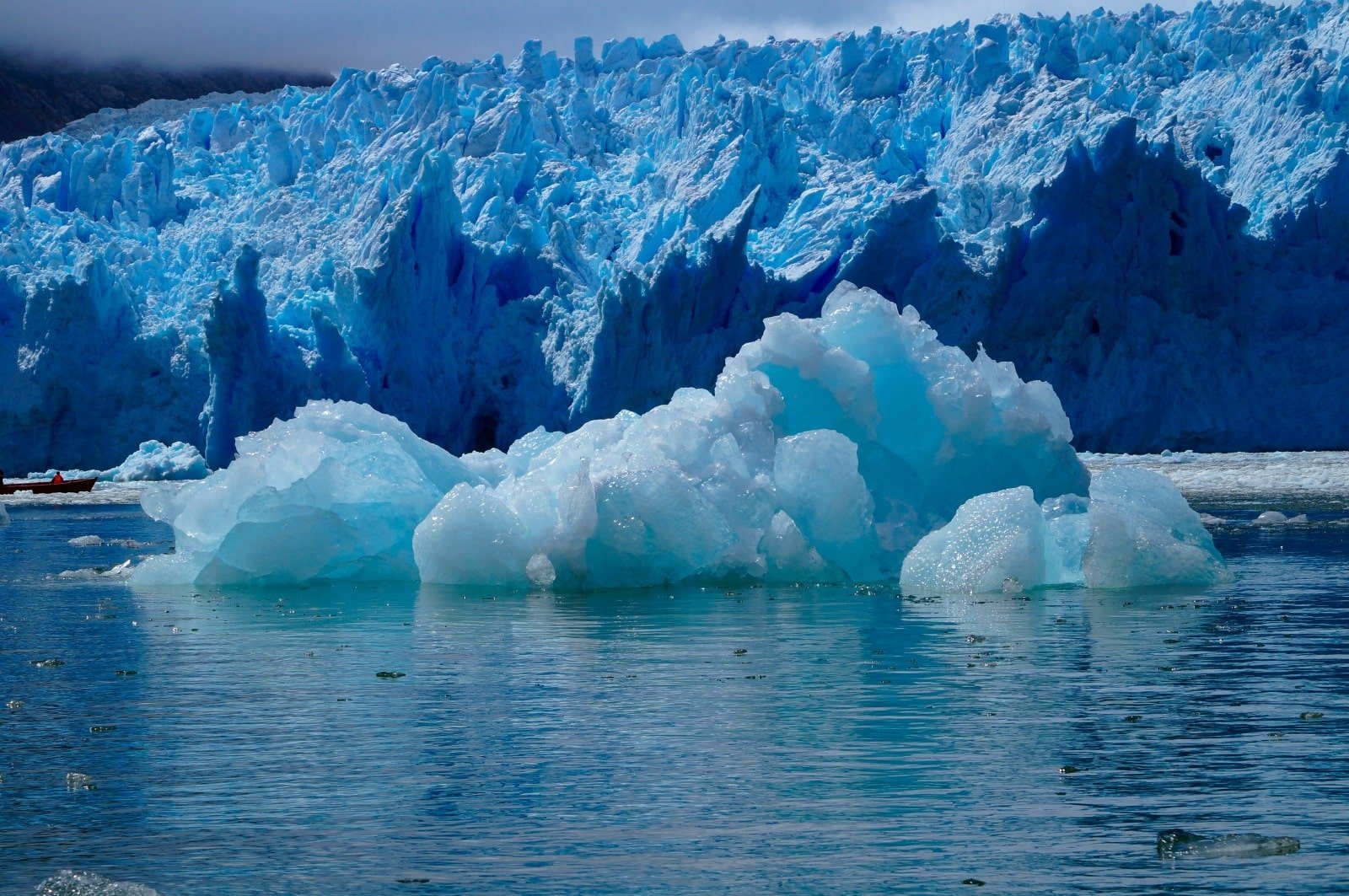
12. Laguna San Rafael National Park, Chile
Laguna San Rafael National Park is home to the San Rafael Glacier, one of the largest and most actively calving glaciers in the Chilean Patagonia. The park offers boat tours that provide close-up views of the glacier and the icebergs in the lagoon. The park’s remote location and stunning ice landscapes make it a must-visit for adventure seekers and nature enthusiasts. Visitors can also explore the surrounding rainforests and spot wildlife such as sea lions and dolphins.
Insider’s Tip: Take a boat tour that includes visiting the hot springs at Quitralco Fjord.
When To Travel: The best time for boat tours is from October to April.
How To Get There: Access is mainly by boat or plane from Coyhaique or Puerto Chacabuco.
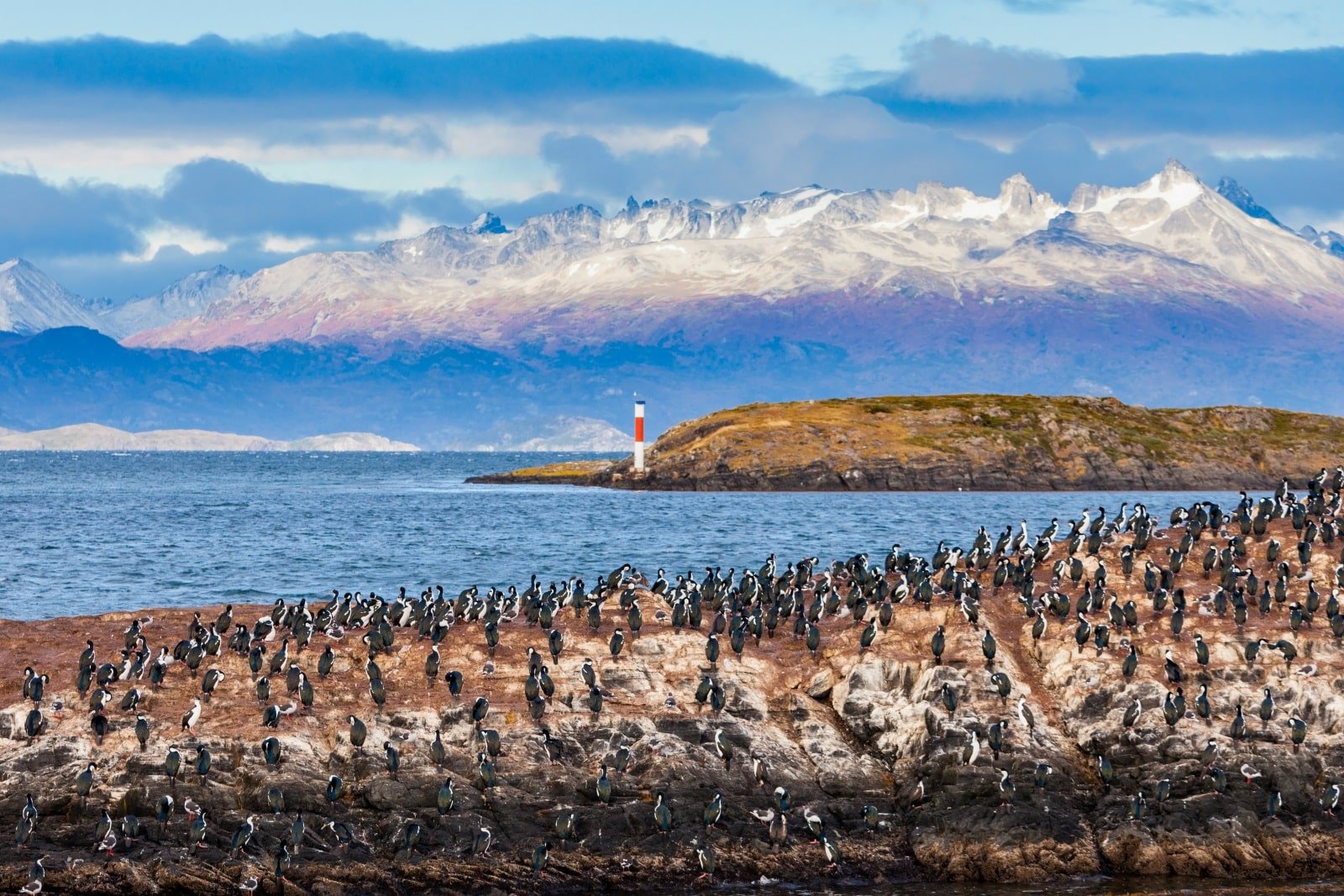
13. King Penguin Colony, Tierra del Fuego, Chile
The King Penguin Colony on the Chilean side of Tierra del Fuego offers a unique opportunity to observe these majestic birds. Located at Parque Pingüino Rey, the colony is one of the few places outside Antarctica where you can see king penguins in their natural habitat. The park provides a respectful and sustainable way to observe the penguins, with designated viewing areas to minimize disturbance.
Insider’s Tip: Respect the penguins’ space and observe them from a distance to avoid disturbing them.
When To Travel: Penguins can be seen year-round, but the best time is during the breeding season, from September to March.
How To Get There: Fly to Punta Arenas, take a ferry and drive to the park.
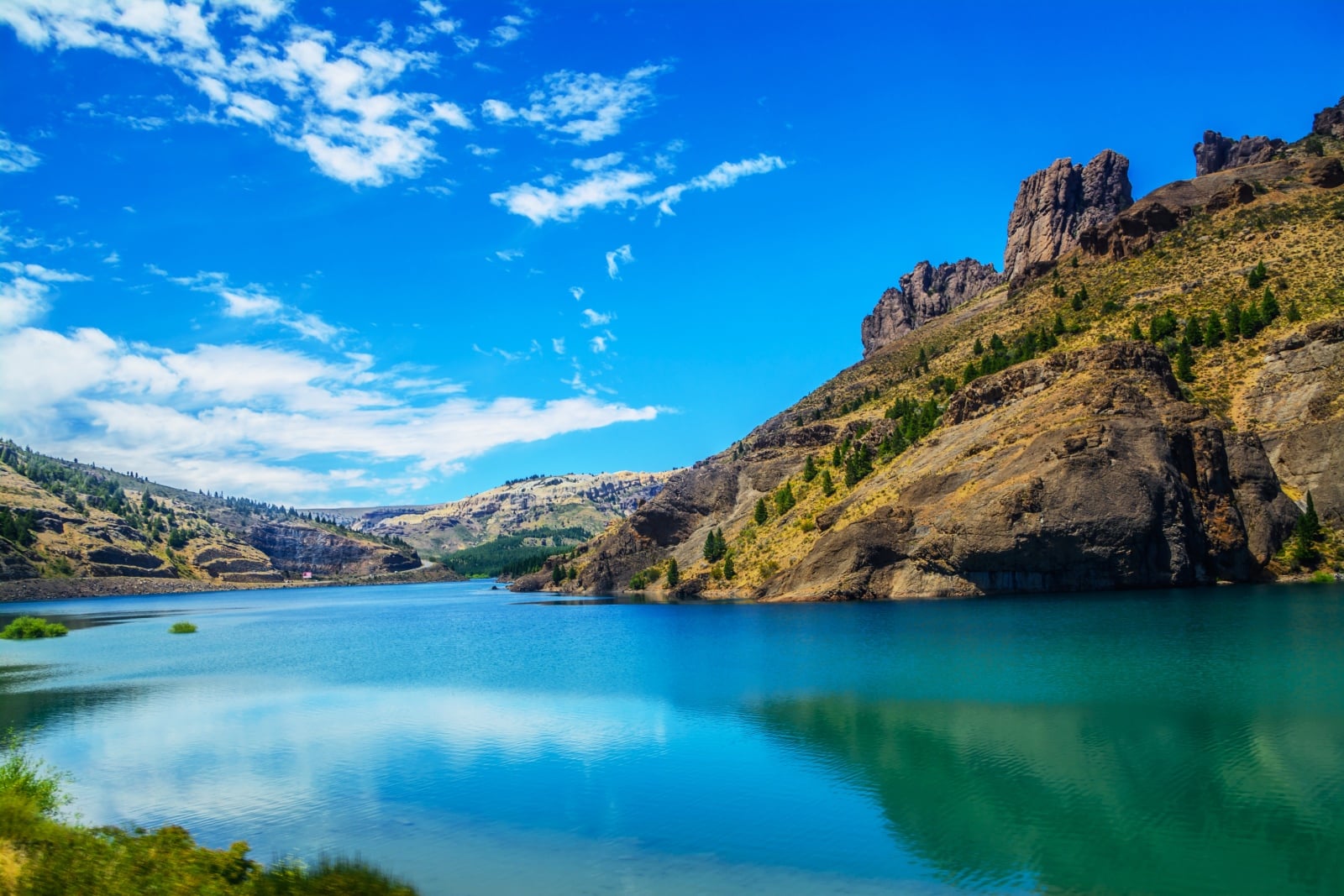
14. Bariloche, Argentina
San Carlos de Bariloche, known simply as Bariloche, offers a unique combination of stunning natural landscapes and a lively city atmosphere. Bariloche is located in Argentina’s Lake District, a hub for outdoor activities like hiking, kayaking, and mountain biking. The city’s Swiss-style architecture and renowned chocolate shops add to its charm, making it a popular destination year-round. In winter, Bariloche transforms into a ski resort, while the summer months are perfect for exploring the surrounding lakes and mountains.
Insider’s Tip: Take the cable car to Cerro Campanario for one of the best views in the region.
When To Travel: Visit from December to March for outdoor activities and pleasant weather.
How To Get There: Fly to Bariloche Airport, with regular flights from Buenos Aires.
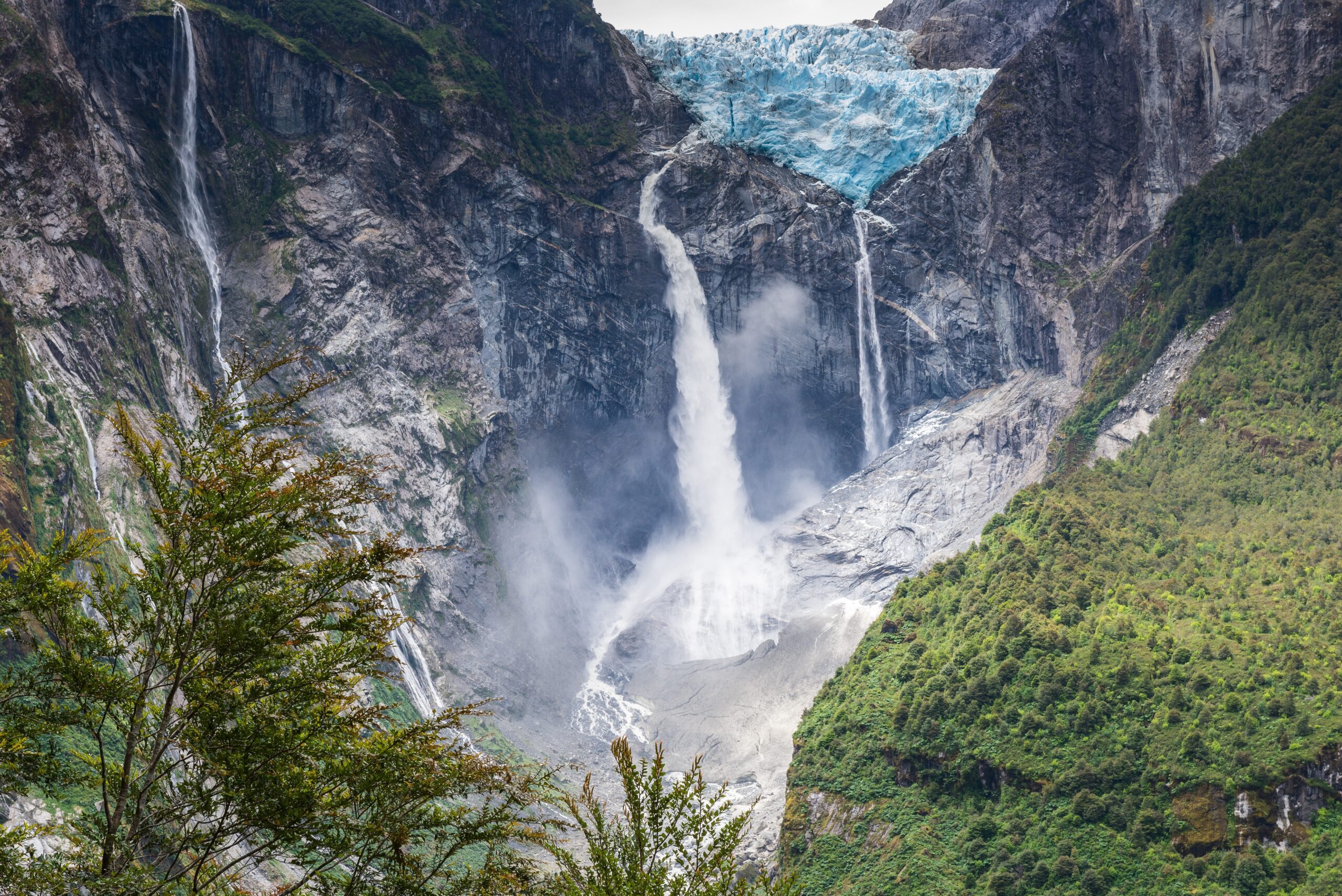
15. Aysén Region, Chile
The Aysén Region in Chilean Patagonia is a secluded paradise for adventurers. Less crowded and largely untouched, it offers a wilderness experience that includes the Northern Patagonian Ice Field and numerous fjords. The Carretera Austral, a scenic route through the region, leads to remote beauty spots ideal for hiking, kayaking, and fishing. Aysén’s rugged terrain and pristine landscapes are perfect for those seeking an immersive nature experience away from tourist trails.
Insider’s Tip: Plan a road trip along the Carretera Austral for a unique way to explore the region’s diverse landscapes.
When To Travel: The best time to visit is during the Southern Hemisphere’s summer, from December to March.
How To Get There: Fly to Balmaceda Airport and rent a car for the best exploration experience.
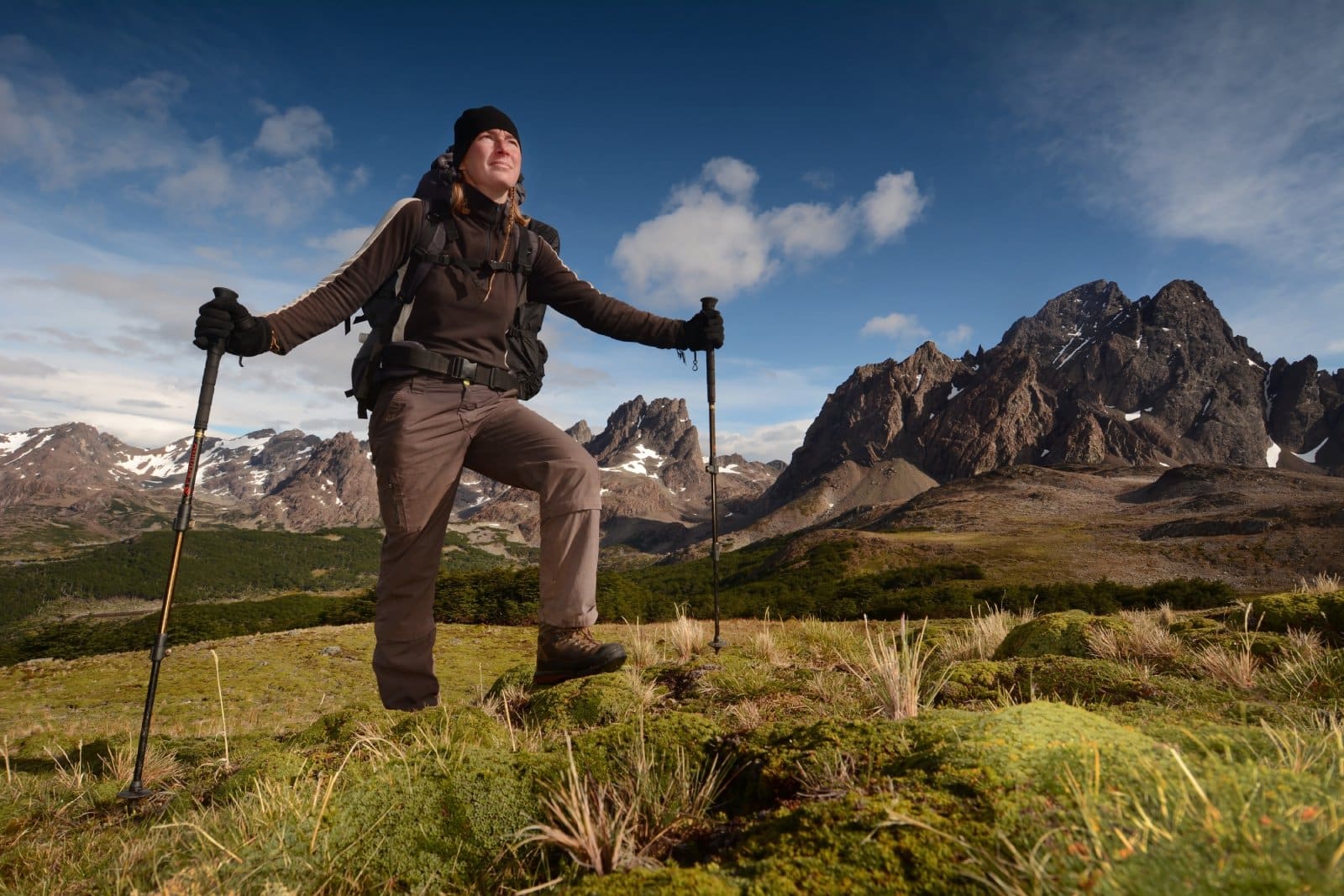
The Bottom Line
Patagonia is a land of endless natural wonders, offering experiences that range from witnessing colossal glaciers to trekking through pristine forests. Each destination in this vast region presents an opportunity to connect with nature and witness the raw beauty of one of the world’s most spectacular landscapes. As you plan your journey through Patagonia, remember that the true essence of this place lies in its wild and untamed spirit, inviting you to explore and discover its many treasures.
More Articles Like This…
Barcelona: Discover the Top 10 Beach Clubs
2024 Global City Travel Guide – Your Passport to the World’s Top Destination Cities
Exploring Khao Yai 2024 – A Hidden Gem of Thailand
The post 15 Best Places in Patagonia To Visit in 2024 republished on Passing Thru with permission from The Green Voyage .
Featured Image Credit: Shutterstock / Olga Danylenko.
For transparency, this content was partly developed with AI assistance and carefully curated by an experienced editor to be informative and ensure accuracy.
More for You
Jeff Bezos predicts Amazon's 'inevitable death'
Here's No. 1 thing mentally strong couples 'never' do, says relationship therapist of 20 years
The most dangerous state to drive in in the US, according to data—plus, see where your state ranks
Pelosi accuses MSNBC host of being ‘apologist for Donald Trump’
John Jacob Astor IV was one of the richest men in the world when he died on the Titanic. Here's a look at his life.
Putin's got egg on his face after showing off captured British armoured cars
iPhone users in 92 countries received a recent stark warning
I’m a psychologist and mom—here are 3 phrases I wish more parents would say to their kids
The films everyone should see at least once before they die, according to critics
These Ford Models Won't Be Coming Back After 2024
How Much You Take Home from the Average Salary in Each State
7 weird jobs that are well-paying but nobody knows about, according to a viral Reddit thread
14 Fictional Characters You Might Not Know Are Based on Real People
I Was Told My Father Was A 'Deadbeat.' After He Died, I Found Out Everything I Knew About Him Was Wrong.
The Choco Taco Is Coming Back For A Limited Time
The greatest war movie of all time—and see the rest of the top 25, based on data
Anti-Trump DA's no-show at debate leaves challenger facing off against empty podium
This is the salary it takes to be considered rich in every state
What Do All the Heart Emojis Mean? A Guide To Using the Symbols of Love
Hawaii set to remove major attraction at cost of $2.5 million as tourists defy ban
‘Conan O’Brien Must Go’ Is a Keeper: TV Review
Legendary talk show host and hot wing evangelist returns to television with hilarious new Max travel show
By Stephen Rodrick
Stephen Rodrick
- ‘Conan O’Brien Must Go’ Is a Keeper: TV Review 2 weeks ago
- ‘The Dynasty’: How the Apple TV+ Documentary Chronicled the New England Patriots’ Legacy After Their Championship Run 2 months ago
- SXSW Doc ‘Clemente’ Showcases the Enduring Influence of a Pioneering MLB Star 2 months ago

The key to understanding Conan O’Brien’s comedy is knowing that it comes from a point of kindness. Yes, I know in this age of comics punching down , this kind of compliment may leave you with a neon “Must Avoid!” sign flashing in your bleary eyes — but stay with me.
Popular on Variety
Conan’s three-decade run as a talk show host ended in 2021 under less-than-optimal circumstances , as he wound down his TBS show during the pandemic year. He talked to longtime sidekick Andy Richter , who sat among dozens of cardboard cutout fans. O’Brien quipped that they were last in line for the vaccine because the CDC had looked at the shows and “they said ours is the least essential of pretty much all the non-essential shows.”
There was some truth in that, but Conan had already started his move to other outlets , starting with his “Conan O’Brien Needs a Friend” podcast in 2018.
The podcast is funny and sweet, especially the pre-interview segments with longtime associate Sona Movsesian and producer Matt Gourley. Conan mocks Sona’s legendarily bad work habits. and Gourley’s flea market predilections, but any kind of comedic acid is reserved for the self-lacerating O’Brien. (On a recent episode, Conan runs down his own looks, and it is cruel and hilarious, but part of me is thinking, “Dude, cut yourself a break.”). The only time things get contentious is when Conan visited by longtime friend Kevin Nealon — perhaps the podcast’s best episodes.
The podcast had an offshoot called “Conan O’Brien Needs a Fan,” on which O’Brien would talk to a fan, often in a faraway land. That led to O’Brien traveling to Norway, Thailand, Ireland and Argentina to meet them. Why? Well, a dour and ominous narrator, aka Werner Herzog, offered this rationale at the beginning of each episode: “Once a proud talk show host, he’s been driven by a changing ecosystem to a drier and harsher climate: the weekly podcast. Here , without the nourishment of his studio audience, this clown with dull , tiny eyes, the eye of a crudely painted doll , is forced to feed on that meagerest of morsels: the random call-in fan. Unhinged by the feral scent of their mild enthusiasm. He scavenges in distant lands uninvited, fueled by a bottomless hunger for recognition , and the occasional selfie.”
It’s a self-deprecating bit, but it’s also the truth. Conan has been doing travel shows for years, most notably one to Movsesian’s native Armenia , as well as a chaotic trip to Finland where O’Brien is treated as a god because of his physical resemblance to the Finnish president who happens to be a woman. He clearly loves the journey. And he loves the comedy set piece–see his classic “Old Timey Baseball” opus — which has always been an essential part of his appeal.
The encounters work because O’Brien doesn’t treat his new friends as fools — rather , he revels in the fact that he is the fool. (See his instant-classic appearance on “Hot Ones,” the show where interviews are conducted while the celebrity consumes increasingly acidic chicken wings. Conan rhapsodizes on comedy being all around us as green-yellow mucus drips down his nose.) Of course, there are exceptions made for old friends. Conan goes out for asada in Buenos Aires with the effete and erudite Jordan Schlansky, a longtime producer and frenemy. Schlansky and Conan are the Steve Coogan and Rob Brydon of American cable , and on his TBS show and podcast the two have tangled over Japanese customs, Conan hosting Schlansky’s bachelor party in his own office, and Schlansky hiding an expensive Espresso machine in an inaccessible part of their offices. (As with the Courtney Thorne-Smith segment, Conan’s visceral malice toward Schlansky works because it is so out-of-character).
During the Argentina episode, they get into a fierce argument about the proper pronunciation of the word “tango,” Conan then licks Schlansky’s favorite cut of meat — wait, that came out wrong. After, they go on an ill-fated trip to the Pampas, where both fail spectacularly at gaucho life.
Not everything works. O’Brien does a self-referential bit about the expensive drone he is using on the first show , and for the next four episodes I am distracted every time I see a beautiful shot thinking about the drone’s specifications and capabilities. Some of the stuff goes on a bit long, but so does my writing.
These are minor quibbles. If you’re a Conan fan, you’ll treasure the trips, just like his completists treasure encounters with a masturbating bear. The series ends with Conan tracing his family’s roots in Ireland. He comes across his ancestor’s land, makes a few jokes, but then looks at the land, clearly moved. Conan O’Brien has played the fool long enough; we grant him this moment of humanity with all our hearts.
All four episodes of “Conan O’Brien Must Go” are now available on Max.
More From Our Brands
Far-right influencers celebrate jerry seinfeld once again claiming ‘p.c. crap’ killed comedy, car of the week: this 2014 lamborghini is one of only 3 built. now it’s up for grabs., after ceo’s ouster, paramount isn’t fielding any questions, be tough on dirt but gentle on your body with the best soaps for sensitive skin, will queen charlotte return for season 2 shonda rhimes weighs in, verify it's you, please log in.

IMAGES
VIDEO
COMMENTS
Argentina. South America. Beautiful, defiant and intense, Argentina seduces with its streetside tango, wafting grills, love of fútbol, gaucho culture and the mighty Andes. It's a formidable cocktail of wanderlust. Best Time to Visit. Best Places to Visit.
Argentina travel facts. Size: Argentina is the world's eighth-largest country by area. Population: With a population of around 45 million Argentina is one of the least densely populated countries on the planet. Origins: Some 97 percent of Argentines are of European origin, largely of Spanish or Italian descent. Exports: Best known for its beef, Argentina is also a leading producer of wine ...
3. Buenos Aires province. Best for beaches. Argentina isn't well known for its beaches, but the Atlantic coast south of Buenos Aires is dotted with appealing seaside resorts. Although big, brash Mar del Plata draws the largest crowds, there are several smaller, quieter and more appealing stretches of sand.
When packing for Argentina, bring layers and pack according to where you're going. Fashion here, even in Buenos Aires, is a stylish casual. You'll be fine with jeans/shorts, t-shirts, and sneakers. Avoid high heels due to the cobblestones (a wedge will be much more comfortable).
Get information on Argentina Travel Guide - Expert Picks for your Vacation hotels, restaurants, entertainment, shopping, sightseeing, and activities. Read the Fodor's reviews, or post your own.
Argentina Travel Guide: Money-Saving Tips. While Argentina's hyperinflation works in most travelers' favor, it makes certain things in this country more expensive. Tours, food, and alcohol add up quite a bit. There's a lot of price instability in the country. Here are a few hacks to cut down your costs and not let inflation ruin your fun:
Capital of Argentina The capital is the city of Buenos Aires, often referred to as CABA (Ciudad Autonoma de Buenos Aires). The urban population is more than 3 million people. Argentina Currency The currency of Argentina is Argentine Peso (ARS). Money is a mess in Argentina, so be sure to read the Money section of this Argentina travel guide ...
Top 5 Experiences In Argentina. Climbing Aconcagua. Head to Mendoza to begin preparations for climbing the highest peak in the Western Hemisphere. Aconcagua stands at 6,960 metres. Witnessing a football game between Boca Juniors and River Plate in Buenos Aires! Argentinians are deeply involved in football so why not go join the crowds!
Explore local culture with an Argentina tour guide through these unique excursions: Buenos Aires Graffiti & Street Art Tour. Helicopter Ride: Overflight & Landing in the Andes Mountains A30 from Ushuaia. Full-Day Tour to the Perito Moreno Glacier including Boat Safari from El Calafate.
Argentina is a country located in South America. Buenos Aires is the capital and it is a country known for its dramatic mountains and culture. Our Argentina travel guide is here to help you see the best it offers. Argentina really nails it when it comes to diversity in landscapes and climates. From the powerful Iguazu Falls, set in the lush ...
Argentina travel guide. About Argentina. Spirited Argentina, with its clamouring capital, vast pampas, rolling wine regions and snowy peaks, is a land bursting with adventure. It's a place where the clichés hold true: football is essentially a religion, the beef is phenomenal and there's little point even thinking about starting a proper ...
The Best Argentina Travel Guide: What You Must Know Before Visiting Argentina Argentina Travel Tips: Quick Facts. Let's start this post with a selection of essential information you need to know before visiting Argentina. AREA - 2,780,400 km2 (1,073,500 sq mi) POPULATION - 46,057,866 (2024 estimate)
2 Córdoba — second largest city, in the heart of the Pampas region, known for its university and near a beautiful mountain range. -34.933333 -57.95. 3 La Plata — the capital of Buenos Aires province, known as "the perfect city" for its tracing; just look at a map of the street pattern of the city. -32.889722 -68.844444.
Argentina travel guide: quick reference. Emergency numbers: Police and general emergencies: 101 & 911 or *31416 on mobile Fire: 100 Ambulance and medical: 107; Official Language: Spanish, but be warned, it is spoken with an Argentinean accent that has the double l "ll" and "y" pronounced as a "sh". Also, the "vosotros" verb form ...
Fast Facts about Argentina. Argentine power voltage is 230 V 50Hz; Plug C & I. The Argentine currency is the Argentine peso and is around 16 ARS = 1 USD. In Buenos Aires be cautious in all tourist areas. Stay in the tourist area of La Boca and avoid wandering around, especially after dark.
Top 5 Argentina travel experiences. 1. Gazing up in awe at the grand buildings in Buenos Aires and then partying until the wee hours. 2. Driving through the dusty landscapes of the north of the country. 3. Taking a boat ride around the tip of Patagonia. 4. Sipping wine in Mendoza or Cafayate and trying the local varietals of Malbec and Torrontes.
Argentina Travel Guide Argentina is a place as pristine, natural and exhilarating as it gets. From the fantastic wine countries around Mendoza and the enormous salt flats of Salta near the Bolivian border to the raw beauty of Patagonia and the Lake District, Argentina is where you can get your fix for fresh air and the outdoors.
Argentina, the land of tango, football, and diverse landscapes, is a captivating destination for travelers. Located in South America, it offers a blend of cultural richness, natural beauty, and culinary delights. From the bustling streets of Buenos Aires to the breathtaking landscapes of Patagonia, Argentina invites tourists to explore its ...
Buenos Aires. Argentina, South America. Buenos Aires combines faded colonial architecture with Latin passion, dynamite dining and a robust nightlife. Sexy and alive, this beautiful city gets under your skin. Best Time to Visit. Best Things to Do.
1.Iguazú Falls, 2.Rosário, 3.Córdoba, 4.Mendoza, 5.Buenos Aires. With 2 weeks in Argentina, you can cover the most culturally significant cities in Northern Argentina: Buenos Aires, Rosário, Córdoba, and Mendoza. This 14-day backpacking Argentina itinerary starts at the iconic Iguazú Falls and ends in Buenos Aires.
Argentina Travel Guide. Download our FREE Argnentina Travel Guide and get inspired to travel to Argentina. Browse through 30 pages of travel planning tips and ideas - a great resource for planning your Argentina dream vacation. Hidden. Country of Interest.
Whether you've come to meander the quiet towns of the Lake District or dance the night away in a smoky, low-lit Argentine tango bar, your trip to the Southern Hemisphere won't disappoint. In this guide, we've selected the best that Argentina has to offer -- museums, outdoor adventures, hotels, and even side trips to Chile.
These restaurants serve the best steak in Buenos Aires, Argentina. Read. A guide to LGBTQ+ travel in Latin America
Patagonia, a region shared by Argentina and Chile, is a land of awe-inspiring natural beauty. Known for its rugged landscapes, towering mountains, and pristine glaciers, Patagonia is a haven for ...
Conan O'Brien returns with new hilarious travel show that takes him to Thailand, Ireland, Norway and dining with Jordan Schlansky in Argentina.